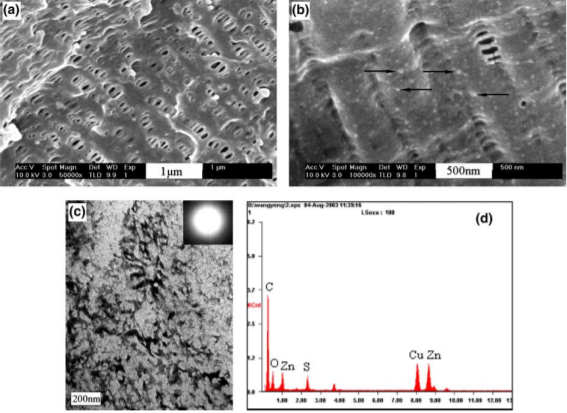For updated info, please visit our new group website: https://yongwang.group
PUBLICATIONS
For personal use only, and copyright belongs to the original publisher.
2025
High-Throughput Electrochemical Delamination of Two-Dimensional Covalent Organic Frameworks
Tong Ju, Xiansong Shi*, Zhenshu Si, Tianci Feng, Jianghai Long, Congcong Yin, Zhe Zhang, Yong Wang*, J. Am. Chem. Soc. 2025, 147, 23809-23818
Porous crystalline nanosheets of two-dimensional covalent organic frameworks (2D COFs) possess intriguing structural features and extensive application potential. However, the scalable and efficient synthesis of well-crystallized COF nanosheets remains challenging despite recent advances in exfoliation and in situ growth techniques. Here we report a high-throughput electrochemical strategy that nondestructively delaminates polycrystalline 2D COF films into large nanosheets with long-range crystallographic order. This method achieves a remarkable delamination productivity of 100 mg h-1, yielding crystalline nanosheets that are readily dispersible across various solvents including water. Principal component analysis reveals solvent permittivity and polarity, along with film wettability, as critical factors governing the delamination efficiency. Complementary diffraction, spectroscopy, and electron microscopy studies elucidate a synergistic delamination mechanism involving molecular preintercalation, framework protonation, and electrolysis-driven gas evolution. Leveraging the intrinsic microporosity and excellent solution processability of these nanosheets, we demonstrate their utility in producing membranes for efficient antibiotic desalination. This work advances the scalable synthesis of crystalline COF nanosheets, broadening the application toolkit of COFs.
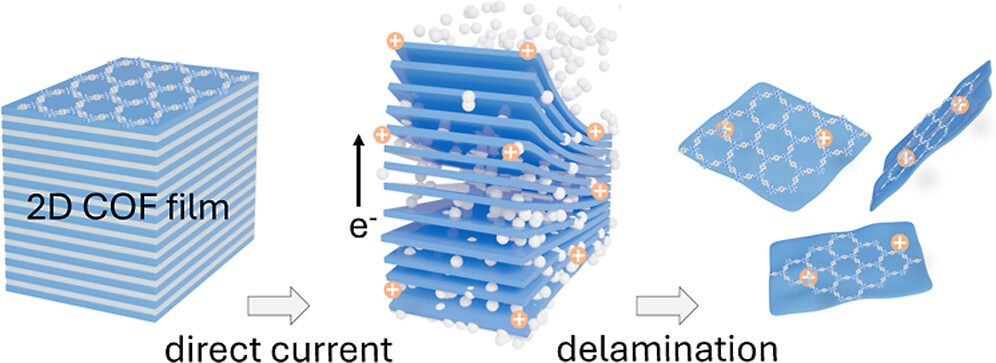
Hydrophobic Block Copolymer Ultrafiltration Membranes for Anti-scaling Durable Membrane Distillation Crystallization
Zhuo Li, Shoutian Qiu*, Lei Wang, Kang Zhou, Shuda Liu, Yong Wang*, Sep. Purif. Technol. 2025, 374, 133614
Due to the inherent insensitivity to salt concentration, membrane distillation (MD) has emerged as a promising technology for high-salinity wastewater treatment. However, scaling remains a critical challenge hindering the widespread application of MD. This study proposes a solution through the development of triblock polystyrene-block-polydimethylsiloxane-block-polystyrene (SDS) membranes with precisely engineered pore structures that effectively address this limitation. The results demonstrate that controlled pore size reduction, which was achieved via selective swelling fabrication, significantly mitigates both surface scaling and intra-pore crystallization. The SDS membrane shows remarkable performance stability under diverse high-salinity conditions, including those high-salinity solutions containing common inorganic contaminants such as CaSO4. Furthermore, when implemented in membrane distillation-crystallization (MDC), the SDS membrane maintains stable performance under a continuous operation for 168 h with saturated NaCl feed, successfully producing high-purity water while simultaneously recovering salt crystals. These results demonstrate that controlled pore size reduction represents an effective strategy to mitigate membrane scaling while maintaining performance stability, offering significant advantages for industrial implementation in zero liquid discharge systems treating high-salinity wastewater.
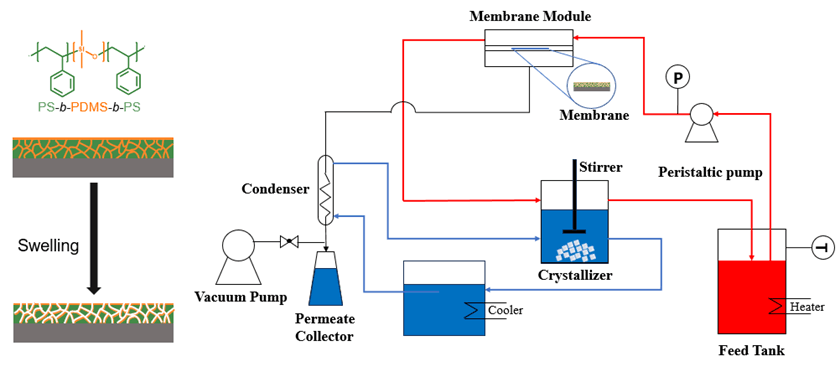
How Monomer Concentrations Influence Structures and Separation Performances of Polyamide Nanofiltration Membranes?
Gan Liu, Mingjie Wei*, Zhaoqin Xu, Daiwen Li, Ming Liu, Jun Huang, Zhe Zhang, Yong Wang, J. Membr. Sci. 2025, 733, 124334
Understanding the microscopic architecture as well as the formation mechanisms of polyamide separation layer is essential for designing nanofiltration (NF) membranes with better performance. The influence of monomer concentrations on the structure and separation performance of polyamide NF membranes are investigated using molecular dynamics simulations. By simulating the interfacial polymerization reaction between piperazine (PIP) and trimesoyl chloride (TMC) in a dual-solvent environment, four NF membranes are constructed using four different monomer ratios. Nonequilibrium molecular dynamics simulations are then employed to evaluate water permeance and ion rejection properties of the resulting membranes. Results show that monomer concentrations control critical membrane structural features like thickness and degree of network cross-linking (DNC) by tuning diffusion-reaction kinetics in interfacial polymerization, consequently altering water and ion transport pathways. Lower PIP concentrations promote decreased DNC and membrane density, enhancing water flux via the permeation paths. Molecular transport pathways and the dehydration behavior of ions reveal the synergistic effects of pore morphology and hydration shell modulation on membrane selectivity. These findings provide theoretical guidance for optimizing fabrication conditions and enhancing the separation performance of polyamide NF membranes.
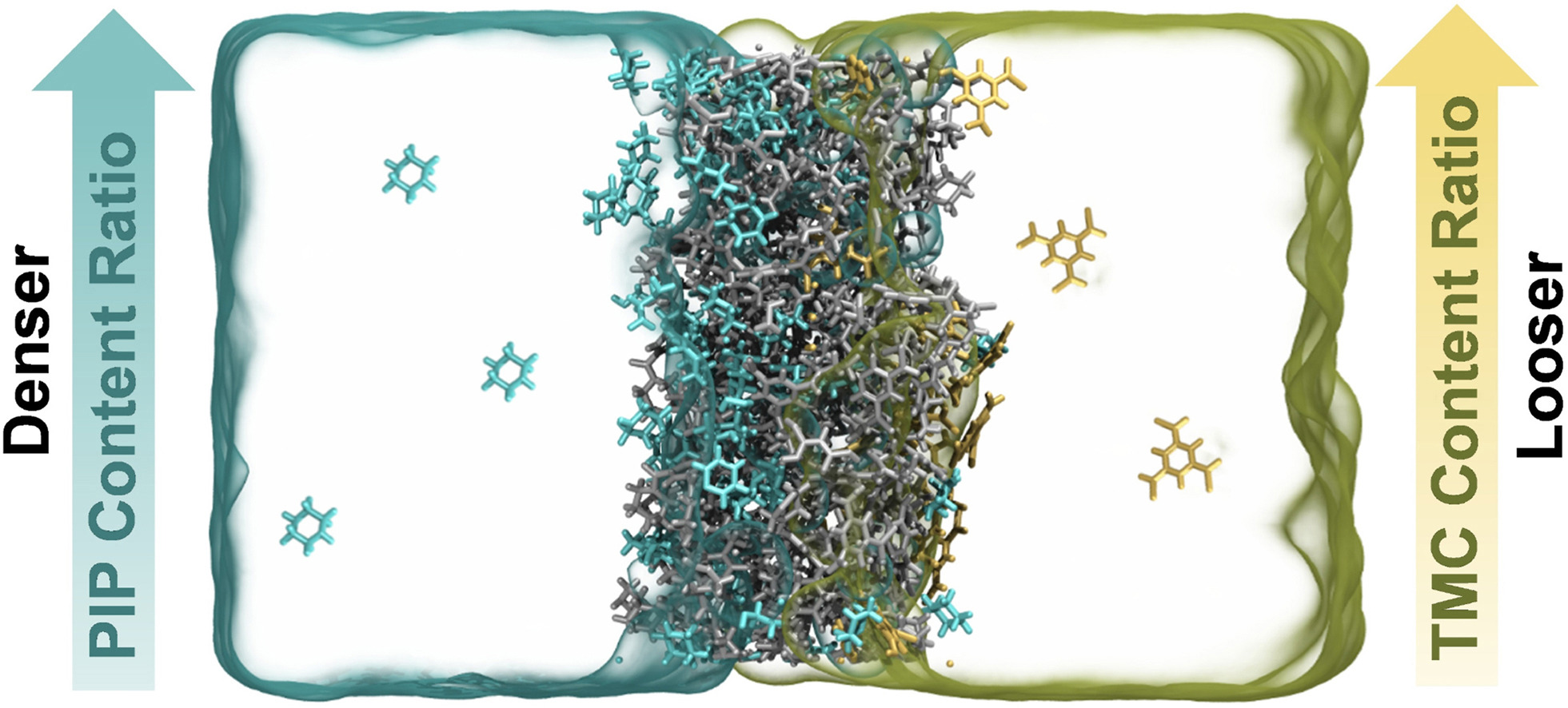
Turing-Structured Covalent Organic Framework Membranes for Fast and Precise Peptide Separations
Bingjie Gao, Youxin Gong, Zhe Zhang*, Qinghua Liu, Congcong Yin, Mingjie Wei, Yong Wang*, Angew. Chem. Int. Ed. 2025, e202503090
Turing structures have emerged as promising features for separation membranes, enabling significantly enhanced water permeation due to their ultra-permeable internal cavities. So far, Turing structures are constrained by the highly cross-linked and heterogeneous porosities, impeding them from the application of molecular separations requiring loose but regular pore structures. This work reports a covalent organic frameworks (COFs) membrane with nanoscale striped Turing structures for fast and precise molecular separations. Porous and hydrophilic modulation layers based on metal polyphenol chemistry are constructed on polymeric substrates, which are capable of enhancing the uptake and controlled release of the activator of amines during synthesis. The appropriately reduced diffusion rate triggers the phenomenon of “local activation and lateral inhibition” arising from thermodynamic instability, creating Turing structures with externally striped and internally cavitated architectures. The Turing-type COF membranes exhibit a water permeance of 45.0 L m−2 h−1 bar−1, which is approximately 13 times greater than the non-Turing membranes, and an ultrahigh selectivity of up to 638 for two model peptides. This work demonstrates the feasibility that Turing structures with ultra-permeable internal cavities can be created in COF membranes and underscores their superiority in molecular separations, including but not limited to high-value pharmaceuticals.
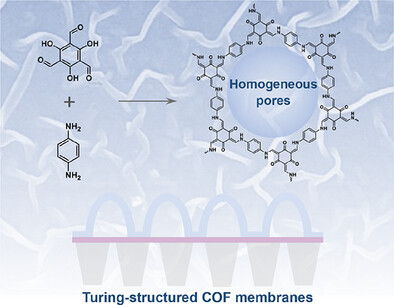
Additive Manufacturing of Ultrafiltration Membranes from Block Copolymer Nanowires
Jie Deng, Youxin Gong, Yang Jin, Jiemei Zhou*, Yong Wang*, Sep. Purif. Technol. 2025, 368, 132980
Precise manipulation of the structure and performance of separation membranes holds immense significance for realizing highly efficient separations in ultrafiltration applications. Herein, we demonstrate an additive manufacturing approach to ultrafiltration membranes by controlled deposition of block copolymer nanowires on macroporous substrates via spray coating. The nanowires with a high concentration and good dispersibility are synthesized through in situ crosslinking polymerization-induced self-assembly. The nanowire morphology can be adjusted by changing the block ratio, enabling the selection of an optimal configuration for membrane preparation. By controlling the concentration and volume of deposited nanowires, intact separation layers composed of stacked nanowires can be formed. The thickness of the nanowire layer is directly correlated with the spraying parameters, and it shows great tunability within the range of approximately 100 nm–3 μm. This tunable thickness imparts adjustable separation performance to the resultant membranes. Furthermore, the strategy presented herein demonstrates exceptional up-scalability in the fabrication of ultrafiltration membranes, paving the way for industrial applications.
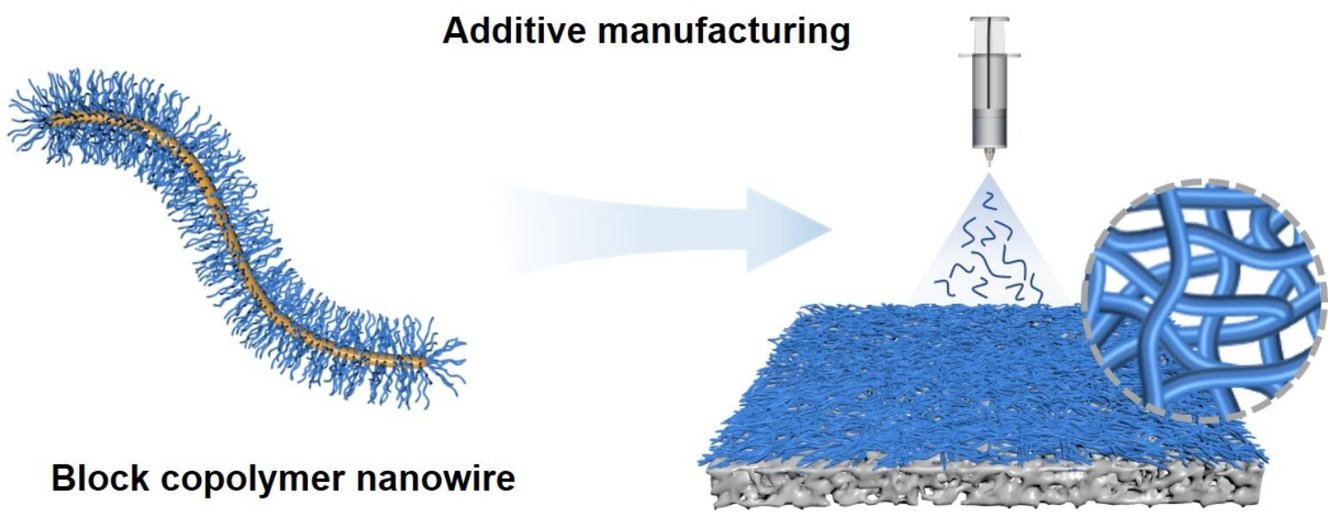
A New Route to Mixed Matrix Membranes: Atomic Layer Deposition of TiO2 on Membrane-Forming Polymers Followed by Nonsolvent-Induced Phase Inversion
Xiaoqi Xu, Hongcheng Song, Sen Xiong*, Yong Wang*, Sep. Purif. Technol. 2025, 366, 132737
Mixed matrix membranes (MMMs) are emerging as a novel class of advanced membranes. Versatile nanofillers are usually applied to improve the separation performance of MMMs. However, the poor compatibility and dispersibility of nanofillers cause inner defects in the polymeric matrix, which degrades the separation performance of MMMs. To solve this problem, we introduce atomic layer deposition (ALD) to modify polyacrylonitrile (PAN) powders and use them to fabricate high-performance PAN-TiO2 MMMs by the nonsolvent-induced phase separation method. Thanks to the advantages of ALD, the thickness of TiO2 is precisely tuned and the interaction between TiO2 and PAN matrix is established during the ALD process. Therefore, the fine size and non-covalent interactions make TiO2 disperse homogeneously in the membrane matrix and enhance the porosity of PAN-TiO2 MMMs. The PAN-TiO2 MMMs fabricated by 500-cycle-deposited PAN powders show a 46.5% higher permeance without consuming the selectivity. Moreover, MMMs possess better antifouling properties, which show lower contaminant adsorption and a better permeance recovery of 86.4% in dynamic antifouling tests.
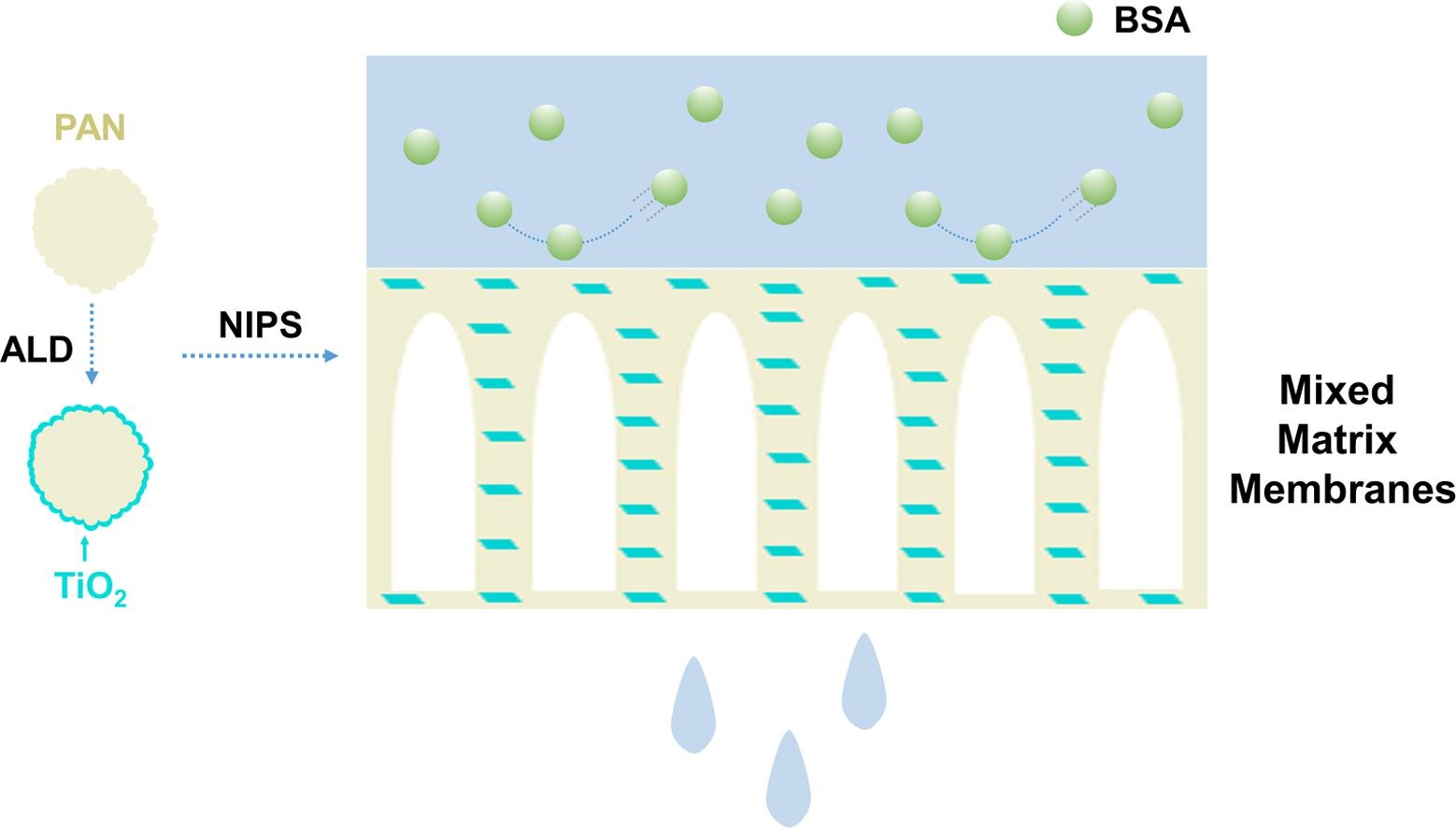
“One Tube Killing Two Birds”: Simultaneously Boosting the Separation and Mechanical Performances of Block Copolymer Membranes by Sparsely Doping Carbon Nanotubes
Xiang Ying, Shoutian Qiu*, Zhuo Li, Lei Wang, Kang Zhou, Xiangyue Ye, Jiemei Zhou, Sheng Cui, Yong Wang*, J. Membr. Sci. 2025, 725, 124019
Selective swelling of block copolymers as an emerging process to prepare ultrafiltration membranes is receiving growing interests. Herein, we report that very little dosages of carbon nanotubes (CNTs) are able to significantly enhance both the separation and mechanical performances of melt-spun polysulfone-block-poly(ethylene glycol) (PSF-b-PEG) hollow-fiber membranes. CNTs are adequately dispersed in the block copolymer by melt processing, and exhibit π–π interaction to the PSF continuous phase but repulsion to the PEG dispersed phase. The incompatibility between CNTs and PEG leads to interfacial gaps between CNTs and the PEG phase, thus providing another set of pores facilitating water permeance. Both dosages and aspects of CNTs significantly influence the pore structure and performances of the membranes. Higher dosages of CNTs produce more interfacial gaps and lead to increased porosity and permeance. While CNTs with lower aspects tend to be distributed in the PSF phase, thus producing smaller pores and decreasing permeance by refraining selective swelling to a larger degree. The hollow-fiber membrane doped with 0.01 wt% CNTs having a diameter of ∼10–20 nm and a length of ∼50 μm shows a water permeance increased by three times and a rejection increased by 1.6 times. Moreover, thus-doped membrane exhibits over 1.5 times increase both in tensile stress and the strain at break and multiple times increase in swing tolerance. Such an extremely low dosage of CNTs synchronously boosting membrane permeance, rejection, and mechanical properties is highly desired in practical applications and is expected to be extended in the performance-upgrading of other membranes with multiphases.
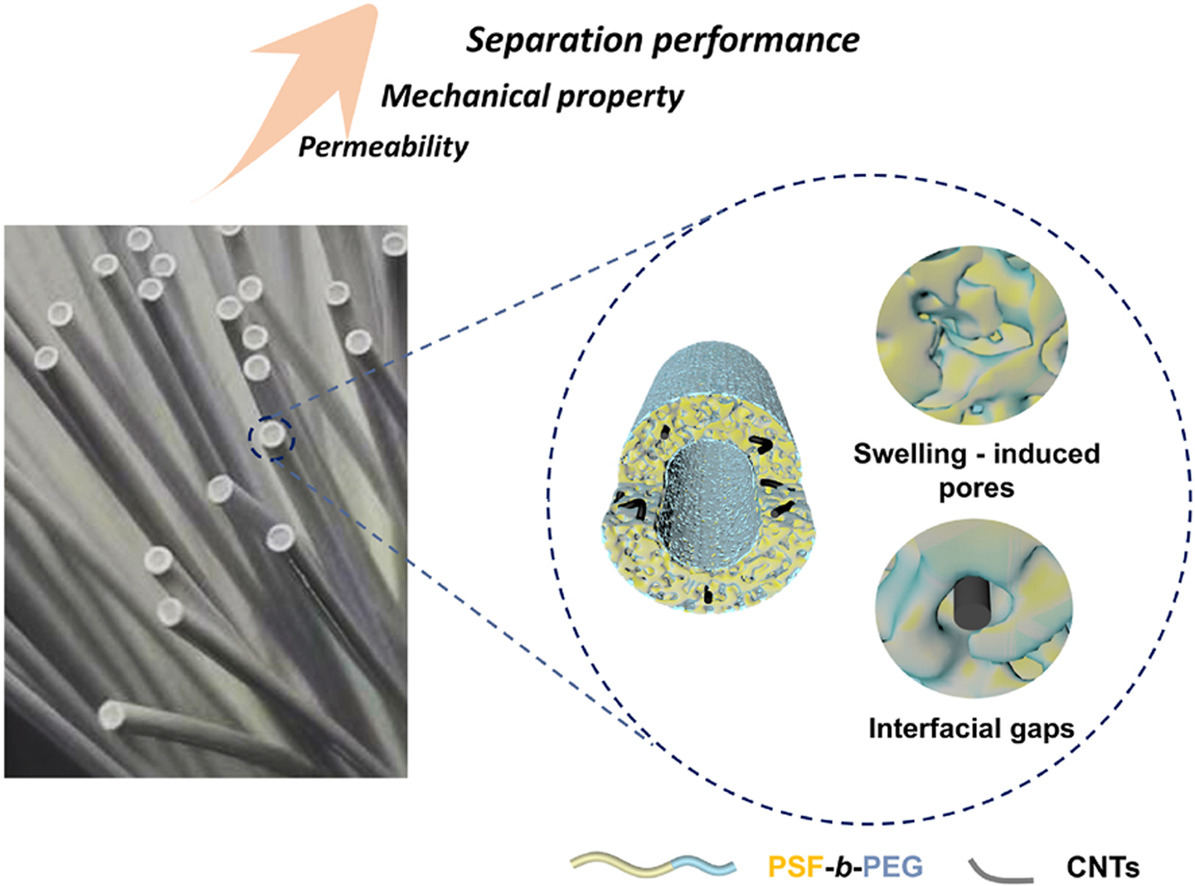
Interfacial Constructing Poly(ionic liquids) on Nanoporous Block Copolymers for Antifouling Ultrafiltration
Xiangyue Ye, Ruotong Zhang, Jiemei Zhou*, Shoutian Qiu, Yong Wang*, Langmuir 2025, 41, 945-954
The remarkable flexibility in structural tunability and designability of poly(ionic liquids) (PILs) has garnered significant attention. Integration of PILs with membranes, novel properties, and functionalities is anticipated for applications in the fields of membrane separation. Here, we develop a facile method to prepare PIL-functionalized membranes in a one-step process by combining selective swelling-induced pore generation and ionic liquid functionalization. The block copolymer of poly(2-dimethylaminoethyl methacrylate)-block-polystyrene (PDMAEMA-b-PS, abbreviated as SDMA) films is immersed in a mixture of ethanol and bromopropane. In addition to the formation of nanoporous structures, an interfacial quaternization reaction between the PDMAEMA blocks and bromopropane occurs to generate poly(methacrylatoethyl propyl dimethylammonium bromide), resulting in the PIL-Br-functionalized membrane (SIL-Br) during the swelling process. It is noteworthy that bromopropane acting as a reactant also promotes the process of selective swelling. The water permeability of the resulting SIL-Br membrane is several times higher than that of the SDMA membrane, which is attributed to the increased pore size and significantly higher hydrophilicity of the SIL-Br membrane. In addition, the anion exchange of SIL-Br with l-proline (l-Pro) readily forms SIL-Pro-functionalized membranes (SIL-Pro), which exhibit exceptional electrical neutrality. Antifouling tests demonstrate that both SIL-Br and SIL-Pro have excellent resistance to proteins compared to the non-PIL-functionalization SDMA membrane, implying their great potential as antifouling membranes for water treatment.

Optimized Performance of Membrane-based Desalination by High-Throughput Molecular Dynamic Simulations and Machine Learning Analysis
Jinji Cao, Zhaoqin Xu, Mingjie Wei*, Lihan Li, Bin Wu, Yong Wang, Desalination 2025, 593, 118217
The influence of pore size and hydrophilicity on the permeance of reverse osmosis (RO) membranes has been mostly focused. However, their influence is hardly to be clearly identified as these two kinds of factor interfere with each other. In this work, high-throughput molecular dynamics (HTMD) simulations with CNTs are used to extensively produce the data of water permeance and NaCl rejection. These data are then analyzed by machine learning (ML) method to obtain the optimized desalination performance. The HTMD results indicate that the pressure drop has little effect on the water permeance. Moreover, rising pore size and degrading hydrophilicity will generally boost water permeance but will somehow sacrifice the NaCl rejection. The interference effect between pore size and hydrophilicity is also found in this work, the mechanism of which is then revealed from molecular level. Additionally, ML is applied to analyze the abundant data of water permeance and NaCl rejection. The optimal conditions are identified to achieve the highest water permeance with 100% NaCl rejection, which are also validated via additional MD simulations. This work suggests that the integration of HTMD and ML promises the future of designing new kind of RO membranes for better performance.
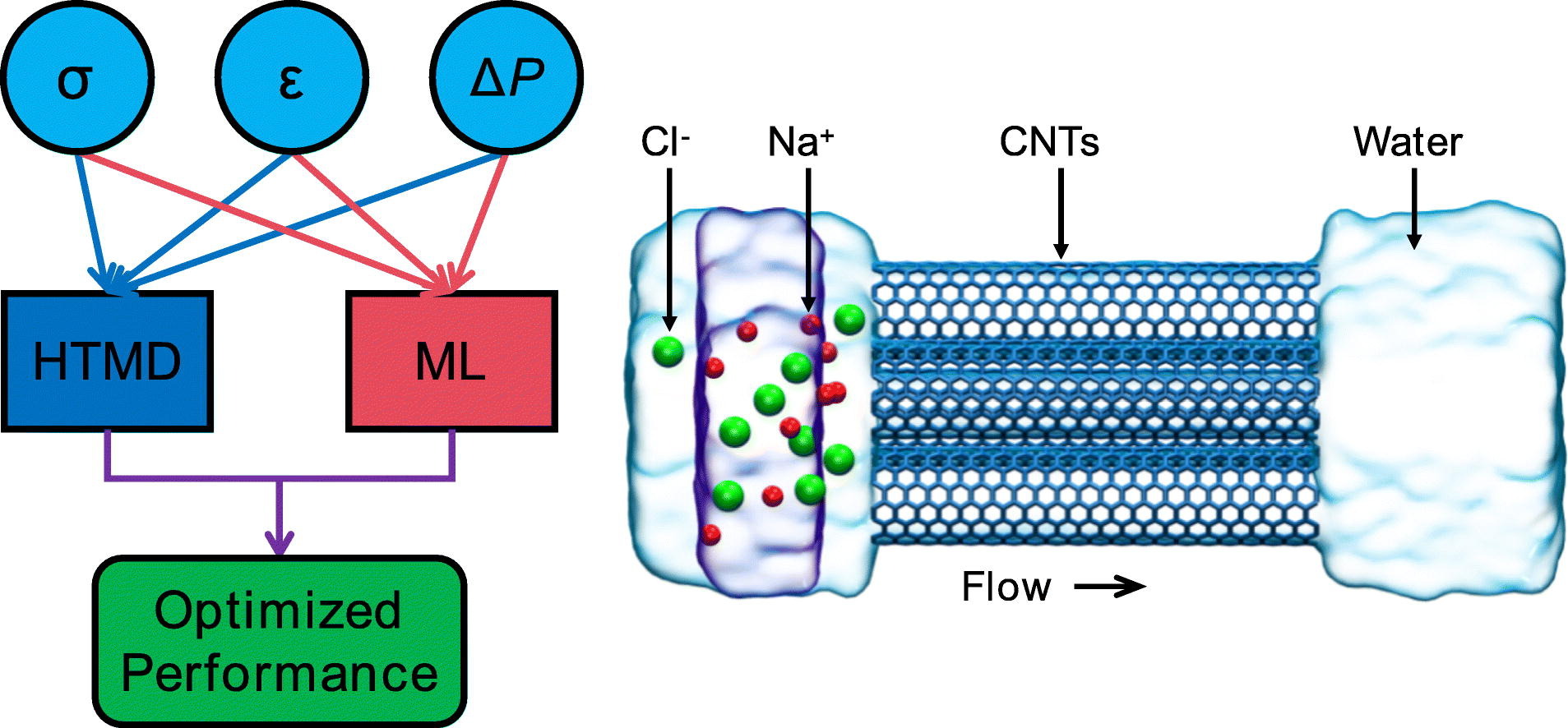
MOFs-Coupled Fiber Membranes: A Versatile Platform for Water Purification
Jingwen Chang, Ye Bian*, Yong Wang*, Sep. Purif. Technol. 2025, 357, 130059
Due to the high chemical and structural diversity, metal-organic frameworks (MOFs) have attracted great interest in water purification. However, the poor processability of MOF powders has hindered their practical applications. To achieve the efficient utilization of MOFs during water treatment, it is effective to combine MOFs with flexible fiber substrates into composite membranes. In this review, the research progress of rational development strategies of MOFs-coupled-fiber membranes was summarized, divided by the formation of MOFs. Furthermore, the pros and cons of different techniques for the synthesis of MOFs-coupled-fiber membranes were elaborated. Based on the understanding of the synthesis strategies, the applications of MOFs-coupled-fiber membranes for the removal of waterborne contaminants were listed, including heavy metal ions, organic dyes, and emerging pollutants. The purification performance largely depends on the structure of MOFs-coupled-fiber membranes and, ultimately on the synthesis strategies. To uncover the full potential of MOFs-coupled-fiber membranes in practical applications, current challenges and perspectives were also proposed. This review aims to help researchers gain a deep understanding of the important effect of MOFs-coupled-fiber membranes in wastewater treatment and provide theoretical guidance for the design and development of functional membranes.
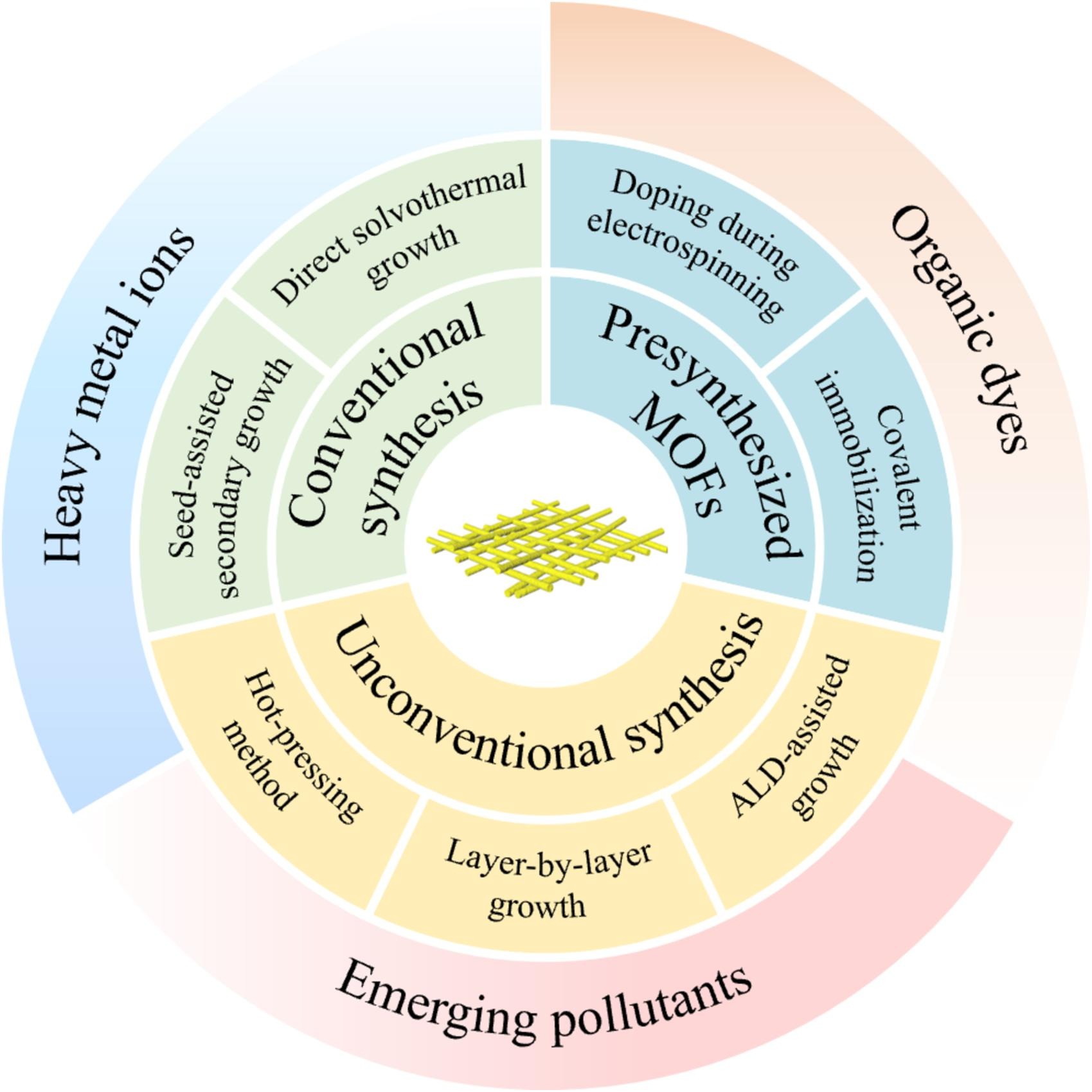
Insights into the Mixing Effect in Organic Solvent Nanofiltration from Simulations on Covalent Organic Frameworks (COFs)
Shukai Li, Bowen Liu, Mingjie Wei*, Ming Liu, Jinji Cao, Weihong Xing, Yong Wang*, Sep. Purif. Technol. 2025, 356, 129947
Low-energy organic solvent separation is crucial for the petrochemical industry. Covalent organic framework (COF) membranes hold immense promise for rapid separation of organic solvents. Understanding of the transport mechanisms of solvents is critical for COF-membrane design. In this study, molecular dynamics simulations are employed to investigate the separation behaviors of three most extensively used solvents (methanol, ethanol, and acetone) and their mixtures on COF membranes. It is found that despite high ideal selectivity, real selectivity approaches to 1, primarily due to in-pore transport effects, notably enhanced flow rates of ethanol in mixed-solvent cases. Subsequently, mixing effect is explored from molecular analysis. It is revealed that no clear evidence of preferential adsorption for methanol or acetone based on density distribution results. Calculation of self-diffusion coefficients indicates that the mobility of ethanol is evidently promoted in the mixed-solvent conditions, caused by the attraction between ethanol molecules is reduced because of the coexistence of other solvent molecules. The unexpectedly promoted permeance of ethanol in mixed-solvent cases consequently lowers the selectivity. Results in this work highlight the solvent–solvent interactions as crucial factors influencing separation performance and provide knowledge of membrane design for highly efficient separations of organic solvents.
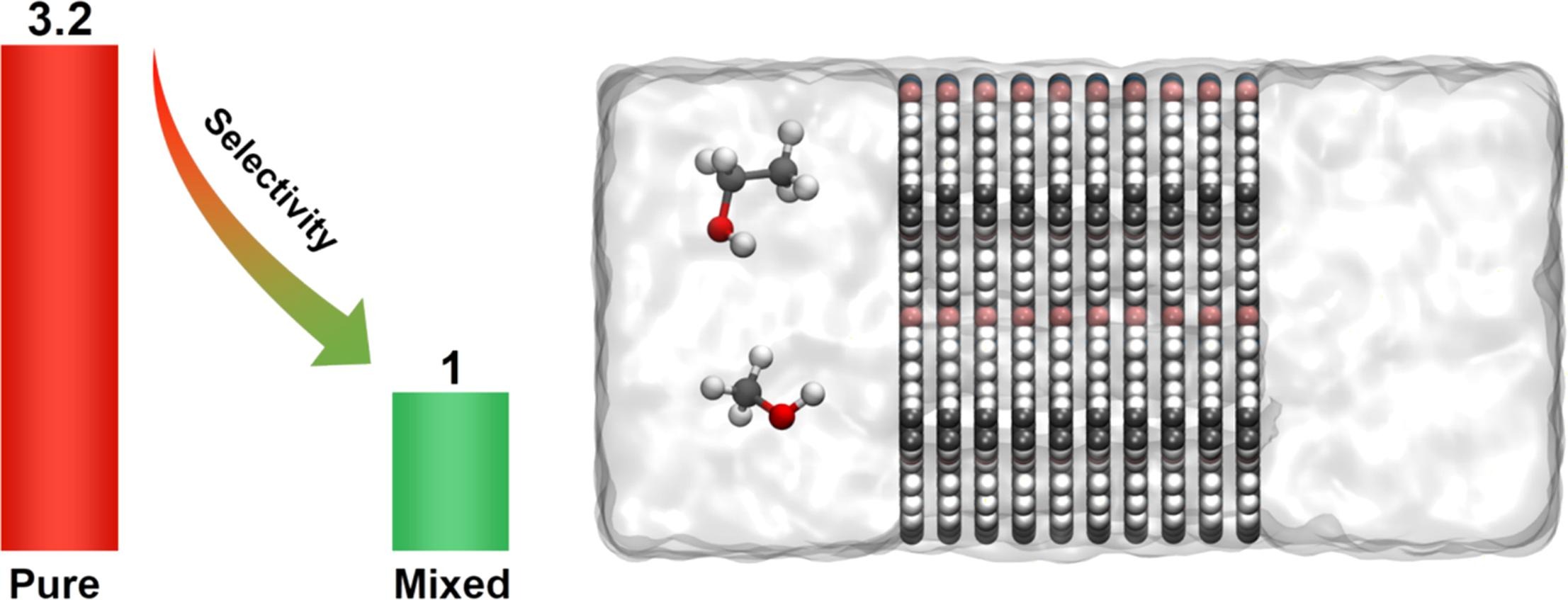
2024
Covalent Organic Framework Membranes with Vertically Aligned Nanorods for Efficient Separation of Rare Metal ions
Qinghua Liu, Ming Liu, Zhe Zhang*, Congcong Yin, Jianghai Long, Mingjie Wei, Yong Wang*, Nat. Commun. 2024, 15, 9221
Covalent organic frameworks (COFs) have emerged as promising platforms for membrane separations, while remaining challenging for separating ions in a fast and selective way. Here, we propose a concept of COF membranes with vertically aligned nanorods for efficient separation of rare metal ions. A quaternary ammonium-functionalized monomer is rationally designed to synthesize COF layers on porous substrates via interfacial synthesis. The COF layers possess an asymmetric structure, in which the upper part displays vertically aligned nanorods, while the lower part exhibits an ultrathin dense layer. The vertically aligned nanorods enlarge contact areas to harvest water and monovalent ions, and the ultrathin dense layer enables both high permeability and selectivity. The resulting membranes exhibit exceptional separation performances, for instance, a Cs+ permeation rate of 0.33 mol m-2 h-1, close to the value in porous substrates, and selectivities with Cs+/La3+ up to 75.9 and 69.8 in single and binary systems, highlighting the great potentials in the separation of rare metal ions.
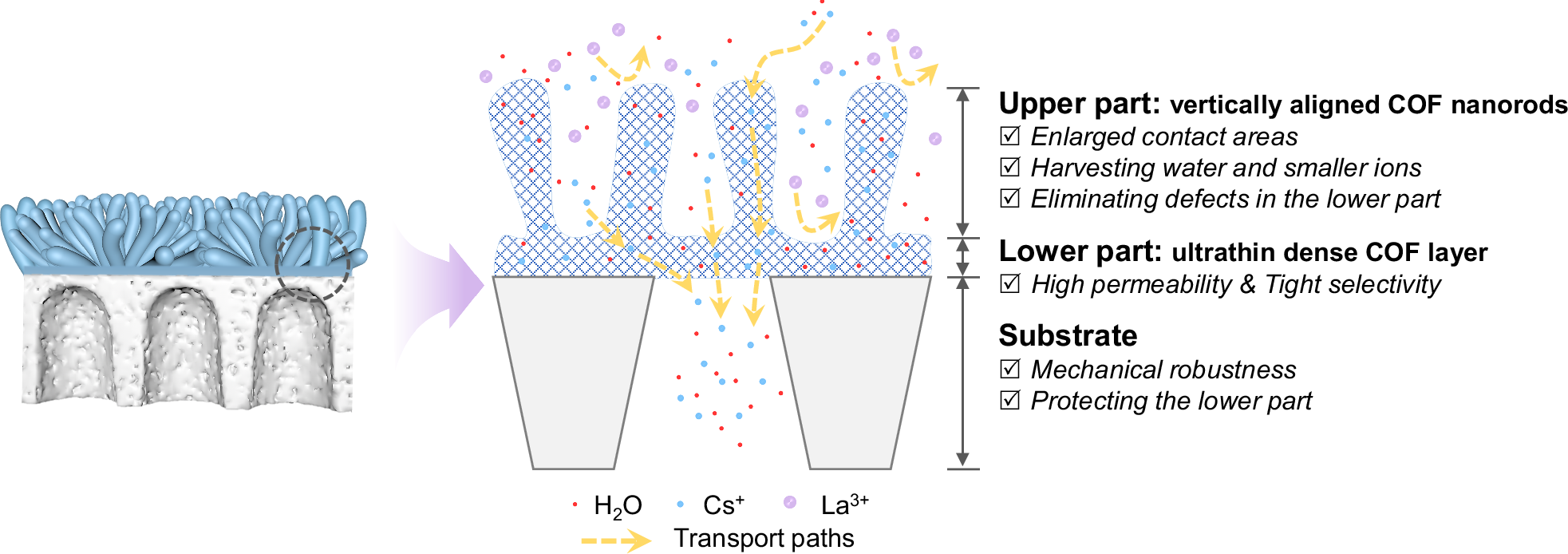
Slippery Coatings with Durable Contaminant Resistance Enabled by Specific Interactions between Nanoporous Block Copolymers and Lubricants
Xiangyue Ye, Jiemei Zhou*, Shoutian Qiu, Yong Wang*, Macromolecules 2024, 57, 9067-9075
Slippery coatings based on lubricant-filled porous surfaces are a crucial class of repellent materials, comprising micro/nanostructured substrates infused with a lubricating liquid, which has demonstrated remarkable resistance to liquid or biological contaminants. However, the fabrication of slippery coatings using a straightforward approach and ensuring robust oil-locking ability remain highly challenging. Herein, selective swelling of the block copolymer of polystyrene-block-poly(dimethylsiloxane) (PS-b-PDMS, abbreviated as SDMS) is used to produce nanoporous thin films with interconnected porosities, thereby slippery coatings are facilely constructed by infusing silicone oil into the nanoporosities. The nanoporous structure provides strong capillary forces for trapping and storing infused lubricants. Meanwhile, the identical molecular composition shared by PDMS blocks and silicone oil ensures their strong adhesion and integration, thereby guaranteeing long-term durability of the slippery coatings. The slippery coatings have excellent repellency to varied liquids and can be self-cleaning and also display good antifouling performances to algae adhesion and microbial contamination in real river water. Constructing slippery coatings on the iron surface enables significant retardation of corrosion under water. This work offers a new approach for the easy and feasible formation of slippery coatings, which holds promising applications in the fields of biofouling resistance and anticorrosion protection.
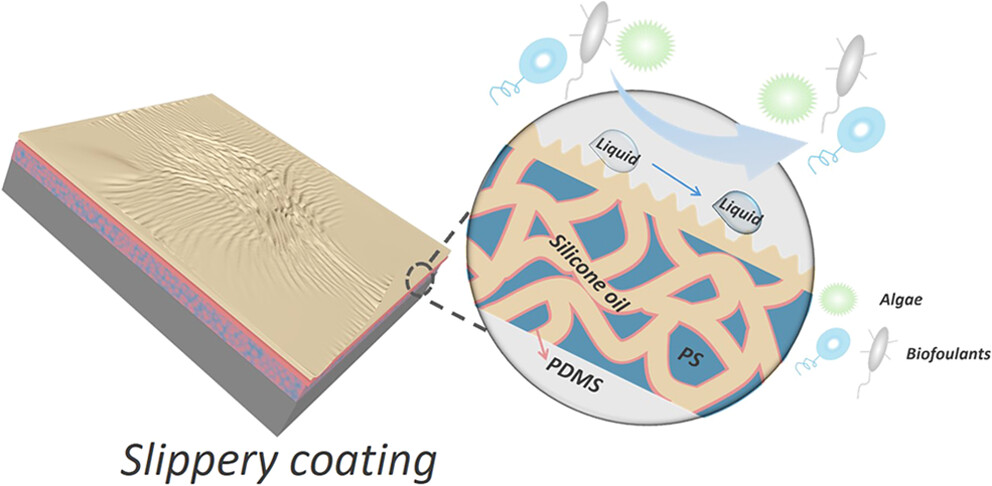
Covalent Organic Framework Membranes Achieving Mg/Li Separation by Permeating Mg2+ While Retaining Li+
Ming Liu, Mingjie Wei*, Gan Liu, Daiwen Li, Zhe Zhang, Yong Wang, J. Membr. Sci. 2024, 721, 123247
Due to the growing demand for lithium in the new energy industry, significant attention has been focused on developing lithium extraction technologies from salt-lake brine. However, the high Mg/Li ratio in salt-lake brine presents challenges for membrane separation technology. If a membrane can allow Mg2+ and water molecules to pass through while retaining Li+, the retained brine will have concentrated Li+ with a reduced Mg/Li ratio, creating the facilitation of further lithium extraction. In this study, we discovered through non-equilibrium molecular dynamics simulations that strongly hydrophilic covalent organic frameworks membranes capture Li+ in their pores, preventing additional Li+ from entering the nanopores. Meanwhile, Mg2+ can freely penetrate these nanopores along with water molecules. This adsorption of Li+ and the free permeation of Mg2+ with water molecules result in the effective separation of Li+ and Mg2+. Consequently, the retained brine becomes lithium-rich with reduced Mg/Li ratio. The findings of this work provide valuable guidance for designing nanofiltration membranes for extracting lithium from salt lakes with high Mg/Li ratio.

A Cationic Three-Dimensional Covalent Organic Framework Membrane for Nanofiltration of Molecules and Rare Earth Ions
Xiansong Shi, Xingyuan Wang, Tianci Feng, Tong Ju, Jianghai Long, Congcong Yin, Zhe Zhang, Yong Wang*, J. Membr. Sci. 2024, 712, 123240
Permanently microporous materials have evolved as focal point of research for tackling issues in separation science and membrane technology. Covalent organic frameworks (COFs) stand out for their distinctive synergy of crystalline nature, uniform channels, and structural diversities. Three-dimensional (3D) COFs, distinguished by angstrom-sized and interconnected channels, hold special promise for separating small targets; however, this potential remains underexplored. Here, we report feasible growth of cationic 3D COF membranes on a flexible polymer substrate for versatile nanofiltration toward both molecules and ions. Through comprehensive performance evaluations, we reveal that the resultant membrane exhibits durable and prominent molecular selectivity to separate fine species with molecular weights above 300 g mol-1 at fast methanol permeation. Lanthanide ions of industrial value also can be harvested by the membrane with rejection rates of up to 91.4%. Together with its nonselectivity to competing ions, our membrane implements efficient extraction of rare earth elements from ion mixtures. These findings illuminate the potential of 3D COFs for liquid separation and offer a solution to building versatile membranes.

Architecting Polymeric Beads with Covalent Organic Framework Nanostrands for Fast and Selective Extraction of Neodymium
Zhipeng Zhang, Xiansong Shi, Zhe Zhang*, Bingjie Gao, Lu Shao, Yong Wang*, Ind. Eng. Chem. Res. 2024, 63, 14777-14785
Covalent organic frameworks (COFs) with regular and tailorable pore channels are promising for constructing advanced adsorbents for the recovery of rare earth ions. However, it remains a challenge to construct composite adsorbents comprising COFs with well-defined morphologies. This study describes a composite bead composed of a polyacrylonitrile matrix and a negatively charged COF, TpPa-SO3Na, possessing a strand-like morphology for the extraction of Nd3+ from aqueous solutions. Porous and crystalline TpPa-SO3Na nanostrands were synthesized under hydrothermal conditions and exhibited a high adsorption capacity (107.1 mg g-1), fast kinetics, and good selectivity during Nd3+ adsorption. TpPa-SO3Na nanostrands were further processed into composite beads with a high loading amount of 50%, and the resulting beads effectively maintained the original microstructures and properties of the nanostrands. Importantly, the composite beads can be used in a dynamic process and show excellent recovery efficiency under low or high Nd3+ concentrations as well as good operational stability. This work not only demonstrates an evident strategy for preparing composite beads by leveraging a polymer matrix and COF nanostrands but also highlights their great potential in the extraction of sparse precious metal resources, including but not limited to rare earth ions.
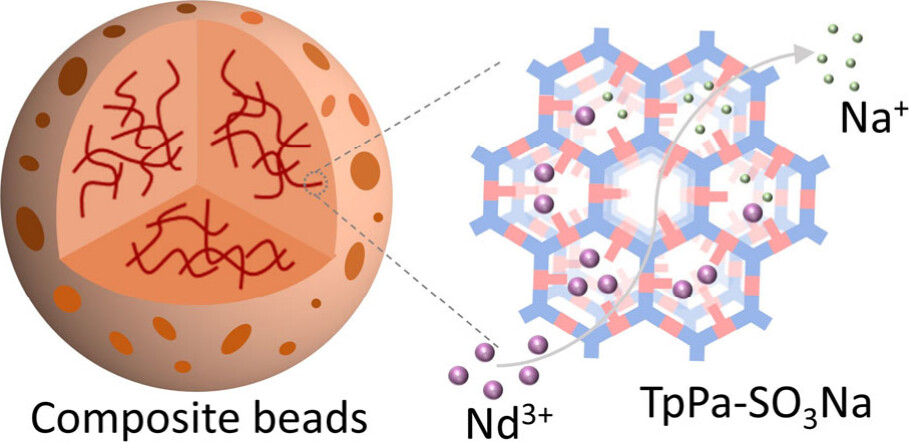
3D-/2D-Covalent Organic Framework (COF) Bilayered Membranes for Efficient Pharmaceutical Purification
Tianci Feng, Xiansong Shi*, Tong Ju, Jianghai Long, Qinghua Liu, Ming Liu, Yong Wang*, J. Membr. Sci. 2024, 709, 123144
Covalent organic frameworks (COFs), with their regularly organized structures and solvent resistance, offer distinct advantages for constructing liquid-phase separation membranes. In nearly a decade of development, research has mainly focused on two-dimensional (2D) COFs, which yet give insufficient molecular selectivity due to inherent large pores. Here, we present a mixed-dimensional strategy of growing three-dimensional (3D) COFs on 2D COFs to build bilayered membranes for efficient organic solvent nanofiltration (OSN). The pores of 3D COFs interlace with those of 2D counterparts, resulting in a subnanoporous composite. We develop this 3D-/2D-COFs composite as robust membranes with a nanoscale thickness. The optimal bilayered membrane yields ethanol permeance of 12.2 L m-2 h-1 bar-1 with a molecular weight cutoff as low as ∼400 g mol-1, surpassing conventional COF-based OSN membranes. Importantly, the designed 3D-/2D-COFs membrane exhibits stable separation performance and excellent sieving ability to discriminate molecular mixtures. This exceptional molecular selectivity ultimately allows the separation of bioactive pharmaceuticals from impurities through our membrane. Overall, this work provides a design strategy for producing mixed-dimensional COF membranes to advance molecular separation in liquids.

Precise Fabrication of Robust Conjugated Microporous Polymer Membranes via Oxidative Molecular Layer Deposition for Efficient Organic Solvent Nanofiltration
Kai Mi, Sen Xiong, Yanqiu Lu*, Yong Wang*, Chem. Mater. 2024, 36, 7069-7078
Conjugated microporous polymers (CMPs) are a novel class of microporous materials highly regarded as exceptional building blocks for the fabrication of high-performance organic solvent nanofiltration membranes. However, preparing CMP thin films remains a challenge, primarily due to the formation of insoluble powders via traditional solvothermal synthesis. Here, we introduce the innovative oxidative molecular layer deposition (oMLD) method for the fabrication of robust CMP membranes utilizing 3,3′-bithiophene (33DT) monomers. The oMLD method enables the direct fabrication of CMP thin films on substrates of varying shapes and allows precise control over membrane structure and separation performance by simply altering the deposition cycles. Benefiting from the abundant micropores and highly cross-linked structure, the resulting CMP membranes facilitate rapid solvent transport and present size-dependent solute–solute separations. In applications involving high-value separations, the P33DT membrane proves effective for pharmaceutical separation in organic solvents. To the best of our knowledge, this work represents the pioneering instance of fabricating CMP membranes via oMLD, significantly broadening the available preparation methods and potential separation applications for CMP membranes.
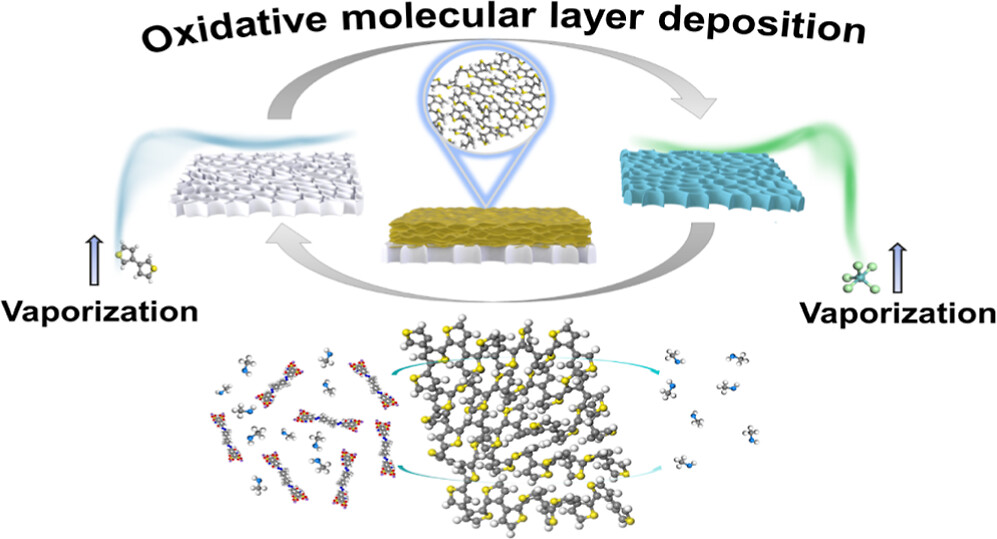
Understanding Interfacial Polymerization in the Formation of Polyamide RO Membranes by Molecular Simulations
Gan Liu, Mingjie Wei*, Daiwen Li, Ming Liu, Jun Huang, Yong Wang, Desalination, 2024, 586, 117869
Since the water permeation mechanisms of polyamide membranes are highly dependent on the micro-structure of polyamide membranes, a deeper understanding of the formation process of them is necessary for the optimization of the membrane performance. As most simulation works construct the polyamide membranes in an ideal way, the interfacial diffusion of monomers, which is crucial for the formation of polyamide membranes, is usually ignored. To address this issue, we mimic the experimental conditions to develop an atomic model of a highly crosslinked polyamide membrane by conducting molecular dynamics simulations. Via tuning the concentration and molar ratio of monomers, the diffusion of monomers and its influence on the subsequent reaction are altered, and the final membrane structure consequently changed. Simulation results reveal that increasing the trimesoyl chloride concentration results in thicker membranes with a reduced specific surface area and consequently decreased water permeance. On the other hand, increasing the m-phenylenediamine concentration will accelerate the reaction rate and reduce the final crosslinking degree. A deeper understanding of the mechanism of polyamide-membrane formation is unveiled in this work, which can aid in the design of high-performance polyamide membranes in the future.
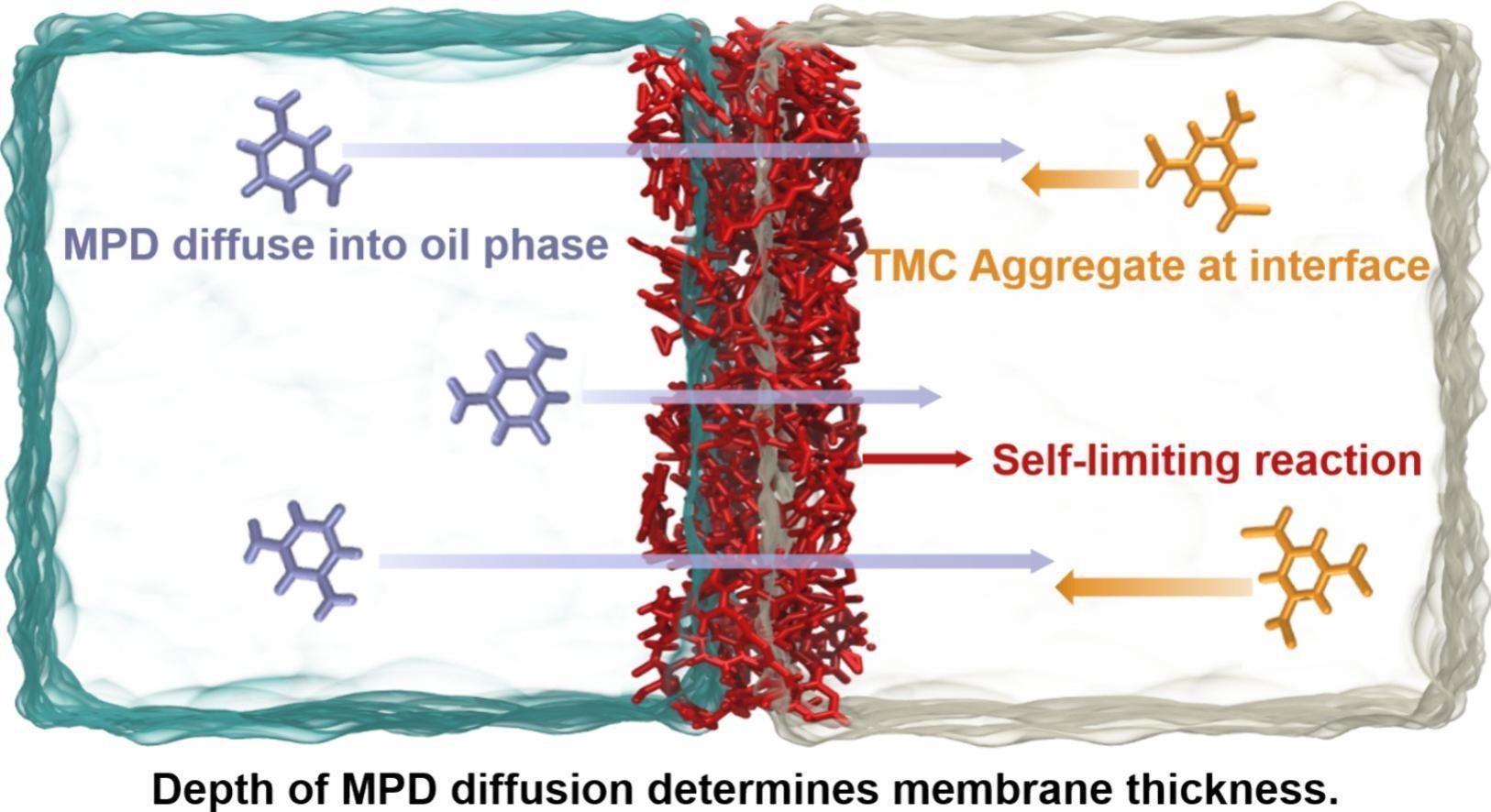
Effects of Carbon Spacer Length on Conformational Transitions and Protein Adsorption of Polyzwitterions
Chenxu Zhang, Jiemei Zhou*, Yong Wang*, Langmuir, 2024, 40, 13365-13374
The properties of polyzwitterions are closely linked to their carbon spacer length (CSL) between oppositely charged groups. A thorough understanding of the effect of CSL on the properties of polyzwitterion-functionalized membranes is important for their fouling resistance and separation performances. In this work, polyzwitterion-functionalized membranes with different CSLs are prepared by coupling selective swelling-induced pore generation with zwitterionization, and the investigation is focused on comprehending the molecular mechanisms underlying protein resistance and conformational transitions within polyzwitterions under varying CSLs. The zwitterionized films show an enhancement in the surface negative potential with the increase of CSL, attributed to the negatively charged groups distanced from the positively charged groups. Quartz crystal microbalance with dissipation (QCM-D) demonstrates that zwitterionized films with different CSLs display distinct levels of resistance to protein adsorption. The trimethylamine N-oxide-derived polymer (PTMAO, CSL = 0) zwitterionized film shows the highest resistance compared to the poly(3-[dimethyl(2′-methacryloyloxyethyl] ammonio) ethanesulfonate (PMAES, CSL = 2) zwitterionized film and the poly(sulfobetaine methacrylate) (PSBMA, CSL = 3) zwitterionized film, owing to its electrical neutrality and pronounced hydrophilicity. Moreover, analysis of the anti-polyelectrolyte behaviors reveals that PTMAO does not undergo a significant conformation transition in deionized water and salt solutions, while the conformations of PMAES and PSBMA display to be more salt-dependent as the CSL increases, attributed to their increased polarization and dipole moment. As a result, the permeability of zwitterionized membranes exhibits enhanced salt responsiveness with the increase in CSL. The findings of this study are expected to facilitate the design of adsorption-resistant surfaces desired in diverse fields.

Stabilizing Graphene Oxide with Complementary Nanosheets for Robust Membranes with High Flux
Rui Li, Xiaoquan Feng, Huixian Wang, Donglai Peng, Shaochong Cao, Jingtao Wang, Yatao Zhang*, Yong Wang*, J. Membr. Sci. 2024, 702, 122799
Laminar assembles of graphene oxide (GO) are receiving tremendous attention for their interesting nanofluidic behaviors, but suffer from structural instability and frustrated mass transfer. Herein, we stabilize GO assembles by “complementary nanosheets”, and thus obtain highly robust and permeable membranes. Self-exfoliated nanosheets of ionic covalent organic frameworks (iCONs) are intercalated into GO nanosheets. GO and iCONs are physicochemically complementary as they carry opposite charges and hydrogen bonds acceptors and donors, respectively. Upon mixing, they form laminar assembles locked by electrostatic attraction and hydrogen bonds, suppressing swelling in water. Moreover, simulation and experimental results reveal that iCONs expands the interlayer distance and provides additional mass-transport paths. Consequently, the GO/iCONs membranes exhibit ultra-high water permeance up to 11-fold larger than that of pure GO membranes. This work provides a controllable route to stabilize GO assembles, and develops new membranes using complementary two-dimensional structures as building blocks.
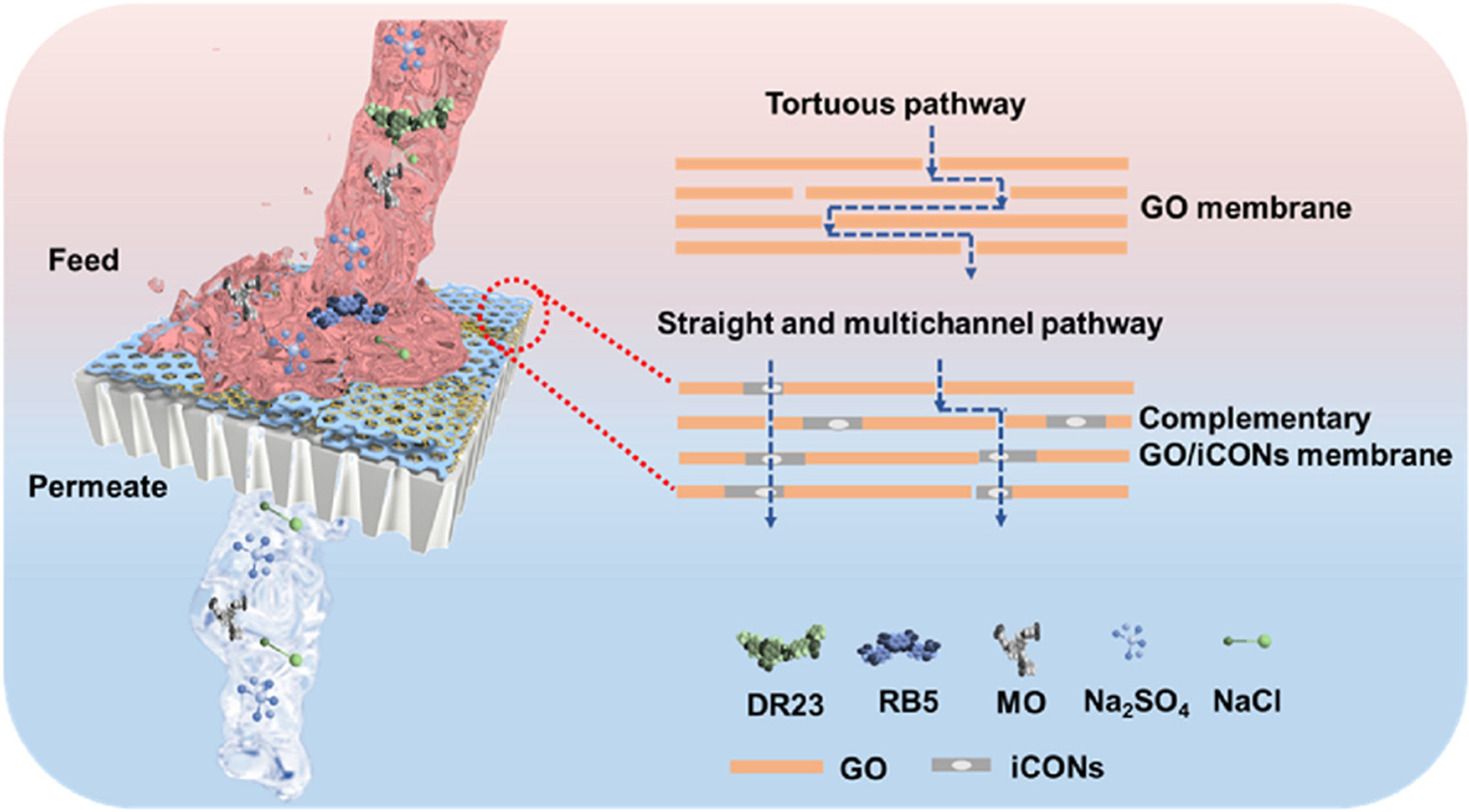
Homoporous Membranes of Block Copolymers: Upscalable Preparation by Spray Coating and Performance Boosting by Quaternization
Jiemei Zhou, Yifei Huang, Can Chen, Yong Wang*, J. Membr. Sci. 2024, 695, 122467
The remarkable permselectivity of homoporous membranes (HOMEs) confers them with unparalleled advantages in high-precision separation. However, the upscalable fabrication of HOMEs remains a challenging yet crucial task to meet practical demands. Herein, we present a facile and controllable strategy for producing HOMEs through spray coating of block copolymers (BCPs) on macroporous substrates, followed by annealing and selective swelling. By controlling the BCP concentrations and ambient humidity during spray coating, dense BCP layers with adjustable thickness can be formed. The use of suitable pore-filling agents for filling the pores of substrates during spray coating and annealing prevents BCP from penetrating into the substrates. Also, it ensures robust adhesion between the BCP layers and macroporous substrates. Direct spray-coating circumvents the intricate and uncontrollable BCP layer transformation process, thereby enabling the successful fabrication of HOMEs over a large area of 100 cm2. The separation performances of thus-prepared homoporous membranes can be easily regulated by changing the swelling durations. Furthermore, the selective swelling process leads to the enrichment of BCP polarity chains on the surface and pore walls, allowing for further quaternization modification. Consequently, a synchronous promotion in permeability and selectivity of HOMEs is achieved.
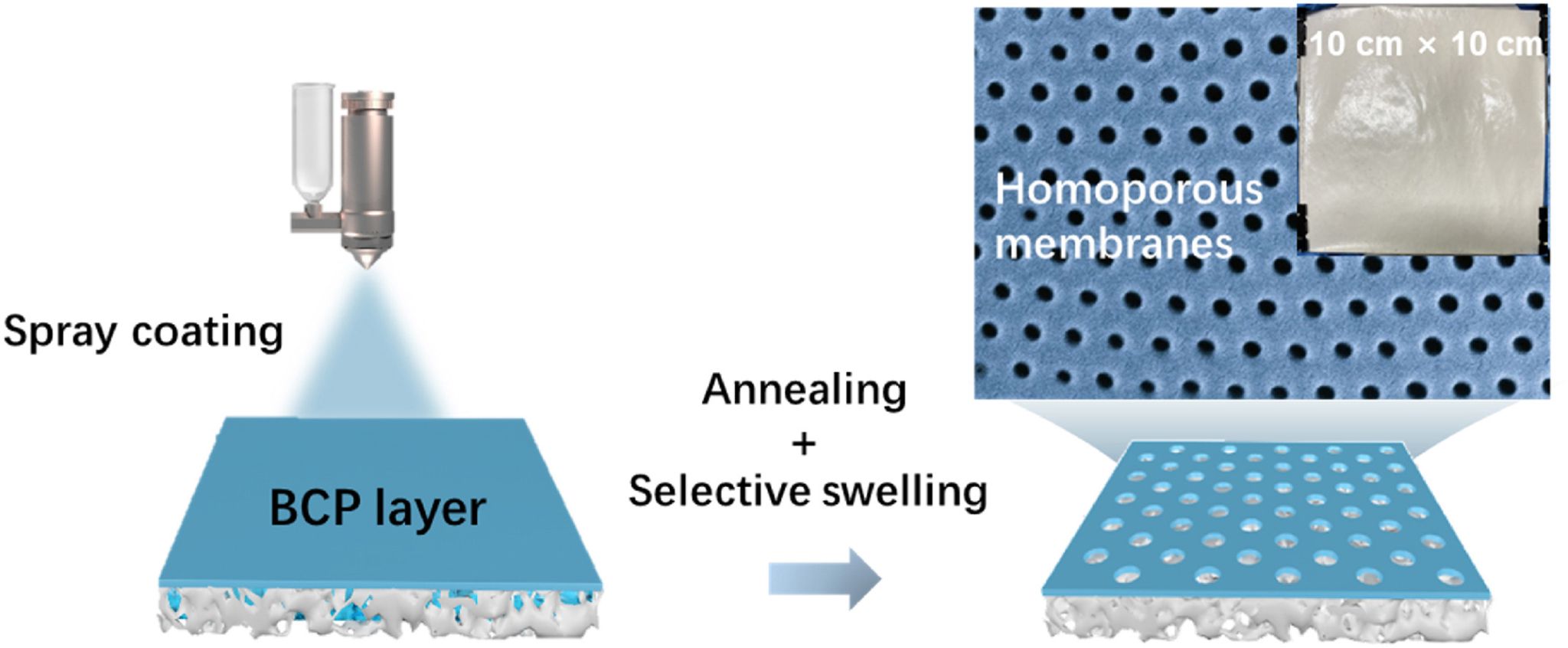
Elution-Free Hollow-Fiber Membranes of Block Copolymers for Hemodialysis Balancing Protein Retaining and Toxin Clearance
Xiang Ying, Shoutian Qiu*, Xiangyue Ye, Zhuo Li, Jiemei Zhou, Yong Wang*, J. Membr. Sci. 2024, 695, 122457
Hemodialysis has been used as the primary treatment for patients with end-stage renal disease, however, the current hemodialysis membranes still need complicated modifications to enhance the hemocompatibility and overcome the additive leaching issue. Herein, we prepare hemodialysis hollow-fiber membranes (HFMs) via the melt spinning and selective swelling of the block copolymers of polysulfone (PSF) and polyethylene glycol (PEG), PSF-b-PEG. PSF-b-PEG is first melt-extruded to form dense hollow fibers, and then soaked in selective solvents to transform the PEG microdomains into nanopores following the mechanism of selective swelling-induced pore generation, thus producing HFMs with three dimensionally interconnected porosities. As neither additives nor involatile solvents are involved in the manufacturing process of the HFMs, no elution of any organic matters could be detected for the HFMs during hemodialysis. The HFMs possess a symmetrical structure ensuring tight selectivity, and hydrophilic PEG chains are enriched on the pore surfaces, thus endowing the membranes with enhanced hydrophilicity and durable biocompatibility. We systematically investigate the effect of PEG contents and swelling conditions on pore sizes, porosities, surface properties, and consequently the hemodialysis performance. The optimized HFMs reject >99 % serum albumin while clear ∼70 % middle molecular toxins such as lysozyme and 93–95 % small molecular toxins including urea, phosphate and creatinine. This work provides a strategy to prepare elution-free hemodialysis membranes by taking advantage of selective swelling of block copolymers to balance high protein retaining and high clearance of middle and small molecular toxins, and demonstrates their superiority in hemodialysis performance and safety than conventional membranes.
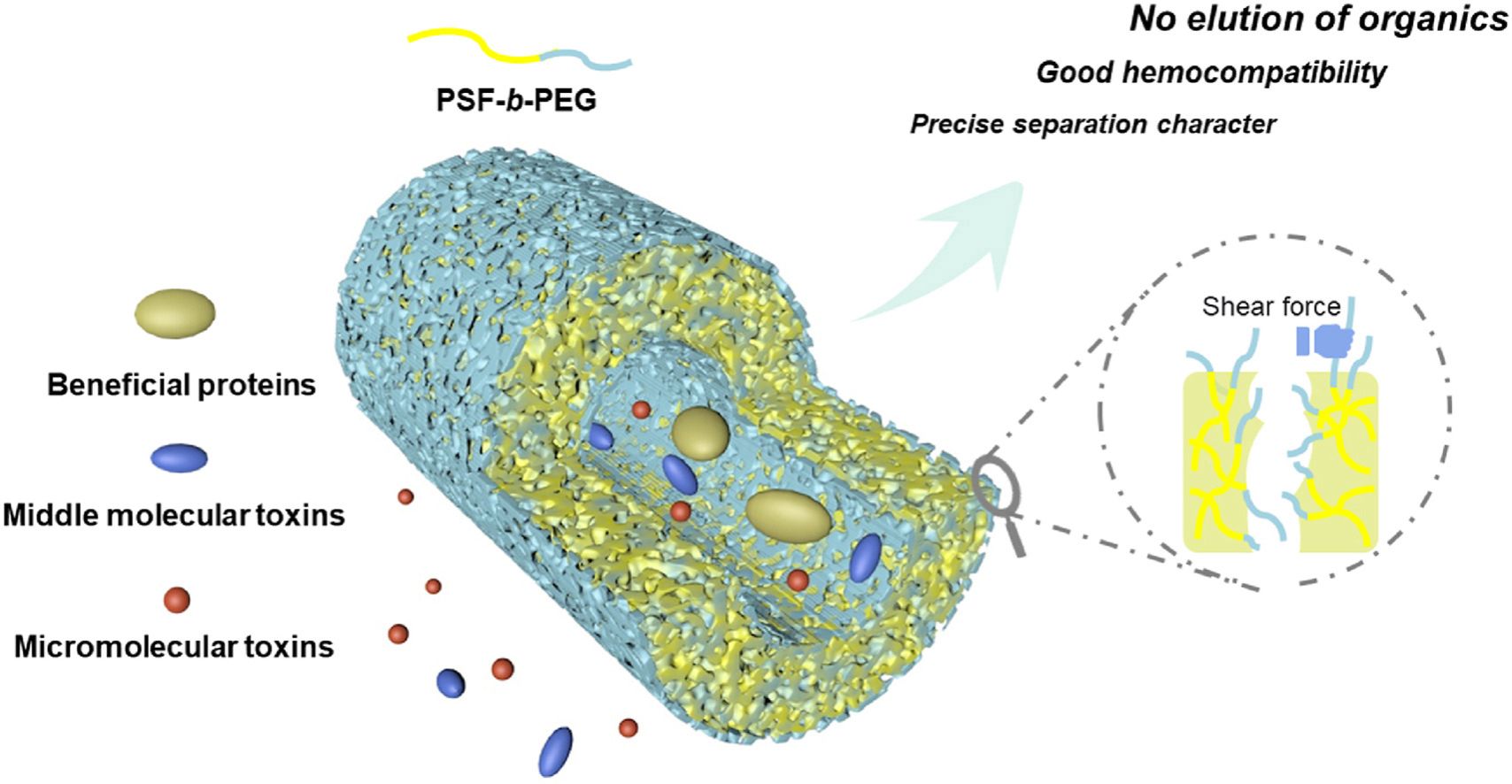
Photo-Induced Geometry and Polarity Gradients in Covalent Organic Frameworks Enabling Fast and Durable Molecular Separations
Congcong Yin, Lin Liu, Zhe Zhang, Ya Du, Yong Wang*, Small 2024, 2309329
Azobenzene, which activates its geometric and chemical structure under light stimulation enables noninvasive control of mass transport in many processes including membrane separations. However, producing azobenzene-decorated channels that have precise size tunability and favorable pore wall chemistry allowing fast and durable permeation to solvent molecules, remains a great challenge. Herein, an advanced membrane that comprises geometry and polarity gradients within covalent organic framework (COF) nanochannels utilizing photoisomerization of azobenzene groups is reported. Such functional variations afford reduced interfacial transfer resistance and enhanced solvent-philic pore channels, thus creating a fast solvent transport pathway without compromising selectivity. Moreover, the membrane sets up a densely covered defense layer to prevent foulant adhesion and the accumulation of cake layer, contributing to enhanced antifouling resistance to organic foulants, and a high recovery rate of solvent permeance. More importantly, the solvent permeance displays a negligible decline throughout the long-term filtration for over 40 days. This work reports the geometry and polarity gradients in COF channels induced by the conformation change of branched azobenzene groups and demonstrates the strong capability of this conformation change in realizing fast and durable molecular separations.

Ion-pairing Design of Covalent Organic Framework Membranes for Separation and Controlled Release of Pharmaceuticals
Xingyuan Wang, Xiansong Shi*, Zhe Zhang, Congcong Yin, Zhipeng Zhang, Yong Wang*, J. Membr. Sci. 2024, 693, 122347
Intrinsically charged covalent organic frameworks (COFs) afford specific ionic nanochannels for mass transport, and thus become promising platforms to design membranes with unique selectivity. However, internal electrostatic repulsion and large-pore frameworks cause significant barriers that greatly limit membrane performances. Herein, we report a novel strategy to synchronously crystallize and upgrade cationic COF membranes by ion-pairing design. Ion-paired guest molecules are involved in electric-driven interfacial crystallization to offset the charges of the ionic monomers and host frameworks. This host-guest neutralization promotes the crystallization of compact COF membranes. Lateral dimension and charge nature of guest molecules fundamentally affect the ion-pairing efficiency. Tight encapsulation of the large-sized electronegative molecules effectually narrows the molecular sieving channels, yielding a significant elevation in membrane selectivity. The membrane rejection of organic ions with a size larger than 1.2 nm thus can be improved from below 50 % to above 85 % with a water permeance of ∼10 L m-2 h-1 bar-1. Prominently, our membranes demonstrate efficient recovery and pH-dependent release of bioactive pharmaceuticals, with a release rate that is 12 times higher in an acidic solution compared to a neutral environment. This work provides an ion-pairing strategy to regulate COF membranes for pharmaceutical industries and beyond.
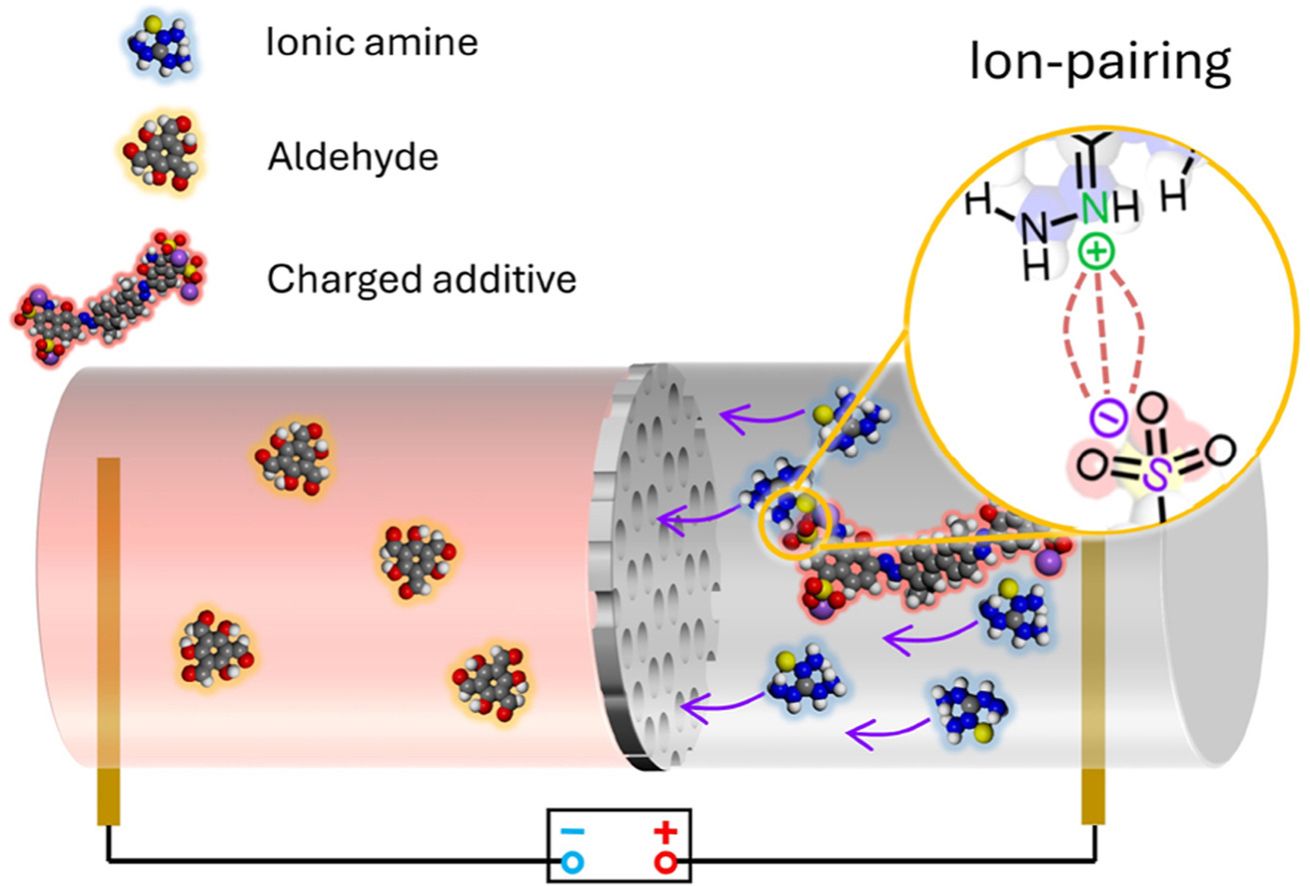
Molecular Layer Deposition of Conjugated Microporous Polymers (CMPs) Thin Films for Fast Molecular Sieving
Kai Mi, Xingpei Ji, Sen Xiong*, Yong Wang*, Sep. Purif. Technol. 2024, 332, 125783
Conjugated microporous polymers (CMPs) have great potential in membrane separation for their intrinsic microporosity and outstanding stability. Unfortunately, most CMPs are insoluble and infusible, thus it is very challenging to prepare CMPs membranes through conventional strategies. Herein, we report the molecular layer deposition (MLD) strategy to synthesize CMP thin films and their outstanding molecular sieving performances as nanofiltration membranes. Thanks to the gas-phase self-limiting reactions between volatile monomers during MLD, defect-free and large-area CMP thin films are deposited on porous substrates. The thickness of the CMP films is precisely tuned by the repeating MLD cycle numbers, and 100 MLD cycles result in a CMP thin film with the thickness of ∼ 70 nm. The as-prepared composite membranes with the deposited MLD thin films as the selective layers exhibit superior molecular sieving properties with a permeance up to 134 L m-2h-1 bar-1, outperforming other CMP membranes. In addition, the perm-selectivity of CMP membranes can be easily tuned by changing MLD cycle numbers. We further demonstrate that, by optimizing the deposition process including selecting proper precursors, CMP thin films can be successfully MLD-deposited onto temperature-sensitive polymeric substrates with the size as large as 10 cm × 10 cm. This work shows the feasibility and great potential of MLD synthesis of CMP thin films, which opens new avenues not only for the synthesis of CMPs with highly controllable thickness, but also for the preparation of advanced membranes for diverse applications.

熔纺-选择性溶胀制备嵌段共聚物多通道中空纤维膜
钟丁磊*, 黄铎, 应翔, 邱守添*, 汪勇*, 化工进展, 2024, 43, 269-278
2023
Chemically Asymmetric Polymers Manipulate the Crystallization of Two-Dimensional Covalent Organic Frameworks to Synthesize Processable Nanosheets
Tong Ju, Ming Liu, Xiansong Shi*, Ankang Xiao, Zhe Zhang, Jingtao Wang, Yatao Zhang, Yong Wang*, ACS Nano, 2023, 17, 23784-23793
Nanosheets derived from two-dimensional covalent organic frameworks (2D COFs) are increasingly desirable in various fields. While breakthroughs in the chemical and physical delamination of 2D COFs are rising, precisely regulating the growth of the COF nanosheets has not been realized yet. Herein, we report an effective strategy of polymer-manipulated crystallization to accurately control the growth of COF nanosheets. Chemically asymmetric polyvinylpyrrolidone (PVP) is developed as the manipulator that selectively interacts with the aldehydes and (100) facet to induce anisotropic growth of COFs. The number of PVP constitutional units determines this specific interaction, leading to molecularly thin but thickness-controllable nanosheets with excellent dispersity. We process these nanosheets into robust A4-sized membranes for ultraselective molecular separation. The membrane intercalated with long-chain PVP demonstrates largely improved performance, surpassing the reported COF membranes. This work reports a strategy for anisotropically crystallizing 2D COFs to yield processable nanosheets toward practical applications.

Encrusting MOF Nanoparticles onto Nanofibers via Spray-Initiated Synthesis to Boost the Filtration Performances of Nanofiber Membranes
Ye Bian, Zhuolun Niu, Chencheng Zhang, Yue Pan, Yong Wang*, Chun Chen*, Sep. Purif. Technol. 2023, 331, 125569
Metal-organic frameworks (MOFs) are currently one of the most attractive porous materials. Integrating MOFs into an organic polymer matrix is considered a promising approach for controlling air pollutants. Especially, the nanoscale miniaturization of MOFs is promising to serve as membranes for efficient air quality control. Here, we proposed the use of spray-initiation as a facile and rapid methodology to assemble homogeneous growth of nanoMOFs on the electrospun fibers, yielding the composite fiber with diameters smaller than 300 nm. The developed ZIF-8-encrusted nanofiber membrane achieved superior filtration performance. Compared with the filter without MOF growth, the MOF-encrusted nanofiber filter achieved enhanced filtration efficiency and almost no change in pressure drop. For the most penetrating particles, the ZIF-8-encrusted nanofiber filter can even reach a 10% increment. This work shows that introducing the MOF nanoparticles onto the nanofibers with homogenous distribution can significantly improve the capacity of the filters in controlling submicron particles, and provide an important reference for the rational design of structures of composite materials.
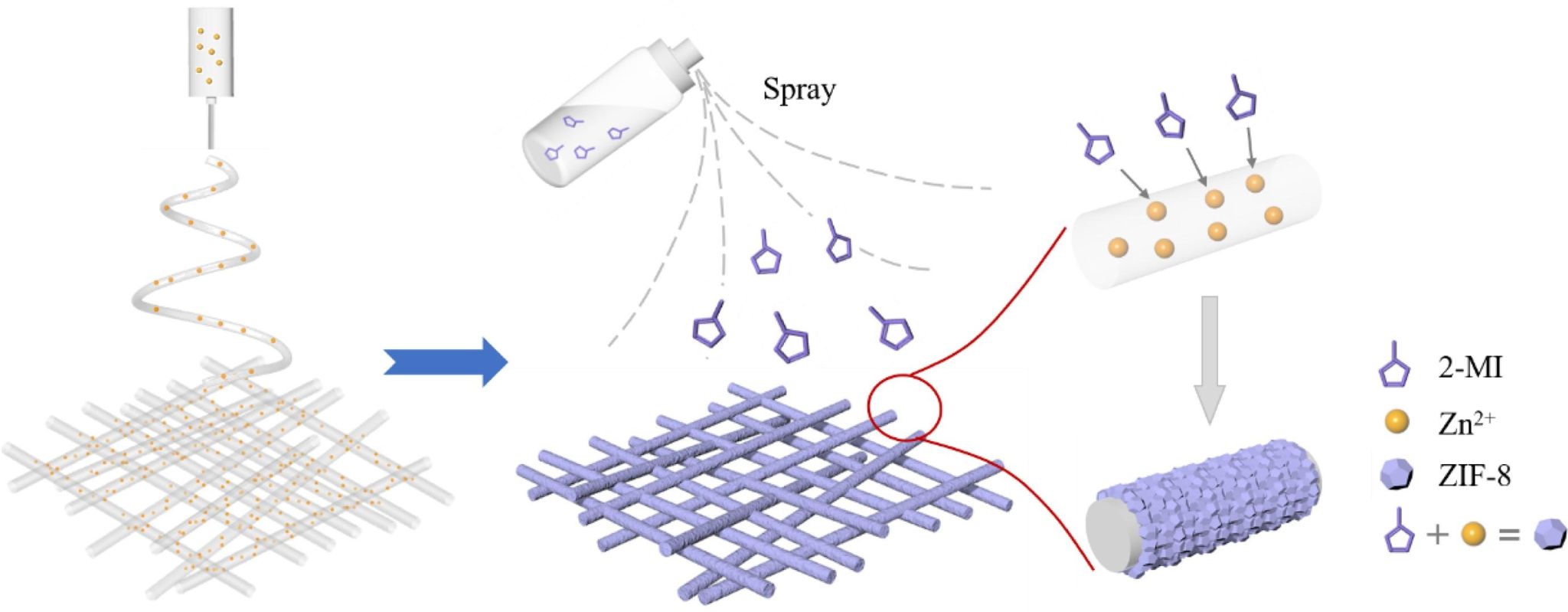
Post-Synthetic Modifications to Covalent Organic Frameworks (COFs) for Diverse Applications
Narges Abdolhossein Rejali, Mohammad Dinari*, Yong Wang*, Chem. Commun. 2023, 59, 11631-11647
Covalent organic frameworks (COFs) are porous and crystalline organic polymers, which have found usage in various fields. These frameworks are tailorable through the introduction of diverse functionalities into the platform. Indeed, functionality plays a key role in their different applications. However, sometimes functional groups are not compatible with reaction conditions or can compete and interfere with other groups of monomers in the direct synthetic method. Also, pre-synthesis of bulky moieties in COFs can negatively affect crystal formation. To avoid these problems a post-synthetic modification (PSM) approach is a helpful tactic. Also, with the assistance of this strategy porous size can be tunable and stability can be improved without considerable effect on the crystallite. In addition, conductivity, hydrophobicity/ hydrophilicity, and chirality are among the features that can be reformed with this method. In this review, different types of PSM strategies based on recent articles have been divided into four categories: (i) post-functionalization, (ii) post-metalation, (iii) chemical locking, and (iv) host–guest post-modifications. Post-functionalization and chemical locking methods are based on covalent bond formation while in post-metalation and host–guest post-modifications, non-covalent bonds are formed. Also, the potential of these post-modified COFs in energy storage and conversion (lithium–sulfur batteries, hydrogen storage, proton-exchange membrane fuel cells, and water splitting), heterogeneous catalysts, food safety evaluation, gas separation, environmental domains (greenhouse gas capture, radioactive element uptake, and water remediation), and biological applications (drug delivery, biosensors, biomarker capture, chiral column chromatography, and solid-state smart nanochannels) have been discussed.
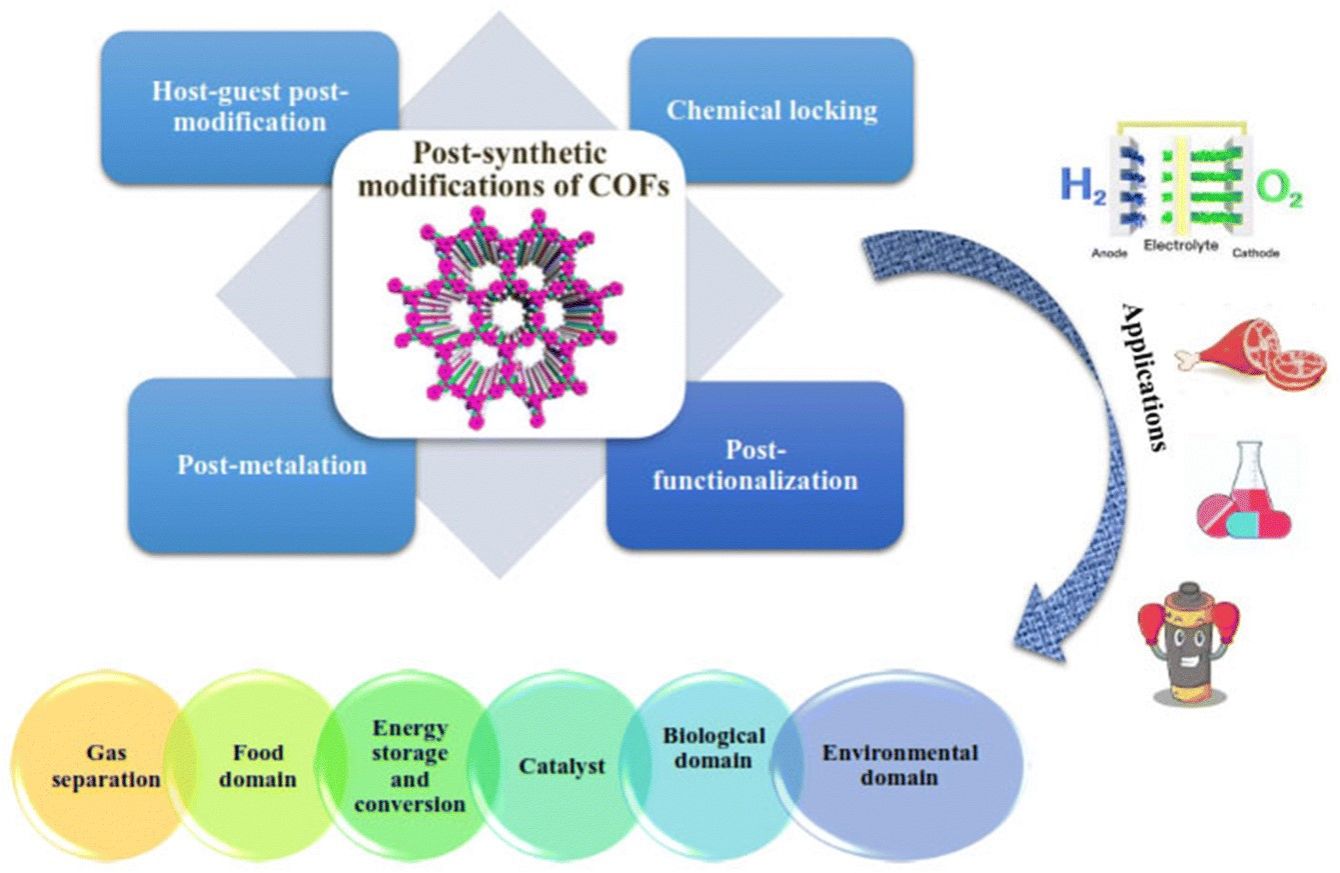
Rapid Synthesis of Ultrathin Covalent Organic Polymer Membranes with Subnanometer Pores for Efficient Organic Solvent Nanofiltration
Jianghai Long, Xiansong Shi*, Tong Ju, Xingyuan Wang, Zhe Zhang, Yong Wang*, J. Membr. Sci. 2023, 684, 121880
Covalent organic polymers (COPs) with abundant micropores are deemed as promising materials for building molecular separation membranes. In spite of this potential, fabricating COP separation membranes through an efficient and scalable method remains a significant challenge. Herein, we report a simple and efficient strategy for the synthesis of COP membranes with three-dimensionally interconnected micropores. Utilizing transition-metal nitrates as a catalyst, we achieve fast polymerization of amorphous COPs with relatively uniform micropores (0.7 nm in diameter). The rational design of organic-aqueous interface allows for the direct fabrication of robust COP membranes with an ultrathin thickness of ∼20 nm on porous polyacrylonitrile substrates. The resulting hydrophobic but pore-uniform frameworks in these membranes permit fast permeation of organic liquids with a notable molecular weight cutoff of 388 g mol-1 in ethanol. To demonstrate scalability, we show that our strategy can produce large-size COP membranes with a prominent area of 200 cm2, which exhibit performances similar to that of small membrane coupons. The present study offers a potentially scalable method for producing highly microporous COP membranes toward efficient molecular separation in organic liquids.
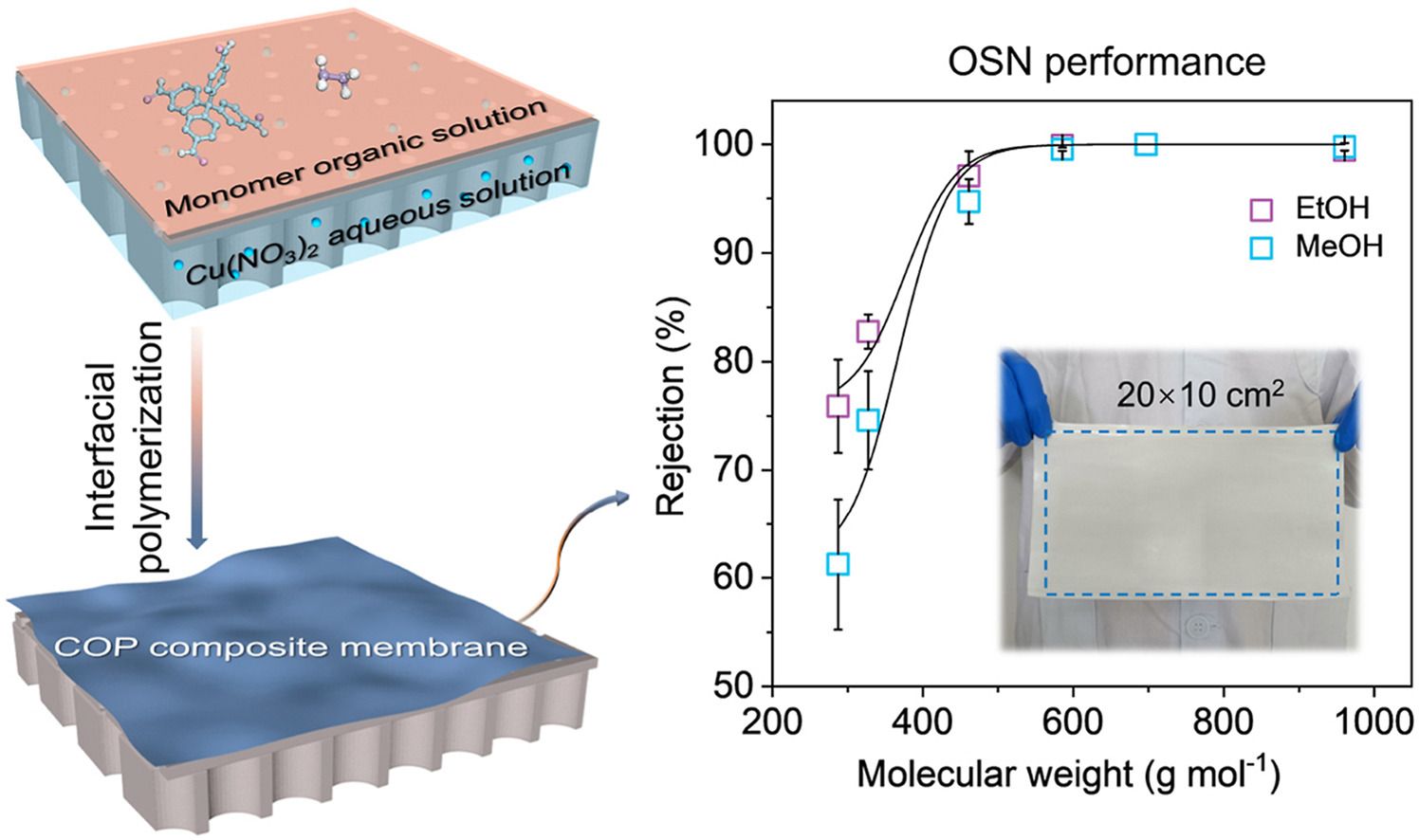
Engineering Transport Highways in Microporous Membranes for Lithium Extraction: The Double Role of Covalent Organic Frameworks
Zhenshu Si, Zhe Zhang*, Congcong Yin, Tong Ju, Mingjie Wei, Jun Huang, Yong Wang*, J. Membr. Sci. 2023, 680, 121759
Microporous polyamide membranes that allow lithium ions to pass through easily but exclude magnesium ions hold vast potential in the lithium extraction from brine lakes. The efficacy, nevertheless, has long been limited by a trade-off that the magnesium/lithium selectivity is received at the expense of the permeability, arising from the highly cross-linked polyamide. This work describes that rationally lowering the internal density of polyamides by embedding functionalized covalent organic framework (COF) nanosheets can boost the selectivity and permeability simultaneously. A cationic COF, TpTGCl, is used to build transport highways in membranes, which shows the double role that not only lowers the polyamide density in a controllable way, but also strengthens the positive charge property. The resulting membrane exhibits a large water permeance of 19.6 L m-2 h-1 bar-1, along with an excellent separation factor of up to 21.3 under a high magnesium/lithium ratio of 30. This engineering strategy offers a means by which charged and nanoporous two-dimensional frameworks can be leveraged as a booster for microporous membranes enabling fast and precise ion transports.
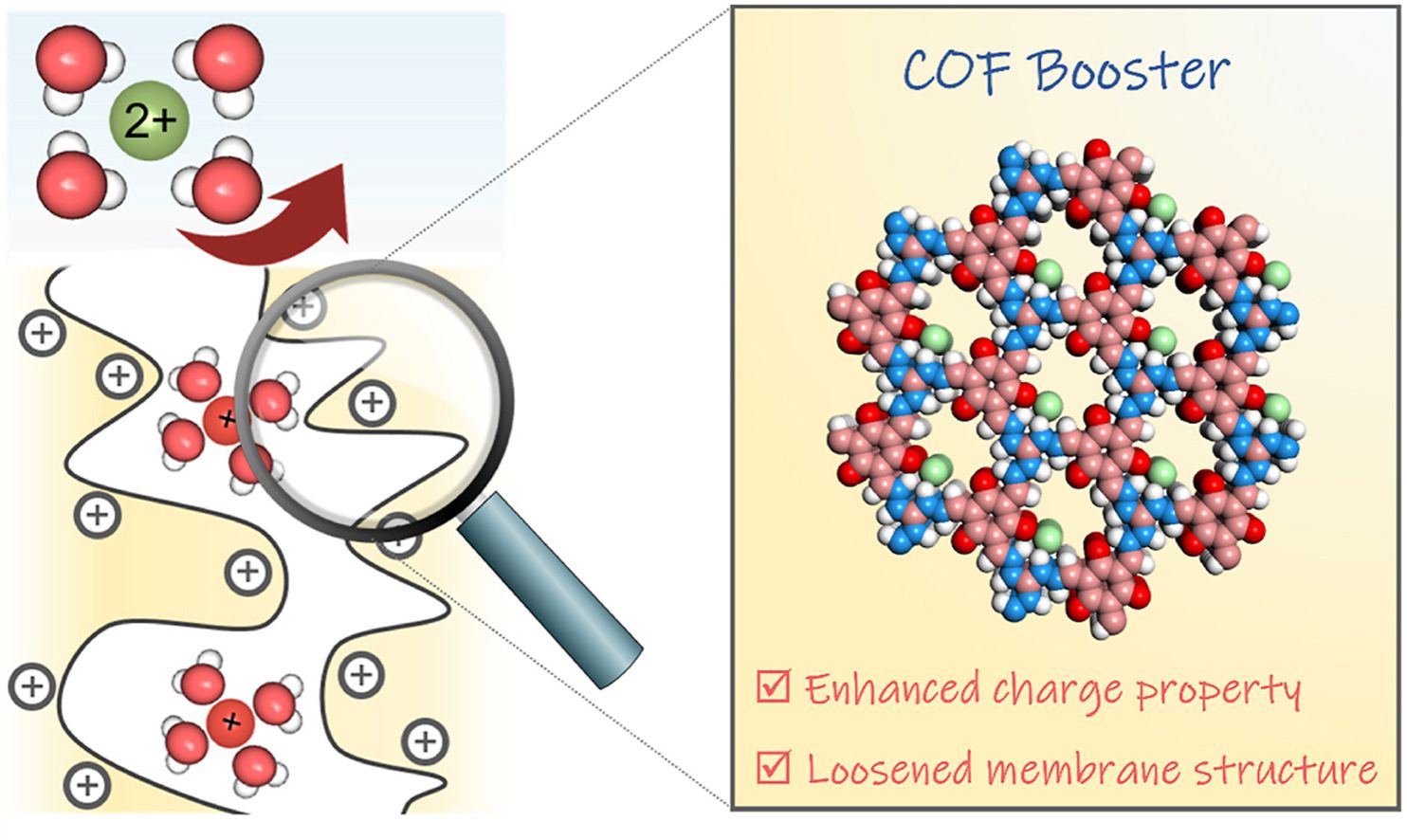
Perpendicular Alignment of Covalent Organic Framework (COF) Pore Channels by Solvent Vapor Annealing
Congcong Yin, Ming Liu, Zhe Zhang, Mingjie Wei, Xiansong Shi, Yatao Zhang, Jingtao Wang, Yong Wang*, J. Am. Chem. Soc. 2023, 145, 11431-11439
Covalent organic frameworks (COFs) have showcased great potential in diverse applications such as separation and catalysis, where mass transfer confined in their pore channels plays a significant role. However, anisotropic orientation usually occurs in polycrystalline COFs, and perpendicular alignment of COF pore channels is ultimately desired to maximize their performance. Herein, we demonstrate a strategy, solvent vapor annealing, to reorient COF pore channels from anisotropic orientation to perpendicular alignment. COF thin films are first synthesized to have flexible N–H bonds in their skeletons, thus having structural mobility to enable molecular rearrangement. A solvent with low relative permittivity and a conjugated structure is then identified to have a strong affinity toward the COFs, allowing its vapor to easily penetrate into the COF interlayers. The solvent vapor weakens the π–π interaction and consequently allows the COF monolayers to dissociate. The COF monolayers undergo a reorientation process that converts from random stacking into the face-on stacking fashion, in which the through COF pores are perpendicularly aligned. The aligned COF film exhibits high separation precision toward ions featuring a size difference down to 2 Å, which is 8 times higher than that of the anisotropically oriented counterpart. This work opens up an avenue for COF orientation regulation by solvent vapor annealing and reveals the essential role of the perpendicular alignment of COF pore channels to enable precision separations.
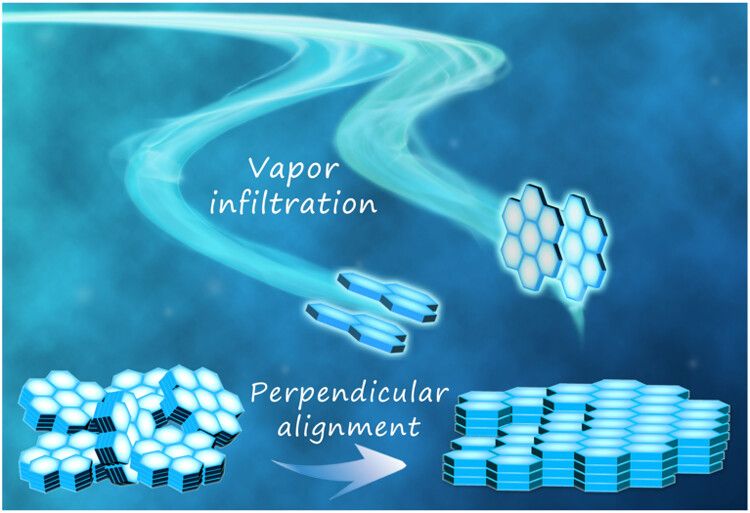
Nanoporous Thin Films of Hydrophobic Block Copolymers Enabled by Selective Swelling for Membrane Distillation
Zhuo Li, Shoutian Qiu*, Xiang Ying, Fangli Zhang, Xianli Xu, Zhaoliang Cui, Yong Wang*, J. Membr. Sci. 2023, 679, 121710
Membrane distillation (MD) is receiving growing interest because of its >99.9% salt rejection even with low-grade waste heat as the energy supply. However, MD membranes are prone to be wetted and usually require complicated modification strategies to gain sufficient hydrophobicity. In this work, we report a new type of MD membranes with hydrophobic films carrying pores in the ultrafiltration range as the separation layers. Such membranes are prepared by coating an A-B-A triblock copolymer polystyrene-block-polydimethylsiloxane-block-polystyrene (PS-b-PDMS-b-PS, further abbreviated as SDS) on the macroporous PVDF substrate, followed by soaking in alkanes to cavitate the SDS coating layers following the mechanism of selective swelling. The PDMS microdomains in the SDS layers are converted to interconnected nanopores, and the PDMS blocks are enriched along the pore walls and membrane surface, endowing the membranes with intrinsic hydrophobicity. Thus-prepared SDS membranes exhibit stable rejection to NaCl (>99.99%) and high permeate flux up to 32.8 kg m-2 h-1, better than most MD membranes with large pores in the microfiltration range. Moreover, the SDS membranes display excellent wetting resistance, good heat resistance, and long-term stability. This work provides a new strategy to prepare MD membranes enabled by selective swelling of hydrophobic block copolymers, and demonstrates the great potential of hydrophobic ultrafiltration membranes in the long-term use in membrane distillation.

Atomic Layer Deposition of ZnO on Polypropylene Nonwovens for Photocatalytic Antibacterial Facemasks
Xiaofeng Qian, Sen Xiong, Yuanyuan Rao, Ze-Xian Low, Zhaoxiang Zhong*, Yong Wang*, Nanotechnology, 2023, 34, 255701
Addressing respiratory infectious diseases remains one of the main priorities due to the increased risk of exposure caused by population growth, increasing international travel and commerce, and most recently, the COVID-19 outbreak. In the war against respiratory diseases, facemasks are powerful tools to obstruct the penetration of microorganisms, thereby protecting the wearer from infections. Nonetheless, the intercepted microorganisms on the surface of facemasks may proliferate and lead to secondary infection. To solve this problem, atomic layer deposition is introduced to deposit uniform and mechanically robust ZnO layers on polypropylene (PP) nonwoven fabrics, a widely used raw material in fabricating facemasks. The loading of ZnO demonstrates no adverse effects on the separation performance of facemasks, and the filtration efficiency of the facemasks towards different types of nanoparticles remains higher than 98.9%. Moreover, the modified PP nonwoven fabrics are granted with excellent antibacterial activity and photocatalytic sterilization ability, which can inactivate both germ-negative and germ-positive bacteria (E. coli and S. aureus) effectively with and without light illumination. Therefore, the modified PP nonwoven fabrics are potential candidates to be used as the outer layer on facemasks and endow them with photocatalytic antibacterial activity.

Visible-Light Degradation of Azo Dyes by Imine-Linked Covalent Organic Frameworks
Hongbo Xue, Sen Xiong, Kai Mi, Yong Wang*, Green Energy Environ. 2023, 8, 194-199
Covalent organic frameworks (COFs) are nanoporous crystalline polymers with densely conjugated structures. This work discovers that imine-linked COFs exhibit remarkable photodegradation efficiency to azo dyes dissolved in water. Visible light generates different types of radicals from COFs, and superoxide radicals break N=N bonds in dye molecules, resulting in 100% degradation of azo dyes within 1 h. In contrast, these dyes cannot be degraded by conventionally used photocatalysts, for example, TiO2. Importantly, the COF photocatalysts can be recovered from the dye solutions and re-used to degrade azo dyes for multiple times without loss of degradation efficiency. This work provides an efficient strategy to degrade synthetic dyes, and we expect that COFs with designable structures may use as new photocatalysts for other important applications.

Encapsulating Covalent Organic Frameworks (COFs) in Cellulose Aerogels for Efficient Iodine Uptake
Zhipeng Zhang, Xiansong Shi*, Xingyuan Wang, Zhe Zhang, Yong Wang*, Sep. Purif. Technol. 2023, 309, 123108
Efficient capture and storage of radioiodine are of great importance for developing nuclear energy and tackling nuclear waste, which however remain challenging due to the scarcity of powerful materials. In this work, we rationally design and fabricate a hybrid material by encapsulating covalent organic frameworks (COFs) into ultralight cellulose aerogels for efficient iodine (I2) capture. Two kinds of functionalized cellulose precursors that can be covalently cross-linked are synthesized. Solvothermally synthesized COF particles with a uniform diameter of ∼ 500 nm are then introduced into the precursors followed by freeze drying to produce hybrid aerogels. With the presence of rich and ordered micropores afforded by COFs, these highly porous aerogels exhibit excellent organic solvent absorption performances and high uptake capacities toward solvent-dissolved and vaporized I2. More importantly, in view of the processable and robust structure, we realize the shaping of hybrid aerogels into aerogel columns to effectively capture I2 vapor and I2 solute in continuous operations. Therefore, this work not only provides a new way to shape COF materials but also could inspire the design of viable platforms for high-performance I2 capture.

Selective Swelling of Polystyrene (PS)/Poly(dimethylsiloxane) (PDMS) Block Copolymers in Alkanes
Shoutian Qiu, Zhuo Li, Xiangyue Ye, Xiang Ying, Jiemei Zhou, Yong Wang*, Macromolecules 2023, 56, 215-225
Block copolymers (BCPs) containing poly(dimethylsiloxane) (PDMS) blocks have been extensively used as precursors to prepare nanoporous materials with a diversity of compositions and morphologies. However, it remains desirable to facilely and efficiently transform the precursors into porous structures under mild conditions. Herein, we investigate the swelling behaviors of thin films of polystyrene-block-poly(dimethylsiloxane)-block-polystyrene (PS-b-PDMS-b-PS, SDS) in linear alkanes and produce well-defined nanoporosities in the SDS films following the mechanism of selective swelling-induced pore generation. Alkanes strongly swell PDMS blocks while slightly swell PS blocks, triggering the cavitation of the PDMS minority phases. The pore sizes as well as the porosities are determined by the interaction between the alkanes and the constituent blocks. Alkanes with lower carbon numbers exhibit a stronger affinity to the copolymer, leading to larger pores. Interestingly, we find that n-hexane is able to produce a porosity >30% at room temperature within a duration as short as 1 min. We demonstrate that PDMS, which has a lower surface energy, is enriched on the film surface, thus rendering a strong hydrophobicity to the produced porous SDS films. Ethanol permeation tests demonstrate the interconnected and accessible porosities and tunable flux as well as excellent pressure resistance of the porous SDS films, implying their potential applications as selective membranes in the filtration of organic solvents and oil/water separation.
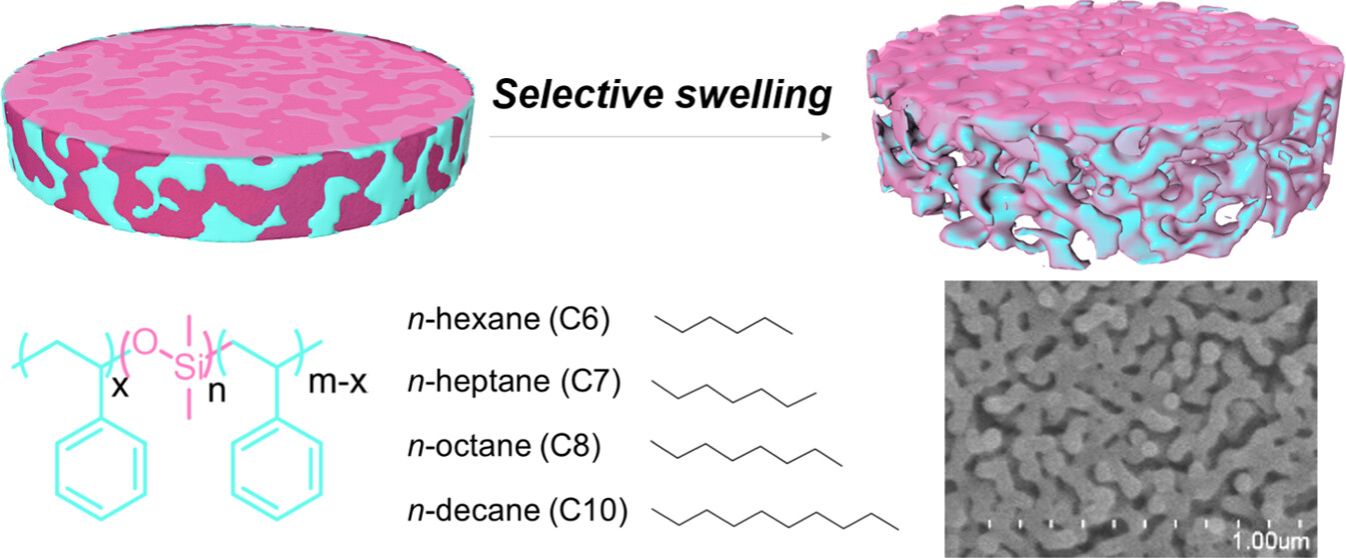
Additive Manufacturing of Defect-Healing Polyamide Membranes for Fast and Robust Desalination
Dongwei Ma, Zhe Zhang*, Sen Xiong, Jiemei Zhou, Yong Wang*, J. Membr. Sci. 2023, 671, 121407
Polyamide membranes that can exclude salts from water have found significant success in desalination applications. The polyamide thickness is difficult to control, as it is closely coupled with other properties including monomer chemistries and substrate structures. In this work, an additive manufacturing strategy using spray-coating to prepare large-area polyamide composite membranes with tunable thickness is explored. Using spray-coating, composite membranes comprising polyamide layers and carbon nanotube (CNT) layers on top of porous substrates are additively constructed. In the context of mediation by CNT layers, thickness control is decoupled from other properties. As a result, the polyamide thickness can be independently adjusted by changing monomer concentrations, and water permeance is found to be related to the thickness. A large-area membrane with a size of 30 × 30 cm2 is successfully prepared under optimal conditions, and exhibits large water permeance of 34.1 L m-2 h-1 bar-1 and high Na2SO4 rejection rate of 95.6%. Importantly, the additive nature holds the ability to eliminate defects possibly existing through multiple spraying, affording defect-healing characteristic. This work allows envisioning a turning point that additive manufacturing is shifting the long-standing paradigm in the preparation of high-performance separation membranes.
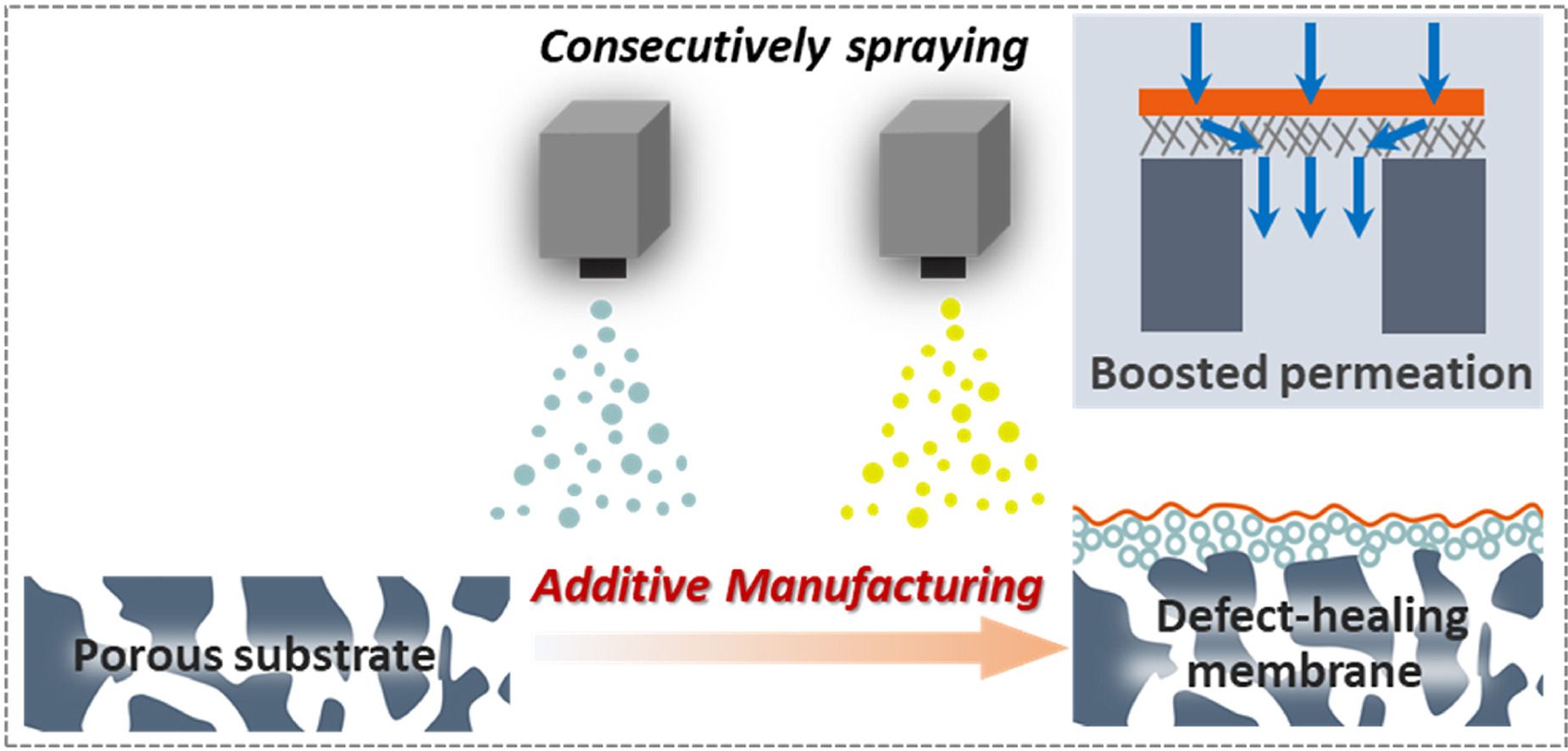
2022
One-pot Synthesis of Metal-coordinated Covalent Organic Frameworks for Enhanced CO2 Photoreduction
Hongbo Xue, Congcong Yin, Sen Xiong, Jingying Yang*, Yong Wang*, ACS Appl. Mater. Interfaces 2022, 14, 49672-49679
Solar energy-driven reduction of CO2 into fuels with H2O as a sacrificial agent is a challenging but desirable subject in photosynthesis. Covalent organic frameworks (COFs) are considered promising candidates for this subject because of their designable structures and functions. The coordination of transition metal ions into COFs is a feasible way to boost the photocatalytic activity. However, postsynthetic modification of COFs with metal ions often leads to a significant decrease in crystallinity and the specific surface area. Herein, we develop a one-pot synthesis of metal-coordinated (nonnoble metal) COFs with high crystallinity. HB-TAPT + Co with ordered and segregated D-A arrays is synthesized by combining 2,4,6-tris(4-aminophenyl)-1,3,5-triazine (TAPT, a strong electron-acceptor) with 2-hydroxy-1,3,5-benzenetricarbaldehyde (HB)-loaded Co2+ (a strong electron-donor). The CO production when using HB-TAPT + Co under visible light irradiation for 4 h is 78.4 μmol g-1, which is 3.2 times that of HB-TAPT + Co synthesized by the postsynthetic modification method and 2.65 times that of HB-TAPT without the metal ions. HB-TAPT + Co also has good recycling stability in photocatalytic CO2 reduction. Additionally, experimental results have demonstrated that the crystallinities of these metal-coordinated materials contribute greatly to the conversion of CO2 in the photoreaction with H2O. This work provides a new protocol for improving the CO2 photoreduction performance by coordinating metal ions to COFs while maintaining the original crystallinity through a one-pot synthesis method.
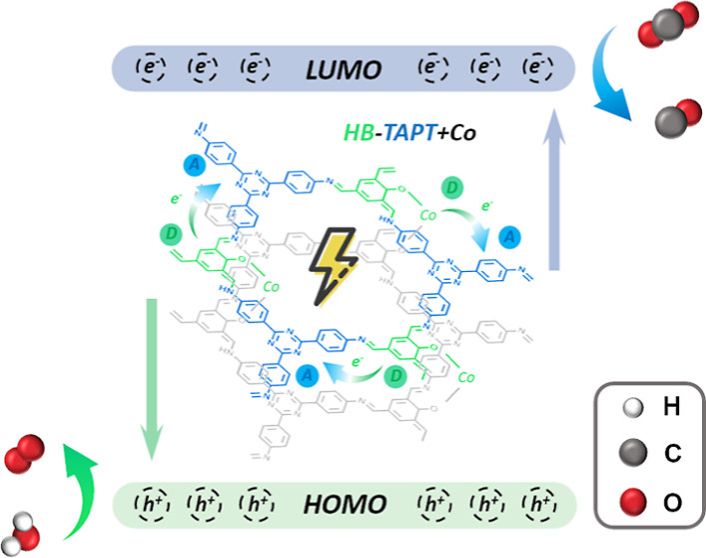
Smart Covalent Organic Frameworks with Intrapore Azobenzene Groups for Light-Gated Ion Transport
Congcong Yin, Zhe Zhang, Zhenshu Si, Xiansong Shi*, Yong Wang*, Chem. Mater. 2022, 34, 9212-9220
Constructing gated ion transport channels is of profound significance for a variety of applications but remains challenging. Covalent organic frameworks (COFs), as a new class of reticular materials, have demonstrated superiority in controllable transport and precise separation of fine species including ions. Herein, we engineer a light-responsive COF featuring intrapore azobenzene groups for highly efficient and adjustable transport of multivalent ions. Such azobenzene-tagged channels afford a customizable configuration that is precisely switchable at an angstrom level without compromising crystallinity. The membrane-shaped COFs exhibit an exceptional discrimination capability between monovalent and multivalent ions, rendering a K+/Al3+ selectivity of above 6000. Particularly, the azobenzene-decorated ordered nanochannels empower reversible, remote-controlled ion transport, implementing the tailor-made recycling of ionic adjuvants used for antibiotic production. This study reports the design and synthesis of a stimulus-responsive COF and demonstrates the efficient separation of ions by light-gated nanochannels of the smart COF.
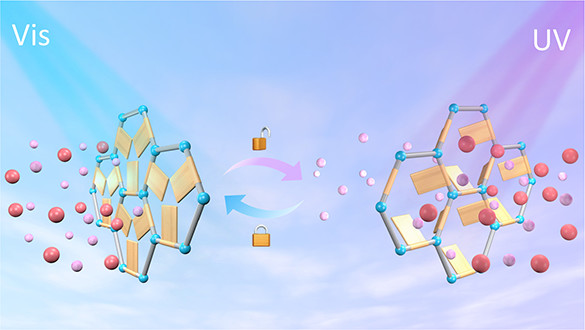
Controlled Biomolecules Separation by CO2-Responsive Block Copolymer Membranes
Xiangyue Ye, Jiemei Zhou*, Chenxu Zhang, Yong Wang*, J. Membr. Sci. 2022, 662, 121022
The intelligent responsive membranes have aroused much attention due to their distinctive capability to reversibly change separation performances under the stimulation of ambient environment. Especially, the responsive membranes derived from block copolymers, which have regular nanoporous structures, display great potential in high-precision controllable separation. Herein, we use CO2 gas as the non-toxic, mild stimulus, and develop the responsive membranes from a block copolymer of poly(2-diethylaminoethyl methacrylate)-block-polystyrene (PDEAEMA-b-PS) by the selective swelling method. The membranes exhibit a bi-continuous nanoporous structure and the surfaces and pore walls are rich with CO2-responsive PDEAEMA chains. Based on the reversible conformation transition of PDEAEMA chains between the collapsed state and extended state upon CO2/N2 stimulation, the membranes achieve the controllable regulation on the water permeances from ~100 to ~2100 L h−1 m−2 bar−1, also realize the blocking/passing switch for varied proteins. More importantly, the extended PDEAEMA chains shrink the effective pore size down to less than 5 nm, moving the separation scope from ultrafiltration to tight-ultrafiltration. Thus, the membranes are capable to separate macromolecular proteins with small molecule polypeptide and vitamin with high separation efficiencies, demonstrating their application prospect in precise separation and fractionation of biomolecules.
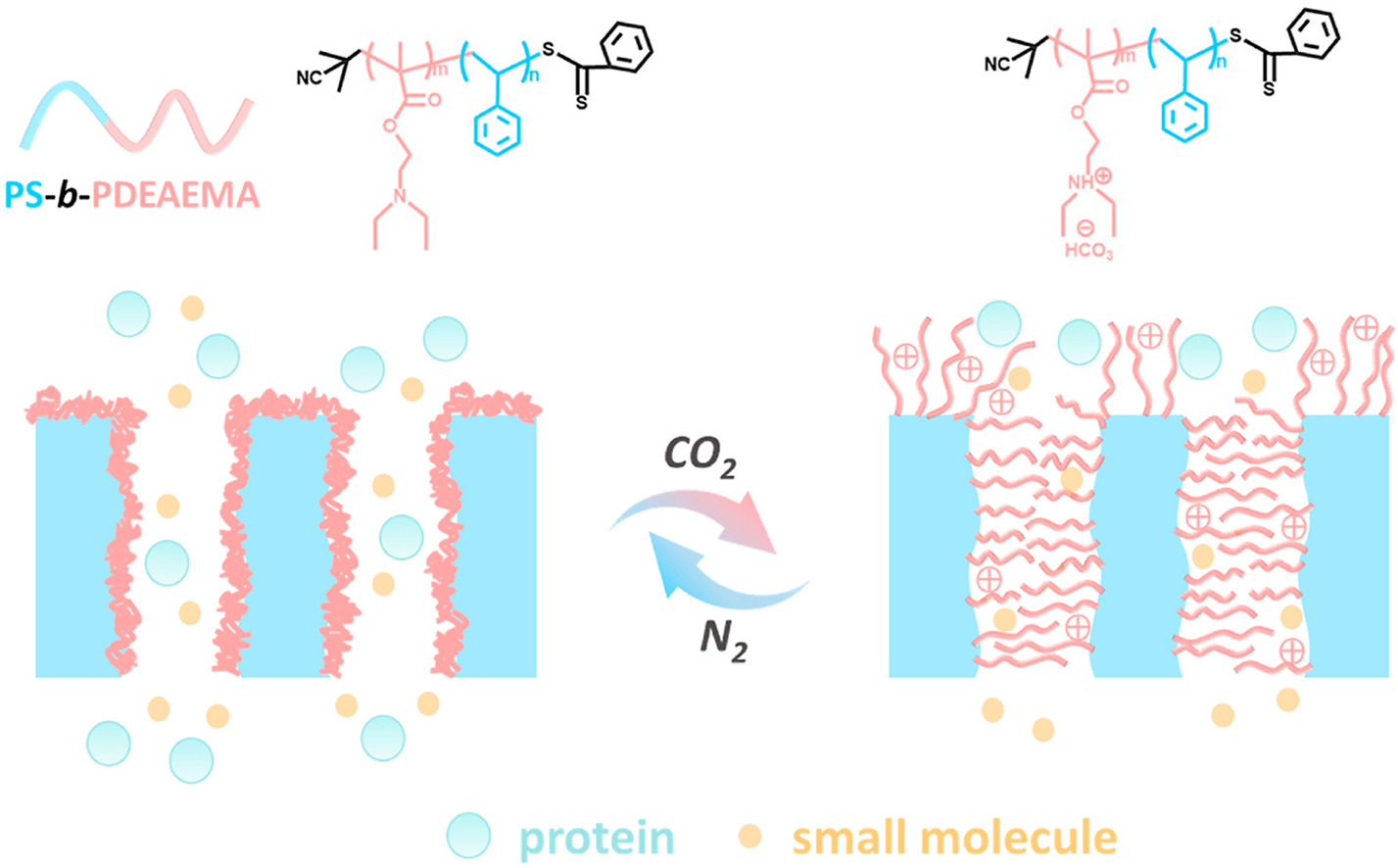
Large-Area Homoporous Membranes (HOMEs) Enabled by Multiple Annealing
Zhe Zhang, Can Chen, Shanshan Zhang, Xiangyue Ye, Jiemei Zhou, Yong Wang*, J. Membr. Sci. 2022, 662, 121021
Homoporous membranes (HOMEs) featuring through pores with almost identical apertures, are highly desired for high-precision separations. It remains a major challenge to produce large-area HOMEs because the microstructure control and defect annihilation become increasingly difficult when membrane sizes are dramatically increased. Herein, we propose a multiple annealing strategy to fabricate large-area HOMEs. Polystyrene-block-poly(2-vinyl pyridine) (PS-b-P2VP) films are first coated on smooth and large substrates.Being annealed by chloroform vapor, perpendicularly aligned P2VP cylinders are formed within the films, and further converted into through pores via the mechanism of selective swelling-induced pore generation. It is shown that the conventional single-time annealing is inadequate to create the ordered through pores, because P2VP chains may have no sufficient time to locomote to the right position as required for the ideal hexagonally arranged ordering. By virtue of the multiple annealing, well-defined through pores can be generated after consecutive annealing for three times, as more P2VP chains aggregate into the ideally ordering position. The films are transferred and composited onto macroporous substrates, producing composite membranes with an effective area of up to ∼100 cm2. The resultant membranes exhibit excellent separation performances. Importantly, HOMEs can be fabricated on low-cost substrates via this strategy, highlighting their great promise in real-world applications of high-precision separations.

Azo-Branched Covalent Organic Framework Thin Films as Active Separators for Superior Sodium-Sulfur Batteries
Congcong Yin, Zhen Li, Decheng Zhao, Jingying Yang*, Yi Zhang, Ya Du, Yong Wang*, ACS Nano 2022, 16, 14178-14187
Sodium-Sulfur (Na-S) batteries are outstanding for their ultrahigh capacity, energy density, and low cost, but they suffer from rapid cell capacity decay and short lifespan because of serious polysulfide shuttle and sluggish redox kinetics. Herein, we synthesize thin films of covalent organic frameworks (COFs) with azobenzene side groups branched to the pore walls. The azobenzene branches deliver dual functions: (1) narrow the pore size to the sub-nanometer scale thus inhibiting the polysulfide shuttle effect and (2) act as ion-hopping sites thus promoting the Na+ migration. Consequently, the Na-S battery using the COF thin film as the separator exhibits a high capacity of 1295 mA h g-1 at 0.2 C and an extremely low attenuation rate of 0.036% per cycle over 1000 cycles at 1 C. This work highlights the importance of separator design in upgrading Na-S batteries and demonstrates the possibility of functionalizable framework materials in developing high-performance energy storage systems.
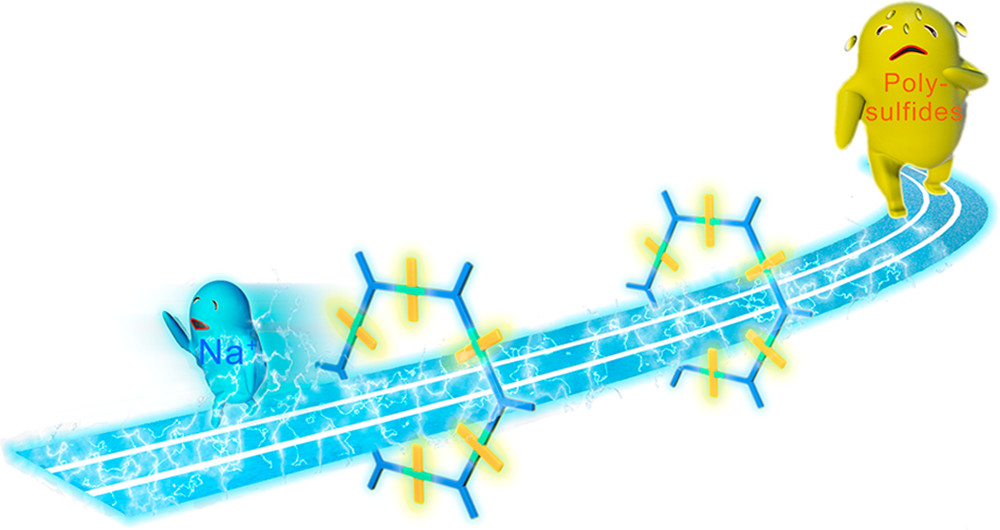
Boosting the Permeation of Ultrafiltration Membranes by Covalent Organic Frameworks Nanofillers: Nanofibers Doing Better Than Nanoparticles
Guanghui Yang, Zhe Zhang*, Congcong Yin, Xiansong Shi, Yong Wang*, J. Membr. Sci. 2022, 661, 120944
Mixed matrix membranes (MMMs) have attracted everlasting attentions, as their large permeance and high selectivity can be accessible synchronously. Herein, we show that covalent organic framework (COF) nanofibers serving as the nanofillers are doing better than COF nanoparticles in boosting the separation performance of MMMs. The nanofibers and the nanoparticles are synthesized and doped into polysulfone matrices to prepare MMMs. The high porosity and relative hydrophilicity of TpPa nanofibers and nanoparticles enable rapid exchange of solvent and nonsolvent during the process of nonsolvent induced phase separation, thus leading to instantaneous demixing. Furthermore, compared with TpPa nanoparticles with small and irregular shapes, the one-dimensional structure of TpPa nanofibers weakens the entanglement of the surrounding polysulfone linear chains, resulting in much pronounced instantaneous demixing. In contrast with the nanoparticle-incorporated membranes, the porosity of nanofiber-incorporated membranes is significantly improved. The resultant nanofiber-incorporated membrane demonstrates a high water permeance of 424.4 L m-2 h-1 bar-1, along with a BSA rejection rate of 94.3%. This work clearly reveals that porous one-dimensional structures such as COF nanofibers are highly promising in the preparation of high-performance MMMs.
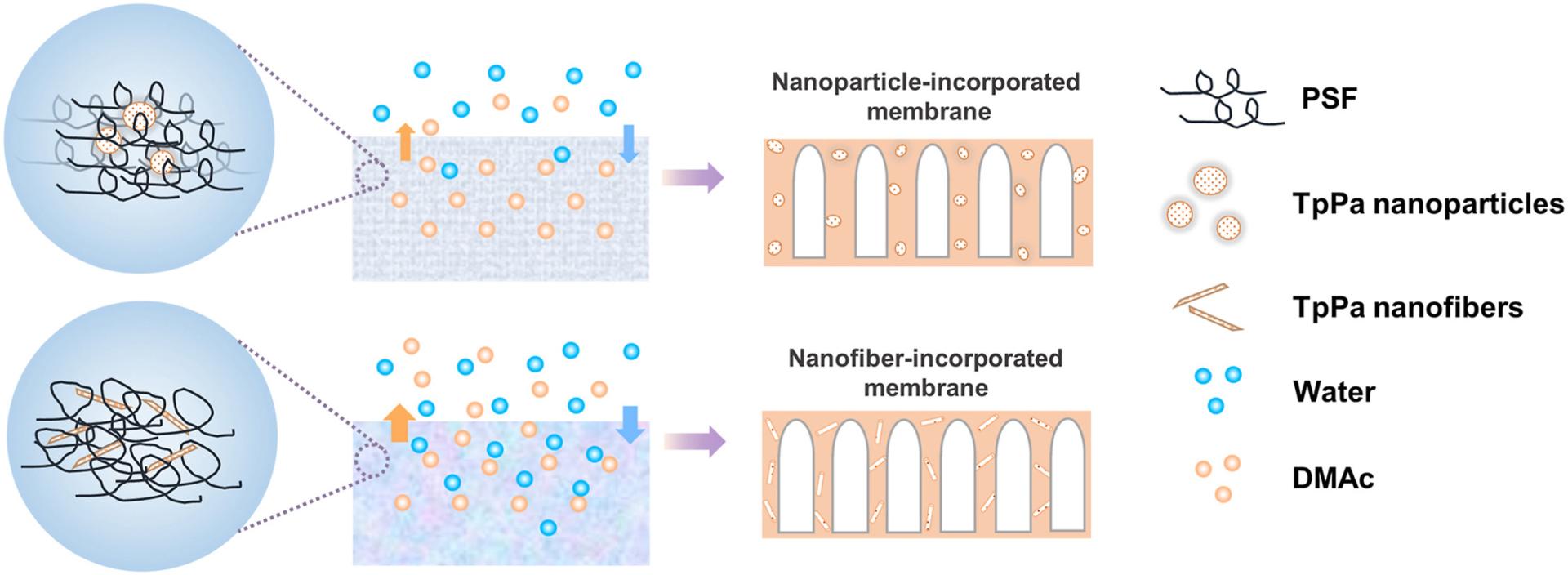
Cavitating Substrates to Boost Water Permeance of Reverse Osmosis Membranes
Hao Yang, Zhe Zhang, Yong Wang*, Sep. Purif. Technol. 2022, 299, 121810
Reverse osmosis membranes have been shown to achieve reliable freshwater supply by means of water desalination. Nevertheless, breaking the long-standing trade-off is a major challenge for realizing high-efficient desalination. Herein, we show that selective swelling of substrates made by a block copolymer, polysulfone-block-poly(ethylene glycol) (PSF-b-PEG), is very promising in the fabrication of high-flux reverse osmosis membranes. Polyamide layers are first formed on relatively dense PSF-b-PEG substrates by interfacial polymerization. Then, the substrates are cavitated into highly porous substrates by selective swelling, which follows the mechanism of selective swelling-induced pore generation. The substrate porosity can be well tuned over a wide range via adjusting swelling duration. Selective swelling does not compromise the structural integrity and surface properties of polyamide layers atop the substrates. Importantly, the boosted porosity reduces the water transport resistance in substrates markedly, which in turn enables fast water permeation in reverse osmosis membranes. Thus, the optimal membrane shows exceptional water permeance of 50.4 L m-2 h-1 MPa-1 and a high NaCl rejection of 99.2%. Our work not only offers a novel strategy to enhance the water permeance of reverse osmosis membranes, but also demonstrates that the transport resistance of substrates also significantly influences water permeance of reverse osmosis membranes.

Design of Three-Dimensional Covalent Organic Framework Membranes for Fast and Robust Organic Solvent Nanofiltration
Xiansong Shi, Zhipeng Zhang, Congcong Yin, Xin Zhang, Jianghai Long, Zhe Zhang, Yong Wang*, Angew. Chem. Int. Ed. 2022, 61, e202207559
Organic solvent nanofiltration (OSN) has become increasingly important in petrochemical and pharmaceutical industries, demanding superior and robust membranes. Herein, we report advanced OSN processes by designing three-dimensional covalent organic framework (3D COF) membranes through moderated interfacial crystallization. Nanoporous supports work as the moderator allowing the crystallization of 3D COF membranes. The 3D COF features sub-nanometer and anti-swelling channels, affording a sharp selectivity to fine targets with an exceptionally high and stable methanol permeance. Thus-synthesized membrane exhibits a record stability against high-concentration feeds and long-term operation for ~1000 h. Moreover, we unambiguously demonstrate that our membrane holds excellent practicality in purifying active pharmaceutical ingredients from organic liquids. This work reveals the great potential of distinctive 3D COFs in producing prominent OSN membranes for industrial applications.
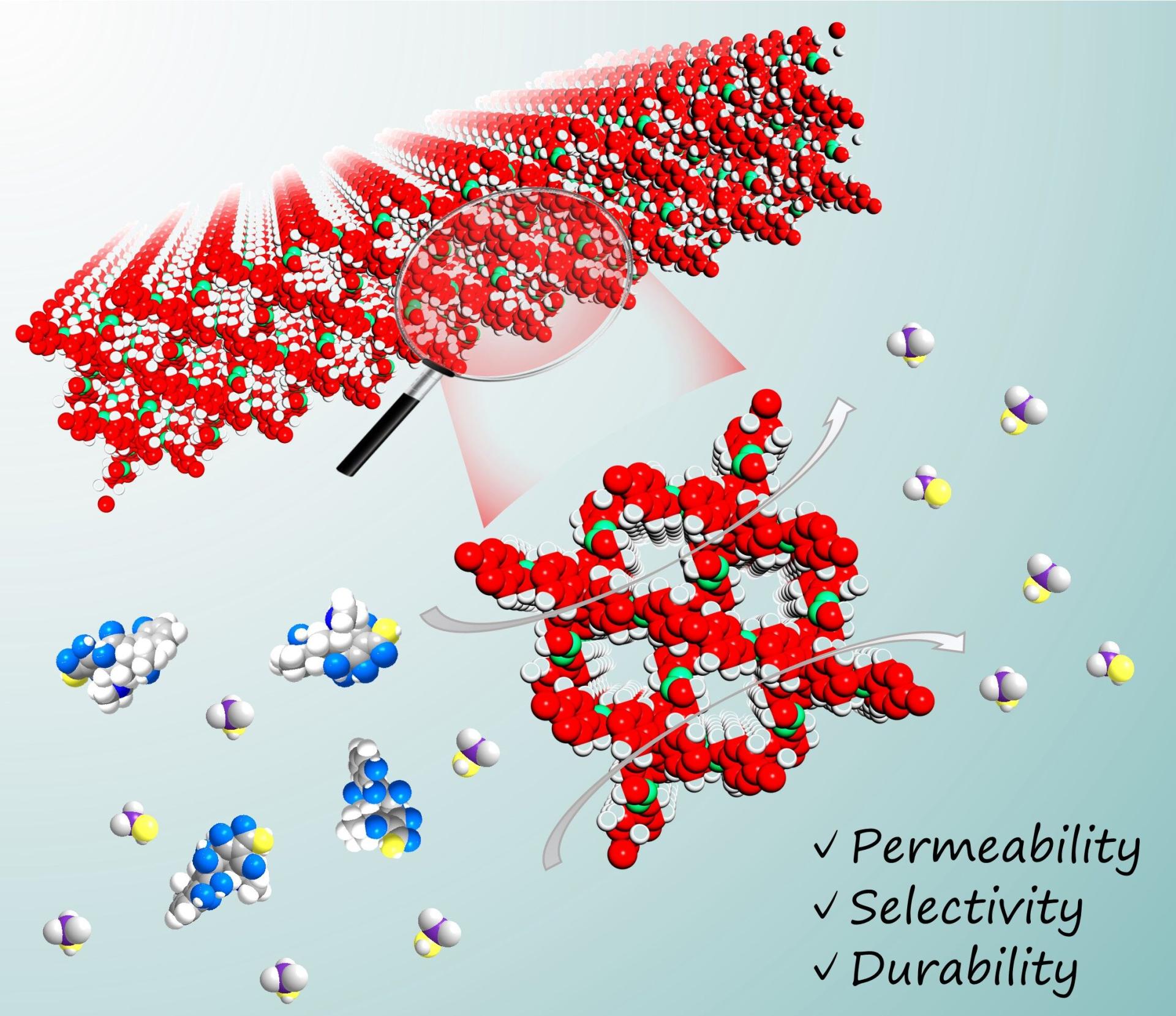
High-Purity, High-Yield Synthesis of Covalent Organic Framework Nanosheets for Fast and Selective Molecular Separation
Zhipeng Zhang, Qianqian Lan, Decai Liao, Xiansong Shi*, Mingjie Wei, Zhe Zhang, Xingyuan Wang, Yong Wang*, Chem. Mater. 2022, 34, 6345-6354
Covalent organic framework nanosheets (CONs) with extremely thin thicknesses and inborn penetrating nanopores are attractive in transport-related applications. However, the strong tendency of π–π stacking between adjacent laminates hinders their mass production. Herein, we report a facile glycerol-mediated strategy for synthesizing various well-dispersed CONs in liquid phases. The CONs are readily prepared by dissolving monomers in glycerol and subsequent thermal condensation. Experimental and computational investigations reveal that the strong hydrogen bonds between glycerol and CONs suppress the π–π stacking interaction, leading to well-dispersed CONs. Additionally, glycerol acetalization with aldehyde monomers also contributes to the formation of CONs by decreasing the diffusion rate of reactants. The synthesized CONs show a lateral size of over 10 μm and a uniform thickness of ∼4 nm, and their yield is as high as ∼73%. CONs deposited on porous substrates exhibit remarkable permselectivities surpassing most reported membranes and exceptional dye/salt separation performances. This study provides a new strategy for synthesizing CONs and increases the understanding of the important role of solvents in the synthesis of two-dimensional materials.
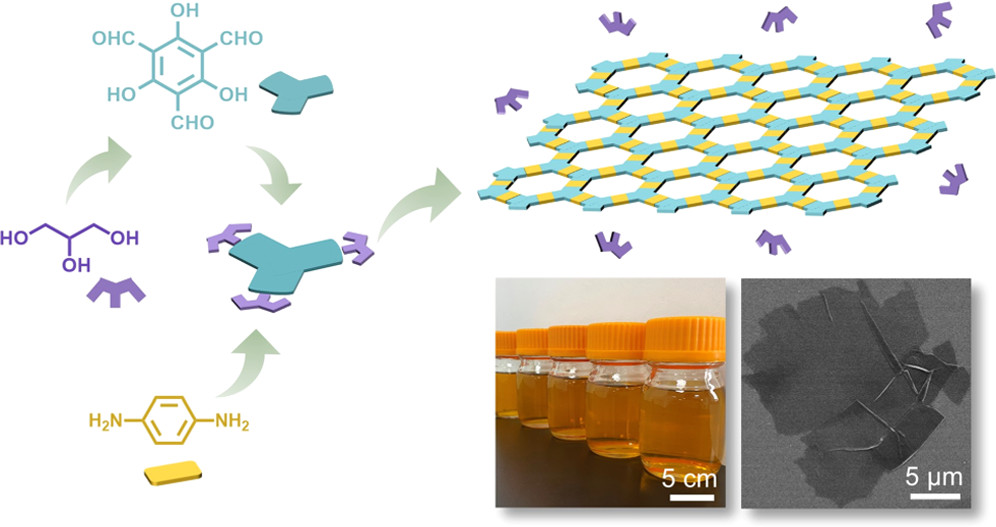
Interference Mechanism of Cations on Transport of Lithium and Magnesium Inside COF Nanofiltration Membranes
Decai Liao, Zhaoqin Xu, Mingjie Wei*, Yong Wang, Mol. Simul. 2022, 48, 1369-1377
Membrane technology is playing an important role in the separation of magnesium and lithium from brines, and high Li/Mg selectivity in membrane separation is constantly pursued. However, it has been found that there is always a selectivity variation when using individual salts to replace the salt mixture as the feed, implying that the interference mechanism of mixed cations remains unclear. Herein, by using covalent organic frameworks as an example, we investigate the ion transport behaviours through nanopores with the mixed and individual feeding of LiCl and MgCl2 via molecular dynamics simulations. There is an evident reduced Li/Mg selectivity while the mixed-salt feed is applied. It is revealed that Li+ interacts strongly with pore-wall atoms while Mg2+ with water molecules. Consequently, Mg2+ tends to flow with water molecules while Li+ is prone to adsorb to the pore wall. The presence of Mg2+ inside nanopores will bring down water flux and seriously reduce the transport of Li+ inside nanopores. The advantage of pre-adsorbing for Li+, which promotes the Li/Mg selectivity, is completely balanced out, thus reducing selectivity. Our results also suggest that impeding the entrance of Mg2+ into membranes will avoid the selectivity drop not only because of the sieving effecting.

Solvent-Free Process to High-Flux Ultrafiltration Membranes: Spray Coating of Water-Dispersed Carbon Nanotubes
Dongwei Ma, Xiangyue Ye, Xiansong Shi, Jiemei Zhou, Yong Wang*, ACS EST Water 2022, 2, 895-903
Mainstream ultrafiltration (UF) membranes are typically produced from the phase inversion of polymer solutions and suffer from the extensive use of organic solvents and disposal of organic wastewater. Therefore, it remains highly demanding for clean processes to produce UF membranes at no expense of separation performances. Herein, we report the preparation of high-performance carbon nanotube (CNT)-based membranes without using any organic solvents. CNTs are first homogeneously dispersed in water with the assistance of an amphiphilic block copolymer. The CNT-based membranes, composed by a separation layer of stabilized CNT networks and macroporous supports, are obtained by spray coating aqueous CNT dispersions. The pore sizes of thus-prepared CNT UF membranes are easily tuned by controlling the diameter of CNTs or the spraying volumes of the CNT dispersions. The CNT membranes exhibit superior water permeance (460–7750 L m-2 h-1 bar-1) compared with membranes produced by other methods with similar pore sizes. This solvent-free process enabled by spray coating is expected to extend to other water-dispersible low-dimensional building blocks in clean preparation of various high-performance membranes.
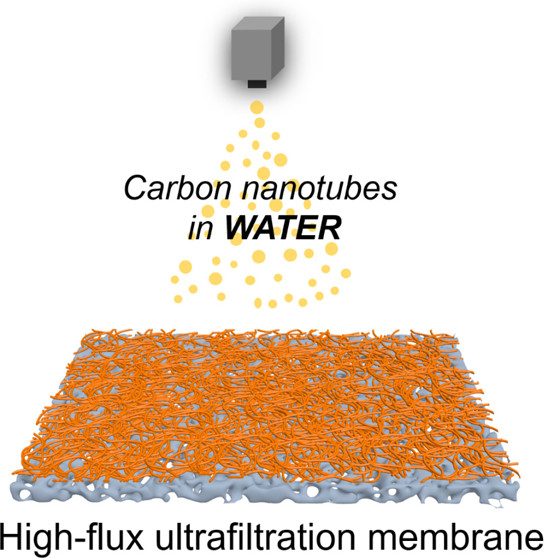
Atomic Layer Deposition for Membrane Modification, Functionalization and Preparation: A Review
Sen Xiong, Xiaofeng Qian, Zhaoxiang Zhong, Yong Wang*, J. Membr. Sci. 2022, 658, 120740
Membrane separation is playing an increasingly important role in providing clean water and other resources to our thirsty globe. In addition to preparation of new membranes, modification and functionalization to existing membranes are frequently desired to maximize their performance. Among different strategies, the newly emerged atomic layer deposition (ALD) is distinguished for its universality in upgrading of almost all types of membranes independent of membrane structure and chemistry, as well as its striking capability of simultaneously enhancing selectivity and permeability. ALD is based on alternative reactions between gaseous precursors on solid surfaces including pore walls, and it deposits uniform and defect-free, angstrom-scale thin coatings conformally along the substrate surface. In this Review, we first discuss the basic principles of ALD and the early history of utilizing ALD to modify inorganic membranes for gas separation, and then analyze the advantages of applying ALD to upgrade membranes for water purification and gas separation. By directly ALD depositing metal oxides onto membrane surface, the hydrophilicity, fouling resistance and other properties are evidently improved. The (photo)catalysis, adsorption, antibacterial property, tunable wettability and other new functions can be integrated into membrane separation by ALD. Alternatively, in the non-direct ALD fashion, the polymeric membranes are first subjected to surface activation, greatly facilitating ALD processes and lowering the threshold for ALD to break the trade-off effect. For inorganic membranes, ALD has also been used to adjust the pore sizes, or to establish new separation layers to enhance the selectivity. We highlight recent progresses in ALD of polymeric materials on inorganic and polymeric substrates, producing advanced membranes with new configurations. Utilization of ALD to prepare or to functionalize new membranes, innovative ALD devices and processes, which are essential for the mass production of ALD-upgraded membranes, are also discussed. We conclude this review by discussing further development, challenges, and limitations of ALD-enabled membrane modification, functionalization, and preparation. As ALD is originally designed for microelectronics, and is not known for long and for many in the membrane community, we expect this review to inspire further attentions and research efforts tackling urgent problems of membrane separation. Also, it may spark new wave of studies on ALD and other advanced deposition technology toward next-generation membranes.

Molecularly Engineered Three-Dimensional Covalent Organic Framework Protection Films for Highly Stable Zinc Anodes in Aqueous Electrolyte
Kuan Wu,‡ Xiansong Shi,‡ Fangfang Yu, Haoxuan Liu, Yuanjun Zhang, Minghong Wu, Hua-Kun Liu, Shi-Xue Dou, Yong Wang, Chao Wu*, Energy Stor. Mater. 2022, 51, 391-399
Metallic Zn has been regarded as ideal anodes in aqueous electrolyte owing to it high theoretical capacity, intrinsic safety, low cost, and nontoxicity. However, the Zn dendrite growth and the side-reactions hindered the practical application of Zn anode. Herein, a thin and uniform three-dimensional (3D) COOH-functionalized covalent organic frameworks (COF) film (denoted as 3D-COOH-COF) is designed and in-situ synthesized as a protective layer to stabilize the Zn anode. The thin 3D-COOH-COF protection film with abundant negative functional groups and homogeneous nanochannels facilitates the fast transport of Zn2+, impedes the pass through of SO42-, and significantly suppresses the corrosion reactions, leading to an excellent electrochemical performance. The novel 3D-COOH-COF protective film enables the Zn||Zn symmetric cells to stably cycle for over 2000 h at 1 mA cm-2 and an average Coulombic efficiency of Zn plating/stripping as high as 99.5% for 1000 cycles at 1 mA cm-2. This finding provides a facile and promising route to regulate the deposition behavior of Zn in aqueous electrolyte.
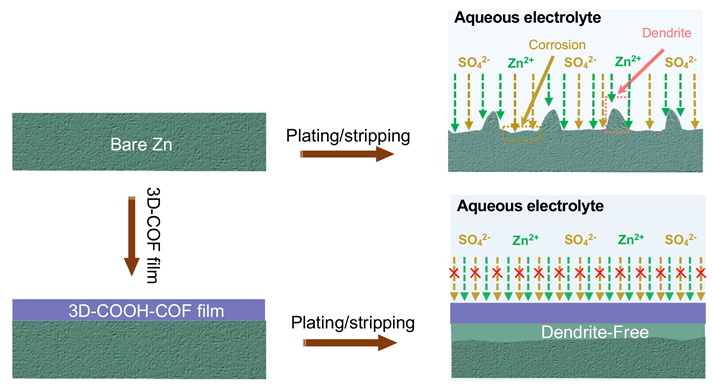
Heterostructured Two-Dimensional Covalent Organic Framework Membranes for Enhanced Ion Separation
Zhe Zhang, Ankang Xiao, Congcong Yin, Xingyuan Wang, Xiansong Shi*, Yong Wang, Chem. Comm. 2022, 58, 7136-7139
A heterostructured covalent organic framework (COF) membrane is synthesized via in-situ linker exchange. The narrowed pore can be formed at the interface between two types of COFs by adjusting the linker exchange duration. The resultant COF membrane demonstrates a high rejection rate toward Na2SO4 of up to 97%.
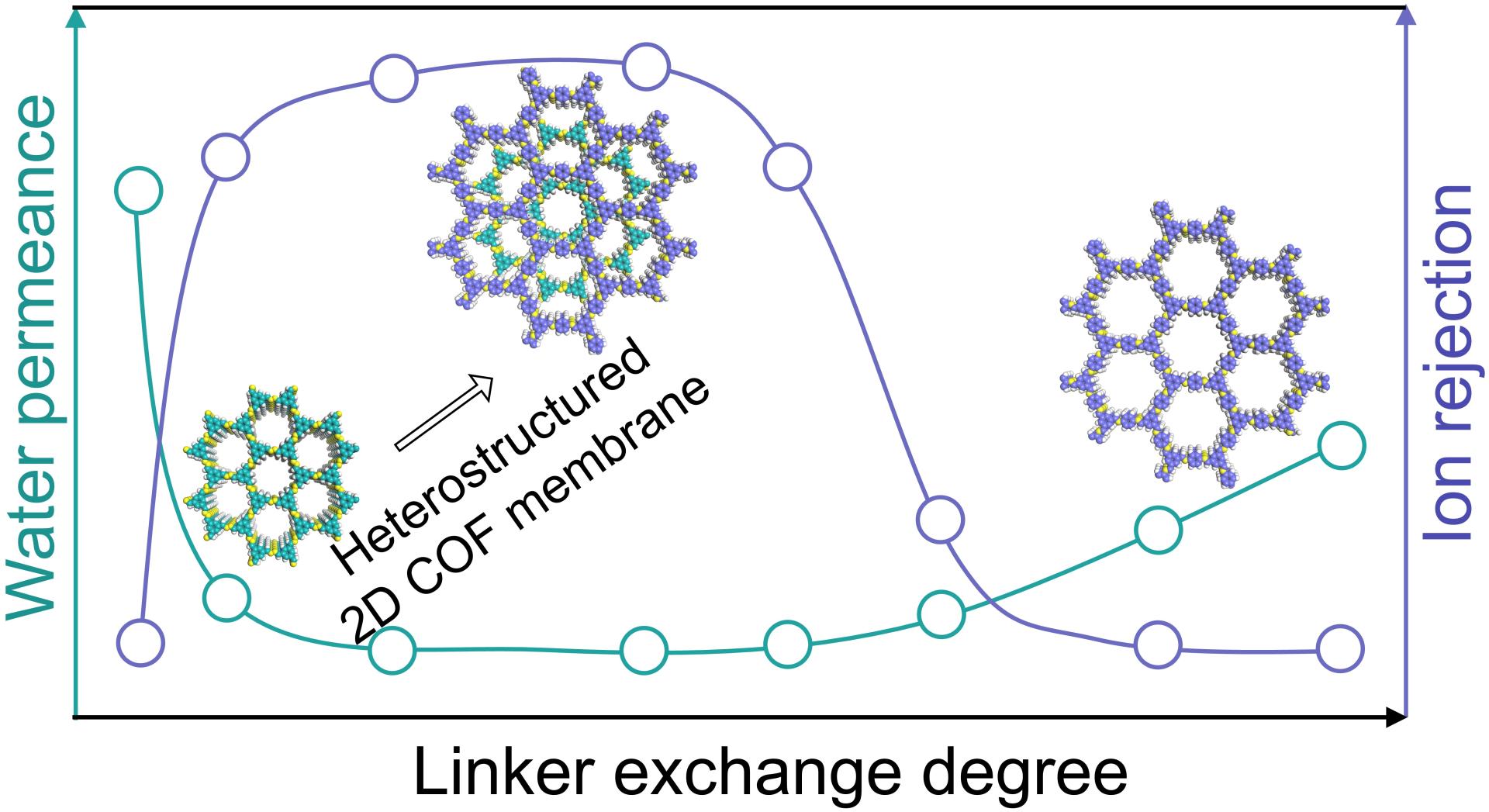
(Cover) Morphology Engineering for Covalent Organic Frameworks (COFs) by Surfactant Mediation and Acid Adjustment
Guanghui Yang, Zhe Zhang*, Congcong Yin, Xiansong Shi, Yong Wang*, Chin. J. Polym. Sci. 2022, 40, 338-344
Two-dimensional covalent organic frameworks (COFs) with specific morphologies including nanofibers and nanoplates are highly desired in both nanoscience research and practical applications. Thus far, however, morphology engineering for COFs remains challenging because the mechanism underlying the morphology formation and evolution of COFs is not well understood. Herein, we propose a strategy of surfactant mediation coupled with acid adjustment to engineer the morphology of a β-ketoenamine-linked COF, TpPa, during solvothermal synthesis. The surfactants function as stabilizers that can encapsulate monomers and prepolymers to create micelles, enabling the formation of fiber-like and plate-like morphologies of TpPa rather than irregularly shaped aggregates. It is also found that acetic acid is important in regulating such morphologies, as the amino groups inside the prepolymers can be precisely protonated by acid adjustment, leading to an inhibited ripening process for the creation of specific morphologies. Benefitting from the synergistic enhancement of surfactant mediation and acid adjustment, TpPa nanofibers with a diameter down to ∼20 nm along with a length of up to a few microns and TpPa nanoplates with a thickness of ∼18 nm are created. Our work sheds light on the mechanism underlying the morphology formation and evolution of TpPa, providing some guidance for exquisite control over the growth of COFs, which is of great significance for their practical applications.

Selective Swelling of Stretched Block Copolymer Hollow Fibers for Upgraded Membrane Performance
Dinglei Zhong, Shoutian Qiu*, Jiemei Zhou, Dongwei Ma, Yong Wang*, ACS Appl. Polym. Mater. 2022, 4, 7989-7997
Block copolymers are showing great potential in the preparation of advanced membranes for precise separations, and there is a strong interest in the development of hollow-fiber membranes (HFMs) from block copolymers. Herein, we report polysulfone-block-poly(ethylene glycol) (PSF-b-PEG) HFMs with enhanced separation performance prepared by a convenient stretching strategy. Axial stretching is first applied to the meltspun PSF-b-PEG hollow fibers, efficiently reducing the wall thickness and outer diameter of the hollow fibers. The stretched hollow fibers are then subjected to selective swelling, thus producing HFMs with interconnected nanoporosity. We find that the degree of stretching significantly influences the diameter, length, and separation performance as well as the crystallization behavior of the hollow fibers before and after selective swelling. With a stretching percentage of 527%, the HFMs exhibit simultaneously enhanced water permeance and rejection because of thinned fiber walls and reduced pore sizes. This work reveals the important role of axial stretching in upgrading the performance of block copolymer HFMs and demonstrates that the selective swelling coupled with melt spinning is promising in the cleaner preparation of HFMs.
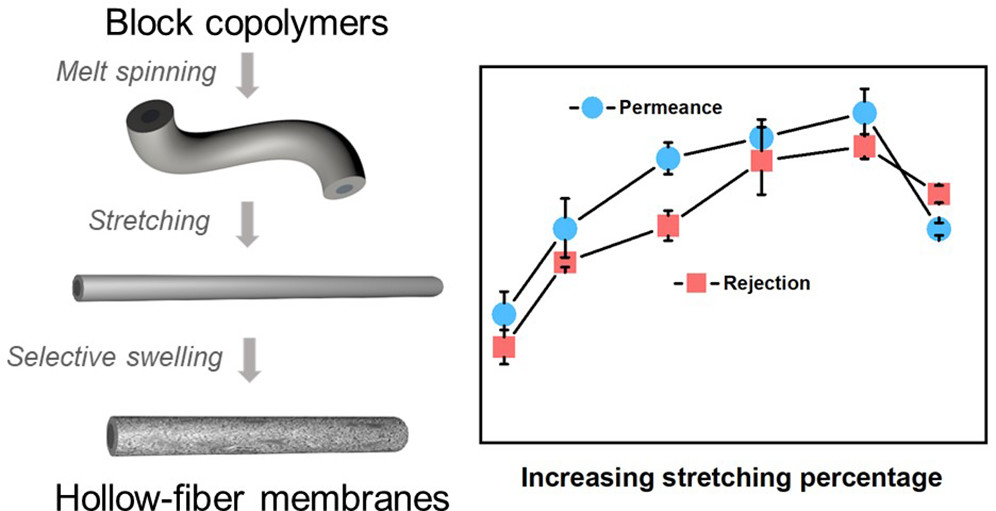
Designing Sub-nanometer Pores for Efficient Boron Removal
Xin Zhang, Mingjie Wei*, Yong Wang*, Desalination 2022, 533, 115755
Efficient boron removal is one of the key challenges for reverse osmosis membranes. Understanding the transport behavior of boric acid (B(OH)3) at the molecular level is of great importance to design pores with high permselectivity. Herein, via non-equilibrium molecular dynamics simulations, the B(OH)3 rejection is found to be closely related to the hydrophilicity, shape, and size of sub-nanometer pores. Among these structure parameters, the role of the pore shape is dominant as the slit pore has ≤20% B(OH)3 rejections regardless of the pore hydrophilicity and slit width. It is due to the nature of the B(OH)3 molecule being plate-like, even when it is hydrated. Such a unique structure makes the B(OH)3 rejection depend on the major diameter of the non-circular pores. On the other hand, the circular pore, which has the same diameter in all directions, is the most suitable to reject B(OH)3 molecules while providing high water permeance. With a circular pore shape, hydrophilic pores favor the B(OH)3 rejection because the preferentially adsorbed water molecules inside pores can impede the passage of B(OH)3. These findings are expected to guide the rational design and screening of the nanoporous materials for efficient boron removal.

Three-Dimensional Covalent Organic Framework Membranes: Synthesis by Oligomer Interfacial Ripening and Application in Precise Separations
Xiansong Shi, Zhe Zhang, Mingjie Wei, Xingyuan Wang, Jingtao Wang, Yatao Zhang, Yong Wang*, Macromolecules 2022, 55, 3259-3266
Covalent organic framework (COF) membranes are viable to tackle intractable separations, thanks to their uniform configurations and devisable functions. However, in stark contrast to the intensively studied two-dimensional COF membranes, three-dimensional (3D) COF membranes with unique merits remain largely unexplored because of formidable synthetic obstacles. Herein, we report a novel method to produce robust 3D COF membranes with interpenetrated nanochannels by ripening presynthesized oligomers at the organic–water interface. With the amphiphilicity and appropriate size, oligomers are prone to be entrapped at the designed interface. The ripening of interface-captured oligomers generates self-supporting crystalline 3D COF membranes with controllable thicknesses. The resulting membranes are provided with uniformly interpenetrated nanochannels, of which the aperture sizes ranging from ∼0.8 to 1.5 nm can be tailor-made by monomer design. We further identify the prominent competence of these 3D COF membranes in the high-precision fractionation of ions and molecules. Particularly, the sub-nanometer channels of the 3D COF-1 membrane allow for the efficient sieving of mono- and multivalent ions, attaining a K+/Al3+ selectivity of >800. This work reports a facile but efficient strategy to synthesize COF membranes and opens up the applications of 3D COFs in the precise separation of ions and fine molecules.
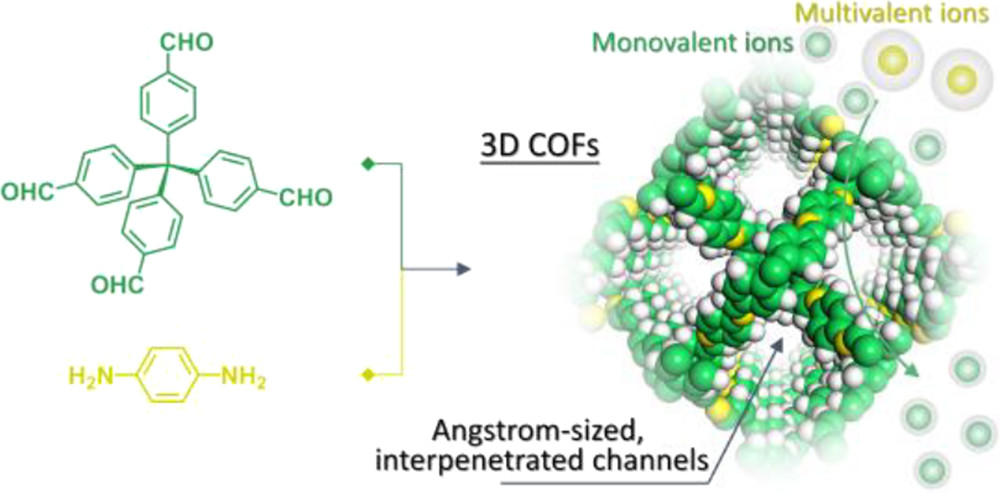
Electrosynthesis of Ionic Covalent Organic Frameworks for Charge-Selective Separation of Molecules
Xingyuan Wang, Jingying Yang, Xiansong Shi*, Zhe Zhang, Congcong Yin, Yong Wang*, Small 2022, 2107108
Covalent organic frameworks (COFs) have emerged as potent material platforms for engineering advanced membranes to tackle challenging separation demands. However, the synthesis of COF membranes is currently hampered by suboptimal productivity and harsh synthesis conditions, especially for ionic COFs with perdurable charges. Herein, ionic COFs with charged nanochannels are electrically synthesized on conductive supports to rapidly construct composite membranes for charge-selective separations of small molecules. The intrinsic charging nature and strong charge intensity of ionic COFs are demonstrated to collectively dominate the membrane growth. Spontaneous repairing to diminish defects under the applied electric field is observed, in favor of generating well-grown COF membranes. Altering electrosynthetic conditions realizes the precise control over the membrane thickness and thus the separation ability. Electrically synthesized ionic COF membranes exhibit remarkable molecular separation performances due to their relatively ordered and charged nanochannels. With these charge-selective pathways, the membranes enable the efficient sieving of charged and neutral molecules with analogous structures. This study reveals an electrical route to synthesizing COF thin films, and showcases the great potential of ionic nanochannels in precise separation based on charge selectivity.
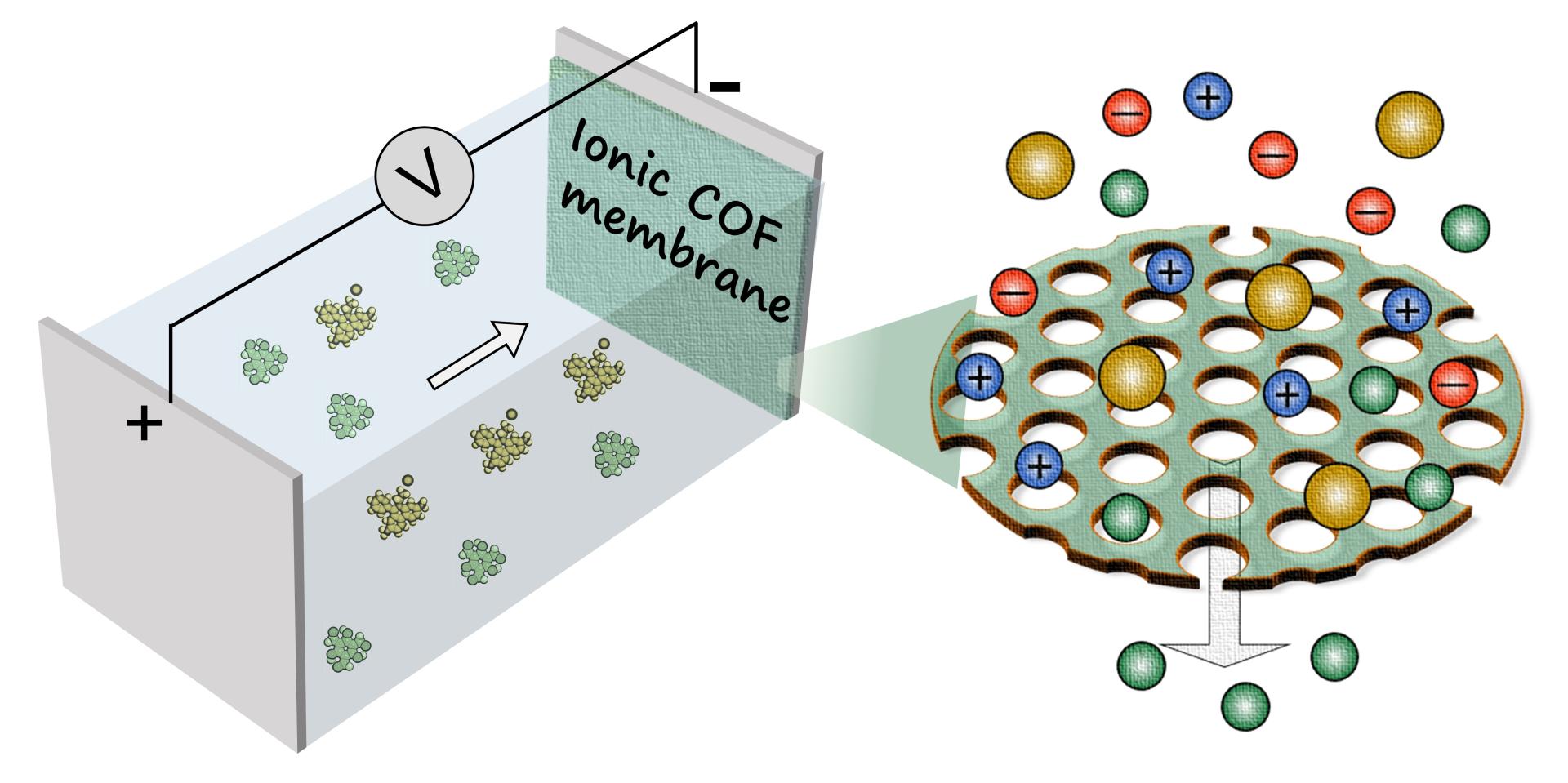
Boron Removal by Water Molecules Inside Covalent Organic Framework (COF) Multilayers
Xin Zhang, Mingjie Wei*, Zhe Zhang, Xiansong Shi, Yong Wang*, Desalination 2022, 526, 115548
Removal of small neutral solutes (SNSs) by reverse osmosis membranes is crucial but challenging. Common consideration of narrowing pore sizes works very little as SNSs have close sizes to the one of water molecules. The most serious drawback of narrowing pore sizes is the reduction of permeance, which dramatically enhances the energy input per volume of permeate water. In this work, an alternative strategy of driving water molecules to reject SNSs is proposed. Using non-equilibrium molecular dynamics simulations, we reveal that inside the nanopores of TpTG multilayers, stable imine-linked covalent organic frameworks, water molecules will preferentially adsorb via the hydrogen bonding interaction. In that way, water molecules in TpTG multilayers other than TpTG themselves can completely reject SNSs, e.g. boric acid. The permeance of TpTG multilayers is excellent as the nanopores are fulfilled with fluidic water. The findings in this work will inspire researchers with an alternative way to design the membranes for SNS removal.

Nanocomposite Block Copolymer Membranes with Enhanced Permeance and Robustness by Carbon Nanotube Doping
Qianqian Lan, Nina Yan*, Hao Yang, Yong Wang*, Compos. Commun. 2022, 29, 101025
Block copolymers (BCPs) have received extensive attention in the preparation of advanced membranes for precise separations. However, BCP-derived membranes usually suffer from insufficient mechanical robustness, especially for the most extensively studied polystyrene-based ones. Herein, carbon nanotubes (CNTs) are incorporated into polystyrene-block-poly (2-vinyl pyridine) (S2VP) membranes to enhance the mechanical robustness and water permeance. It is found that mild oxidation is enough to enable the homogeneous dispersion of CNTs in the S2VP solution. The CNT/S2VP mixture is directly coated on macroporous substrates, followed by selective swelling-induced pore generation to produce the CNT-doped S2VP nanocomposite membranes. The as-prepared membranes are featured with two sets of pores: swelling-induced pores and incompatibility-induced nanoscale gaps between CNTs and the S2VP matrix, leading to improved permeances without any decrease of the retention performances. Also, owing to the presence of CNTs in the polymer matrix, the membranes show excellent mechanical robustness and exhibit better pressure resistance than neat S2VP membrane without CNT doping. This work demonstrates a simple yet efficient strategy to prepare BCP-based nanocomposite membranes with enhanced permeance and robustness at no expense of retention.

Masking Covalent Organic Frameworks (COFs) with Loose Polyamide Networks for Precise Nanofiltration
Zhe Zhang, Congcong Yin, Xiansong Shi, Guanghui Yang, Yong Wang*, Sep. Purif. Technol. 2022, 283, 120233
Covalent organic frameworks (COFs) with uniform, tunable nanoporosities are promising alternatives to prepare nanofiltration membranes with homogeneous nanochannels for high-resolution molecular sieving. Due to the poor membrane-forming ability as well as the relatively inadequate strategies for pore engineering, thus far, the preparation of continuous and defect-free COF membranes with tunable pore sizes is still challenging. Herein, we demonstrate an ingenious strategy to prepare the heterostructured membranes featuring the loose polyamide networks masked COF nanofilms for precise sieving of small molecules. The loosely structured polyamides are created by the interfacial polymerization to mask the chemically stitched (chemically interlinked) ultrathin COF nanosheets. The masked polyamide with flexible, loose networks not only enhance the membrane-forming ability of the natively rigid ultrathin COF nanofilms, but also provide a masking effect that can effectively tune the pore size of the heterostructured COF membranes. Benefitting from the synergistic enhancement of the membrane-forming ability and the pore size tunability, thus-prepared membranes exhibit excellent molecular sieving performances toward various small molecules. This work is expected to provide a guidance for the rational design and controllable preparation of COF membranes for precise nanofiltration.

CO2-Responsive Membranes Prepared by Selective Swelling of Block Copolymers and Their Behaviors in Protein Ultrafiltration
Chenxu Zhang, Jiemei Zhou*, Xiangyue Ye, Zhou Li, Yong Wang*, J. Membr. Sci. 2022, 641, 119928
Due to the predominance of CO2 as a new trigger with source abundance, non-toxicity, good reversibility and no byproduct accumulation compared to other triggers, CO2-responsive membranes recently attract wide interest in stimuli-switchable separation. Here we report on the development of CO2-responsive nanoporous membranes with poly(2-dimethylaminoethyl methacrylate)-block-polystyrene (PDMAEMA-b-PS) block polymer (BCP) under the instruction of selective swelling-induced pore generation strategy, where hydrophilic chains of PDMAEMA can be enriched on the membrane surface and pore walls in the swelling process. The tertiary amine of PDMAEMA can be reversibly switched in conformation and charge property under the stimulation of CO2/N2. The CO2-responsive behavior of PDMAEMA enriched on the surface and pore walls has further enabled as-prepared membranes to feature the tunable pore size by introducing and removing CO2 gas. As a result, the PDMAEMA-b-PS nanoporous membranes exhibit excellent regulation in separation performances in terms of the permeance and rejection to varied proteins under the stimulation of CO2/N2. This work represents a simple and reliable way for making CO2-responsive membranes.
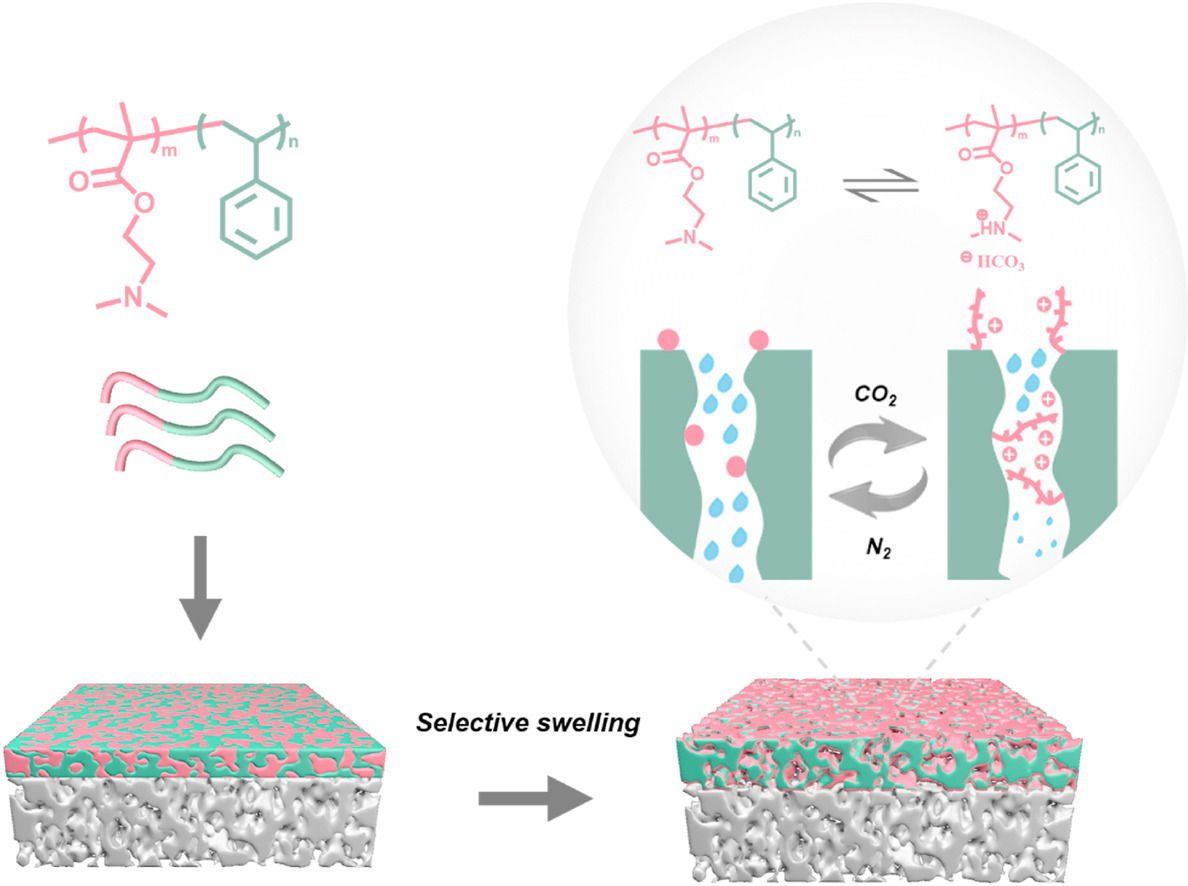
Atomic Layer Deposition of TiO2 on Carbon-Nanotubes Membrane for Capacitive Deionization Removal of Chromium from Water
Jianhua Feng, Sen Xiong, Li Ren, Yong Wang*, Chinese J. Chem. Eng. 2022, 45, 15-21
Chromium (Cr) is a common heavy metal that has severe impacts on the ecosystem and human health. Capacitive deionization (CDI) is an environment-friendly and energy-efficient electrochemical purification technology to remove Cr from polluted water. The performance of CDI systems relies primarily on the properties of electrodes. Carbon-nanotubes (CNTs) membranes are promising candidates in creating advanced CDI electrodes and processes. However, the low electrosorption capacity and high hydrophobicity of CNTs greatly impede their applications in water systems. In this study, we employ atomic layer deposition (ALD) to deposit TiO2 nanoparticulates on CNTs membranes for preparing electrodes with hydrophilicity. The TiO2-deposited CNTs membranes display preferable electrosorption performance and reusability in CDI processes after only 20 ALD cycles deposition. The total Cr and Cr(VI) removal efficiencies are significantly improved to 92.1% and 93.3%, respectively. This work demonstrates that ALD is a highly controllable and simple method to produce advanced CDI electrodes, and broadens the application of metal oxide/carbon composites in the electrochemical processes.
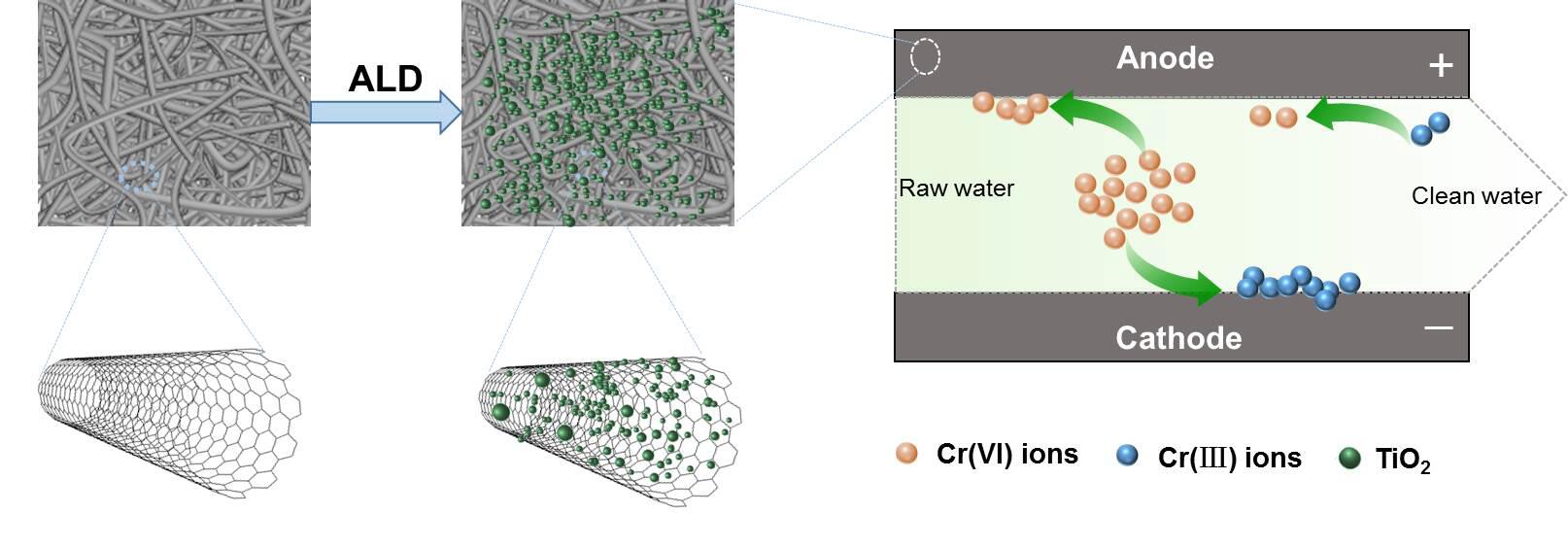
Preparation of Polysulfone-based Block Copolymer Ultrafiltration Membranes by Selective Swelling and Sacrificing Nanofillers
Shanshan Zhang, Jiemei Zhou, Zhaogen Wang, Jianzhong Xia*, Yong Wang*, Front. Chem. Sci. Eng. 2022, 16, 745-754
Selective swelling of block copolymers of polysulfone-b-poly(ethylene glycol) is an emerging strategy to prepare new types of polysulfone ultrafiltration membranes. Herein, we prepared nanoporous polysulfone-b-poly(ethylene glycol) ultrafiltration membranes by selective swelling and further promoted their porosity and ultrafiltration performances by using CaCO3nanoparticles as the sacrificial nanofillers. Different contents of CaCO3 nanoparticles were doped into the solution of polysulfone-b-poly(ethylene glycol), and thus obtained suspensions were used to prepare both self-supported and bi-layered composite structures. Selective swelling was performed on the obtained block copolymer structures in the solvent pair of ethanol/acetone, producing nanoporous membranes with poly(ethylene glycol) lined along pore walls. The CaCO3 nanoparticles dispersed in polysulfone-b-poly(ethylene glycol) were subsequently etched away by hydrochloric acid and the spaces initially occupied by CaCO3 provided extra pores to the block copolymer layers. The porosity of the membranes was increased with increasing CaCO3 content up to 41%, but further increase in the CaCO3 content led to partial collapse of the membrane. The sacrificial CaCO3 particles provided extra pores and enhanced the connectivity between adjacent pores. Consequently, the membranes prepared under optimized conditions exhibited up to 80% increase in water permeance with slight decrease in rejection compared to neat membranes without the use of sacrificial CaCO3 particles.

2021
Structure and Dynamics of Water in TiO2 Nano Slits: The Influence of Interfacial Interactions and Pore Sizes
Mingjie Wei*, Yong Wang, Chinese J. Chem. Eng. 2021, 31, 67-74
The interaction of water with TiO2 surfaces is of enduring interest because of wide applications of the TiO2 materials in aqueous environments. The structure and dynamic properties of water molecules in TiO2 nanopores are crucial as increasingly TiO2 materials are synthesized into nanoporous structures. In this work, the structural and dynamic properties of water molecules in nanoscale slit pores of TiO2 are investigated, by using three sets of force field models for the water- TiO2 interaction, as well as four TiO2 slit pore widths. It is concluded that the water- TiO2 interaction dominates the interfacial structure of water molecules, while the dynamic properties of water molecules are primarily influenced by the slit width in both interfacial and central regions. These findings indicate that both of the fluid properties and the interactions of fluids with pore wall will determine the transport properties of fluid in nanopores. If the pore size is large enough, e. g. 1.0 nm or larger in this work, the transport properties will be determined most by the fluids themselves. For the cases of pores whose sizes are in the range of interfacial region, the influences of pore size and interfacial interaction will interfere each other.

Absolute and Fast Removal of Viruses and Bacteria from Water by Spraying-Assembled Carbon-Nanotube Membranes
Dongwei Ma, Hengyi Li, Zixun Meng, Chenxu Zhang, Jiemei Zhou, Jianzhong Xia, Yong Wang*, Environ. Sci. Technol. 2021, 55, 15206-15214
Membrane separation is able to efficiently remove pathogens like bacteria and viruses from water based on size exclusion. However, absolute and fast removal of pathogens requires highly permeable but selective membranes. Herein, we report the preparation of such advanced membranes using carbon nanotubes (CNTs) as one-dimensional building blocks. We first disperse CNTs with the help of an amphiphilic block copolymer, poly(2-dimethylaminoethyl methacrylate)-block-polystyrene (PDMAEMA-b-PS, abbreviated as BCP). The PS blocks adsorb on the surface of CNTs via the π–π interaction, while the PDMAEMA blocks are solvated, thus forming homogeneous and stable CNT dispersions. We then spray the CNT dispersions on porous substrates, producing composite membranes with assembled CNT layers as the selective layers. We demonstrate that the optimized membrane shows 100% rejection to phage viruses and bacteria (Escherichia coli) while giving a water permeance up to ∼3300 L m-2 h-1 bar-1. The performance of the resultant BCP/CNT membrane outperforms that of state-of-the-art membranes and commercial membranes. The BCP/CNT membrane can be used for multiple runs and regenerated by water rinsing. Membrane modules assembled from large-area membrane sheets sustain the capability of absolute and fast removal of viruses and bacteria.

Flexible and Robust Three-Dimensional Covalent Organic Framework Membranes for Precise Separations under Extreme Conditions
Xiansong Shi, Zhe Zhang, Siyu Fang, Jingtao Wang, Yatao Zhang, Yong Wang*, Nano Lett. 2021, 21, 8355-8362
Membranes based on covalent organic frameworks (COFs) have demonstrated huge potential to resolve the long-standing bottlenecks in separation fields due to their structural and functional attributes. Herein, a three-dimensional COF featuring interpenetrated apertures, 3D-OH-COF, is rationally synthesized on polyimide supports to generate flexible, robust membranes. The resultant 3D-OH-COF presents excellent crystallinity, prominent porosity, and exceptional solvent resistance, enabling the produced membrane a sharp and durable selectivity to small molecules in water and organic solvents. Impressively, the membrane also exhibits excellent flexibility and robustness as verified by the well-maintained performances after serious bending and solvent soaking under elevated temperatures. We further chemically convert 3D-OH-COF into the carboxyl-decorated 3D-COOH-COF by a postsynthetic strategy. The 3D-COOH-COF retains high crystallinity, and the converted membrane receives a remarkable capture ability for targeted multivalent ions over other competing ions. This study exploits a viable avenue to produce practical 3D COF membranes toward ultimate separations under extreme conditions.

Chemically Laminating Graphene Oxide Nanosheets with Phenolic Nanomeshes for Robust Membranes with Fast Desalination
Qianqian Lan, Chao Feng, Zicheng Wang, Le Li, Yong Wang*, Tianxi Liu*, Nano Lett. 2021, 21, 8236-8243
Graphene oxide (GO) is receiving tremendous attention in membrane separation; however, its desalination performances remain suboptimal because of excessive swelling and tortuous transport pathways. Herein, we chemically joint GO nanosheets and phenolic nanomeshes together to form laminated membranes comprising through-plane nanopores and stabilized nanochannels. GO and phenolic/polyether nanosheets are mixed to form stacked structures and then treated in H2SO4 to remove polyether to produce nanomeshes and to chemically joint GO with phenolic nanomeshes. Thus-synthesized laminated membranes possess enhanced interlayer interactions and narrowed interlayer spacings down to 6.4 Å. They exhibit water permeance up to 165.6 L/(m2 h bar) and Na2SO4 rejection of 97%, outperforming most GO-based membranes reported so far. Moreover, the membranes are exceptionally stable in water because the chemically jointed laminates suppress the swelling of GO. This work reports hybrid laminated structures of GO and phenolic nanomeshes, which are highly desired in desalination and other applications.
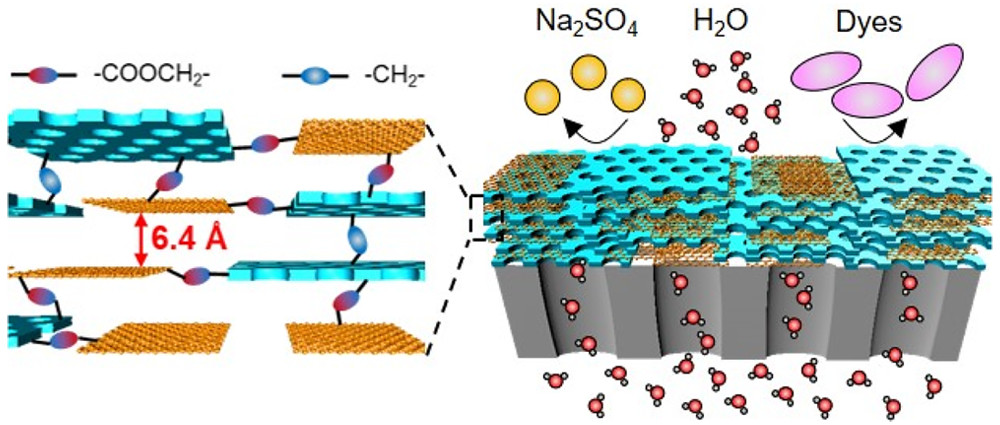
Block Copolymer Coated Carbon Nanotube Membrane Anodes for Enhanced and Multipurpose Hybrid Capacitive Deionization
Sen Xiong, Li Ren, Chenxu Zhang, Jiemei Zhou, Yong Wang*, Desalination 2021, 520, 115368
Carbon nanotube (CNT) membranes are widely used electrode materials in capacitive deionization (CDI) processes, while the limited electrosorption capacity and poor long-term stability need to improve. In this work, a pH-responsive block copolymer (BCP), poly (2-dimethylaminoethyl methacrylate)-block-polystyrene (PDMAEMA-b-PS) is combined with the selective swelling to fabricate a CNT membrane based multipurpose electrode. After BCP coating and selective swelling, the PDMAEMA blocks migrate onto the membrane surface and protonate during the CDI processes, which enhance the attraction between electrode and anions. Therefore, the BCP coated electrodes can be used as high performance anodes in the hybrid CDI (HCDI) module. Experiment results show that the initial solution pH values have significant influence on the CDI performance of the HCDI module. The maximum removal efficiencies of the HCDI module towards NaCl and NaH2PO4 are ~15 mg·g-1 and ~38.7 mg·g-1, respectively. Moreover, the chemical and mechanical stabilities of the anodes are significantly enhanced. No anode oxidation can be observed during CDI processes and the frequently occurred co-ion repulsion effect is suppressed. Considering these advantages, the combination of BCPs and selective swelling will be a promising candidate for the development of HCDI module.

Polyamide Membranes Enabled by Covalent Organic Framework Nanofibers for Efficient Reverse Osmosis
Guanghui Yang, Zhe Zhang*, Congcong Yin, Xiansong Shi, Yong Wang*, J. Polym. Sci. 2021, 1-10
Polyamide reverse osmosis membranes are indispensable for the worldwide clean water supply. Incorporation of nanomaterials into polyamide separation layer provides an evident methodology to enhance the water flux. However, the desalination performance would be compromised by the inadequate compatibility between the nanomaterial and the polyamide matrix. In this work, we propose a straightforward strategy to use covalent organic frameworks (COF) nanofibers as the efficient nanofiller for the fabrication of high flux polyamide membranes. The COF nanofibers featuring crystalline structures, large surface area and well-defined micropores are synthesized by a surfactant-mediated solvothermal method. It is found that the COF nanofibers are able to mediate the interfacial polymerization process via the controlled release of amine molecules. This creates the reduced thickness of the polyamide separation layer. Moreover, the rigid and permanent nanopores of COF could serve as additional channels for water permeation. Benefitting from the low thickness and the additional channels, thus fabricated membranes exhibit a significantly enhanced water flux, while maintaining a slightly improved NaCl rejection. Our work is expected to provide a new insight for the design and fabrication of advanced polyamide reverse osmosis membranes.

Phenolic Membranes with Tunable Sub-10-nm Pores for Nanofiltration and Tight-Ultrafiltration
Qianqian Lan, Chao Feng, Kaiqin Ou, Zicheng Wang, Yong Wang*, Tianxi Liu*, J. Membr. Sci. 2021, 640, 119858
Membranes with sub-10-nm pores are receiving growing interest in recognizing and separating nanocolloids, biomolecules, and soluble salts from water, but suffer from difficulty of optimizing pore structures and inferior stability. Herein, we report an efficient method for the preparation of robust nanoporous phenolic membranes with widely tunable pore sizes in the range of nanofiltration and tight-ultrafiltration. Solutions of resol precursors and poly(ethylene glycol)s (PEGs) are spin-coated to form thin films and then heated to thermopolymerize resols into phenolics. Subsequently, the films are treated in H2SO4 solution to degrade PEGs, producing nanoporous phenolic membranes. Thus-prepared phenolic membranes exhibit adjustable effective pore sizes and tunable separation performances from nanofiltration to tight-ultrafiltration, which is otherwise inaccessible. Due to the thin thicknesses and rich water channels, the membranes exhibit higher permeances than other tight-ultrafiltration membranes and commercial ultrafiltration membranes with similar rejections. Furthermore, thanks to the robust frameworks and good chemical resistance of phenolics, the membranes deliver stable performances in long-term operations, elevated pressures, and acidic conditions. This work provides a facile and universal strategy for the synthesis of membranes with sub-10-nm pores for nanofiltration and tight-ultrafiltration.
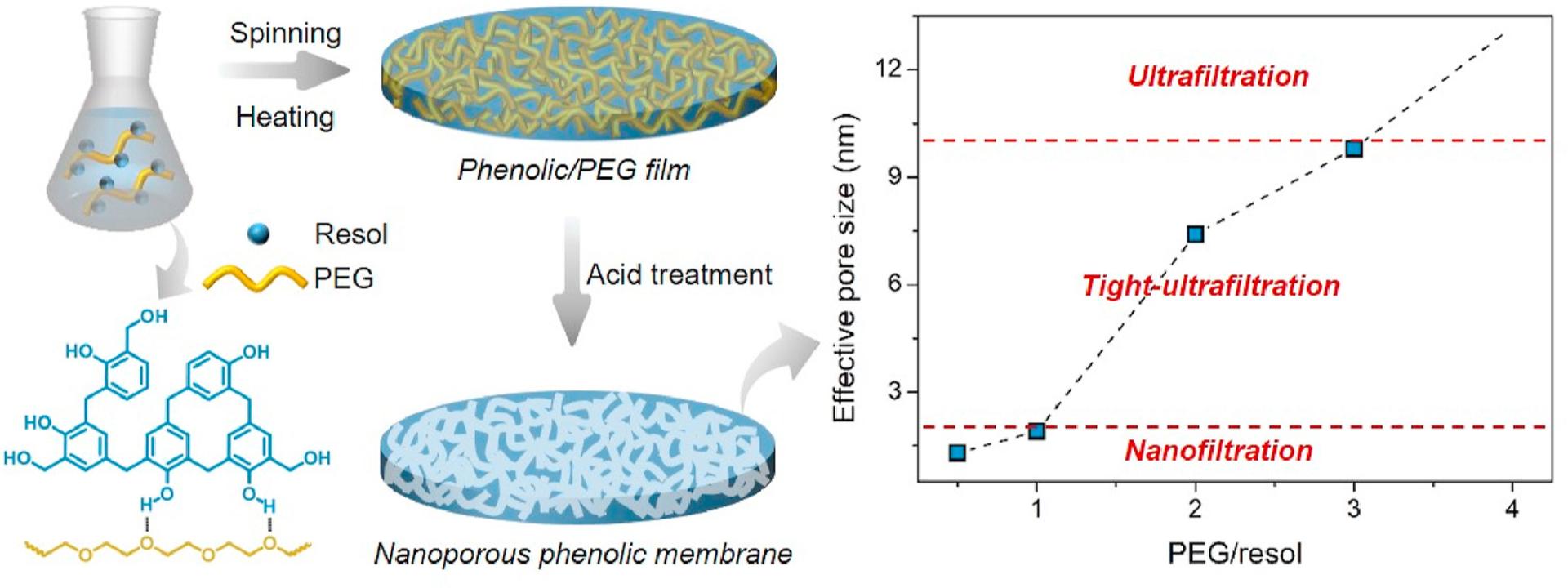
Virtual Special Issue: Polymeric Membranes for Advanced Separations
Yong Wang*, Macromolecules, 2021, 54, 7675−7677
Membrane technology has been playing an increasingly important role in addressing the global challenges related to water, the environment, and energy. The majority of membranes used in industry are produced by using polymers. Membranes hosting nano-sized or even angstrom-sized pathways, that are fixed or dynamic, regulate the transport of fine particulates, molecules, or ions based on the mechanism of size discrimination, electrostatic interactions, or sorption and diffusion. Advances in polymer science have helped to develop better membranes, and in turn the ever-increasing demands for highly efficacious membrane separations drive further progress in fundamental polymer science. That is, polymer science is essential to the development of polymeric membranes with high performance. Macromolecules has long been an important platform for publishing highly relevant and impactful studies regarding polymeric membranes. This Virtual Issue highlights some membrane studies recently published in Macromolecules, mainly focusing on membranes for ultrafiltration (UF), gas separations, and fuel cell separators.
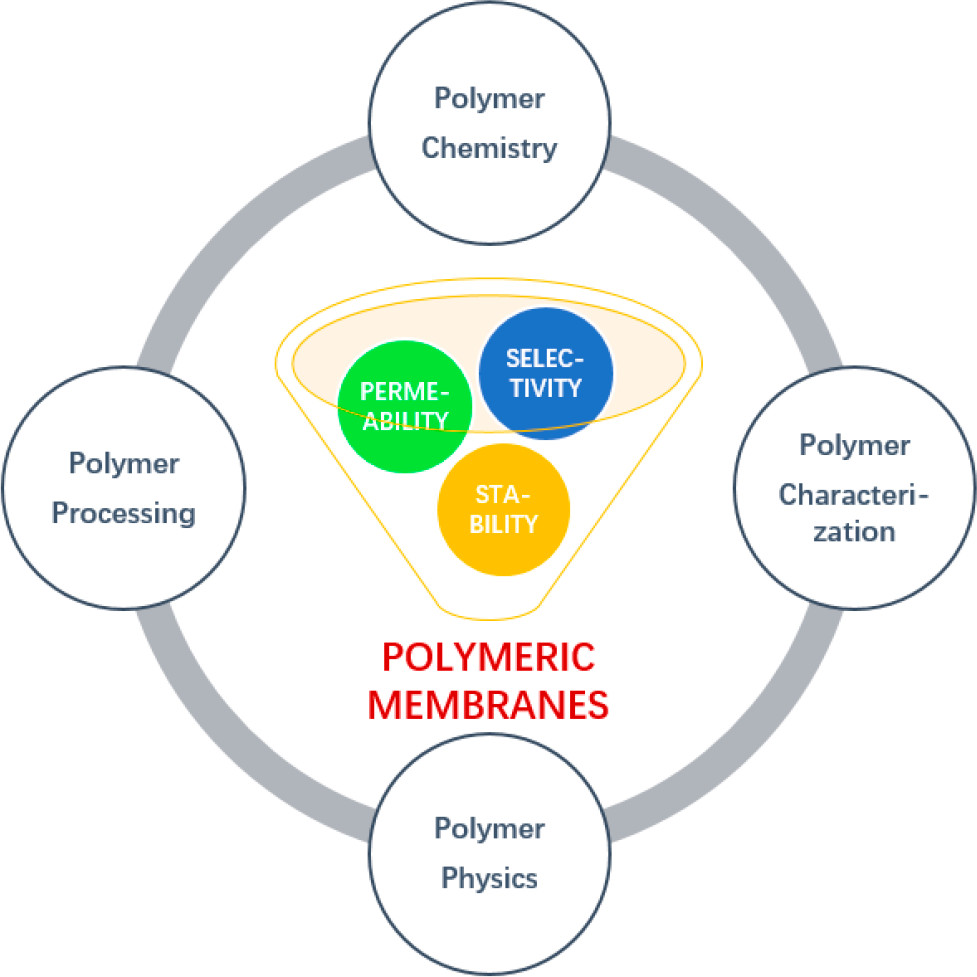
Large-Pore Covalent Organic Frameworks for Ultra-fast Tight Ultrafiltration (TUF)
Siyu Fang, Xiansong Shi*, Xingyuan Wang, Zhe Zhang, Congcong Yin, Zhipeng Zhang, Tong Ju, Sen Xiong*, Yong Wang*, J. Membr. Sci. 2021, 637, 119635
Tight ultrafiltration (TUF) membranes featuring specific pore sizes are increasingly developed to bridge the gap between nanofiltration and ultrafiltration. So far, a wealth of efforts has been devoted to tackle the limitation found in TUF, but there still lacks a facile accessibility to upgrade TUF membranes with simultaneously improved permeance and selectivity. Herein, we report a large-pore covalent organic framework (LP-COF) as the building material to prepare ultra-permeable TUF membranes for fast separations. The LP-COF layers with an exceptionally large aperture size of up to ∼3.6 nm are synthesized on macroporous substrates through a unidirectional diffusion method. The resultant LP-COF layers show a moderate crystallinity and low thickness down to ∼60 nm, and allowing ultrafast water permeation. Surprisingly, the optimal LP-COF membrane exhibits an unprecedented water permeance of ∼3147 L m-2 h-1 MPa-1 with a high Congo red rejection (∼92.6%), which is basically unchanged after several cycles of filtration. Moreover, the large-pore channels enable an unimpeded pass of ions, thus affording the membrane an excellent dye/salt separation competence, and largely exceeding state-of-the-art membranes. Therefore, this work opens up a new opportunity in producing high-performance TUF membranes by large-pore COFs for rapid and precise separations.

Coupling Covalent Organic Frameworks and Carbon Nanotube Membranes to Design Easily Reusable Photocatalysts for Dye Degradation
Hongbo Xue, Zhijie Bi, Jiayu Cheng, Sen Xiong*, Yong Wang*, Ind. Eng. Chem. Res. 2021, 60, 8687-8695
Covalent organic frameworks (COFs) have been used as photocatalysts, but recovering COF particulates from aquatic environments is tedious and labor-consuming. In order to maximize the photocatalytic performance and simplify the degradation processes, carbon nanotube (CNT) membranes with excellent electron transfer capacity and photothermal effects are used as substrates to fabricate COF/CNT membranes. The uniform COF layer enhances the mechanical property and hydrophilicity of the CNT membranes. Meanwhile, by utilizing the large surface area and photothermal effect of the CNT membranes, the photocatalytic activity of COF-based composite membranes can be improved to match that of pure COF particulates. Due to the positive interaction between COFs and CNT membranes, the composite membranes exhibit superior degradation capacity toward mordant black17 (MB17) with strong handleability. The total degradation capacity of COF/CNT membranes can reach 708.2 mg/g, and the composite membranes can be reused seven times with only 10.6% efficiency loss in degradation capacity.
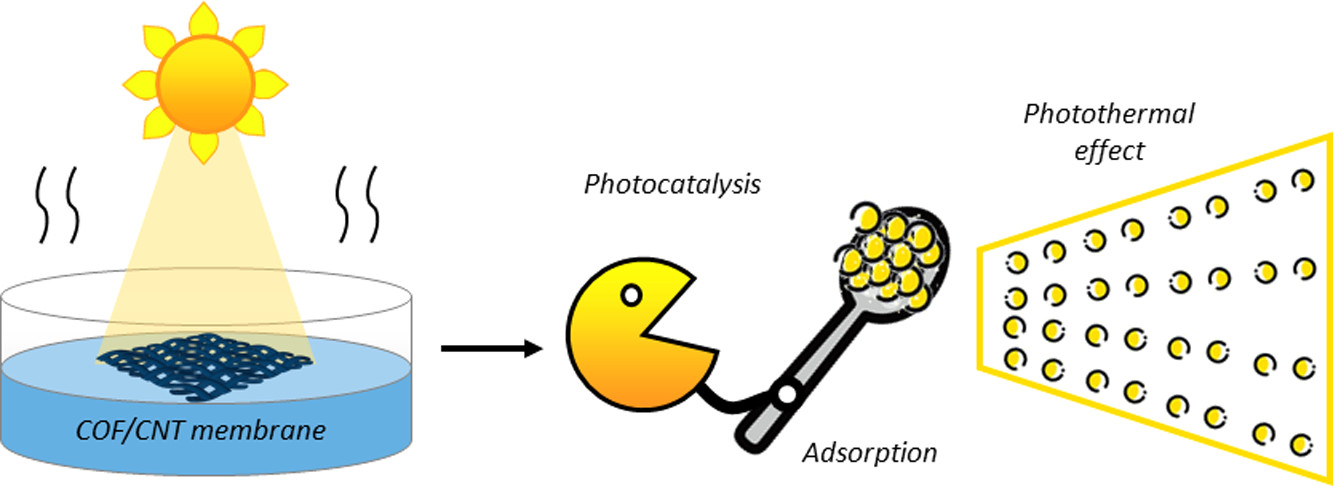
Mechanism of Permeance Enhancement in Mixed-Matrix Reverse Osmosis Membranes Incorporated with Graphene and Its Oxides
Guxu Wang, Xin Zhang, Mingjie Wei*, Yong Wang, Sep. Purif. Technol. 2021, 270, 118818
Fabricating mixed-matrix reverse osmosis (RO) membranes via incorporating nanocomposites is a promising strategy to enhance permeance performance without sacrificing the ion rejection. To better design such mixed-matrix membranes (MMMs), the transport mechanism of water molecules through them is urgently desired. Compared to the stiff inorganic nanoparticles, the flexible graphene (Gr) and its oxides (GO) attract much attention due to their better compatibility with aromatic polyamide (PA) matrix. In this work, nonequilibrium molecular dynamics simulations of water passing through highly cross-linked PA membranes, Gr/PA and GO/PA MMMs are performed to reveal the transport mechanism. The simulation results show that the MMMs exhibit higher permeance compared to the pure PA membranes. After analyzing the transport details of water molecules, we discovered that the permeance enhancement for two types of MMMs result from distinct factors. While the Gr/PA MMMs have lower interior transport resistance because of the hydrophobic nature of Gr, the permeance enhancement of GO/PA MMMs should be attributed to the higher solubility of water molecules into MMMs. Therefore, a proper hydrophilicity of RO membrane, which has lower interior transport resistance while having higher solubility, is expected for the optimized performance.

Hollow-Fiber Membranes of Block Copolymers by Melt Spinning and Selective Swelling
Dinglei Zhong, Jiemei Zhou, Yong Wang*, J. Membr. Sci. 2021, 632, 119374
Selective swelling of block copolymers has emerged as an efficient strategy to prepare ultrafiltration membranes with well-defined porosities. However, the application of this strategy is only limited to the preparation of flat-sheet membranes so far. Herein, we extend this selective swelling strategy, for the first time, to the preparation of hollow-fiber membranes (HFMs). A mechanically strong copolymer available at large scale, polysulfone-block-poly(ethylene glycol) (PSF-b-PEG), is employed as the membrane-forming polymer. The PSF-b-PEG melt without any diluters or additives exhibits good fluidity, enabling stable and continuous melt spinning of primary hollow fibers with dense fiber walls. Subsequent selective swelling in the mixture of n-propyl alcohol and acetone produces interconnected nanoporosities throughout the fiber walls, thus forming HFMs with PEG chains enriched on the membrane surface. The wall thicknesses as well as pore sizes, and thus the separation performances of the HFMs are tunable by changing the spinning and swelling parameters. In contrast to the strong hydrophobicity of HFMs prepared by cold stretching of polyolfins, our HFMs possess water-wettable surfaces due to the presence of PEG chains, and can be directly used in aqueous milieu. Because of the PSF-based skeleton and homogenous distribution of nanopores, the HFMs exhibit excellent tensile strengths up to 12.5 MPa, much higher than that of HFMs prepared by the commonly used phase inversion processes. Furthermore, the BSA rejection and water permeance of the HFMs currently can be tuned in the range of 29.9–88.2% and 13.7–119.3 L m-2·h-1·bar-1, respectively, by changing the spinning and/or swelling parameters. Their performances are expected to enhance by optimizing the hollow fiber geometries and pore structures. This strategy neither uses any solvents to fluidize the polymer nor produces wastewater, and therefore is a “cleaner” process. This work not only extends the usages of selective swelling, but also establishes a new process to manufacture HFMs.

Porous Block Copolymer Separation Membranes for 21st Century Sanitation and Hygiene
Leiming Guo*, Yong Wang*, Martin Steinhart*, Chem. Soc. Rev. 2021, 50, 6333-6348
Removing hazardous particulate and macromolecular contaminants as well as viruses with sizes from a few nm up to the 100 nm-range from water and air is crucial for ensuring sufficient sanitation and hygiene for a growing world population. To this end, high-performance separation membranes are needed that combine high permeance, high selectivity and sufficient mechanical stability under operating conditions. However, design features of separation membranes enhancing permeance reduce selectivity and vice versa. Membrane configurations combining high permeance and high selectivity suffer in turn from a lack of mechanical robustness. These problems may be tackled by using block copolymers (BCPs) as a material platform for the design of separation membranes. BCPs are macromolecules that consist of two or more chemically distinct block segments, which undergo microphase separation yielding a wealth of ordered nanoscopic domain structures. Various methods allow the transformation of these nanoscopic domain structures into customized nanopore systems with pore sizes in the sub-100 nm range and with narrow pore size distributions. This tutorial review summarizes design strategies for nanoporous state-of-the-art BCP separation membranes, their preparation, their device integration and their use for water purification.
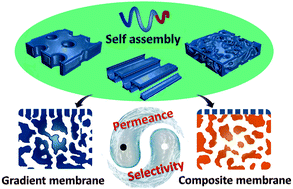
Zwitterionization of Tertiary Amines in Nanoporous Block Copolymers: toward Fouling-Resistant Ultrafiltration Membranes
Chenxu Zhang, Jiemei Zhou*, Xiangyue Ye, Zhuo Li, Yong Wang*, Macromolecules 2021, 54, 4236-4245
Zwitterionization has emerged as a highly efficient strategy to diminish protein adsorption on separation membranes, and there is a strong need to develop new zwitterionic polymers for the preparation of nonfouling membranes. Herein, by the in situ formation of newly discovered trimethylamine N-oxide-derived zwitterionic polymers (PTMAO) on the surface of nanoporous block copolymers, we obtain ultrafiltration membranes exhibiting superior fouling resistance. Nanoporous membranes of (2-dimethylaminoethyl methacrylate)-block-polystyrene (PDMAEMA-b-PS) are prepared by selective swelling-induced pore generation, which are subsequently soaked in H2O2 to oxidize the tertiary amine groups of PDMAEMA to form zwitterionic trimethylamine N-oxides. This oxidation takes place fast, and >70% conversion is achieved within 30 min. The thus-zwitterionized membranes exhibit strongly enhanced hydrophilicity and flexibly tunable permselectivity. Importantly, the membranes showed ultralow protein adsorption and exceptional fouling resistance, outperforming other membranes. This work demonstrates the high efficiency of PTMAO zwitterionization in mitigating membrane fouling and provides a new approach to prepare fouling-resistant membranes.

Nanomeshes with Sub-10 nm Pores by Glycerol-Triggered 2D Assembly in Liquid Phases for Fast and Selective Membranes
Qianqian Lan, Zhipeng Zhang, Fang Xu, Mingjie Wei, Yong Wang*, Nano Lett. 2021, 21, 3302–3309
Nanomeshes having ultrathin thicknesses and penetrating nanopores promise fast diffusion and precise selectivity and are highly desired in diffusion-involved processes such as separation. Herein, we report a liquid-phase two-dimensional (2D) assembly strategy to synthesize phenolic and carbonaceous nanomeshes with sub-10 nm pores and thicknesses. The synthesis is enabled simply by introducing glycerol in the thermopolymerization of resol/polyether micelles dispersed in ethanol. Experimental and simulation results reveal that glycerol’s strong ability to form hydrogen bonds constrain the motion of the micelles, directing them to pack and merge exclusively in the lateral direction. Upon removal of polyether, we obtain phenolic nanomeshes with lateral sizes up to hundreds of micrometers, which can be further converted to carbonaceous nanomeshes. As a proof of concept, we use stacked phenolic and carbonaceous nanomeshes as separation membranes. They show superior permselectivity to nanosized solutes with permeance ∼2–110 times higher than that of other membranes.

Design of Block‐Copolymer Nanoporous Membranes for Robust and Safer Lithium‐Ion Battery Separators
Hao Yang, Xiansong Shi, Shiyong Chu, Zongping Shao, Yong Wang*, Adv. Sci. 2021, 2003096
Lithium‐ion batteries (LIBs) suffer from unsatisfied performance and safety risks mainly because of the separators. Herein, a block copolymer (BCP) composed of robust and electrolyte‐affinitive polysulfone (PSF) and Li+‐affinitive polyethylene glycol (PEG) is rationally designed to prepare a new type of LIB separator. The copolymer is subjected to selective swelling, producing nanoporous membranes with PEG chains enriched along the pore walls. Intriguingly, when used as LIB separators, thus‐produced BCP membranes efficiently integrate the merits of both PSF and PEG chains, endowing the separators thermal resistance as high as 150 °C and excellent wettability. Importantly, the nanoporous separator is able to close the pores with a temperature of 125 °C, offering the battery a thermal shutdown function. The membrane exhibits ultrahigh electrolyte uptake up to 501% and a prominent ionic conductivity of 10.1 mS cm−1 at room temperature. Batteries assembled with these membranes show excellent discharge capacity and c‐rate performance, outperforming batteries assembled from other separators including the extensively used Celgard 2400. This study demonstrates a facile strategy, selective swelling of block copolymer, to engineer high‐performance and safer LIB separators, which is also applicable to produce advanced copolymer‐based separators for other types of batteries.
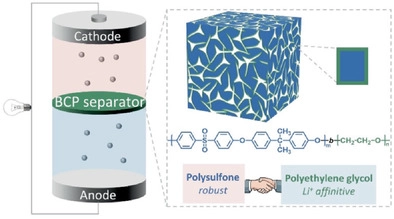
Fast Evaporation Enabled Ultrathin Polymer Coatings on Nanoporous Substrates for Highly Permeable Membranes
Xiansong Shi, Lei Wang, Nina Yan, Zhaogen Wang, Leiming Guo, Martin Steinhart*, Yong Wang*, The Innovation 2021, 2, 100088
Thin polymer coatings covering on porous substrates are a common composite structure required in numerous applications including membrane separation, and there is a strong need to push the coating thicknesses down to the nanometer scale to maximize the performances. However, producing such ultrathin polymer coatings in a facile and efficient way remains a big challenge. Here, uniform ultrathin polymer covering films (UPCFs) are realized by a facile and general approach based on rapid solvent evaporation. By fast evaporating dilute polymer solutions spread on the surface of porous substrates, we obtain ultrathin coatings (down to ∼30 nm) exclusively on the top surface of porous substrates, forming UPCFs with a block copolymer of polystyrene-block-poly(2-vinyl pyridine) at room temperature or a homopolymer of poly(vinyl alcohol) (PVA) at elevated temperatures. Upon selective swelling of the block copolymer and crosslinking of PVA, we obtain highly permeable membranes delivering ∼2-10 times higher permeance in ultrafiltration and pervaporation than state-of-the-art membranes with comparable selectivities. This work invents a very convenient but highly efficient process for the direct preparation of defective-free ultrathin coatings on porous substrates, which is extremely desired in different fields in addition to membrane separation.
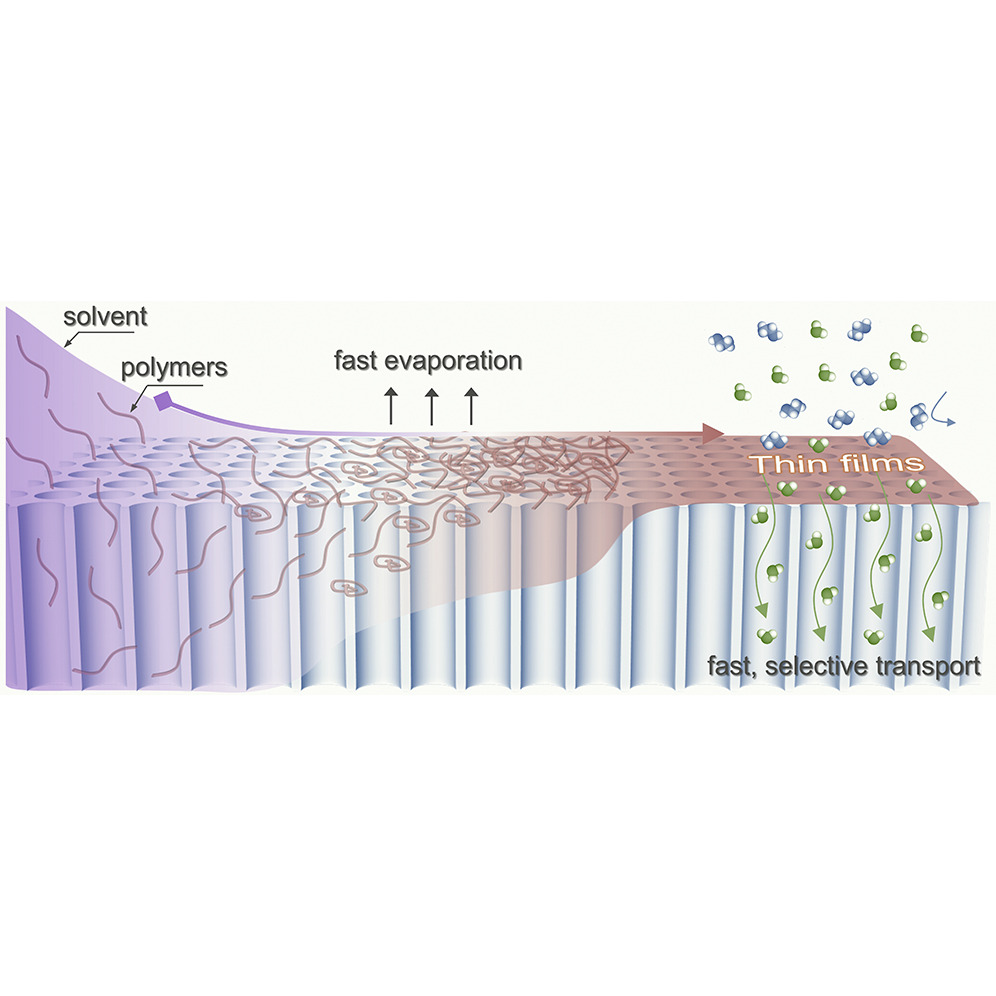
Secondary Growth of Bi-layered Covalent Organic Framework Nanofilms with Offset Channels for Desalination
Ankang Xiao, Xiansong Shi*, Zhe Zhang, Congcong Yin, Sen Xiong, Yong Wang*, J. Membr. Sci. 2021, 624, 119122
Processing two-dimensional (2D) covalent organic frameworks (COFs) into nanofilms has gained widespread attention in water treatment. However, the designed synthesis of COF-based membranes for ion separations still remains a huge challenge though the strategies to produce COF molecular separation membranes have been greatly developed. Herein, we report the construction of bi-layered COF nanofilms for efficient desalination through a simple yet effective secondary growth. The suggested strategy is capable of easily regulating the growth of another COF layer on the pre-synthesized first layer, thus producing crystalline and defect-free bi-layered COF nanofilms with distinct laminated structures. Most importantly, the offset channels are involved at the interface of two nanofilms obtained from the first and secondary growth, which leads to a constricted effective aperture that significantly enhances the ion separation performance. Specifically, the bi-layered COF nanofilms composited with macroporous supports exhibit high rejection rates (∼95.8%) to Na2SO4, observably surpassing the desalination performance of single-layered COF nanofilms (rejection<10%). This work not only develops an ingenious way to fabricate COF-on-COF nanofilms with narrowed channels by tailoring the laminated structure of 2D COFs at the film interface, but also starts an avenue for the adoption of COF platforms for membrane separations with an improved precision.
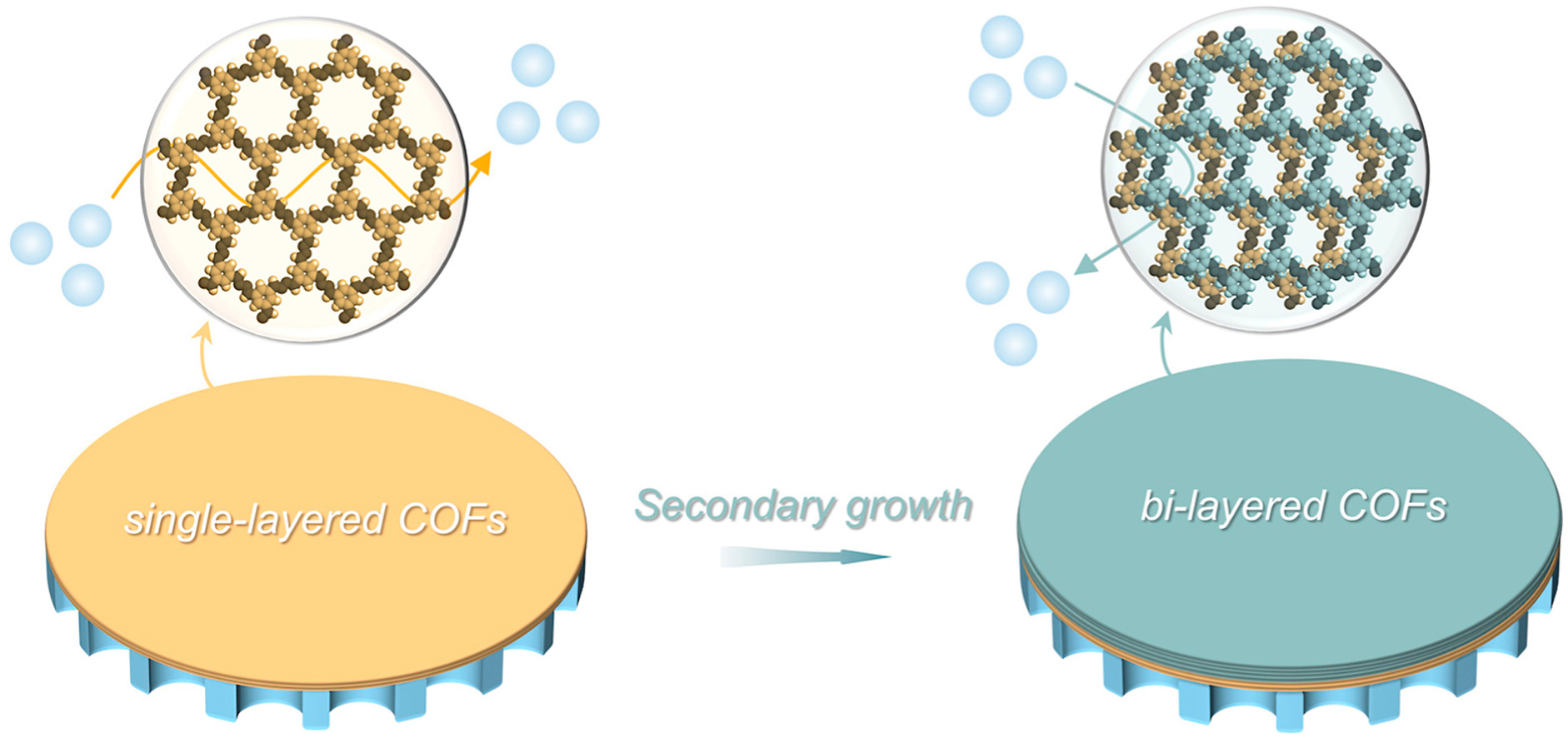
A Facile Process to Prepare Fouling-resistant Ultrafiltration Membranes: Spray Coating of Water-containing Block Copolymer Solutions on Macroporous Substrates
Dongwei Ma, Xiangyue Ye, Zhuo Li, Jiemei Zhou*, Dinglei Zhong, Chenxu Zhang, Sen Xiong, Jianzhong Xia*, Yong Wang*, Sep. Purif. Technol. 2021, 259, 118100
Ultrafiltration membranes derived from block copolymers (BCPs) are gaining much attention for their superiority in tunable pore structures and intrinsic surface functions. In terms of the practical applications of BCP membranes, simple and efficient manufacturing processes are essential and remain highly demanded. Herein, we propose a facile process to prepare BCP composite membranes by spray-coating polysulfone/poly(ethylene glycol) (PSF-b-PEG) solutions onto macroporous substrates. A small amount of nonsolvent (water) is added into the BCP solutions to act as the pore-forming agent. During spray coating, the evaporation of solvent and the rising water content lead to phase separation of BCP solutions in the atomized droplets. Subsequent drying removes water, and the volumes occupied by water are transformed into nanoscale pores, thus producing bi-layered composite membranes with the nanoporous BCP coatings as the selective layers atop the macroporous substrates. Water-affinitive PEG chains in PSF-b-PEG are crucial to adsorb and stabilize water droplets during pore formation. The thickness of the BCP selective layers is predominantly determined by the dosage of the sprayed BCP solutions, enabling tunable separation properties of the BCP membranes. In spite of the extremely simple preparation process, thus produced membranes exhibit good ultrafiltration performances, comparable or better than that of membranes prepared by much more complicated processes. Furthermore, PEG chains are enriched on pore walls, endowing the membranes an intrinsic fouling resistance.
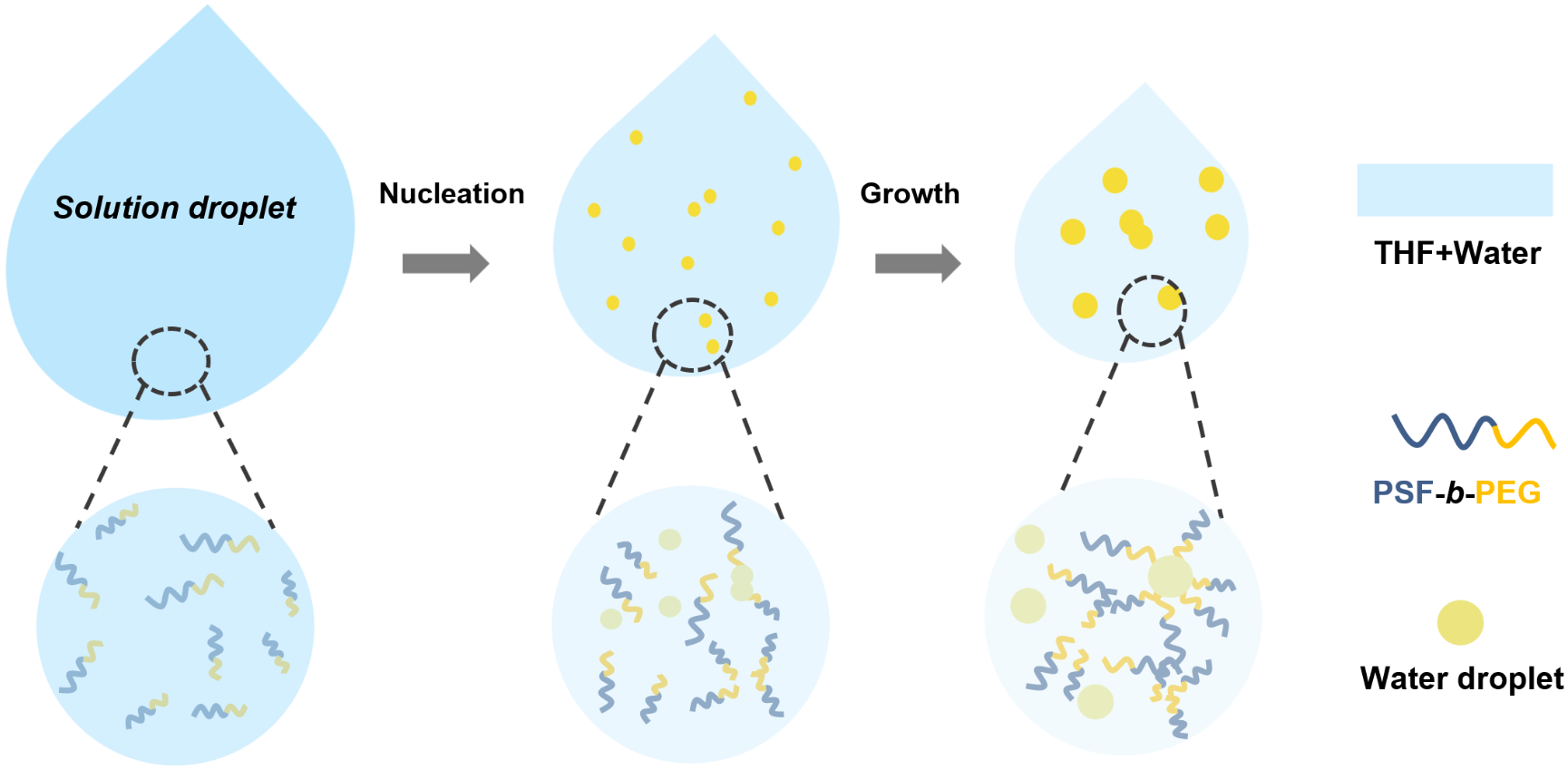
Effect of Hydrophilicity on Ion Rejection of Sub-nanometer Pores
Fang Xu, Mingjie Wei*, Yong Wang*, Sep. Purif. Technol. 2021, 257, 117937
Ion rejection by (sub)nanometer-sized pores enables membrane-based desalination. Narrowing the pore size is long considered as the primary choice to increase the ion rejection rate, which is unfortunately at much sacrifice of the water permeance. Using the uniform sub-nanometer pore channels in covalent organic frameworks (COFs) as the model system, we herein demonstrate that hydrophilicity of pore walls plays a significant role in determining ion rejections, and ion rejections can be significantly improved by enhancing hydrophilicity with less loss in water permeance. Via non-equilibrium molecular dynamics simulation, the augmented in-pore effect caused by significant pore-wall-involved hydration effect is discovered to dominate the ion rejections. Furthermore, the desalination mechanism of hydrophilic nanopores is proposed: strong hydrophilicity can make cations enter nanopores more easily than anions by compensation of ionic hydrations, but all ions are not able to transport inside nanopores due to the extreme in-pore effect; hence membranes consequently carry positive net charges after being saturated adsorption by ions and then in turn exclude cations by electrostatic repulsions. These findings and understandings on desalination mechanisms can also be applicable to other kinds of nanoporous materials and thus could provide guidelines for the experimental design of next-generation desalination membranes.

Spray Coating of Polysulfone/Poly(ethylene glycol) Block Polymer on Macroporous Substrates Followed by Selective Swelling for Composite Ultrafiltration Membranes
Dongwei Ma, Zhaogen Wang, Tao Liu, Yunxia Hu, Yong Wang*, Chinese J. Chem. Eng. 2021, 29, 85-91
Polysulfone (PSF) is extensively used for the production of ultrafiltration (UF) membranes thanks to its high strength, chemical stability, and good processibility. However, PSF is intrinsically hydrophobic, and hydrophilic modification is always required to PSF-based membranes if they are intended to be used in aqueous systems. Facile strategies to prepare hydrophilic PSF membranes are thus highly demanded. Herein we spray coat a PSF-based amphiphilic block polymer onto macroporous substrates followed by selective swelling to prepare flat-sheet PSF UF membranes. The polymer is a triblock polymer containing PSF as the majority middle block tethered with shorter block of polyethylene glycol (PEG) on both ends, that is, PEG-b-PSF-b-PEG. We use the technique of spray coating to homogeneously dispense diluted triblock polymer solutions on the top of macroporous supports, instantly resulting in uniform, defect-free polymer coating layers with the thickness down to ~ 1.2 μm. The bi-layered composite structures are then immerged in ethanol/acetone mixture to generate mesoscale pores in the coating layers following the mechanism of selective swelling-induced pore generation, thus producing composite membranes with the mesoporous triblock polymer coating as the selective layers. This facile strategy is free from additional hydrophilic modification and much smaller dosages of polymers are used compared to conventional casting methods. The pore sizes, porosities, hydrophilicity, and consequently the separation properties of the membranes can be flexibly tuned by changing the swelling duration and the composition of the swelling bath. This strategy combining spray coating and selective swelling is upscalable for the production of high-performance PSF UF membranes.
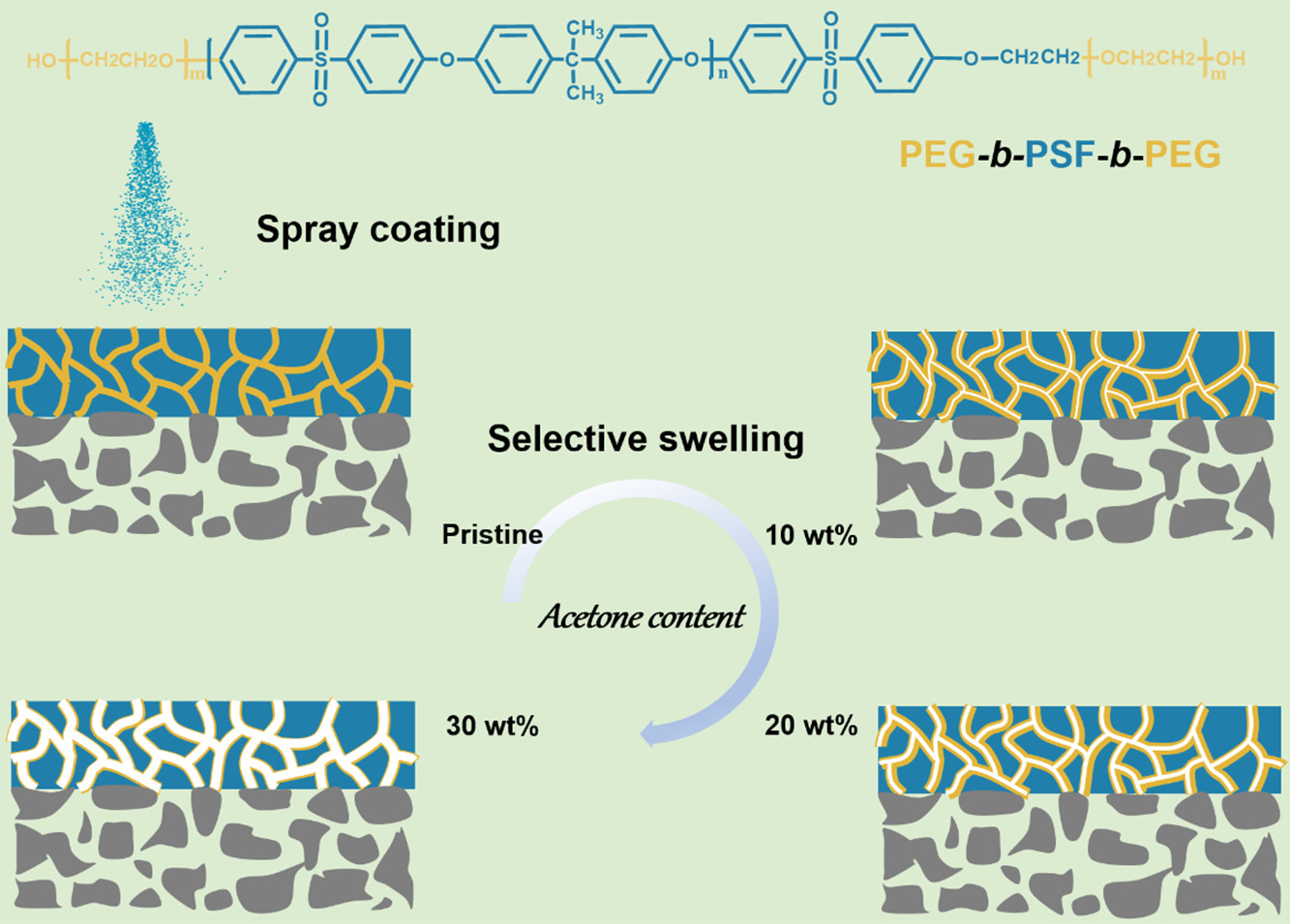
Stitching Nanosheets of Covalent Organic Frameworks to Build Aligned Nanopores in Nanofiltration Membranes for Precise Ion Separations
Zhe Zhang, Congcong Yin, Guanghui Yang, Ankang Xiao, Xiansong Shi, Weihong Xing, Yong Wang*, J. Membr. Sci. 2021, 618, 118754
Embedding nanofillers into polyamide (PA) matrices is considered as a simple yet effective strategy for boosting the performances of thin-film nanocomposite (TFN) nanofiltration (NF) membranes. However, the NF performances are usually compromised by the inadequate interface compatibility between nanofillers and PA matrices as well as the anisotropic orientation of nanofillers. Herein, we propose a distinctive fabrication strategy for TFN membranes featuring excellent compatibility and highly-aligned microstructures. The reactive covalent organic framework (COF) nanosheets are chemically stitched at oil-water interfaces to form continuous nanofilms, and the PA matrices are then in-situ formed to encapsulate them, giving the TFN membranes. The stitched nanofilms contain two types of perpendicularly oriented pores: intrinsic apertures in COF nanosheets, and gaps among adjacent nanosheets. Together with the abundant reactive sites, the stitched nanofilms not only mediate the controllable synthesis of PA matrices, but also are covalently fused into the matrices. The aligned pores of the stitched nanosheets are capable of sieving salt ions, endowing TFN membranes with high separation precision and fast water permeation. This work demonstrates a strategy to control the orientation of COF nanosheets, which is highly desired in diverse fields not limited to membrane separation.
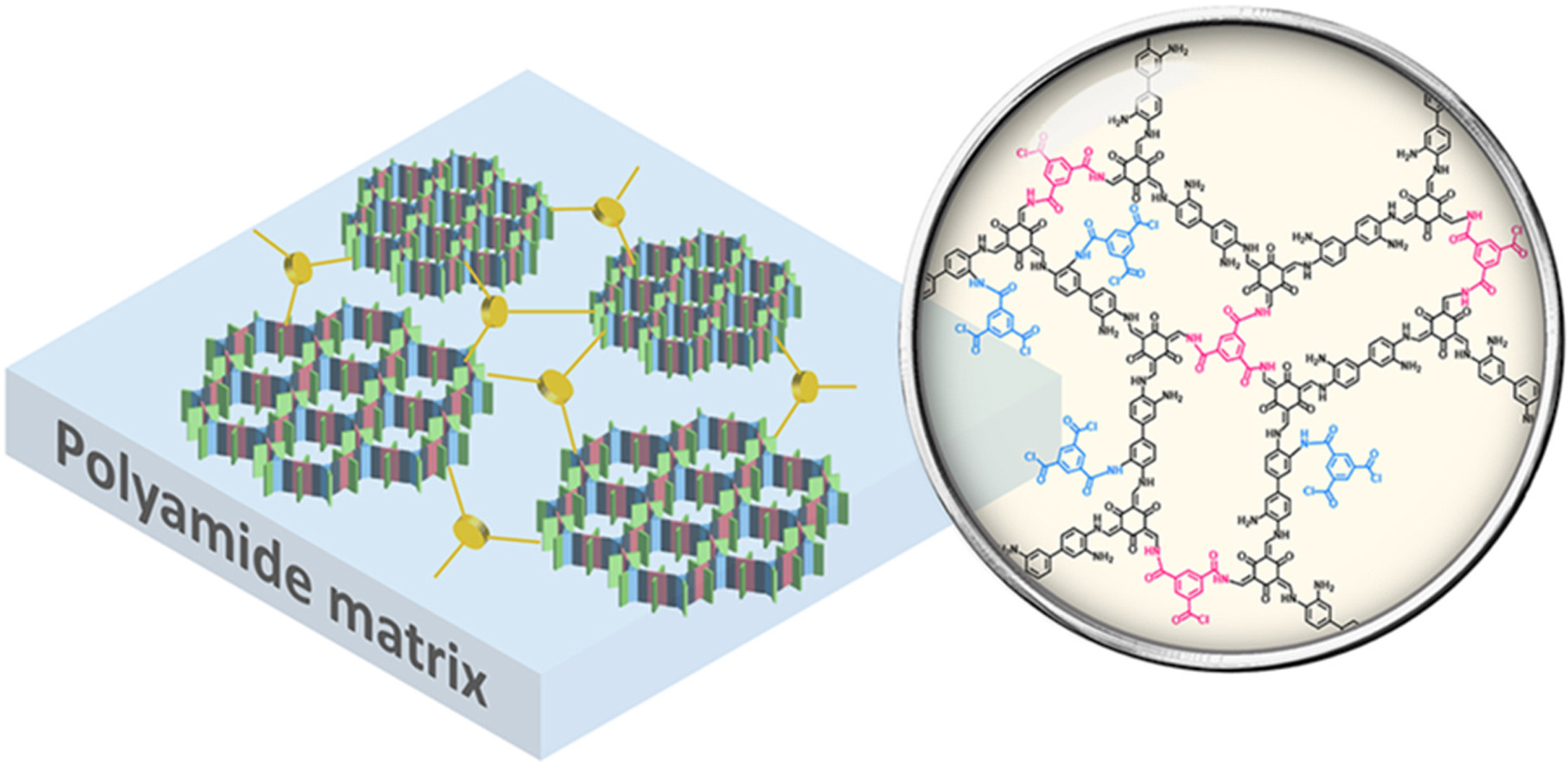
Pressure-modulated Synthesis of Self-repairing Covalent Organic Frameworks (COFs) for High-flux Nanofiltration
Congcong Yin, Siyu Fang, Xiansong Shi, Zhe Zhang, Yong Wang*, J. Membr. Sci. 2021, 618, 118727
Covalent organic frameworks (COFs), with their inherent merits of specific pore size and uniform channels, have been extensively employed to produce nanofiltration (NF) membranes. However, COF-based NF towards precise separations, especially for ion separations, are often unsatisfying due to the intercrystalline defects in selective layers. Herein, a pressure-modulated synthesis method has been explored to prepare crystalline and defect-free COF membranes on seeded substrates for fast NF. Amine and aldehyde solutions are separately placed with a level interval to create vertical hydraulic pressure, which can regulate the mobility of the amine monomers and thus results in the self-repairing of defects in the COF planes and remediation of intercrystalline gaps. The abundant nucleation sites on seeded substrates promote the confined growth of COF crystallites in top layers, leading to an ultrathin selective layer with improved permeance. The resultant COF membrane shows tight methyl orange (~90.4%) and Na2SO4 (~63.6%) rejections with a pronounced water permeance of up to ~44.2 L m-2 h-1 bar-1, which is ~2-10 times higher than other NF membranes with similar rejections. This pressure-modulated synthetic strategy establishes not only the self-repairing synthesis of COFs but also the controllable preparation of defect-free COF-based NF membranes, thus enabling precise and fast separation of molecules and ions.

Additive-free Preparation of Hemodialysis Membranes from Block Copolymers of Polysulfone and Polyethylene Glycol
Dinglei Zhong, Zhaogen Wang, Jiemei Zhou, Yong Wang*, J. Membr. Sci. 2021, 618, 118690
Hemodialysis membranes have been widely used for the treatment of chronic kidney disease. However, as common hemodialysis membranes, polysulfone based membranes are suffering from complicated modification to improve hemocompatibility and safety issues of additive leaching-out. Facing these challenges, here hemodialysis membranes with excellent hemocompatibility and biocompatibility were fabricated by nonsolvent induced phase separation (NIPS) of a block copolymer, polysulfone-block-poly(ethylene glycol) (PSF-b-PEG), without using any additives. During NIPS, mesopores were formed throughout the membrane and the PEG chains were preferentially enriched on surfaces, thus improving the hydrophilicity. In-vitro compatibility and performance of the PSF-b-PEG membranes as well as protein adsorption, hemolysis, platelet adhesion, ultrafiltration coefficient, solute rejection and toxin clearance were studied. Due to the intrinsic existence of hydrophilic and biocompatible PEG on surface, the PSF-b-PEG membranes exhibited superior hemodialysis performances than traditional membranes, demonstrating their promise for hemodialysis.
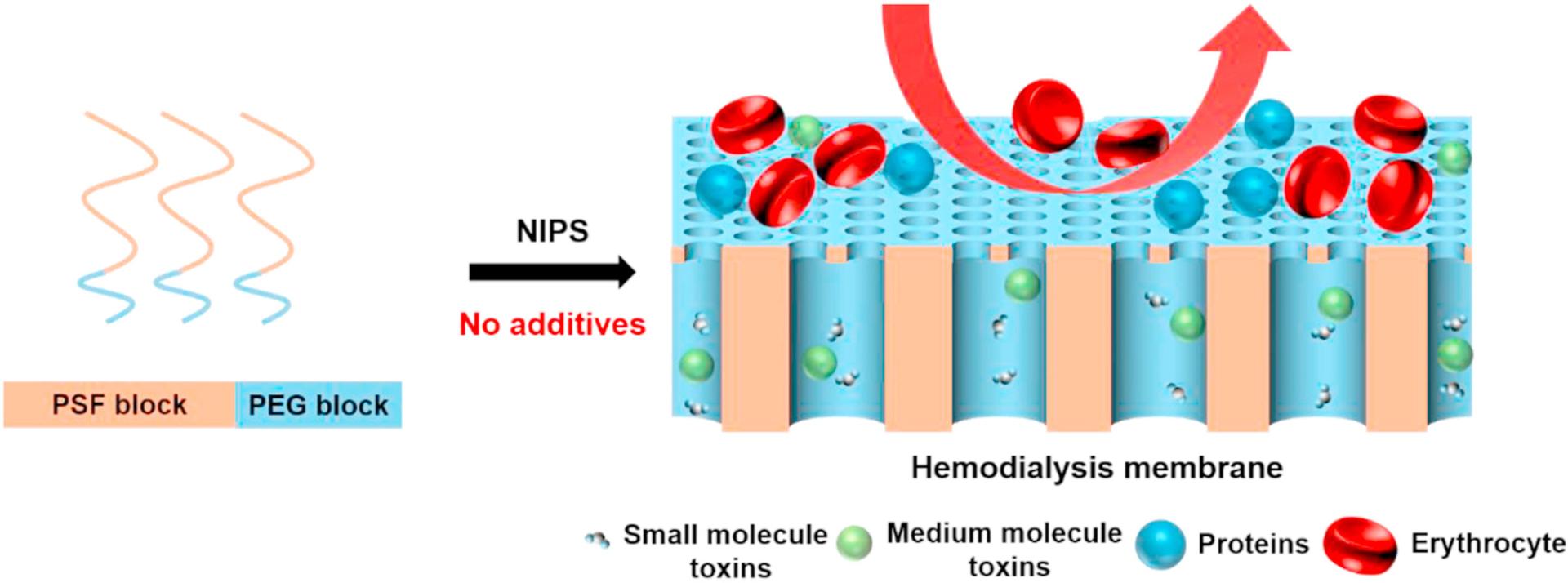
Upgrading Polytetrafluoroethylene Hollow-fiber Membranes by CFD-optimized Atomic Layer Deposition
Sen Xiong, Xiaojuan Jia, Kai Mi, Yong Wang*, J. Membr. Sci. 2021, 617, 118610
Polytetrafluoroethylene hollow-fiber membranes (PTFE HFMs) with attractive advantages are highly promising for many applications, but strong hydrophobicity limits their uses in aqueous systems. To address this challenge, we propose to coat ultra-thin layers of alumina by atomic layer deposition (ALD) to upgrade performances of PTFE HFMs in water treatment. However, ALD usually requires time- and labor-consuming trial-and-error to optimize operating parameters. Herein, we use computational fluid dynamics (CFD) to identify most appropriate ALD parameters for PTFE HFMs functionalization. Following the CFD-optimized parameters, the ALD-treated membranes obtain significantly improved permselectivity and fouling resistance because of the remarkable increase in wettability at negligible cost in pore sizes. Impressively, water permeability of membranes is nearly doubled while rejection is increased by ∼20%, which is seldom achieved by other methods. This CFD-optimized ALD process is expected to be a universal strategy to efficiently enhance the performances of polymeric membranes.
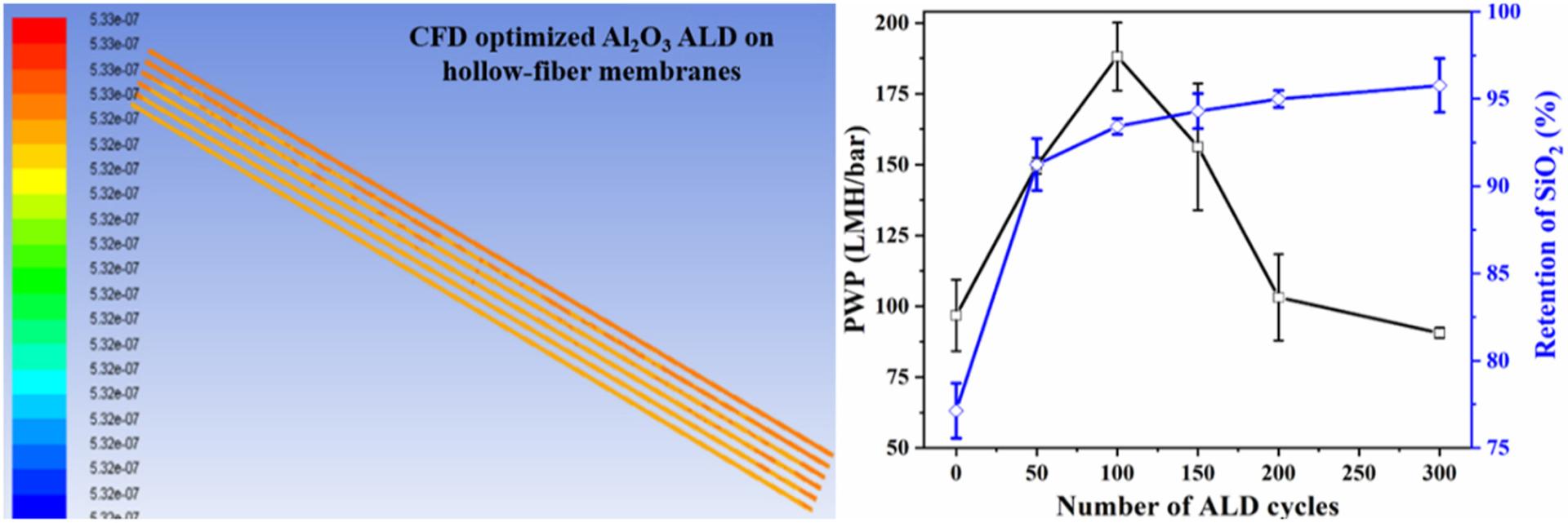
2020
N-doping Carbon-nanotubes Membrane Electrodes Derived from Covalent Organic Frameworks for Efficient Capacitive Deionization
Li Ren, Jiemei Zhou, Sen Xiong*, Yong Wang*, Langmuir 2020, 36, 12030-12037
Capacitive deionization (CDI) is an energy-efficient and environment-friendly electrochemical desalination technology, which has attracted increasing attentions in recent years. Electrodes are crucial to the performance of CDI processes, and utilizing carbon-nanotubes (CNTs) membrane to fabricate electrodes is an attractive solution for advanced CDI processes. However, the strong hydrophobicity and low electrosorption capacity limit applications of CNTs membranes in CDI. To solve this problem, we introduce crystalline porous covalent organic frameworks (COFs) into CNTs membranes to fabricate N-doping carbon-nanotubes membrane electrodes (NCMEs). After solvothermal growth and carbonization, CNTs membranes are successfully coated with imine-based COFs and turned into integrated NCMEs. Comparing with the CNTs membranes, the NCMEs exhibit ~2.3 times higher electrosorption capacity and superior reusability. This study not only confirms that COFs can be used as high-quality carbon sources, but also provides new strategy to fabricate high-performance CDI electrodes.
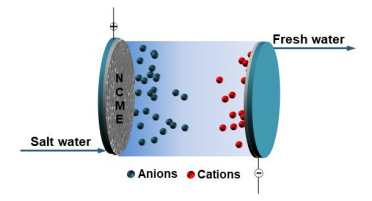
In-situ Growth of Cationic Covalent Organic Frameworks (COFs) for Mixed Matrix Membranes with Enhanced Performances
Xingyuan Wang, Xiansong Shi, Yong Wang*, Langmuir 2020, 36, 10970-10978
Covalent organic frameworks (COFs) are increasingly utilized as doping agents for the design of advanced ultrafiltration mixed matrix membranes, thanks to their prominent nanoporosities and excellent polymer compatibility. However, current strategies are largely limited in the complicated post-addition of neutral COF particulates. Herein, cationic COFs, namely TpEB, with sizes down to ~39 nm are insitu synthesized in polyacrylonitrile (PAN) solution as crystalline fillers for the production of highly permeable TpEB-PAN ultrafiltration membranes. After the condensation of monomer pairs, the growth of cationic TpEB crystallites is restrained due to the electrostatic interaction with negatively charged PAN chains, leading to the formation of homogeneous TpEB-incorporated casting solution. During the subsequent nonsolvent-induced phase separation process, TpEB crystallites facilitate the exchange between solvent and non-solvent because of their hydrophilic and nanoporous nature, accelerating the rate of phase inversion to form highly porous membrane surface. Thusprepared TpEB-PAN membranes deliver a tight rejection of BSA with a water permeance of up to 380 L m-2 h-1 bar-1, which is 35.6% higher than the original PAN membranes prepared without TpEB. The TpEB-PAN membranes also exhibit enhanced operation stabilities and fouling resistances. This in-situ growth strategy suggests a new avenue for the preparation of advanced mixed matrix membranes.

Pressure-Dependent Ion Rejection in Nanopores
Xin Zhang, Mingjie Wei*, Fang Xu, Yong Wang*, J. Phys. Chem. C 2020, 124, 20498-20505
It is generally considered that ion rejection of a desalination membrane is independent of the operation pressure drops (ΔPs), which is typically not higher than 10 MPa. However, this may not be true for pressures as high as hundreds of megapascals usually used in simulations. Therefore, simulation results of high ΔPs cannot be directly used to predict real-world ion rejections, which is often overlooked. Herein, we investigate the ion rejection of carbon nanotube membranes in a large scale of ΔPs via non-equilibrium molecular dynamics simulations. With effective pressure drops (ΔPe’s) increased from 2.85 to 996 MPa, the ion rejection drops from 100% to nearly zero. Rather than directly investigating the rejection, the relationships of ion and water fluxes with ΔPs are separately investigated. With rising ΔPe’s, the water flux increases linearly, while the ion flux undergoes a two-stage increase: firstly, an exponential increase at ΔPe ≤ 53.4 MPa and then a linear increase. An equation of describing the ΔPe-dependent ion rejection is then developed based on these observations. Moreover, the rejection mechanism is also discovered that the enhanced input energy makes ions easier to overcome the energy barrier rather than the molecular-configurational reasons. These findings are expected to fill the big gaps between simulations and experiments, and may also be helpful for the rational design of the next-generation desalination membranes.
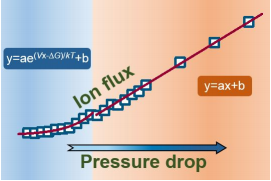
Effect of Hydrophilicity on Water Transport Through Sub-nanometer Pores
Fang Xu, Mingjie Wei*, Xin Zhang, Yong Wang*, J. Membr. Sci. 2020, 611, 118297
Pore hydrophilicity is crucial parameter for water transport through nanopores. However, the effect of pore hydrophilicity on water permeance at the sub-nanometer scale remains unclear because it cannot be described by the conventional fluid mechanics. Herein, to determine the separate relationship between water permeance and pore hydrophilicity at the sub-nanometer scale, an equation derived from interfacial friction is obtained to exclude the effects of other variables. Using non-equilibrium molecular dynamics, we investigate water transport through a series of nanopores which is constructed from 12 types of functionalized covalent organic frameworks (COFs) with various degrees of hydrophilicity but similar skeletons and sub-nanometer pore sizes. The variable-excluded permeance has a linear relationship with contact angle. However, this linear relationship is not applicable to the hydrophobic and extremely hydrophilic nanopores under experimental pressure drops. For experimental predictions, the final relationship is corrected by considering the combined effect within all-range degrees of hydrophilicity. Therefore, a range of moderate pore hydrophilicity is suggested for the application of sub-nanometer pores in water transport. This study reveals the quantitative effect of pore hydrophilicity on water permeance at the sub-nanometer scale, which can be useful for the screening of nanomaterials for various applications.
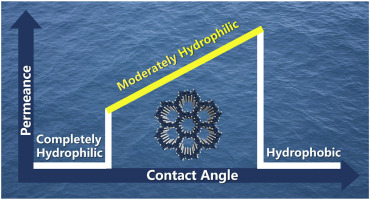
Room-temperature Swelling of Block Copolymers for Nanoporous Membranes with Well-defined Porosities
Yanjie Wang, Chenxu Zhang, Jiemei Zhou*, Yong Wang*, J. Membr. Sci. 2020, 608, 118186
Selective swelling of block copolymers (BCPs) has been an efficient way to produce nanoporous materials with well-defined porosities. Currently, the cavitation of bulk BCP films by selective swelling needs to be performed at elevated temperatures (typically 50–70 °C), which is not only tedious in operation but also energy extensive. Herein, we develop the room-temperature (RT) swelling strategy to enable pore formation in BCP films with no need of heating. Simply introducing a solvent selective to the majority blocks of BCPs into the swelling bath allows the initiation of selective swelling-induced pore generation at room temperature because of plasticizing effect on BCP matrix. The swelling degrees and porosities of BCP films can be flexibly tuned by changing the compositions of the swelling bath and the swelling durations. The universality of this RT swelling strategy is also demonstrated by its applicability to both polystyrene (PS)-based BCPs and polysulfone-based BCPs with high glass transition temperatures. We prepare composite membranes with nanoporous polystyrene-block-poly (2-vinyl pyridine) (PS-b-P2VP) selective layers on top of macroporous substrates by using this RT swelling approach. Interestingly, thus-produced membranes exhibit more uniform pores with narrow pore size distributions, resulting in better selectivity. RT swelling is featured as convenient and energy-saving, and is desired in large-scale manufacturing of nanoporous BCP materials for various applications.

Producing Nanoporosities in Block Copolymers within 30 s by Microwave-Boosted Selective Swelling
Xiansong Shi, Xingyuan Wang, Yanjie Wang, Yong Wang*, Macromolecules 2020, 53, 3619-3626
Nanoporous materials derived from block copolymers (BCPs), with rich morphological diversity and designable functionality, have attracted extensive interest in membrane separation, drug delivery, and catalysis. However, it is still challenging to realize the cavitation of dense BCPs through a fast and cost-effective strategy. Here, we report microwave-boosted selective swelling (MBSS), an ultrafast and universal cavitation approach, to introduce prominent porosities into BCPs within 30 s. When applying the microwave heating on swelling solvents, the dipole rotation of polar molecules leads to a drastic collision to give a quick temperature increase. Besides, the furious rotation enables a fast diffusion of swelling solvents into BCPs and accelerates the selective swelling of BCPs, achieving a pronounced volume expansion to give nanoporosities in seconds. This microwave-enabled strategy is greatly universal, capable of cavitating not only polystyrene-based BCPs but also highly rigid polysulfone-based BCPs. Interestingly, performing MBSS on BCP-coated macroporous supports realizes the ultrafast pore formation, producing composite membranes exhibiting excellent ultrafiltration performances. This microwave-based approach allows extremely facile preparation of BCP-based nanoporous materials, which is essential for their mass production and real-world applications.
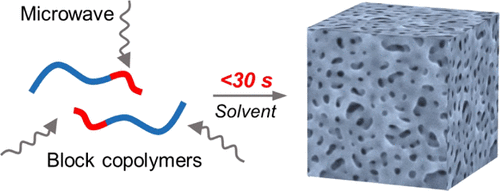
Single-Layered Nanosheets of Covalent Triazine Frameworks (CTFs) by Mild Oxidation for Molecular-Sieving Membranes
Congcong Yin, Zhe Zhang, Jiemei Zhou, Yong Wang*, ACS Appl. Mater. Interfaces 2020, 12, 18944-18951
Covalent triazine frameworks (CTFs) nanosheets featured with uniform intrinsic nanoporosity and excellent stability are promising building blocks for fast, selective membranes. However, it remains challenging to produce ultrathin CTF nanosheets, significantly hindering the development of CTF-based membranes. Herein, we develop a mild oxidation strategy to exfoliate CTFs, enabling the preparation of highly permeable membranes with stacked CTF nanosheets as the selective layers. The interlamellar spacing of CTF is effectively expanded following the mechanism of “proton donating-accepting” in which dimethyl sulfoxide (DMSO) is working as a soft oxidant, leading to ultrathin CTF nanosheets with the assistance of ultrasonication. Furthermore, oxygen-containing functional groups are also introduced onto the CTF nanosheets through the mid oxidation, improving surface hydrophilicity. The CTF nanosheet can be stacked onto porous substrates by vacuum filtration to form composite membranes with the thickness of the stacked CTF nanosheets down to ~30 nm. Thus-obtained membranes exhibit impressive dye separation performances with both high water permeance and high rejection. This work not only provides an efficient method to synthesize ultrathin CTF nanosheets, but also a process to prepare fast but selective membranes for molecular separations.

Secondary Growth of Covalent Organic Frameworks (COFs) on Porous Substrates for Fast Desalination
Rui Wang, Mingjie Wei*, Yong Wang*, J. Membr. Sci. 2020, 604, 118090
Covalent organic frameworks (COFs) has emerged as a highly promising platform material for the manufacturing of molecule-separating membranes. However, COF membranes are predominantly used in the separation of dyes from water or organic solvents and there are very few reports on COF-enabled membranes for desalination. In this work, the secondary growth approach based on unidirectional diffusion synthesis is developed to grow continuous thin films of a COF with an intrinsic pore size of 0.8 nm on macroporous substrates to prepare COF membranes for desalination. The amino-modified polymer microfiltration substrate is fixed in a diffusion cell to separate the oil phase containing the aldehyde precursor (1,3,5-triformylphloroglucinol, Tp) and the aqueous phase containing both the amino precursor (hydrazine, Hz) and the catalyst. Because of the immiscible, bi-phasic solutions and the high molar ratio of Hz to Tp, the unidirectional diffusion of Hz molecules in the pore channel of the substrate is achieved and the polycondensation between the two precursors occurs at the phase interface. The unidirectional diffusion synthesis is sequentially performed for two times and the secondary growth is essential to ensure the formation of a defect-free, continuous thin film of COF (TpHz) on the top surface of the substrate. Cladding COF coatings are also formed along the skeleton in the near-surface region of the substrate. Such an asymmetric structure ensures both a good permselectivity and a strong adhesion between the grown COF layers and the substrates. The continuous COF thin film grown on the substrates serves as the selective layer, and the COF membrane prepared under the optimized condition exhibits an appreciable Na2SO4 rejection of 58.3% and a water permeance of 40.5 L∙m-2∙h-1∙MPa-1 which are ∼ ten times higher than other membranes with similar rejections. This study not only demonstrates the potential of COFs in desalination but also showcases an efficient strategy to grow continuous thin films of COFs on porous substrates which are desired in diverse applications.

Influence of Membrane Hydrophilicity on Water Permeability: An Experimental Study Bridging Simulations
Aoze Miao, Mingjie Wei*, Fang Xu, Yong Wang*, J. Membr. Sci. 2020, 604, 118087
There has been an argument on the influence of membrane hydrophilicity on permeability between experimental and simulation works. Theoretical work finds that the membranes have a characteristic called a threshold pressure drop (ΔPT). Strongly hydrophobic membranes exhibit extremely high ΔPT, making membranes less wettable and consequently less permeable. In order to experimentally investigate the influence of wetting states of membranes, determined by membrane hydrophilicity, on permeability, we prepared a series of membranes with progressively changing hydrophilicities by atomic layer deposition (ALD) of TiO2 on polytetrafluoroethylene membranes while keeping the pore size unchanged. In addition, adding ethanol into the water and raising the operating pressure drops are also selected to improve the wetting degrees. The experimental results verify the presence of ΔPT for all membranes and the hydrophobic membranes having higher ΔPT. Since the hydrophilic membranes have better wetting degrees but higher transport resistance, there should be an optimized hydrophilicity, which is found to be determined by the feed solution and the operating ΔP. The optimized hydrophilic modification is the one when the membrane can be just adequately wetted by the feed solution at the target operating pressure drops. Highest water permeability is expected to be obtained at a moderate hydrophilicity, neither at the extreme hydrophilicity nor at the extreme hydrophobicity.

(Back Cover) Molecular Simulations of Water Transport Resistance in Polyamide RO Membranes: Interfacial and Interior Contributions
Yang Song, Mingjie Wei*, Fang Xu, Yong Wang*, Engineering 2020, 6, 577-584.
Understanding the transport resistance of water molecules in polyamide (PA) reverse osmosis (RO) membranes at the molecular level is of great importance in guiding the design, preparation, and applications of these membranes. In this work, we use molecular simulation to calculate the total transport resistance by dividing it into two contributions: the interior part and the interfacial part. The interior resistance is dependent on the thickness of the PA layer, while the interfacial resistance is not. Simulation based on the 5 nm PA layer reveals that interfacial resistance is the dominating contribution (> 62%) to the total resistance. However, for real-world RO membranes with a 200 nm PA layer, interfacial resistance plays a minor role, with a contribution below 10%. This implies that there is a risk of inaccuracy when using the typical method to estimate the transport resistance of RO membranes, as this method involves simply multiplying the total transport resistance of the simulated value based on a membrane with a 5 nm PA layer. Furthermore, both the interfacial resistance and the interior resistance are dependent on the chemistry of the PA layer. Our simulation reveals that decreasing the number of residual carboxyl groups in the PA layer leads to decreased interior resistance; therefore, the water permeability can be improved at no cost of ion rejection, which is in excellent agreement with the experimental results.

Thickness-dependent Ion Rejection in Nanopores
Xin Zhang, Mingjie Wei*, Fang Xu, Yong Wang*, J. Membr. Sci. 2020, 601, 117899
Membrane-based desalination is playing a pivotal role in producing potable water. Tremendous efforts are made to reduce membrane thickness, e.g. by using ultrathin two-dimensional (2D) building blocks as the desalination layers, to enhance water permeance, however, reduction in membrane thickness to a certain threshold may lead to significant loss in ion rejection, which has generally been overlooked. Here, we perform non-equilibrium molecular dynamics simulations on water and ion transporting through carbon nanotube (CNT) membranes with various thicknesses. We reveal that there is an effect of membrane thickness on ion rejection, that is, salt rejection rises and then levels off with rising membrane thickness. Molecular analysis indicates that the dehydration of ions when transporting the pores is the origin of this thickness effect. Increase in membrane thickness results in stronger degree of dehydration and consequently enhanced ion rejections. When the membrane thickness is below a critical value (lδ), the degree of dehydration and ion rejection keep rising and then maintain unchanged with further increased thickness, and lδ is therefore, defined as the critical thickness for desalination. Compared to atomically thin membranes, a 2.34-nm-thick membrane can exhibit nearly doubled water permance while maintain 100% NaCl rejection. The effect of thickness-dependent ion rejection suggests us to enhance water permeation at no cost of ion rejection by using membranes with thicker desalination layers but larger pores, which is highly important in the design of next-generation membranes for desalination.
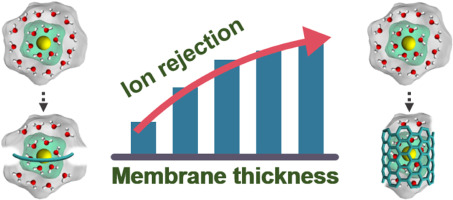
Simultaneous Zwitterionization and Selective Swelling-induced Pore Generation of Block Copolymers for Antifouling Ultrafiltration Membranes
Chenxu Zhang, Congcong Yin, Yanjie Wang, Jiemei Zhou*, Yong Wang*, J. Membr. Sci. 2020, 599, 117833
Membranes with zwitterionic surfaces are highly desired in water-based separations for their distinguished fouling resistance. Herein, a facile strategy for the preparation of zwitterion-functionalized membranes is developed by coupling the pore-making and zwitterion functionalization in one step. We soaked thin films of poly (2-dimethylaminoethyl methacrylate)-block-polystyrene (PDMAEMA-b-PS) in the mixture of ethanol and 1, 3-propanesultone (1, 3-PPST). In this mixture, PDMAEMA microdomains were selective swollen leading to nanoporous structures with PDMAEMA chains enriched on the surface. Simultaneously, the quaternization reaction between PDMAEMA and 1, 3-PPST took place. Unexpectedly, in addition to function as the zwitterionic agent, 1, 3-PPST also contributed to the selective swelling induced pore generation. It was found that the presence of 1, 3-PPST in ethanol slowed down the swelling process at the early stage, but evidently enhanced the swelling of PDMAEMA-b-PS films in longer duration. Thus-prepared zwitterion-functionalized membranes exhibited several times higher water permeance than non-zwitterionized counterparts, which should be attributed to increased pore size and strongly improved hydrophilicity as a result of zwitterion functionalization. Moreover, the membranes showed exceptional fouling resistance because of the presence of zwitterions.
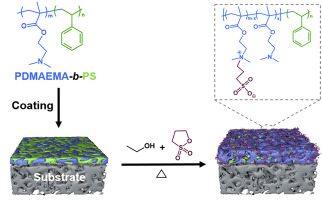
(Cover) Selective Swelling of Block Copolymers: An Upscalable Greener Process to Ultrafiltration Membranes?
Jiemei Zhou, Yong Wang*, Macromolecules 2020, 53, 5-17
Block copolymers (BCPs) have long been pursued as precursors to nanoporous membranes, and selective swelling-induced pore generation has emerged as an extremely simple strategy to BCP membranes with both well-defined nanoporosity and inherently functional surfaces. In this Perspective, we briefly discuss the principles of this pore-making method and summarize its key features and most recent progress on thus-produced ultrafiltration membranes. Exciting results toward the upscaling of this method are highlighted: the large-scale, affordable synthesis of polysulfone-based BCPs and the continuous manufacturing of BCP membranes by melt extrusion coupled with microwave-boosted selective swelling. Importantly, we reveal the “greener” nature of this selective swelling process compared to conventional phase-inversion methods as it involves less aggressive solvents and produces no wastewaters. An outlook on the remaining challenges and future efforts to push selective swelling to real-world applications is also presented.
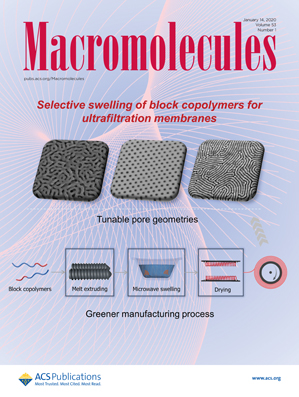
Table-Salt Enabled Interface-Confined Synthesis of Covalent Organic Framework (COF) Nanosheets
Xiansong Shi, Dongwei Ma, Fang Xu, Zhe Zhang, Yong Wang*, Chem. Sci. 2020, 11, 989-996
Two-dimensional covalent organic frameworks (COFs) are gaining tremendous interests for their potential applications in a diversity of fields. However, synthesis of COF nanosheets (CONs) usually suffers from tedious exfoliation processes and low yields. Herein, we present an exfoliation-free and scalable strategy to prepare few-layered CONs based on interface-confined synthesis, in which cheap and recyclable table salts (NaCl) are used as the sacrificial substrates. Salt particles are introduced into the reaction system, creating billions of solid-liquid interfaces. Oligomers formed upon the reaction between monomers are immediately adsorbed on salt surfaces, and the following polymerization leading to crystalline CONs is exclusively confined to salt surfaces. Salts can be easily removed by water washing, producing CONs with the thickness down to a few nanometers and lateral sizes up to hundreds of micrometers depending on the size of salt particles and the concentration of monomers. Four different kinds of CONs, both imine-linked and boron-containing, are synthesized from this generic method. As a demonstration, we prepare highly permeable and selective membranes using resultant CONs as building blocks. Thanks to the defect-free stacking of CONs with thin thicknesses and large lateral sizes on porous substrates, the membranes precisely separate similarly sized dyes while allow ultrafast water permeation. This interface-confined strategy opens a new platform for the controllable and scalable synthesis of COF nanosheets, which is essential for the burgeoning real-world applications of COFs in various fields.

Block Copolymer Ultrafiltration Membranes by Spray Coating Coupled with Selective Swelling
Dongwei Ma, Jiemei Zhou, Zhaogen Wang, Yong Wang*, J. Membr. Sci. 2020, 598, 117656
Block copolymers (BCPs) have been demonstrated to be promising precursors in the fabrication of ultrafiltration membranes with well-defined porosities. To maximize the separation performance, BCPs are usually used in the forms of thin-film composite membranes with nanoporous BCP separation layers on the top of macroporous substrates. However, it remains a challenge to prepare such composite structures in an efficient and controllable way. Herein, we demonstrate that spray coating of BCP solutions on macroporous substrates followed by selective swelling is a facile and highly controllable strategy to produce BCP composite membranes. First, the BCP solution was spray-coated on a macroporous nylon support. By changing polymer concentrations as well as various spray conditions, a defect-free and uniform dense BCP layer was obtained. The thickness of the BCP layer can be controlled within the scope of a few micrometers simply by altering the step width of spray coating. Neither pre-filling of the macroporous supports to prevent solution permeation nor post-treatment to strengthen the adhesion of the two layers is required during the spray coating process. The BCP-coated support was then soaked in hot ethanol to create nanoporosity in the BCP layer following the mechanism of selective swelling-induced pore generation. Thus-produced composite membranes exhibit excellent ultrafiltration performances. Meanwhile, the pore sizes, surface hydrophilicity and consequently separation performances of the membranes can be conveniently tuned by changing swelling conditions. We expect this spraying coating coupled with selective swelling to produce BCP-based composite membranes at large scale for industrial production.

Nanofluidic Behaviors of Water and Ions in Covalent Triazine Framework (CTF) Multilayers
Mingjie Wei, Wei Zhou, Fang Xu, Yong Wang*, Small 2020, 16, 1903879
Covalent triazine frameworks (CTFs) hosting arrays of highly ordered sub-2-nm pores are expected to exhibit unusual nanofluidic behaviors, which may enable important applications such as desalination. Herein, non-equilibrium molecular dynamics simulations are applied to investigate transport of water and ions inside two typical CTFs, CTF-1 and CTF-2, having the intrinsic pore of 1.2 nm and 1.5 nm, respectively. Their monolayers exhibit extremely high water permeance but weak ion rejection. CTF multilayers are then investigated. Transport resistances composed of interior and interfacial contribution are correlated with stacking numbers of CTF monolayers to develop equations of predicting water permeance. It is revealed that both the stacking fashion and the number of CTF monolayers to form multilayers significantly influence permeation and ion rejection. Staggered multilayers exhibit much higher ion rejection than eclipsed ones. Staggered CTF-2 multilayers completely reject ions because the interlayer paths between two adjacent staggered monolayers allow only water molecules to pass through. Importantly, it is predicted from our equations that, few-layered staggered CTF-2 multilayers, which can be relatively easily produced by experimental methods, exhibit 100% NaCl rejections and up-to-100 times higher permeance than commercial reverse osmosis membranes, implying their great potential as building blocks to prepare next-generation desalination membranes.
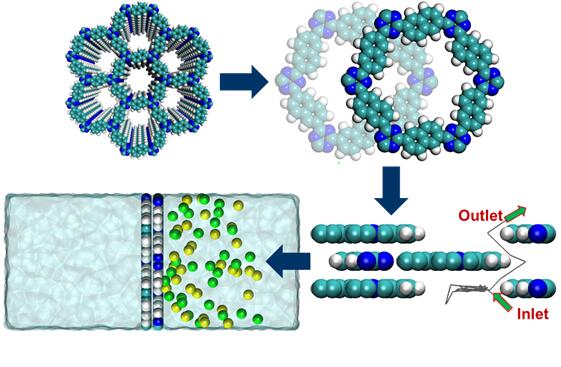
Gradient Nanoporous Phenolics as Substrates for High-Flux Nanofiltration Membranes by Layer-by-Layer Assembly of Polyelectrolytes
Yazhi Yang, Qianqian Lan, Yong Wang*, Chinese J. Chem. Eng. 2020, 28, 114-121
Thin film composite (TFC) membranes represent a highly promising platform for efficient nanofiltration (NF) processes. However, the improvement in permeance is impeded by the substrates with low permeances. Herein, highly permeable gradient phenolic membranes with tight selectivity are used as substrates to prepare TFC membranes with high permeances by the layer-by-layer assembly method. The negatively charged phenolic substrates are alternately assembled with polycation polyethylenimine (PEI) and polyanion poly(acrylic acid) (PAA) as a result of electrostatic interactions, forming thin and compact PEI/PAA layers tightly attached to the substrate surface. Benefiting from the high permeances and tight surface pores of the gradient nanoporous structures of the substrates, the produced PEI/PAA membranes exhibit a permeance up to 50.6 L ∙ m−2 ∙ h−1 ∙ bar−1, which is ~ 2–10 times higher than that of other membranes with similar rejections. The PEI/PAA membranes are capable of retaining > 96.1% of negatively charged dyes following the mechanism of electrostatic repulsion. We demonstrate that the membranes can also separate positively and neutrally charged dyes from water via other mechanisms. This work opens a new avenue for the design and preparation of high-flux NF membranes, which is also applicable to enhance the permeance of other TFC membranes.
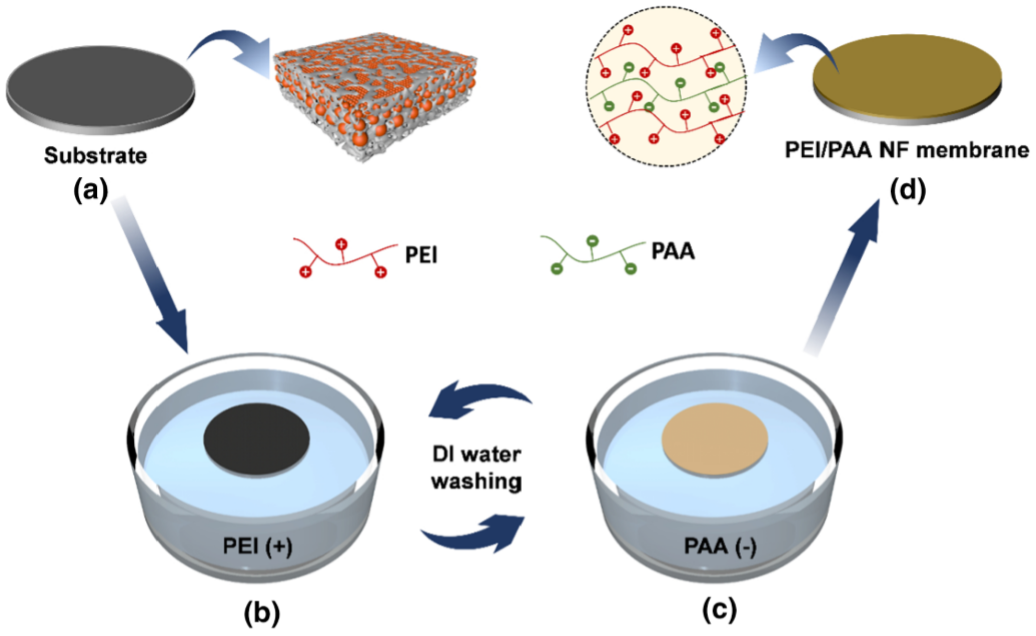
Selective Swelling of Polysulfone/Poly(ethylene Glycol) Block Copolymer towards Fouling-Resistant Ultrafiltration Membranes
Hao Yang, Jiemei Zhou, Zhaogen Wang, Xiansong Shi, Yong Wang*, Chinese J. Chem. Eng. 2020, 28, 98-103
Fouling resistance of ultrafiltration (UF) membranes is critical for their long-term usages in terms of stable performance, so convenient approaches to prepare fouling-resistant membranes are always anticipated. Herein, we demonstrate the facile fabrication of antifouling polysulfone-block-poly(ethylene glycol) (PSF-b-PEG, SFEG) composite membranes. SFEG layer was coated onto macroporous supports and cavitated by immerging them in acetone/n-propanol following the mechanism of selective swelling induced pore generation. Thus-produced SFEG membranes possessed high permeance and excellent mechanical strength. Meanwhile, the structures and separation performances of the SFEG layers can be continuously tuned through simply changing swelling durations. More importantly, the hydrophilic PEG chains were spontaneously enriched onto the pore walls through swelling treatment, endowing intrinsic antifouling property to the SFEG membranes. Bovine serum albumin (BSA)/humic acid (HA) fouling tests proved the prominent fouling resistance of SFEG membranes, and the fouling resistance is expected to be long-standing because of the firm connection between PEG chains and PSF matrix by covalent bonding.
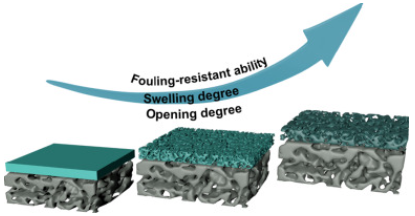
2019
Transport Mechanism of Water Molecules Passing Through Polyamide/COF Mixed Matrix Membranes
Yang Song, Mingjie Wei*, Fang Xu, Yong Wang*, Phys. Chem. Chem. Phys. 2019, 21, 26591-26597
Mixed matrix membranes (MMMs) have gained significant attention due to their high water permeability without the cost of salt rejection. However, the mechanism of water transport through MMMs is still controversial. Herein, a type of two-dimensional covalent organic framework (COF), TpPa-1, was selected as a blending additive for mixing with polyamide (PA) due to its good compatibility with polymeric matrices. We performed nonequilibrium molecular dynamics simulations to investigate the transport properties of the water molecules passing through MMMs. The permeance of MMMs was obviously enhanced compared to that of the pure PA membrane. However, this enhancement in permeance did not originate from the intrinsic pores of COFs. The PA atoms confined in the pores had extremely low diffusivity and thus, the water molecules were trapped inside the COF pores. Outside the COF pores, there was an interfacial region between COFs and PA, in which the water molecules aggregated to form a high-density region. In this region, the average flow velocities of the water molecules were much higher than those in pure PA or PA outside the mixed region of MMMs. The water transport mechanism discovered in this work offers an alternative and more likely explanation for the high permeance observed in PA/COF MMMs, and this understanding can be helpful to design more efficient MMMs.

Ion Rejection in Covalent Organic Frameworks: Revealing the Overlooked Effect of In-pore Transport
Fang Xu, Mingjie Wei*, Xin Zhang, Yong Wang*, ACS Appl. Mater. Interfaces 2019, 11, 45246-45255
Covalent organic frameworks (COFs), possessing highly ordered and intrinsic nanopores with high density and tunable sizes, are expected to find important applications in ion separations and desalination. Design of COF membranes with outstanding permselectivity requires understandings on the ion rejection behaviors of COF multilayers. However, the ion rejection mechanism of COF multilayers remains to be elucidated because it may significantly differ from that of conventional polyamide membranes. Herein, we use nonequilibrium molecular dynamics simulations to investigate the ion transport through multilayers of TpHZ, which is a stable, imine-linked COF. Surprisingly, we find that the rejection to NaCl is determined by its rejection to Na+ rather than to Cl- although hydrated Cl- is bigger than hydrated Na+. Inside the channels of the TpHZ multilayers, Na+ ions transport evidently slower than water molecules, implying that the in-pore transport effect instead of the commonly thought pore-entrance sieving effect governs ion rejection. The in-pore transport effect of Na+ is mainly due to the hydration of Na+ with pore wall and stronger capability of the hydrated Na+ ions to form hydrogen bonds with pore wall, both of which are primarily originated from the polarity of the COF. This work reveals the significant role of in-pore transport in ion rejection which is overlooked in commonly used polyamide desalination membranes, and develops a universal equation capable of describing ion rejections of all membranes especially those contain structures of nanopores or nanochannels by considering both the effects of pore-entrance sieving and in-pore transport.

Enabling Covalent Organic Framework Nanofilms for Molecular Separation: Perforated Polymer-Assisted Transfer
Ankang Xiao, Zhe Zhang, Xiansong Shi, Yong Wang*, ACS Appl. Mater. Interfaces 2019, 11, 44783-44791
Covalent organic frameworks (COFs) with ordered arrays of sub-2-nm regular pores are drawing increasing attentions in membrane separation, and it remains highly desired for effective and controllable strategies to fabricate COF-based membranes. Herein, we demonstrate a perforated polymer-assisted transfer strategy enabling COF nanofilms for molecular separation. Solvothermal synthesis is used for the confined growth of TpPa, a stable, imine-linked COF, on the smooth surfaces of silicon substrates. Continuous, crystalline COF nanofilms are obtained, and their thicknesses are tunable in the range from a few tens nm to several hundred nm depending on monomer concentrations and reaction time. A block copolymer layer is coated on the COF nanofilms, which is then perforated to produce interconnected mesopores by the mechanism of selective swelling-induced pore generation. The perforated polymer coating functions as a protective but permeable layer enabling the easy transfer of the COF nanofilm onto porous substrates. Thus, we obtain a new type of composite membranes with the microporous COF nanofilm as the selective layer, sandwiched between the macroporous substrate and the mesoporous protective layer. The composite membranes exhibit good separation performances with water permeance up to ~51 L m-2 h-1 bar-1 and high rejection rates to various dyes. This work demonstrates a new method to prepare COF-based membranes for molecular separation, and the invented perforated polymer-assisted transfer technology is expected to find applications in transferring other ultrathin materials to demanded substrates.
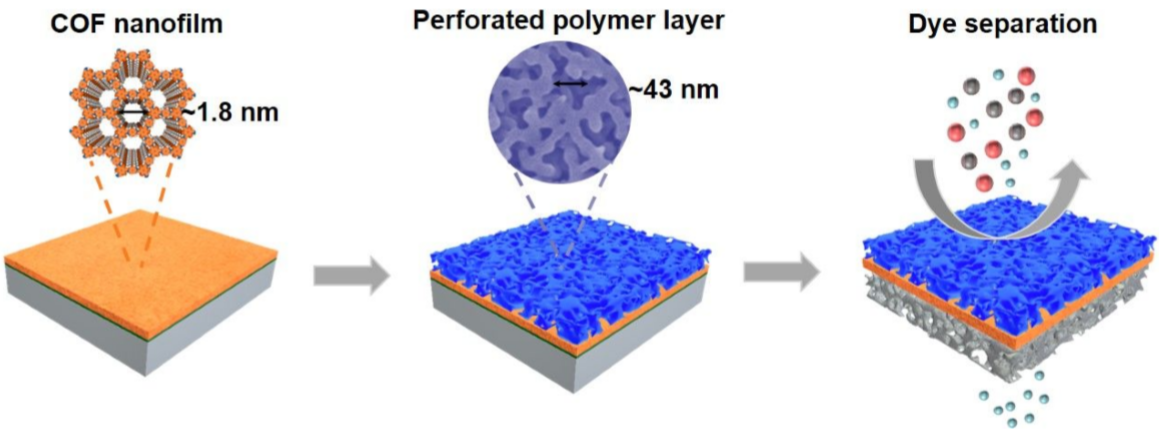
Ultra-Permeable Polyamide Membranes Harvested by Covalent Organic Framework Nanofiber Scaffolds: A Two-in-One Strategy
Zhe Zhang, Xiansong Shi, Rui Wang, Ankang Xiao, Yong Wang*, Chem. Sci. 2019, 10, 9077-9083
Polyamide-based thin-film composite nanofiltration membranes are widely used for potable water decontamination, brackish water desalination and wastewater reutilization. However, enhancing water permeance of the polyamide layer within the thin-film composite nanofiltration membrane still remains a great challenge, because of the relatively large thickness and high transport resistance of the polyamide layer produced from the intractable interfacial polymerization. Herein, we reported a two-in-one strategy to prepare ultra-permeable nanofiltration membranes via covalent organic framework (COF) nanofiber scaffolds mediated interfacial polymerization. The highly porous and hydrophilic COF nanofiber scaffolds enhanced the controlled release of amine monomers, leading to ultrathin polyamide layers. Also, the relative smooth COF nanofiber scaffolds can be spontaneously evolved into rugged and uneven architectures during interfacial polymerization, providing rough substrates for enlarging actual areas of polyamide layers. Thereby, the increased areas of polyamide layers were employed as additional water permeable domains. Arising from the synergetic effect of the ultrathin and increased water permeation domains, the produced membranes exhibit exceptional nanofiltration performance with a water permeance up to 31.1 L m-2 h-1 bar-1 and a Na2SO4 rejection rate of about 95%, outperforming most of other nanofiltration membranes. This highly accessible technique opens a new avenue for design and engineering of ultrapermeable thin-film composite nanofiltration membranes, highlighting its great potential in providing clean water.
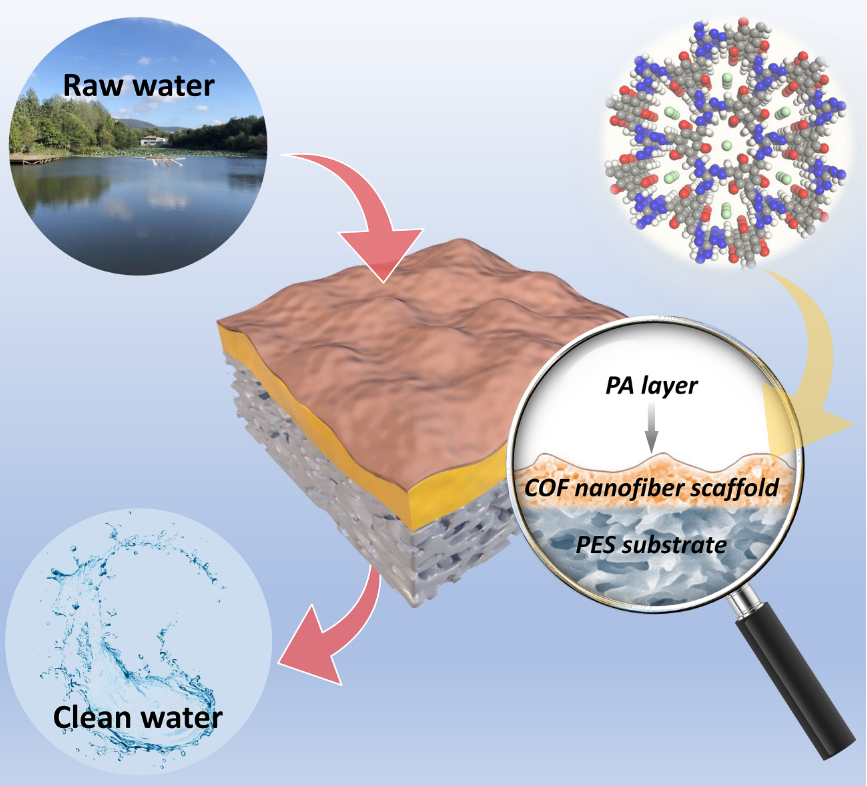
CO2-Responsive Graphene Oxide Nanofiltration Membranes for Switchable Rejection to Cations and Anions
Congcong Yin, Liangliang Dong, Zhaogen Wang, Mingqing Chen*, Yong Wang*, Yue Zhao*, J. Membr. Sci. 2019, 592, 117374
Inspired by biological membranes with charge-gated channels that allow the transport of water and ions but restrict the undesired substances, various regulated nanofiltration (NF) membranes containing charge-gated channels have been developed for water purification. However, most of these membranes are mono-charged (positively or negatively) that show high rejection only to the corresponding co-ions but low rejection to the counter-ions, which limits their wider applications. Herein, we report NF membranes with gas-tunable charge-gated channels and high rejection to different salts on demand. The membranes are prepared by assembling a CO2-responsive polymer, poly(N,N-dimethylaminoethyl methacrylate), on the surface of graphene oxide (GO). As a result of CO2-induced reversal of the charge sign, the membranes exhibit “self-regulation” of their surface charges. Upon bubbling CO2 into water, the membranes are positively charged, which shows high rejection to MgCl2. After bubbling Ar to remove CO2, the membranes gradually transform to negatively charged, and high rejection to Na2SO4 is obtained. This study demonstrates the gas-tunable charge-gated ion transport behavior of the CO2-responsive NF membranes, and opens up new avenues for the design of on-demand NF membranes.
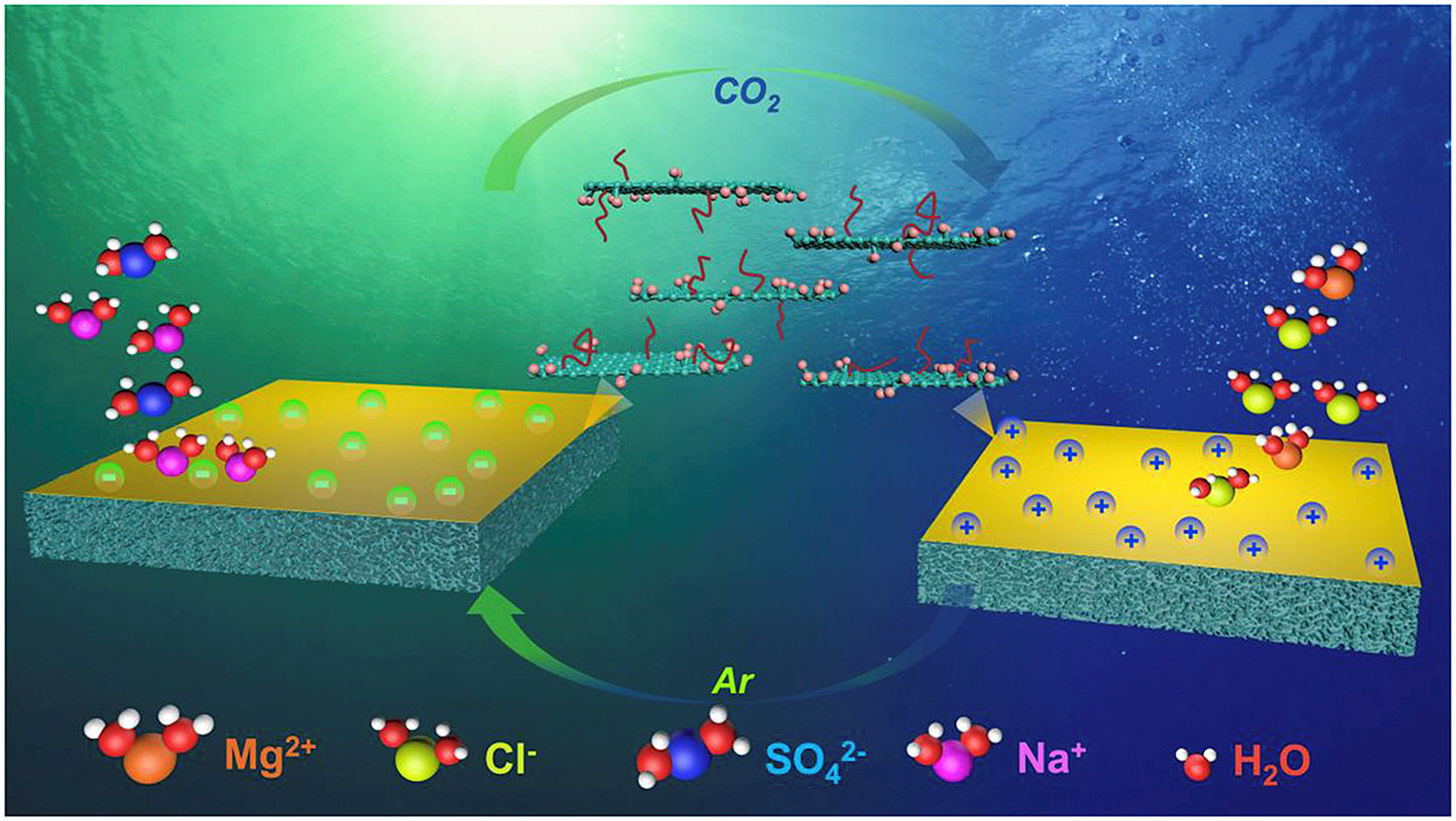
Carbonization of Gradient Phenolics Filled in Macroporous Substrates for High-Flux Tight Membranes: Toward Ultrafiltration of Polypeptides
Qianqian Lan, Yong Wang*, J. Membr. Sci. 2019, 590, 117309
Tight ultrafiltration (UF) membranes with high permeances have gained growing attention in the separation of biomacromolecules. Herein, we report the preparation of gradient carbonaceous structures filled in macroporous polyvinylidene fluoride (PVDF) substrates and their efficient separation of polypeptides. Gradient phenolics composed of nanoparticles with sizes increasing from top side to bottom side are firstly synthesized inside PVDF substrates. When soaked in concentrated H2SO4, phenolic nanoparticles are partially carbonized and foamed to form micropores while the PVDF substrate maintains intact. Thus-produced carbonaceous membranes are mechanical robust and exhibit narrowed pore sizes and enhanced hydrophilicity. Their permselectivity can be adjusted simply by changing the dosages of phenolic precursors filling into the PVDF substrates. Low dosages lead to remarkably high water permeances up to 1721 L/(m2 h bar). At higher dosages, the membrane is tightened to show a molecular-weight-cut-off (MWCO) down to 3.7 kg/mol and high permeances several times larger than other membranes with similar MWCOs. We demonstrate that such a tight UF membrane efficiently separates polypeptides with molecular weights of only a few kg/mol (angiotensin Ⅱ and thymosin β4). Our work opens a new avenue for the synthesis of high-flux tight UF membranes with narrowed pores, enabling the precise separation and fractionation of biomacromolecules.
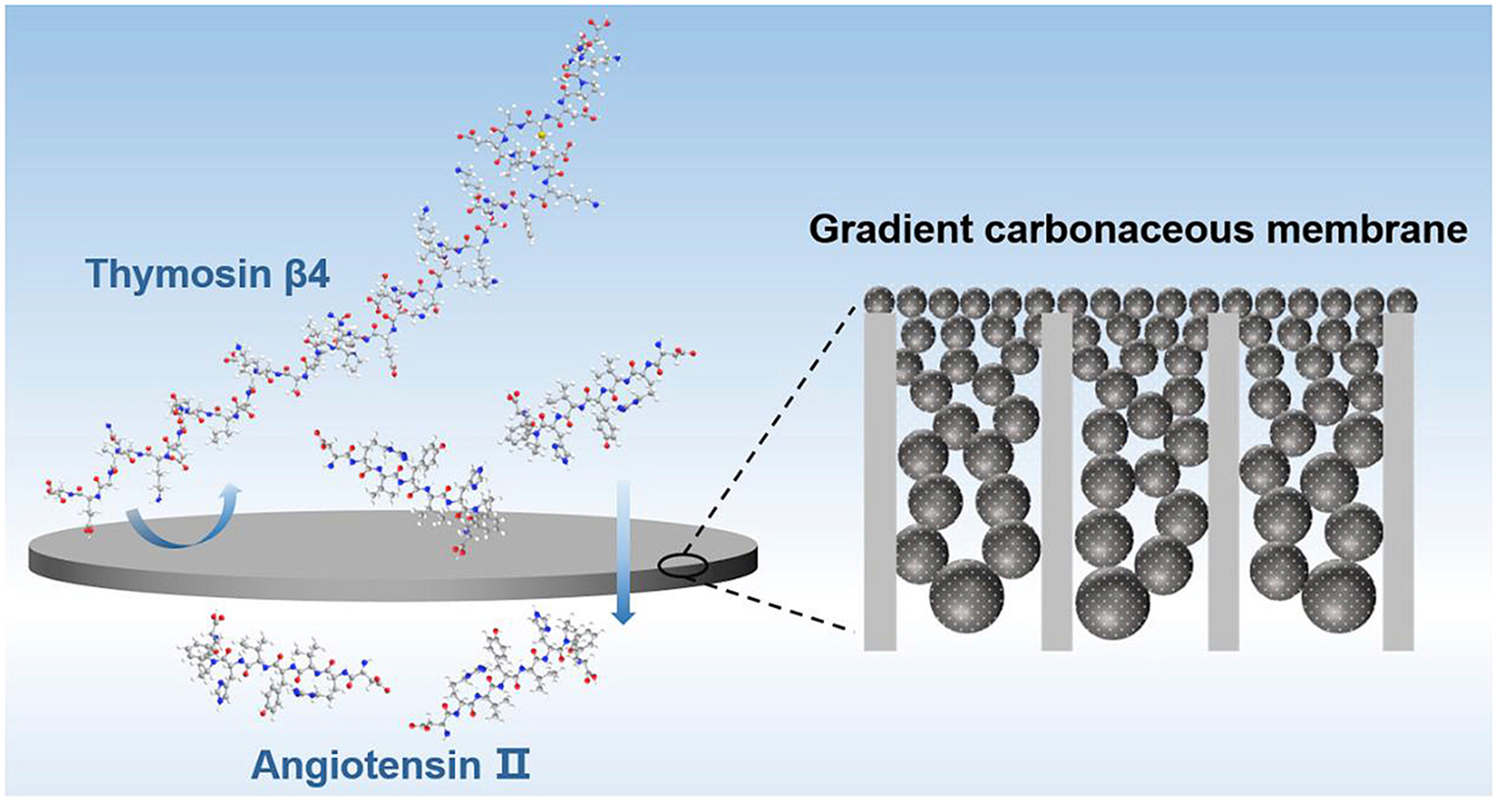
Single-Step Coating of Polyethylenimine on Gradient Nanoporous Phenolics for Tight Membranes with Ultrahigh Permeance
Leiming Guo, Yazhi Yang, Yong Wang*, J. Membr. Sci. 2019, 587, 117172
Ultrafiltration membranes with relatively small pores are highly expected in various separation cases. As a flexible manner to efficiently tighten the pores, post modification provides a robust platform for preparing the desired membranes. However, the endeavor to pursue high permselectivity of the membranes has been made by paying close attention to the modification layers while the effects of the substrate membranes are generally overlooked. In this work, tight membranes with ultrahigh permeance were produced by coating polyethylenimine (PEI) on gradient nanoporous phenolic substrates. Cationic PEI was tightly deposited on the negatively charged phenolics via electrostatic deposition, thus reducing the effective pore sizes to ∼2.6 nm through a single-step coating. The gradient porous nanostructures still remained after PEI coating in the phenolic membranes. The coated membranes exhibited ∼4–45 times higher permeance than counterparts with similar rejections. As the cationic PEI was distributed on the membrane surface and pore wall after coating, the positively charged membranes thus produced were able to efficiently separate cationic dyes from water.
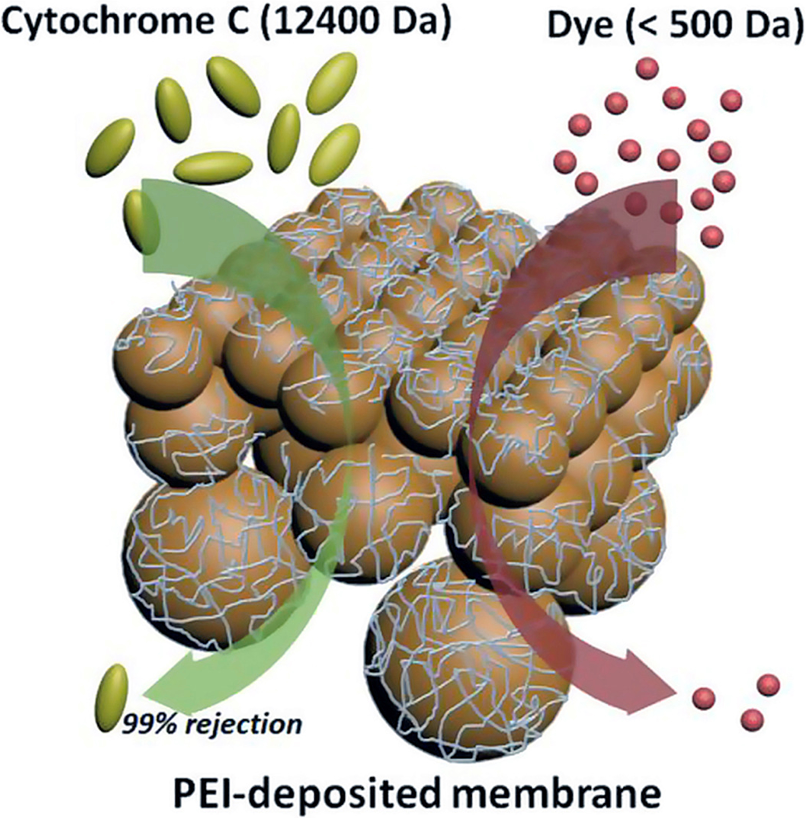
Unidirectional Diffusion Synthesis of Covalent Organic Frameworks (COFs) on Polymeric Substrates for Dye Separation
Rui Wang, Xiansong Shi, Zhe Zhang, Ankang Xiao, Shi-Peng Sun, Zhaoliang Cui, Yong Wang*, J. Membr. Sci. 2019, 586, 274-280
Covalent organic frameworks (COFs) are regarded as important candidates for the preparation of advanced membranes with remarkable performances on account of their uniform and tailorable channels and good chemical stability. The development of COFs-based membranes is burgeoning, and there remains lacking of facile and mild methods to prepare to these membranes. Herein, we report on the unidirectional diffusion synthesis (UDS) of TpPa (an imine-based COFs) on commercial polyvinylidene fluoride (PVDF) microfiltration substrates for the preparation of composite COF-based membranes at room temperature. The p-phenylenediamine (Pa) aqueous solution and 1,3,5-triformylphloroglucinol (Tp) n-hexane solution were separately charged into the two sides of a diffusion cell. With the suitable solution pairs and molar ratio of two precursors, only Pa molecules can pass through the macropores of PVDF to react with Tp molecules at the phase interface formed by this solution pairs, leading to the in situ synthesis of TpPa layer on the top side of PVDF substrates. The membrane fabricated with a synthesized duration of 24 h exhibits a superior selectivity for dyes (>90%) and appreciable water permeance (60 L m−2 h−1·bar−1). The permeance of THE resultant membrane is ∼2-20 times higher than other reported membranes with comparable dye rejections. The UDS offers a facile and mild process to directly grow COFs on porous polymeric substrates to construct composite membranes capable of efficient separations of dye molecules.
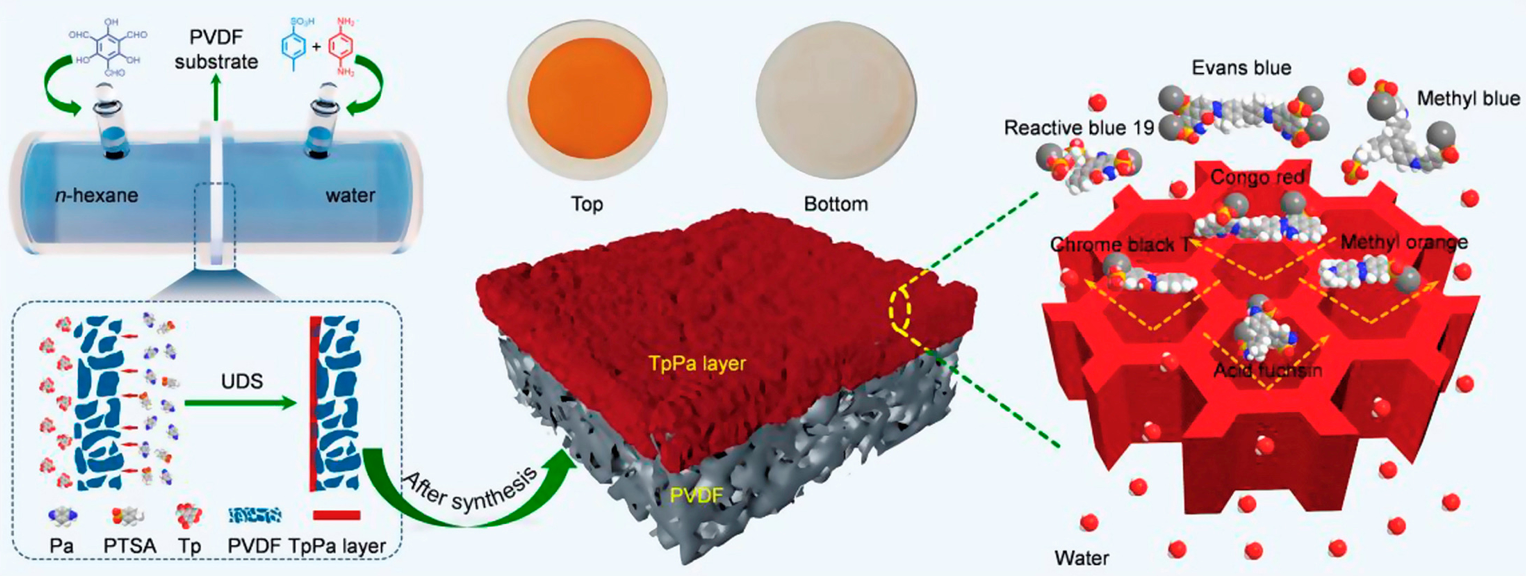
(Book Chapter) Selective Swelling of Block Copolymers for Porous Nanostructures
Leiming Guo, Zhaogen Wang, Yong Wang*, Block Copolymers 2019, 45-118
We previously aimed at 1D nanofibers and 2D thin films to illustrate the course of selective swelling in constructing porous nanostructures in BCPs. However, the swelling strategy has been extended to the preparation of 3D nanoporous bulk materials afterwards, in which bicontinuous and homoporous structures have been obtained. The swelling-induced pore generation enables the ease of fabrication of porous materials to meet the needs of membrane separation, lithography, drug-delivery, anti-reflectivity, solar cells and other applications, and shows a bright future. Here, we will uncover the mechanism, kinetic control of structures, swelling conditions and applications of the swelling-induced pore generation to provide a detailed yet deep understanding of this pore-generation strategy.
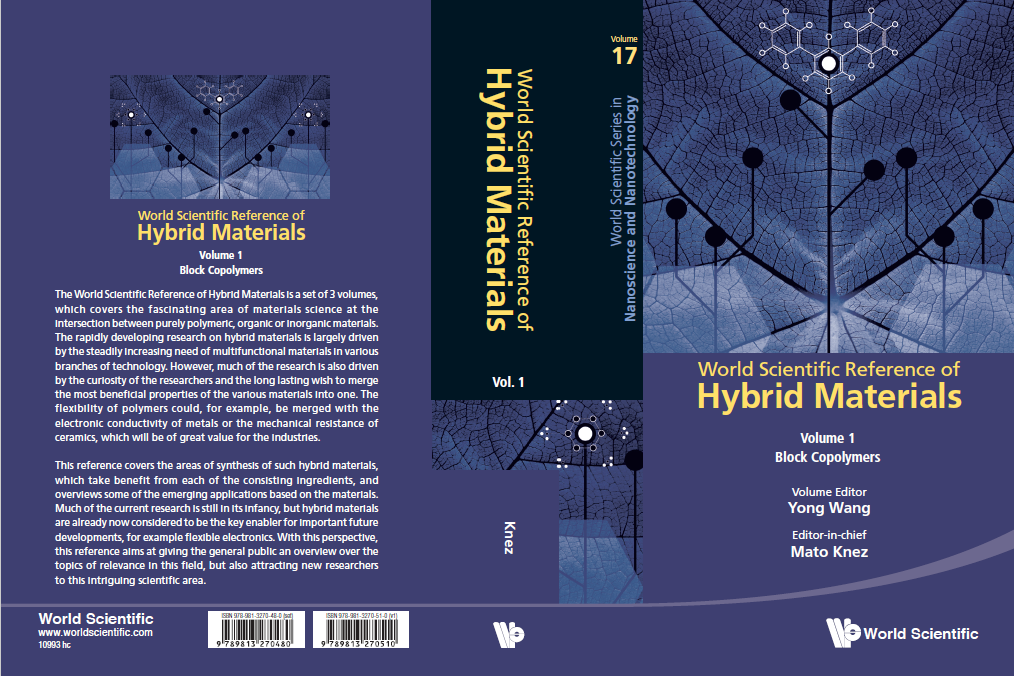
Fast Desalination by Multilayered Covalent Organic Framework (COF) Nanosheets
Wei Zhou, Mingjie Wei*, Xin Zhang, Fang Xu, Yong Wang*, ACS Appl. Mater. Interfaces 2019, 11, 16847-16854
Covalent organic frameworks (COFs) are penetrated with uniform and ordered nanopores, implying their great potential in molecular/ion separations. As an imine-linked, stable COF, TpPa-1 is receiving tremendous interest for molecular sieving membranes. Theoretically, atomically thin TpPa-1 monolayers exhibit extremely high water permeance but unfortunately no rejection to ions because of its large pore sizes (~1.58 nm). COF monolayers tend to stack to form laminated multilayers, but how this stacking influence water transport and ion rejections remain unknown. Herein, we investigate the transport behavior of water and salt ions through multilayered TpPa-1 COFs by nonequilibrium molecular dynamics simulations. By analyzing both the interfacial and interior resistance for water transport we reveal that with rising stacking numbers COF multilayers exhibit increasing ion rejections at the expense of water permeance. More importantly, stacking in the offset eclipsed fashion significantly reduces the equivalent pore size of COF multilayers to 0.89 nm and ion rejection is correspondingly increased. Remarkably, 25 COF monolayers stacked in this fashion give 100% MgCl2 rejection while the water permeance remain 1 to 2 orders of magnitude higher than that of commercial nanofiltration membranes. This work demonstrates the rational design of fast membranes for desalination by tailoring stacking number and fashion of COF monolayers.
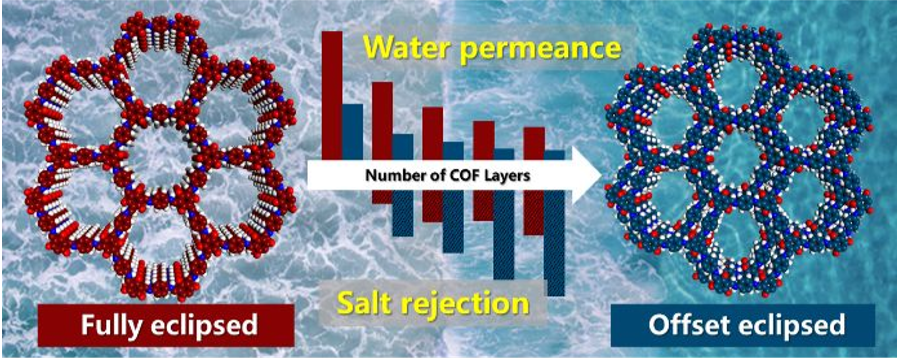
How Pore Hydrophilicity Influences Water Permeability?
Fang Xu, Mingjie Wei, Xin Zhang, Yang Song, Wei Zhou, Yong Wang*, Research 2019, 2581241
Membrane separation is playing increasingly important role in providing clean water. Simulations predict that membrane pores with strong hydrophobicity produce ultrahigh water permeability as a result of low friction. However, experiments demonstrate that hydrophilic pores favor higher permeability. Herein we simulate water molecules transporting through interlayers of twodimensional nanosheets with various hydrophilicities using nonequilibrium molecular dynamics. We reveal that there is a threshold pressure drop (ΔPT), exceeding which stable water permeability appears. Strongly hydrophobic pores exhibit extremely high ΔPT, prohibiting the achievement of ultrahigh water permeability under the experimentally accessible pressures. Under pressures <ΔPT, water flows in hydrophobic pores in a running-stop mode because of alternative wetting and nonwetting, thus leading to significantly reduced permeability. We discover that hydrophilic modification to one surface of the nanosheet can remarkably reduce ΔPT by > 99%, indicating a promising strategy to experimentally realize ultrafast membranes.
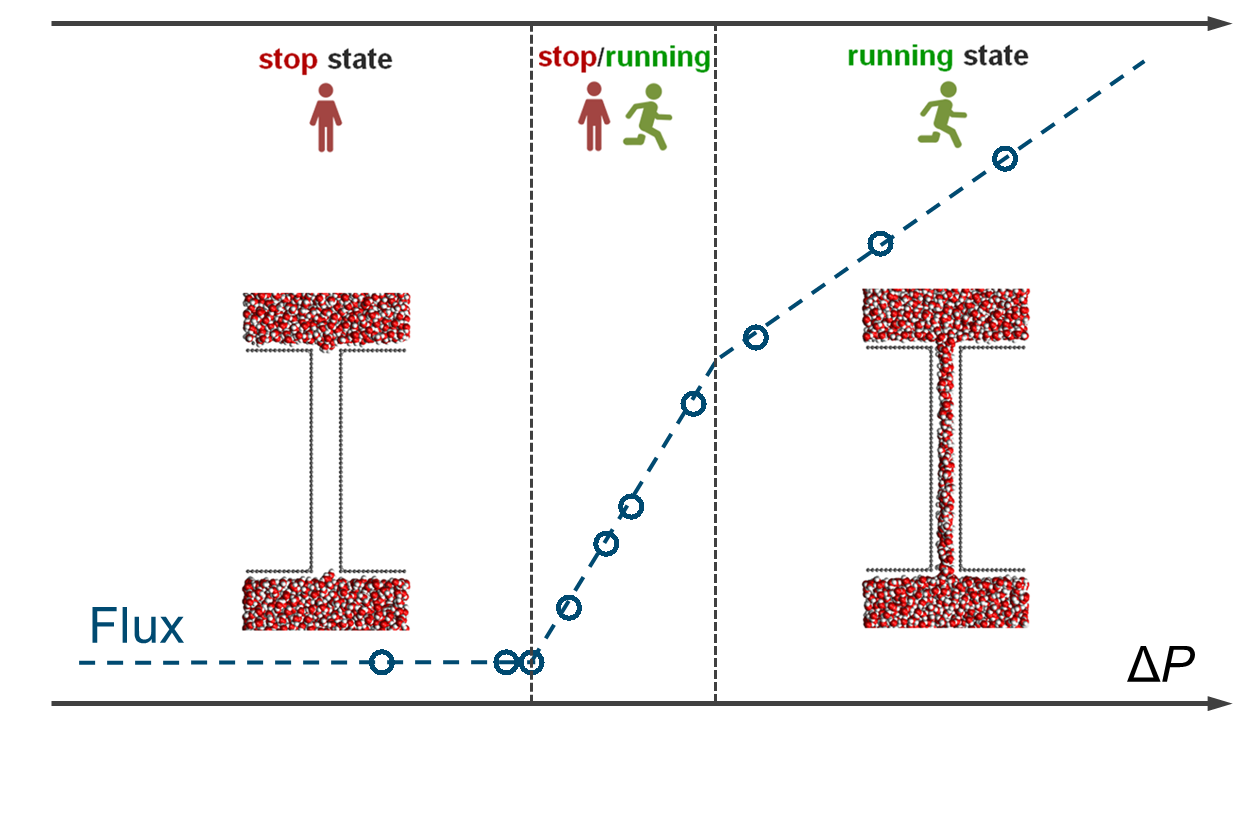
Tailoring TiO2 Membranes for Nanofiltration and Tight Ultrafiltration by Leveraging Molecular Layer Deposition and Crystallization
Shanshan Wu, Zhaogen Wang, Sen Xiong, Yong Wang*, J. Membr. Sci. 2019, 578, 149-155
As an advanced gas phase deposition technique, molecular layer deposition (MLD) has recently emerged as a precisely controllable method to fabricate organic-inorganic hybrid materials such as metalcones and hybrid films. Porous structures can be prepared by thermally removing the organic constituents of the metalcones deposited by MLD. Herein, we revealed that there is a crystallization-induced volume shrinkage during thermal treatment of metalcone films. By taking advantage of both the chemical degradation of organic moieties of metalcone films and the crystallization-induced volume shrinkage, we built microporous TiO2 layers on porous ceramic substrates and obtained nanofiltration and tight ultrafiltration membranes with tunable molecular-weight-cut-off (MWCO) in the range between 630 Da and 3050 Da. Firstly, 50 MLD cycles of titanicone (TiEG) were deposited on the near-surface of plate ceramic ultrafiltration membranes to achieve a compact layer, which was then subjected to calcination at different temperatures to remove the organic constituents. The bare membrane with a water permeance of ∼130 L m−2 h−1 bar−1 and MWCO of ∼63 kDa was upgraded from ultrafiltration to nanofiltration with ∼7 L m−2 h−1 bar−1 permeance and ∼630 Da MWCO after MLD and calcination at 250 °C. Moreover, as the microporous TiO2 was transformed from amorphous to crystalline with rising calcination temperatures, there was higher volume shrinkage and larger effective pore sizes. Consequently, both water permeance and MWCOs of the membranes were increased. For instance, the membranes after calcination at 400 °C showed a tight ultrafiltration performance of ∼30 L m−2 h−1 bar−1 permeance and ∼3050 Da MWCO. This work provides a simple and effective way to fabricate ceramic membranes with tunable performances between ultrafiltration, tight ultrafiltration, and nanofiltration.
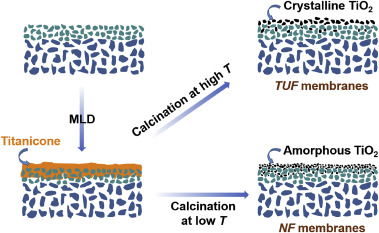
Nanoporous Block Copolymer Membranes Immobilized with Gold Nanoparticles for Continuous Flow Catalysis
Jiemei Zhou, Chenxu Zhang, Yong Wang*, Polym. Chem. 2019, 10, 1642-1649
Nanoporous polymers with functionalizable surfaces are desired in the preparation of reactors for continuous flow catalysis. Here a facile approach for the fabrication of flow reactors is developed by immobilizing Au nanoparticles (AuNPs) to nanoporous membranes derived from block copolymers (BCPs). We synthesized BCP of poly(2-dimethylaminoethyl methacrylate) and polystyrene (PDMAEMA-b-PS) where the PDMAEMA minority blocks contain tertiary amine groups so as to anchor the Au precursors. Simply soaking the BCP in hot ethanol generated interconnected nanopores with PDMAEMA chains enriched on pore walls following the mechanism of selective swelling induced pore generation. The nanoporous BCP membranes were used as supports to immobilize AuNPs via in situ reduction of Au precursors, producing catalytic reactors with the amount of AuNPs conveniently tunable by changing the concentration of Au precursors. The nanoporous BCPs provided tortuous channels to host more AuNPs and to increase the contacting chance between reactants and AuNPs in flow reactions. Thus-produced AuNP-anchored BCP membranes were used as flow reactors to catalytically transform nitrophenol to aminophenol and a catalytic efficiency up to 100% was reached. We also demonstrated that the membranes were highly efficient in catalytic degradation of organic dyes.
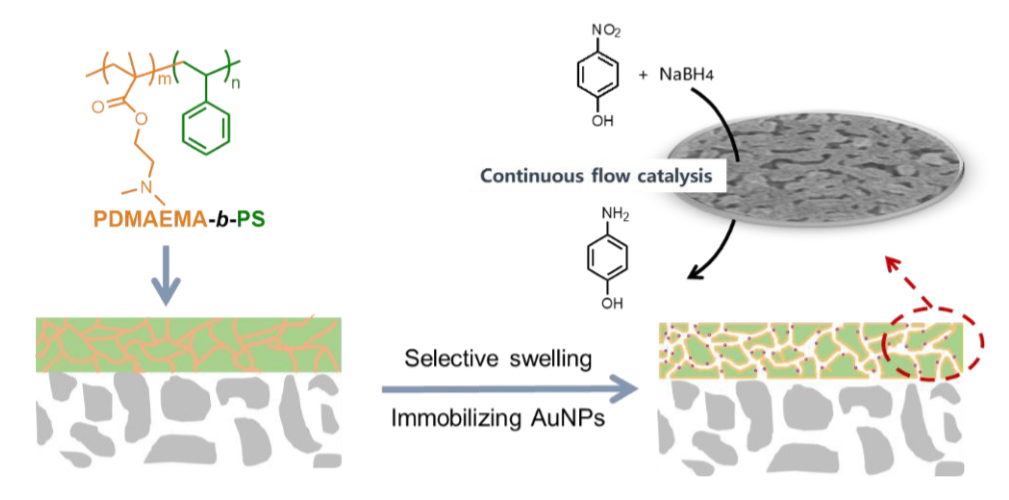
Two-Dimensional Superstructures Filled into Polysulfone Membranes for Highly Improved Ultrafiltration: The Case of Cuprous Iodide Nanosheets
Jian Zhou, Dan Sun, Lei Wang, Leiming Guo, Wei Chen, Fengjiao Yu, Yong Wang*, Yang Yang*, J. Membr. Sci. 2019, 576, 142-149
Mixed-matrix membranes blended with nanosized inorganic fillers have been widely used in ultrafiltration(UF) for large molecule separation. In this work, we provide a feasible route to construct mixed-matrix polysulfone (PSf) UF membranes via the nonsolvent-induced phase inversion process, utilizing sheet-like copper iodide superstructures (s-CuI) as fillers. The size of s-CuI in lateral dimension reaches micrometer scale, but the nanosheets can be well embedded in the polymer matrix with their 2D basal planes parallel to the membrane surface. On account of the stacking straight-through channel structure of s-CuI and its large dimension spanning across multiple membrane pores within the layer, the PSf membrane blended with 0.8 wt% content of s-CuI displays optimal UF performance with a pure water permeation (PWP) of 1473 L/(m2 h bar) and a bovine serum albumin (BSA) rejection of 92%. In contrast, the pure PSf membrane only presents a PWP of 556 L/(m2 h bar) and a BSA rejection of 58.2%. Besides, the enhancement of mechanical stability for the PSf/s-CuI 0.8% membrane is significant and the leakage of the s-CuI filler is negligible. Though the antifouling performance of the PSf/s-CuI 0.8% membrane against the protein BSA is limited, its flux is always 2–3 times higher than that of the pure PSf membrane in each step during a sequential test of fouling behavior. This study indicates that it is highly promising to employ designable superstructures as functional fillers to construct novel mixed-matrix membranes with good interfacial compatibility and superior performance.
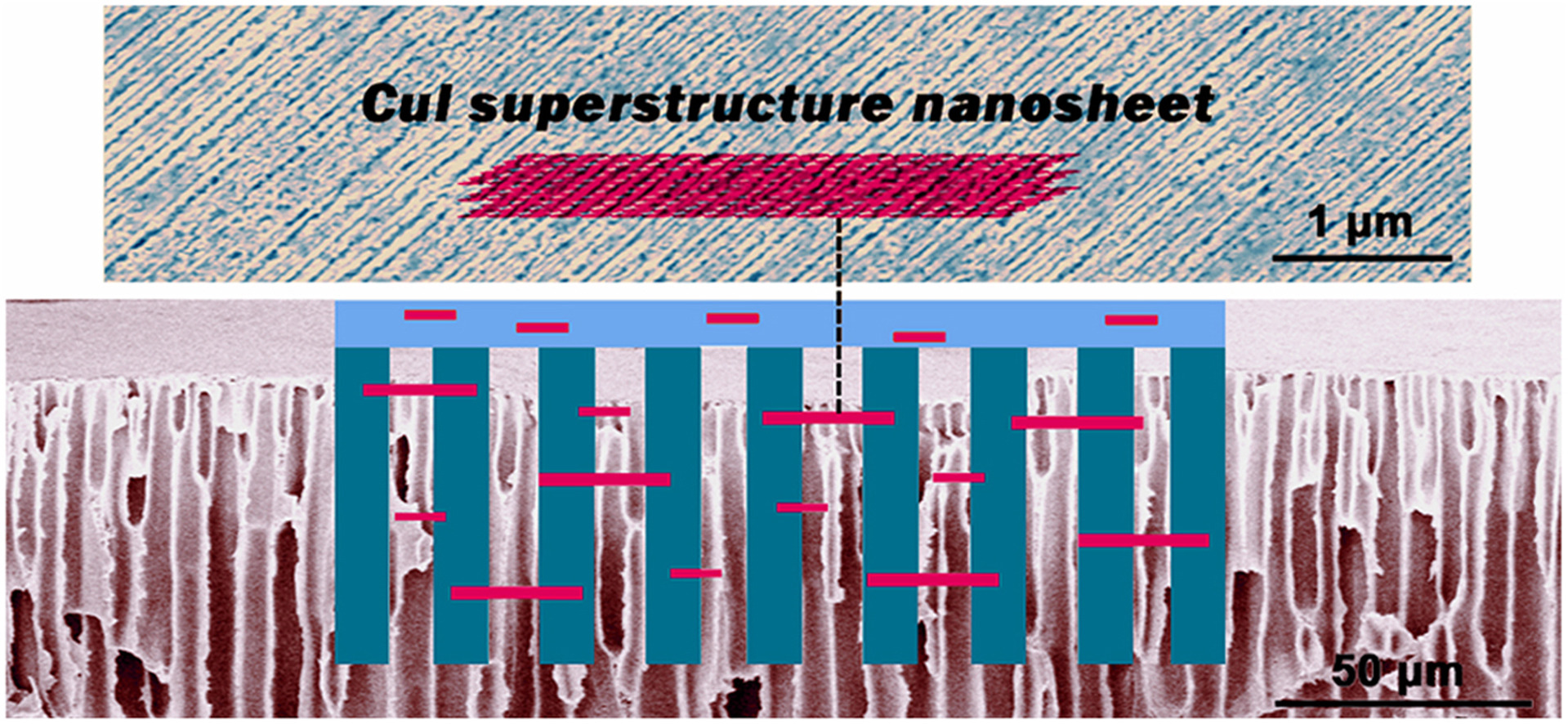
Growing Covalent Organic Frameworks on Porous Substrates for Molecule-Sieving Membranes with Pores Tunable from Ultra- to Nanofiltration
Xiansong Shi, Ankang Xiao, Chenxu Zhang, Yong Wang*, J. Membr. Sci. 2019, 576, 116-122
Crystalline imine-based covalent organic frameworks (COFs) have attracted great interest as next-generation water treatment materials owning to their numerous merits. The construction of COF layers with tunable pore sizes ranging from meso- to micropores, which can significantly broaden the membrane selectivity from ultra- (UF) to nanofiltration (NF), has remained unexplored. Herein, we demonstrate the controllable solvothermal synthesis of COF layers with adjustable pore sizes on anodic aluminum oxide (AAO) substrates. With rising synthesis duration the modulation on pore sizes of AAO supports can be achieved till the formation of continuous COF layers, leading to a gradually enhanced selectivity. Importantly, the synthesized microporous COFs shrink the pore sizes of AAO substrates and provide additional nanochannels for water transporting, eventuating in a ~2–9 times higher permeance than other reported UF membranes with comparable rejections. Once forming continuous COF layers, more rigid selectivities based on COF inherent nanochannels (~1.83 nm) can be realized with capacities of removing dyes from water or organic solvent. This work provides a facile methodology to construct COF-based membranes with broadly tunable separation performance, recommending the membranes for removing targeted molecules including proteins, nanoparticles, and dyes.

Gradient Nanoporous Phenolics Filled in Macroporous Substrates for Highly Permeable Ultrafiltration
Qianqian Lan, Yazhi Yang, Leiming Guo, Yong Wang*, J. Membr. Sci. 2019, 576, 123-130
Highly permeable and cost-affordable membranes are highly desired in separation processes. Herein, such membranes are produced by designing gradient phenolics inside the macropores of polyvinylidene fluoride (PVDF) substrates. Solutions consisting of resol, poly(ethylene oxide)/poly(propylene oxide) copolymer and ZnCl2 are infiltrated into the macropores of PVDF. Phenolic nanoparticles and nanopores with increasing sizes are formed across the membrane thickness after fast solvent evaporation, ZnCl2-facilited resol polymerization and acid soaking. The prepared gradient phenolic@PVDF membranes exhibit a permeance up to 1315 L/(m2·h·bar), which is several times higher than that of other membranes with similar rejections to bovine serum albumin (91%) and lysozyme (71%). Moreover, the membranes are robust enough to withstand a pressure of at least 12.0 bar due to the interlaced structures of phenolics and PVDF. We demonstrate that thus-produced membranes can efficiently separate and concentrate gold nanoparticles with sizes down to 5 nm. This work suggests a new strategy for rational design of gradient porosities in macroporous substrates to produce robust membranes with high permeances and tight rejections.
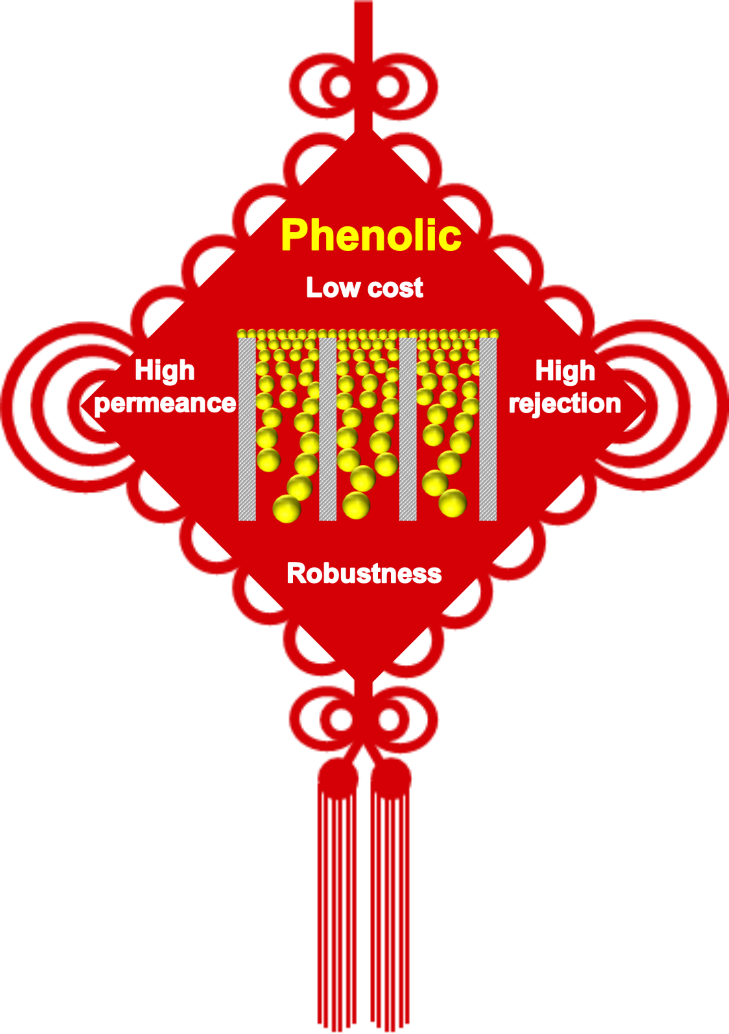
Synthesis of Poly(2-dimethylaminoethyl Methacrylate)-block-Poly(styrene-alt-N-phenylmaleimide) and its Thermo-Tolerant Nanoporous Films Prepared by Selective Swelling
Jiemei Zhou, Chenxu Zhang, Cailong Shen, Yong Wang*, Polymer 2019, 164, 126-133
Block copolymers (BCPs) are interesting precursors to nanoporous films with well-defined and tunable porosities. So far, BCPs with polystyrene (PS) as the majority block are predominantly used, hindering the using of produced nanoporous films at elevated temperatures. Herein, we propose to use BCPs with poly (styrene-alt-Nphenylmaleimide) (P(S-alt-NMI)) asthe majority blockto developthermallystable nanoporous films considering that this alternative copolymer has a much higher glass transition temperature than PS. We synthesized BCPs of poly (2-dimethylaminoethyl methacrylate) (PDMAEMA) and P(S-alt-NMI) (PDMAEMA-b-P(S-alt-NMI)) with four different block ratios by reversible addition-fragmentation chain transfer (RAFT) polymerization. The swelling behaviors of these BCPs in various solvents were investigated, and we found that nanoporosities will be generated in the BCP films following the mechanism of selective swelling induced pore generation when single solvents or solvent pairs having strong affinity to PDMAEMA and moderate affinity to P(S-alt-NMI) were used as the swelling agents. The pore sizes and porosities of thus-produced nanoporous films can be flexibly tuned by changing the compositions of the BCPs and the swelling conditions. Because of the excellent thermal stability of P(S-alt-NMI) blocks the nanoporous BCP films exhibited excellent thermal tolerance and they maintained intact at a temperature as high as 158°C while the PS-based BCPs started to deform at the temperature of 75°C. This thermal tolerance is very much desired in many applications, for example, high-temperature disinfection for medical purposes.

Atomic Layer Deposition of TiO2 on Carbon-Nanotube Membranes for Enhanced Capacitive Deionization
Jianhua Feng, Sen Xiong, Yong Wang*, Sep. Purif. Technol. 2019, 213, 70-77
Capacitive deionization (CDI) is an energy-efficient and environment-benign process to produce fresh water. Carbon nanotubes (CNTs) are promising building blocks in constructing high-performance CDI electrodes. Nevertheless, the strong hydrophobicity of CNTs significantly impedes their applications in aqueous environment. Herein, hydrophilic CNT-based membrane electrodes are obtained via atomic layer deposition (ALD). We demonstrate, for the first time, that ALD is an efficient and flexible means of enhancing the CDI performance of free-standing CNT membrane electrodes by depositing TiO2 nanoparticles on the surface of CNTs. The CNT membranes display preferable electrosorption behavior after moderate ALD cycle numbers and stable reusability in the desalination process.
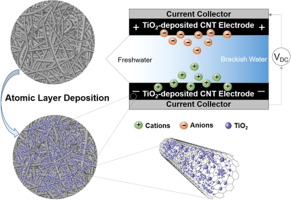
Design of Gradient Nanopores in Phenolics for Ultrafast Water Permeation
Leiming Guo, Yazhi Yang, Fang Xu, Qianqian Lan, Mingjie Wei, Yong Wang*, Chem. Sci. 2019, 10, 2093-2100
Membrane technology is playing a pivotal role in providing potable water to our thirsty planet. However, it remains strongly demanding for highly permeable and durable membranes with affordable costs. Such membranes are synthesized herein by designing gradient nanopores in low-cost phenolics. The gradient nanopores are achieved by spontaneous assembly of phenolic nanoparticles with gradually enlarged sizes. These particles nucleate and grow as a result of ZnCl2-accelerated thermopolymerization of resol in the progressive downward gelating polymer. Subsequent removal of the gelated polymer and ZnCl2 exposes the gradient nanopore. The gradient nanopores renders the phenolic structures unprecedented permselectivity when used in membrane separations, totally rejecting fine particulates down to 5 nm dispersed in water or aggressive solvents while allowing water to permeate up to two orders of magnitude faster than other membranes with similar rejections. Our work opens up an avenue for the rational design and affordable synthesis of ultrafast membranes.
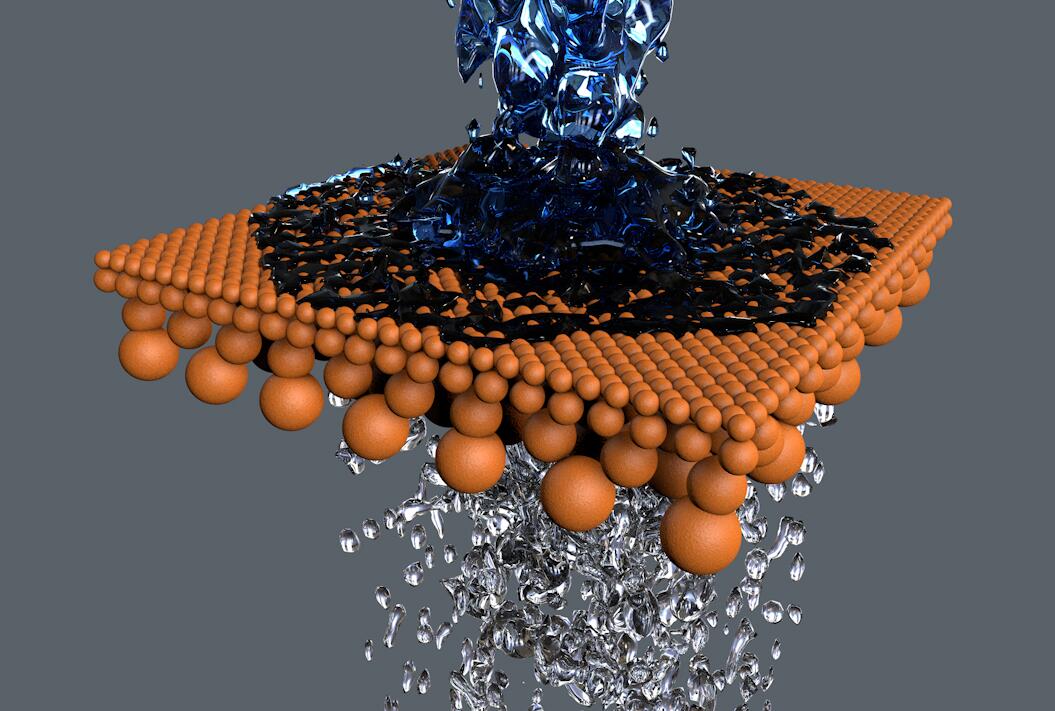
Atomic Layer Deposition of Hybrid Metal Oxides on Carbon Nanotube Membranes for Photodegradation of Dyes
Jianhua Feng, Sen Xiong*, Yong Wang*, Compos. Commun. 2019, 12, 39-46
Synthetic dye pollution is a worldwide problem and quick remedies are urgently needed. Photocatalysis is a promising method to solve this problem and carbon nanotubes (CNTs) are promising components in producing high-performance composite photocatalysts. Nevertheless, the strong hydrophobicity dramatically impedes its application in aqueous environments. In this study, hydrophilic CNT-hybrid metal oxides (ZnO and TiO2) membranes were prepared by atomic layer deposition (ALD). We demonstrate that ALD is an efficient and flexible method to enhance the photocatalytic activity of CNT-based membranes, especially the membranes used in wastewater treatments. The hybrid hexagonal wurtzite ZnO and anatase TiO2 on CNTs after calcination could effectively enhance electron transfer and reduce photo-generated electron-holes recombination. The membranes exhibit preferable photocatalytic activity and stable reusability in dye degradation. This strategy of “ALD on CNTs” is expected to create other CNT-based membranes with additional functionalities and has bright prospect for wastewater treatments.

2018
耐压型聚砜两亲嵌段共聚物超滤膜的制备与表征
陈威,王召根*,汪勇*,膜科学与技术 2018,38,27-33
聚砜类分离膜广泛应用于超滤过程并作为支撑层用于纳滤膜及反渗透膜的制备,然而由于材料自身的疏水性较强,聚砜膜通常要经过亲水化改性来提升渗透和抗污染性能。以两亲嵌段共聚物聚砜-b-聚乙二醇(PSF-b-PEG)为原料,通过相转化方法可无需后期改性制备具有指状孔结构的自发永久亲水性超滤膜,但指状孔的存在使其耐压性能受到限制,难以用作为纳滤或反渗透膜的支撑层。本文采用PSF-b-PEG为制膜材料,通过调节固含量与非溶剂诱导相分离过程中的溶剂/非溶剂体系,将超滤膜断面的指状孔转变为更为耐压的海绵状孔,同时在膜内保留亲水链段以保证膜的渗透及抗污染性能。研究结果表明,当以N,N-二甲基甲酰胺(DMF)为溶剂,去离子水为凝固浴时,可直接制备出具有海绵状孔结构的PSF-b-PEG超滤膜。在25%的固含量下,膜的纯水渗透性为160 L·m-2·h-1·bar-1,对牛血清白蛋白(BSA)截留率达到90%。压密测试表明,相较于指状孔,海绵状孔超滤膜可完全耐受1 MPa的压力,展示了更优的耐压性能。
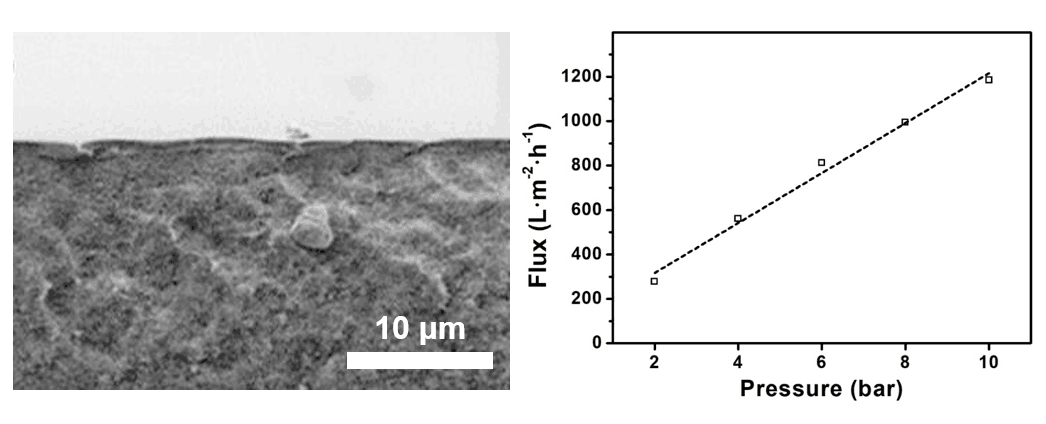
Layer-by-Layer Synthesis of Covalent Organic Frameworks on Porous Substrates for Fast Molecular Separations
Xiansong Shi, Rui Wang, Ankang Xiao, Tianzhi Jia, Shipeng Sun, Yong Wang*, ACS Appl. Nano Mater. 2018, 1, 6320-6326
Covalent organic frameworks (COFs) are expected to provide exceptional permselectivity in molecular separations because of their stable, uniform, molecular-sized pore channels. To realize the superior performances of COF-based membranes, it remains strongly desired for the rapid and controllable growth of COFs on substrates under mild conditions. Herein, we report on the layer-by-layer (LbL) strategy for the rapid synthesis of imine-linked COFs on porous polymeric substrates in ethanol at room temperature. This strategy exploits the alternative availability of each COF monomer to endow a self-limiting nature to the reaction, thus resulting in conformal growth of COFs along the pore wall of the substrate. The grown COFs with thicknesses tunable by LbL cycles reduce the effective pore sizes, while the inherent ∼2 nm channels in COFs allow additional water to permeate. Thus-produced membranes exhibit significantly enhanced selectivity (>99% rejection to dyes) and unprecedentedly high water permeances, which are ∼3− 20 times higher than other membranes with similar rejections. This work potentially presents a new and general methodology to prepare imine-based COF membranes for molecular separations.
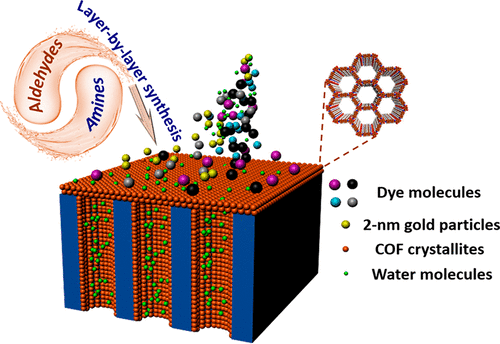
Highly Permeable Membranes Enabled by Film Formation of Block Copolymers on Water Surface
Nina Yan, Zhaogen Wang*, Yong Wang*, J. Membr. Sci. 2018, 568, 40-46
Separation membranes derived from block copolymers (BCPs) have attracted significant interest due to their well-defined pores and functional surfaces. However, it still remains a challenge to prepare ultrathin BCP composite membranes in an efficient way. Here we report a facile approach for the fabrication of ultrathin BCP composite membranes by forming thin films on water surface. The BCP layer as thin as ~ 17 nm can be prepared by spreading polystyrene-block-poly(2-vinyl pyridine) (PS-b-P2VP) solutions on water surface followed by controlled evaporation. The thin layer can be readily collected and composited with macroporous supports. A thickness of ~ 260 nm of the BCP layer is necessary to guarantee the integrity. Interconnected nanoporous structures are then obtained in the BCP layer by the process of selective swelling induced pore generation. On account of the ultrathin separation layer, the composite membranes exhibit excellent permselectivity, better than many other ultrafiltration membranes. Moreover, the separation performances can be facilely regulated by tuning the swelling durations. This method is featured as cost-effective and convenient, and is expected to provide a higher chance for the production of BCP membranes at large scale.
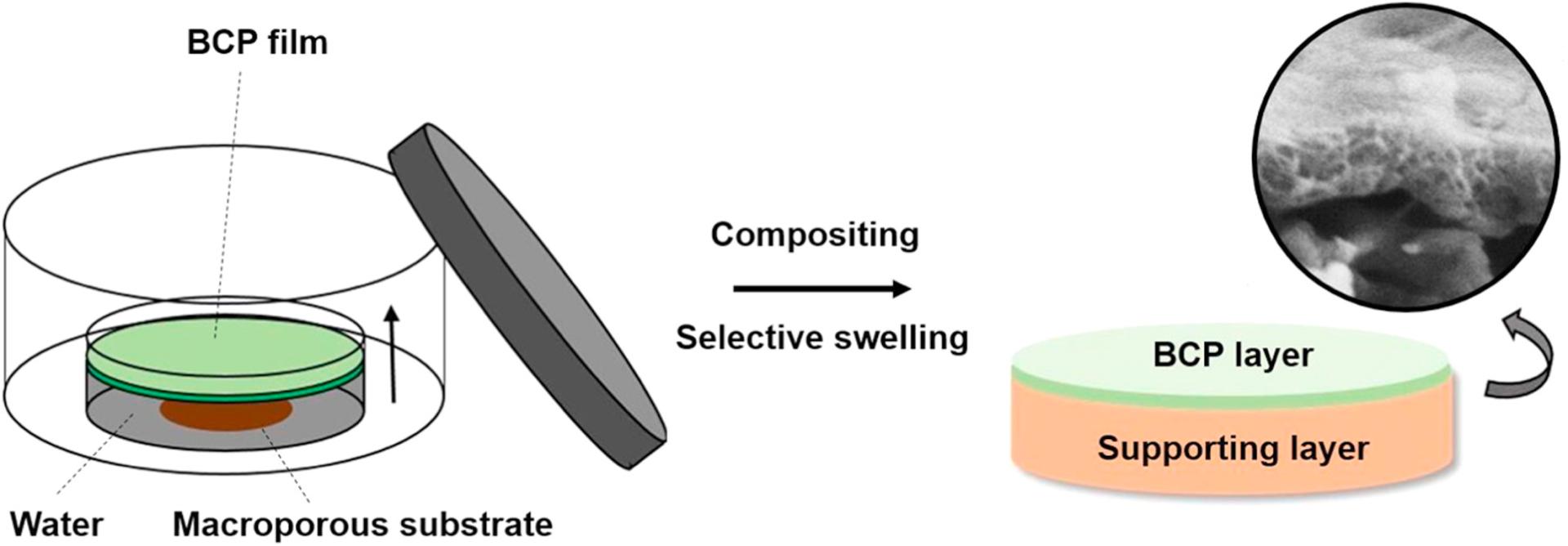
Retarded Evaporation-Induced Synthesis of Lamellar Block Copolymer Supramolecules for Solvatochromic Sensing
Leiming Guo, Yong Wang*, Sens. Actuators B: Chem. 2018, 277, 172-178
The responses of conventional solvatochromic sensors to stimuli are usually performed by generating changes in absorption and emission bands based on the polarity of solvents. However, there still remains a high risk of the overlapped bands for the solvents with similar polarities, resulting in a tough realization of the visual colorimetric differentiation. Here, we develop an innovative solvatochromic sensor in the form of film by self-assembly of block copolymer supramolecules. The produced sensor consists of alternating layers of two phases, in which one is polystyrene (PS) and the other is the combination of poly (4-vinyl pyridine) (P4 V P) and polydiacetylene (PDA). Owing to the fact that PDA is embedded into P4 V P, the inherent protection of PDA by block copolymers is thus guaranteed in such lamellar structures. The specific organic solvents with a strong affinity to PS could merely penetrate into the supramolecular lamellae followed by interacting with thus-exposed PDA, leading to the realization of solvatochromism. By incorporating the heating-induced blue-to-red color transition (thermochromism) with solvatochromism of the sensor, a straightforward technique to realize the nonvisualization of an imprint followed by its revisualization is developed.
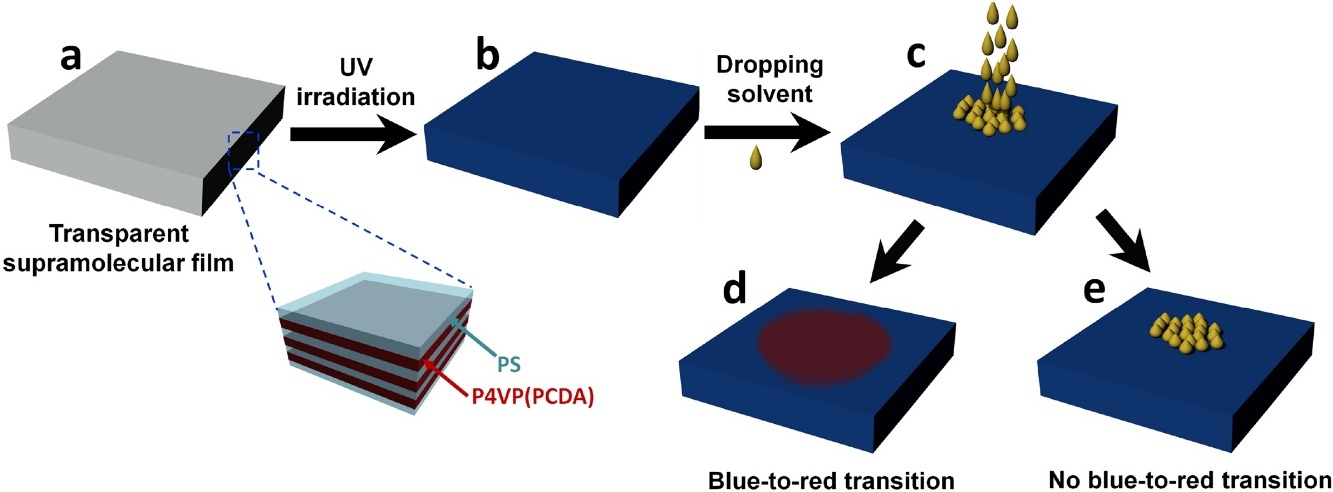
Interfacial Polymerization of Covalent Organic Frameworks (COFs) on Polymeric Substrates for Molecular Separations
Rui Wang, Xiansong Shi, Ankang Xiao, Wei Zhou, Yong Wang*, J. Membr. Sci. 2018, 566, 197-204
Covalent organic frameworks (COFs) represent a new family of porous polymers with highly ordered two or three-dimensional channels. Although numerous studies have been focused on the design and synthesis of COF in the form of powders, the development of COF-based separation membranes is still hampered by the challenges of COF particles agglomeration and harsh synthetic conditions. In this work, interfacial polymerization (IP) directly performed on polymeric substrates as employed in the traditional IP process of polyamide (PA) membranes is developed for the synthesis of COF-based membranes. With the moderate reaction rate between monomer pairs in corresponding aqueous and organic solutions, a conformal growth of COF crystallites directly composited with the polysulfone (PSF) ultrafiltration substrates can be realized within 1 min. The synthesis parameters including reaction time and precursor concentrations are optimized, and thus-synthesized COF/PSF membrane presents a stable rejection to dye (Congo red) of 99.5% with a high water permeance of up to 50 L·m−2·h−1·bar−1, which is 2–10 times higher than that of many other membranes with similar rejection. This convenient IP process is expected to facilitate the up-scaling and real-world applications of COF-based membranes.
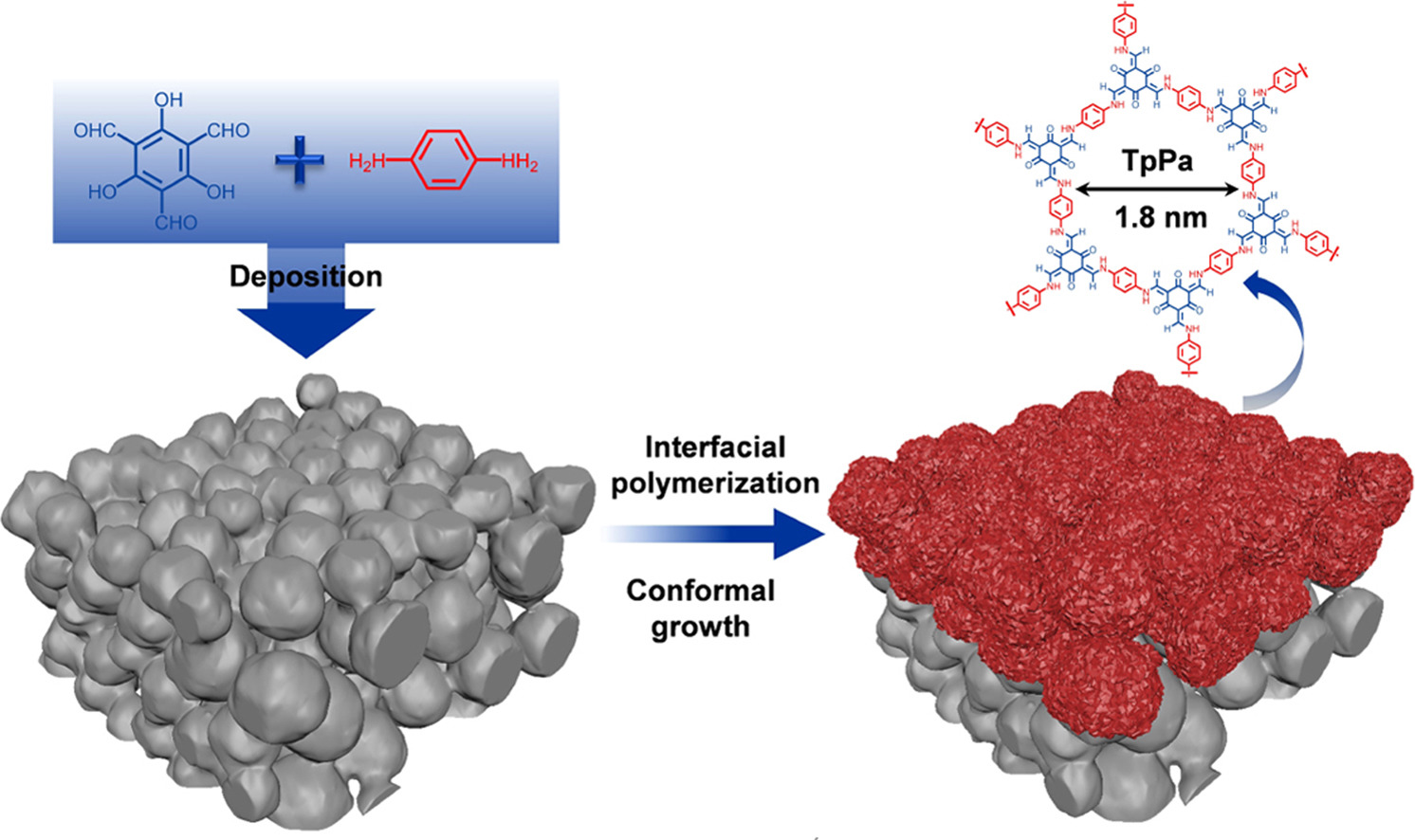
Perpendicular Alignment and Selective Swelling-Induced Generation of Homopores of Polystyrene-b-Poly(2-vinylpyridine)-b-Poly(ethylene Oxide) Triblock Terpolymer
Leiming Guo, Zhaogen Wang, Yong Wang*, Macromolecules 2018, 51, 6248-6256
Arrays of perpendicularly ordered nanopores with pore walls decorated by two or more functional polymer chains are of great importance in various applications. However, such porous structures have been rarely reported so far. Herein, lamellar-forming triblock terpolymer of polystyrene-b-poly(2-vinylpyridine)-b-poly(ethylene oxide) (PS-b-P2VP-b-PEO) is blended with PS homopolymers to fabricate a PS matrix embedded with perpendicular PEO@P2VP cylinders via solvent annealing. By further adjusting the annealing humidity and temperature, the perpendicular PEO@P2VP cylinders are capable of running through the entire films. The hydrophilic PEO@P2VP domains could be converted into cylindrical homopores by ethanol swelling, where the functional P2VP and PEO chains are distributed on the pore walls. Moreover, water is able to swell PEO and also produces homopores in such films. The pore sizes of the films are readily tuned in a relatively large range depending on the swelling temperatures and durations. The developed ordered nanostructures are expected to find important applications in the range from template synthesis to membrane separation and to nanofluidics.
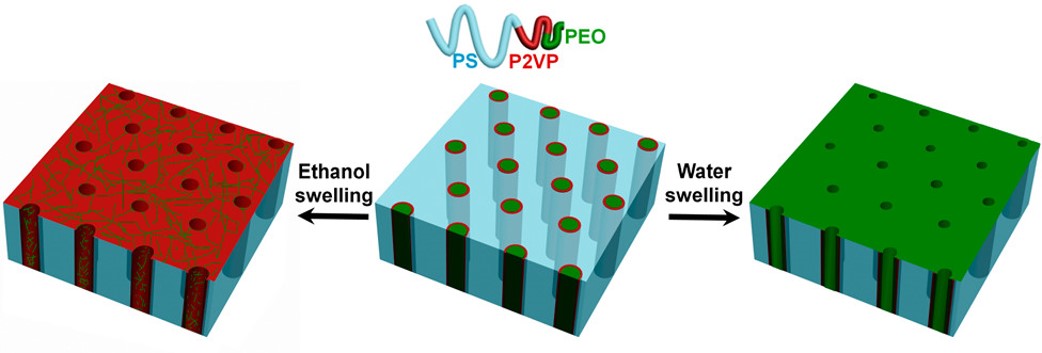
Water Flow through Interlayer Channels of 2D Materials with Various Hydrophilicities
Fang Xu, Yang Song, Mingjie Wei*, Yong Wang*, J. Phys. Chem. C 2018, 122, 15772-15779
Water transport through laminated membranes composed of two-dimensional (2D) materials has gained considerable attention because of their great potential in filtration and separation applications. However, water transport between interlayers formed by 2D materials cannot be comprehensively described by traditional transport theory because different 2D materials have varying hydrophilicity, which strongly affects water transport. Herein, we build interlayer channels formed by 2D sheets with various hydrophilicities and investigate the pressure-driven water transport via nonequilibrium molecular dynamics simulations. The influence of channel hydrophilicity on water transport is dominant, especially at the nanoscale. To model the water transport phenomena through channels with various hydrophilicities, we define a new slip length to derive the appropriate equation. By two methods of calculating the slip length based on the simulation results, we validate our derived equation, which predicts the water flux in interlayer channels with a large range of hydrophilicities from relatively hydrophobic (large slip lengths) to extremely hydrophilic (negative slip lengths). This work deepens the understanding of water transport through interlayer channels and assists in the design of 2D-material membranes for water treatment.
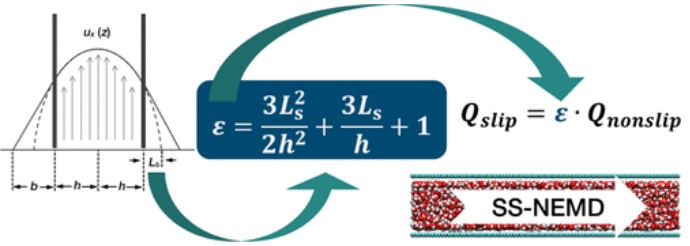
Resistance of Water Transport in Carbon Nanotube Membranes
Xin Zhang, Wei Zhou, Fang Xu, Mingjie Wei*, Yong Wang*, Nanoscale 2018, 10, 13242-13249
Carbon nanotube (CNT) membranes have long been considered as the next-generation membranes due to superfast water transport inside the tubes. However, large pressure loss occurs at the pore mouth and consequently water transport through the whole tubes is significantly retarded. To find out the reason behind, we conduct systematic non-equilibrium molecular dynamics (NEMD) simulations on water transport through CNT membranes with various tube diameters and lengths. The whole transport resistance is contributed by the interfacial and interior part, and the interfacial contribution is playing the dominating role for short tubes and only can be ignored when the tube length reaches the scale of several micrometers. Regard to the origin of the interfacial resistance, the hydrogen bonding rearrangement (HBR) effect accounts for at least 45%, and the rest is attributed to the geometrical or steric crowding of water molecules near the pore mouth. To reduce the dominant interfacial resistance, we change the shape of pore mouth from plate to hourglass by mimicing the aquaporin water channels. The interfacial resistance is thus decreased by > 27%. It is also found that the reduction is originated from the optimized HBR rather than the subdued steric crowding of water molecules near the pore mouth.
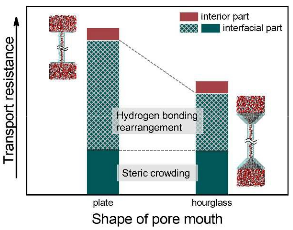
Selective Swelling of Block Copolymer Ultrafiltration Membranes for Enhanced Water Permeability and Fouling Resistance
Dinglei Zhong, Zhaogen Wang, Qianqian Lan, Yong Wang*, J. Membr. Sci. 2018, 558, 106-112
High permeability is one of the most important pursuits of separation membranes. In this work, high-performance ultrafiltration membranes are prepared by synergetically coupling nonsolvent-induced phase separation (NIPS) and selective swelling of a block copolymer, polysulfone-block-poly (ethylene glycol) (PSF-b-PEG). NIPS is used to prepare PSF-b-PEG membranes with a thin skin layer and a fingerlike sublayer. Subsequent selective swelling generates mesopores in the skin layer and enriches PEG blocks on the surface. Compared to the membranes without swelling, the swelling-treated membranes exhibit simultaneously upgraded permeability, hydrophilicity, and fouling resistance. For instance, the permeability of the membrane swollen in 50% acetic acid at 65 °C for 1 h is doubled compared to the pristine one while the rejection is only modestly reduced. Fouling resistance of the swelling-treated membranes was also improved, which was ascribed to the enrichment of PEG on the membrane surface. We demonstrate that the performances of the membranes can be tuned in a relatively wide range by tailoring the swelling conditions, such as swelling reagents, durations and temperatures. Because of the extreme simplicity and high efficiency, this selective swelling strategy is expected to be applicable in tuning the surface properties and improving performances of many other membranes.
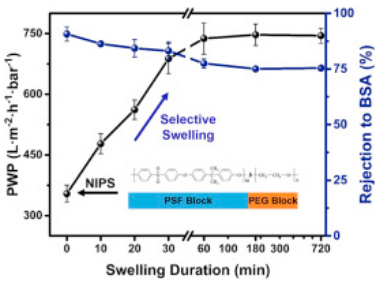
Mesoporous Phenolics Filled in Macroporous Membranes for Tunable Tight-Ultrafiltration
Qianqian Lan, Zhaogen Wang, Yong Wang*, Chem. Eng. Sci. 2018, 187, 98-106
Separation of colloidal nanoparticulates requires tight ultrafiltration (TUF) membranes. Phenolic polymers with well-defined sub-10 nm mesopores are promising candidates for such membranes, but suffer from intrinsic fragility. Herein, robust mesoporous phenolic membranes with flexibly adjustable TUF functions are realized through a new pore-filling strategy. Phenolic prepolymers with tunable fluidity are spontaneously filled into macroporous substrates with precisely controllable filling depths. Subsequent thermopolymerization fully cures the prepolymer and acid soaking removes the templating pluronic copolymers, producing composite TUF membranes with mesoporous phenolics embedded in flexible substrates. The membranes exhibit widely adjustable molecular-weight-cut-offs (MWCOs) (2.6 to 41 kg/mol) depending on the filling depth of phenolics while maintain otherwise unattainable high permeabilities. We further investigate the separation of CdTe and carbon quantum dots dispersed in water and toluene by these membranes, and they show excellent concentration and fractionation effect. This work enables efficient separation of ultra-small colloids by robust TUF membranes.

(Cover) Polymeric Nanospheres with Tunable Sizes, Water Dispersibility and Thermostability from Heating-Enabled Micellization of Polysulfone-block-Polyethylene Glycol
Zexian Zhang, Jie Li, Zhaogen Wang, Changcheng He*, Yong Wang*, J. Polym. Sci. B: Polym. Phys. 2018, 56, 769-777
Polymeric nanospheres with uniform sizes, functional surfaces, and high mechanical strength and thermostability are attracting wide interest in different applications. Here, a new kind of polysulfone micellar spheres with PEGylated surfaces is prepared via directly heating the solution of an amphiphilic block copolymer, polysulfone-b-polyethylene glycol (PSF-b-PEG). The sizes of the micelles are uniform and tunable between ∼42 and ∼443 nm. TEM characterizations show that the micelles are core-shell structures with PEG as the corona and PSF as the core. PEG endows the micelles with dispersibility in water and good biocompatibility, while PSF provides the mechanical strength and thermostability. The effects of PEG contents, polymer solution concentrations, solvent types, and heating temperatures are systematically investigated. Furthermore, heat resistance tests show that the micelles are stable at 150–180 °C. These PSF-b-PEG micellar spheres are expected to be applied in demanding environmental conditions such as heating involved surface modification process.
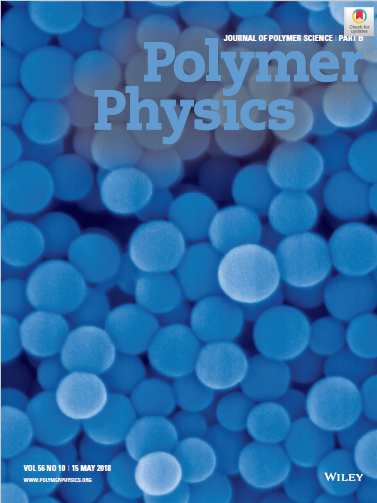
Selective Swelling of Electrospun Block Copolymers: From Perforated Nanofibers to High Flux and Responsive Ultrafiltration Membranes
Xiansong Shi, Zhi Xu, Chaobo Huang, Yong Wang*, Zhanfeng Cui, Macromolecules 2018, 51, 2283-2292
This work is devoted to the development of high-flux ultrafiltration membranes using electrospun nanofibers of amphiphilic block copolymers (BCPs) of polystyrene-block-poly(2-vinylpyridine) (PS-b-P2VP) as building blocks. When soaked in hot ethanol, the solid as-spun BCP fibers are progressively transformed into three-dimensionally perforated fibers with increasing porosities with rising degrees of swelling, which ended up with the equilibrated morphology of spherical micelles. The BCP nanofibers are collected on macroporous substrates and subjected to heating to convert loosely stacked fibers to dense and continuous films. Subsequent swelling in hot ethanol leads to robust composite membranes with nanoporous BCP selective layers tightly adhered to the substrates. Filtration performances of the composite membranes can be conveniently modulated by electrospinning durations. The water permeabilities are as high as 6100 L m–2 h–1 bar–1, which is ∼10–35 times higher than that of commercial membranes with similar rejections. Moreover, with the surface enrichment of P2VP chains the membranes exhibit a strikingly sharp pH-dependent water permeability switchable in the largest amplitude ever reported for multiple cycles. Electrospun fibers can be promising building materials to produce a wide range of membranes with 3D interconnected nanoporosities which also show great potential in separation and biomedical applications.
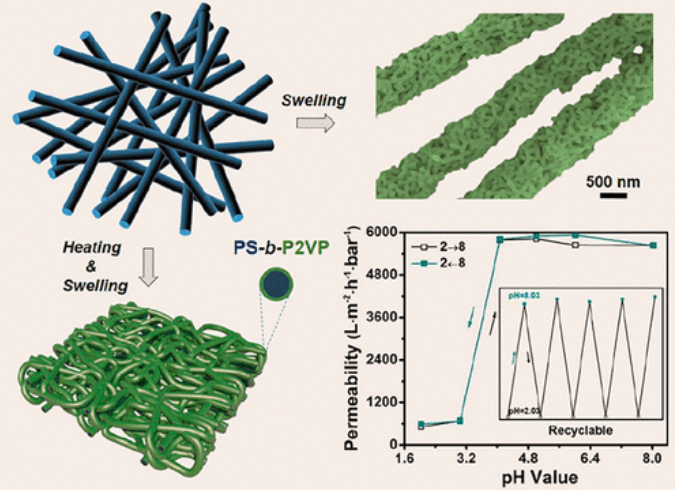
Atomic Layer Deposition Fabricating of Ceramic Nanofiltration Membranes for Efficient Separation of Dyes from Water
He Chen, Shanshan Wu, Xiaojuan Jia, Sen Xiong, Yong Wang*, AIChE J. 2018, 64, 2670-2678
To meet the strong need for highly efficient and controllable manufacturing methods to ceramic nanofiltration (NF) membranes, we use atomic layer deposition (ALD) to prepare NF membranes by tightening ultrafiltration (UF) membranes. We confine the ALD deposition of TiO2 to the near-surface region of substrate UF membranes. The pores (∼ 5 nm) in the selective layers are progressively reduced, thus transforming the original UF membranes to NF ones at acceptable expense of permeability. A molecular-weight-cut-off (MWCO) down to 890 Da is obtained after merely 40 cycles and the water permeability remains as high as 32 L·m−2·h−1·bar−1. MWCOs can be flexibly tuned by altering ALD cycles, which is lowered down to 410 Da with 60 ALD cycles. The deposited membranes are used to remove dyes from water and they show significantly enhanced rejection to negatively charged dyes.
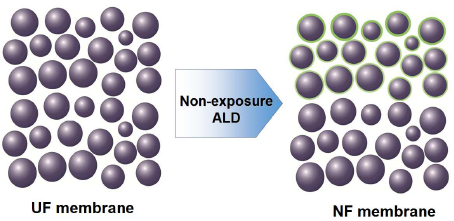
One-Step Synthesis of Carbon-Hybridized ZnO on Polymeric Foams by Atomic Layer Deposition for Efficient Absorption of Oils from Water
Sen Xiong, Yang Yang, Zhaoxiang Zhong, Yong Wang*, Ind. Eng. Chem. Res. 2018, 57, 1269-1276
Reusable absorbents with high absorption capacity, good selectivity, and low cost are highly demanded for efficient removal of oil spills and organic leakages from water. We discover that ZnO produced by atomic layer deposition (ALD) is hybridized with carbon moieties, and consequently exhibits an appreciable hydrophobicity. By taking this advantage, we develop a “dry” process to produce high-performance oil absorbents. Originally amphiphilic polymeric foams are directly turned into strongly hydrophobic oil absorbents simply by ALD of ZnO and exhibit excellent absorption capacity, selectivity and reusability. Such absorption capacities and reusability are better than most foam-based oil absorbents. Surprisingly, we find that ALD-deposited ZnO can reverse the wettability of polymeric foams depending on the foam porosities. This ALD-enabled surface functionalization is expected to find important applications in the synthesis of many other interfacial materials.
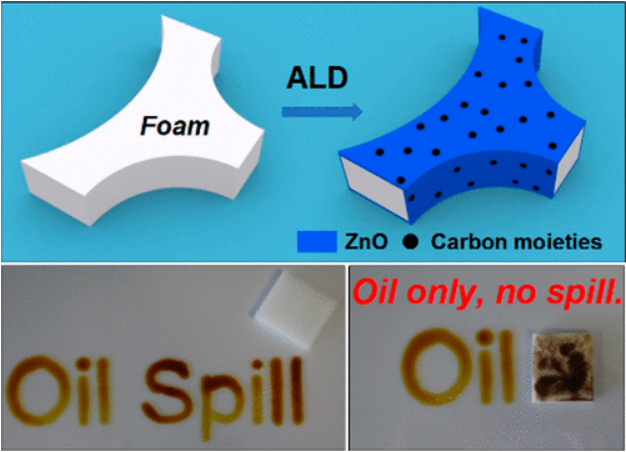
Atomic Layer Deposition of Metal Oxides on Carbon Nanotube Fabrics for Robust, Hydrophilic Ultrafiltration Membranes
Jianhua Feng, Sen Xiong, Zhaogen Wang, Zhaoliang Cui, Shi-Peng Sun, Yong Wang*, J. Membr. Sci. 2018, 550, 246-253
Carbon nanotubes (CNTs) are important building blocks to produce high-performance membranes. However, the strong hydrophobicity significantly hinders their applications in aqueous systems. Herein, we demonstrate, for the first time, that atomic layer deposition (ALD) is an efficient and flexible method to upgrade the permselectivity of CNT-based membranes. We ALD-deposit ZnO on fabrics of multi-walled carbon nanotubes. ZnO grows on the CNT surface as nanoparticulates initially and then forms conformal layers wrapping the CNTs. The originally hydrophobic surface of CNTs is progressively turned to be highly hydrophilic with rising ALD cycles. The deposition of ZnO on CNTs significantly promotes the surface wettability of the CNT membranes on one hand, and endows the membrane an enhanced mechanical stability on the other. The CNT membranes exhibit simultaneously upgraded water permeability and retention in the ultrafiltration category after ALD for moderate cycle numbers. With ever increased ALD cycles, the retention is further improved while the water permeability is decreased due to the competing effect of the increased hydrophilicity and narrowed pores. The strategy of “ALD on CNT substrates” is expected to produce other robust membranes with additional functionalities dependent on the materials to be deposited by ALD.

Atomic Layer Deposition of Al2O3 on Porous Polypropylene Hollow Fibers for Enhanced Membrane Performances
Xiaojuan Jia, Zexian Low, He Chen, Sen Xiong, Yong Wang*, Chinese J. Chem. Eng. 2018, 26, 695-700
Porous polypropylene hollow fiber (PPHF) membranes are widely used in liquid purification. However, the hydrophobicity of polypropylene (PP) has limited its applications in water treatment. Herein, we demonstrate that, for the first time, atomic layer deposition (ALD) is an effective strategy to conveniently upgrade the filtration performances of PPHF membranes. The chemical and morphological changes of the deposited PPHF membranes are characterized by spectral, compositional, microscopic characterizations and protein adsorption measurements. Al2O3 is distributed along the cross section of the PP hollow fibers, with decreasing concentration from the outer surface to the inner surface. The pore size of the outer surface can be easily turned by altering the ALD cycles. Interestingly, the hollow fibers become much more ductile after deposition as their elongation at break is increased more than six times after deposition with 100 cycles. The deposited membranes show simultaneously enhanced water permeance and retention after deposition with moderate ALD cycle numbers. For instance, after 50 ALD cycles a 17% increase in water permeance and one-fold increase in BSA rejection are observed. Moreover, the PP membranes exhibit improved fouling-resistance after ALD deposition.

2017
Nanofriction of Graphene/Ionic Liquid-Infused Block Copolymer Homoporous Membranes
Rong An*, Pengpeng Fan, Nina Yan, Qingmin Ji, Goel Sunkulp, Yong Wang*, Langmuir 2017, 33, 11590-11602
We have infused graphene/ionic liquid into block copolymer homoporous membranes (HOMEs) which have highly ordered uniform cylindrical nanopores to, form compact, dense and continuous Gr/ILs (graphene/ionic liquid) lubricating layers at interfaces, enabling a reduction in the friction coefficient. Raman and XPS analyses, confirmed the parallel alignment of the cation of ILs on graphene by the π-π stacking interaction of the imidazolium ring with the graphene layer. This alignment loosens the lattice spacing of Gr in Gr/ILs, leading to a larger lattice spacing of 0.36 nm in Gr of Gr/ILs hybrids than the pristine Gr (0.33 nm). The loose graphene layers which is caused by the coexistence of graphene and ILs, would make the sliding easier, and favor the lubrication. An increase in the friction coefficient was observed on ILs-infused block copolymer HOMEs, as compared to Gr/ILs-infused ones, due to the absence of Gr and the unstably formed ILs film. Gr/ILs-infused block copolymer HOMEs also exhibit much smaller residual indentation depth and peak indentation depth in comparison with ILs-infused ones. This indicates the existence of stably supported Gr/ILs hybrid liquid films aids the reduction of the friction coefficient by preventing the thinning of the lubricant layer and exposure of the underlying block copolymer HOMEs.
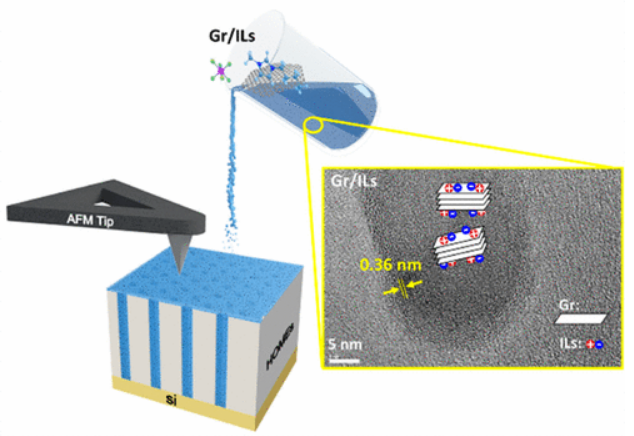
Selective Swelling Blends of Block Copolymers for Nanoporous Membranes with Enhanced Permeability and Robustness
Zhaogen Wang, Rui Liu, Qianqian Lan, Yong Wang*, J. Polym. Sci. B: Polym. Phys. 2017, 55, 1617-1625
Block copolymers (BCPs) are important precursors to produce membranes with well-defined porosities. However, it remains challenging to prepare robust and affordable BCP-based membranes. In this work, cheap commodity styrene-butadiene-styrene (SBS) elastic triblock copolymers are mixed with polystyrene-block-poly (2-vinylpyridine) (SV) block copolymers in solutions, leading to macroscopically stable blend films upon casting because of the compatibilizer effect of PS existing in both copolymers. By soaking the blend films in ethanol, the microdomains of poly(2-vinylpyridine) are selectively swollen and cavitated upon drying, resulting in a hierarchical structure with perforated SV phases interwoven with the SBS phases. The blend membranes with 30% SBS exhibit improved water permeability and mechanical robustness due to the presence of elastic SBS compared to neat SV membranes; meanwhile, the rejections of the blend membranes remain largely unchanged. Moreover, the blend membranes exhibit a pH-responsive function, and homoporous SV regions are obtained by pre-aligning the SV phases.
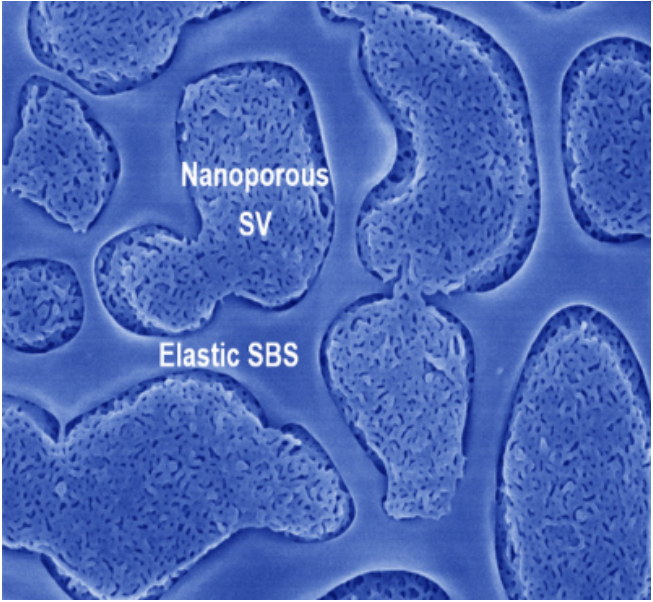
Antifouling Ultrafiltration Membranes by Selective Swelling of Polystyrene/Poly(ethylene Oxide) Block Copolymers
Hao Yang, Zhaogen Wang, Qianqian Lan, Yong Wang*, J. Membr. Sci. 2017, 542, 226-232
Ultrafiltration (UF) membranes with high permeability and good fouling resistance hold great promise in water treatment and many industry sectors. Herein, antifouling UF composite membranes with mesoporous films of polystyrene (PS)/poly (ethylene oxide) (PEO) block copolymer as the selective layers were produced by the process of selective-swelling-induced pore generation. We spin-coated thin layers of block copolymer onto macroporous supports, and activated the copolymer layers by soaking them in hot ethanol to induce the selective swelling of the PEO microdomains. The porous structures of the block copolymer selective layers can be continuously modulated simply by varying the swelling durations, resulting in UF membranes with water permeabilities adjustable in the range of ~ 100–600 L m-2 h-1 bar-1. Interestingly, the hydrophilic PEO blocks were enriched on the pore walls after swelling, rendering an inherent fouling resistance to the membranes. Protein fouling tests demonstrated that the membrane exhibited exceptional fouling resistance with a recover ratio in water flux of nearly 100%. This fouling resistance is expected to be long-standing as the PEO chains are covalently bonded to the membrane matrix.
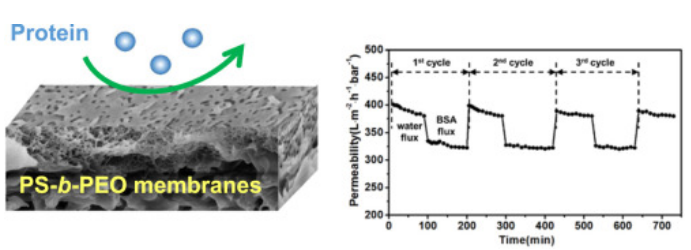
Nanoporous Polysulfones with In Situ PEGylated Surfaces by A Simple Swelling Strategy Using Paired Solvents
Zhaogen Wang,‡ Rui Liu,‡ Hao Yang, Yong Wang*, Chem. Commun. 2017, 53, 9105-9108
We report the formation of three-dimensionally interconnected nanoporosities with in situ PEGylated pore walls simply by swelling the block copolymers of polysulfone and poly(ethylene glycol) in paired solvents. The produced nanoporous polymers are expected to find important applications in membranes, batteries, chromatography, and haemodialysis, etc.
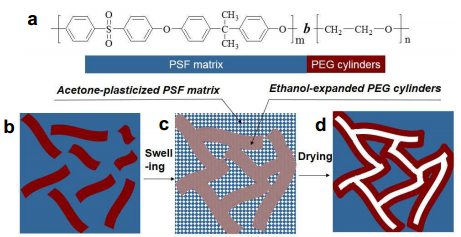
Substrate Matters: The Influences of Substrate Layers on the Performances of Thin-Film Composite Reverse Osmosis Membranes
Jie Li, Mingjie Wei*, Yong Wang*, Chinese J. Chem. Eng. 2017, 25, 1676-1684
Thin-film composite (TFC) reverse osmosis (RO) membranes are playing the dominating role in desalination. Tremendous efforts have been put in the studies on the polyamide selective layers. However, the effect of the substrate layers is far less concerned. In this review, we summarize the works that considering the impacts of the substrates, including pore sizes, surface hydrophilicity, on the processes of interfacial polymerization and consequently on the morphologies of the active layers and on final RO performances of the composite membranes. All the works indicate that the pore sizes and surface hydrophilicity of the substrate evidently influence the RO performances of the composites membranes. Unfortunately, we find that the observations and understandings on the substrate effect are frequently varied from case to case because of the lack of substrates with uniform pores and surface chemistries. We suggest using track-etched membranes or anodized alumina membranes having relatively uniform pores and functionalizable pore walls as model substrates to elucidate the substrate effect. Moreover, we argue that homoporous membranes derived from block copolymers have the potential to be used as substrates for the large-scale production of high-performances TFC RO membranes.
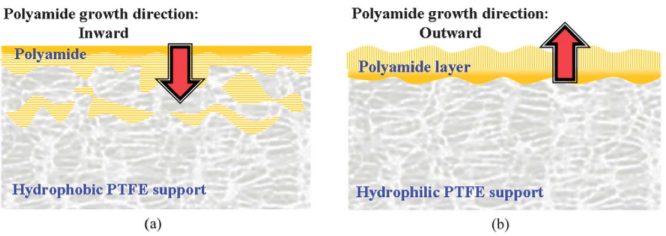
Advanced SERS Sensor Based on Capillarity-Assisted Preconcentration through Gold Nanoparticle-Decorated Porous Nanorods
Longjian Xue*, Wei Xie, Leonie Driessen, Katrin F. Domke, Yong Wang*, Sebastian Schlücker, Stanislav N. Gorb, Martin Steinhart*, Small 2017, 13, 1603947
A preconcentrating surface-enhanced Raman scattering (SERS) sensor for the analysis of liquid-soaked tissue, tiny liquid droplets and thin liquid films without the necessity to collect the analyte is reported. The SERS sensor is based on a block-copolymer membrane containing a spongy-continuous pore system. The sensor's upper side is an array of porous nanorods having tips functionalized with Au nanoparticles. Capillarity in combination with directional evaporation drives the analyte solution in contact with the flat yet nanoporous underside of the SERS sensor through the continuous nanopore system toward the nanorod tips where non-volatile components of the analyte solution precipitate at the Au nanoparticles. The nanorod architecture increases the sensor surface in the detection volume and facilitates analyte preconcentration driven by directional solvent evaporation. The model analyte 5,5′-dithiobis(2-nitrobenzoic acid) can be detected in a 1 × 10−3m solution ≈300 ms after the sensor is brought into contact with the solution. Moreover, a sensitivity of 0.1 ppm for the detection of the dissolved model analyte is achieved.
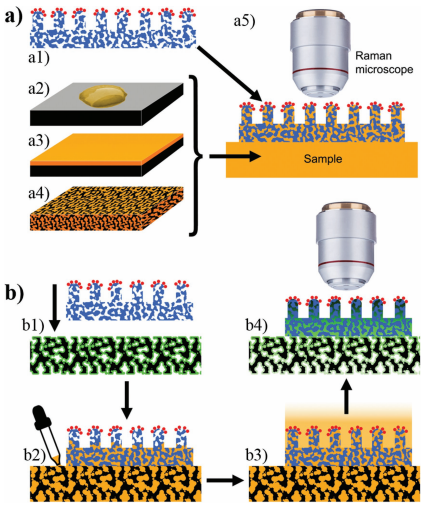
Atomic-Layer-Deposition-Enabled Thin-Film Composite Membranes of Polyimide Supported on Nanoporous Anodized Alumina
Hanghua Wang, Mingjie Wei, Zhaoxiang Zhong, Yong Wang*, J. Membr. Sci. 2017, 535, 56-62
Polyimide is deposited on the surface of nanoporous anodized alumina by atomic layer deposition (ALD) using pyromellitic dianhydride and ethylenediamine as the two precursors. Such ALD reactions directly produce polyimide rather than the intermediate polyamic acid. The precursor exposure duration plays an important role in determining the growth rate of PI and consequently the reduction of effective pore sizes. ALD with short precursor exposure confines the deposition predominantly around the pore openings of the alumina substrates, producing an asymmetric structure in the form of thin-film composites. This structure efficiently reduces the pore sizes of alumina, and as a result the retention of the membrane is significantly improved. A moderate cycle number of 50 remarkably increases the rejection of the membrane from nearly none to 82% at an acceptable expense of a reduction of 63% in water permeability. Deposition with long precursor exposure results in uniform coating into deep pores of the membranes whereas the effect in tailoring pore sizes and filtration performances are not as pronounced as deposition with short precursor exposure. This work is expected to be adopted to fabricate highly permeable and selective membranes of different materials by leveraging the deposition behavior of ALD on appropriate substrates.

Highly Permeable Nanoporous Block Copolymer Membranes by Machinecasting on Nonwoven Supports: An Upscalable Route
Xiansong Shi, Zhaogen Wang, Yong Wang*, J. Membr. Sci. 2017, 533, 201-209
Block copolymer (BCP) membranes are distinguished for their well-defined porosities, tunable pore geometries, and functionable pore walls. However, it remains challenging to produce robust BCP membranes by affordable, convenient methods. Herein, we demonstrate a facile and easily upscalable approach to produce highly permeable BCP membranes in large areas. The membranes possess a bi-layered composite structure with nanoporous polystyrene-block-poly(2-vinylpyrdine) BCP layers directly supported on macroporous nonwoven substrates. The BCP layers are machine-cast on the water-prefilled nonwoven, and interconnected nanoporosities are created in the BCP layers by ethanol swelling. The nanoporous BCP layers exhibit a thickness of ~10 µm and are tightly adhered to the nonwoven. Changes in the swelling temperatures and durations modulate both pore sizes and surface hydrophilicity of the BCP layers, and consequently the permselectivity of the membranes. By increasing swelling duration from 15 min to 12 h, the permeability of the membrane swollen at 65 °C can be increased from ~100 to ~850 L m−2 h−1 bar−1 with the retention to 15-nm gold nanoparticles reduced from ~93% to ~54%. Moreover, we demonstrate that the composite membrane can efficiently fractionate nanoparticles and narrow down their size distribution from ~3–20 nm to ~3–10 nm.
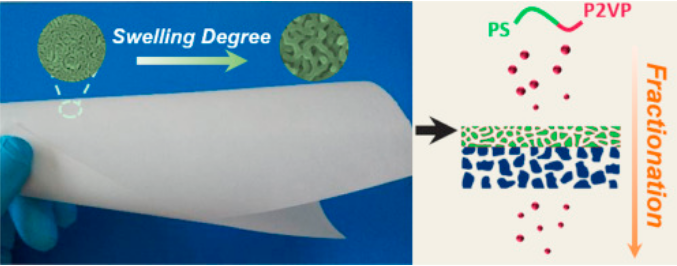
Tight Ultrafiltration Membranes of Mesoporous Phenolic Resin Filled in Macroporous Substrates
Qianqian Lan, Nina Yan, Yong Wang*, J. Membr. Sci. 2017, 533, 96-102
Mesoporous polymers derived from supramolecules of phenolic resins (PRs) and block copolymers (BCPs) containing highly uniform pores with sizes down to a few nanometers, are expected to deliver promising membrane separation performances. Here we report on the preparation of mesoporous phenolic membranes exhibiting tight ultrafiltration properties through a pore-filling strategy. Solutions of PR/BCP supramolecules are filled into the macropores of polyvinylidene fluoride (PVDF) microfiltration membranes (substrates), followed by thermopolymerization to solidify the solution in the pores. Subsequently, the filled PVDF substrates are treated in hot H2SO4 to remove the BCP components, thus producing mesopores in the PR framework. The produced composite membranes are mechanical robust and ductile as mesoporous phenolic resins are tightly embedded in the pores of the PVDF matrix. The mesoscale porosity in the PR phases endow the composite membrane a tight ultrafiltration performance with the molecular-weight-cut-off (MWCO) down to 2350 Da. The separation properties can be tuned simply by adjusting the dosage of supramolecule solutions used to fill the macroporous substrates. Considering the tight and uniform pore sizes and the robustness of phenolic resins, this strategy opens a new avenue to ultrafiltration membranes with low MWCOs or even nanofiltration membranes.
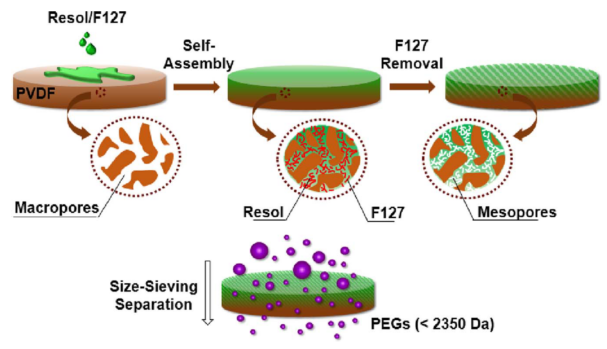
Ceramic Tubular Nanofiltration Membranes with Tunable Performances by Atomic Layer Deposition and Calcination
He Chen, Xiaojuan Jia, Mingjie Wei, Yong Wang*, J. Membr. Sci. 2017, 528, 95-102
Ceramic nanofiltration (NF) membranes are of particular significance for molecular separations under harsh conditions. However, they are usually manufactured by the sol-gel process which frequently suffers from low efficiency and poor control in the membrane properties. Herein we demonstrate an efficient and more controllable strategy to produce ceramic tubular NF membranes based on atomic layer deposition (ALD). Tubular ceramic membranes with pore size of ~5 nm are used as the substrates, on which titanium alkoxide (titanicone) is ALD-deposited. Subsequent calcination in air degrades the organic moieties in titanicone, thus converting the dense layer of titanicone into a microporous layer of TiO2. This microporous TiO2 layer serves as a thin separation layer delivering the NF size-sieving function. The thickness of the TiO2 layer can be readily tuned by changing the ALD cycle numbers, and correspondingly the original substrate membranes are progressively tightened with rising ALD cycles, and the membrane with 300 cycles exhibits a molecular-weight-cut-off (MWCO) of ~680 Da and water permeability of 30 L m−2 h−1 bar−1. Such a water permeability is higher than many other ceramic tubular membranes with similar MWCOs because of the ultrathin nature of the microporous TiO2 layer established by titanicone deposition and calcination.

Water Flow Inside Polyamide Reverse Osmosis Membranes: A Non-Equilibrium Molecular Dynamics Study
Yang Song, Fang Xu, Mingjie Wei*, Yong Wang*, J. Phys. Chem. B 2017, 121, 1715-1722
Water flow inside polyamide (PA) reverse osmosis (RO) membranes is studied by non-equilibrium molecular dynamics (NEMD) simulations in this work. The PA RO membrane is constructed with the all-atom model and the density and average pore size obtained thereby are in consistent with the latest experimental results. To obtain the time-independent water flux, a steady state NEMD method is used under various pressure drops. The water flux in our simulations, which is calculated under higher pressure drops, is in a linear relation with the pressure drops. Hence, the water flux in lower pressure drops can be reliably estimated, which could be compared with the experimental results. The molecular details of water flowing inside the membrane are considered. The radial distribution function and residence time of water around various groups of polyamide are introduced to analyze the water velocities around these groups, and we find that water molecules flow faster around benzene rings than around carboxyl or amino groups in the membrane, which implies that the main resistance of mass transport of water molecules comes from the carboxyl or amino groups inside the membranes. This finding is in good consistence with experimental results and suggests that less free carboxyl or amino groups should be generated inside RO membranes to enhance water permeance.
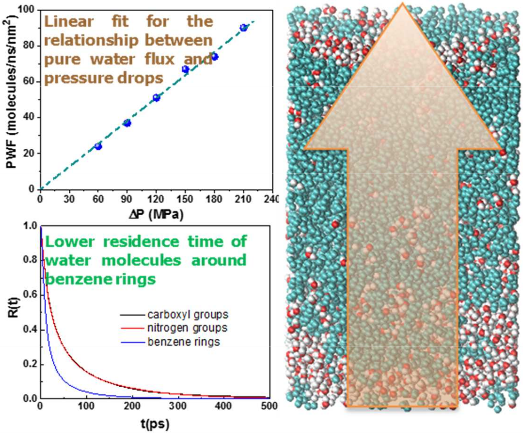
Advanced Ultrafiltration Membranes by Leveraging Microphase Separation in Macrophase Separation of Amphiphilic Polysulfone Block Copolymers
Wei Chen, Mingjie Wei, Yong Wang*, J. Membr. Sci. 2017, 525, 342-348
Water-soluble polymers are generally required in the process of nonsolvent-induced phase separation (NIPS) as additives or modifiers to enhance the hydrophilicity and permeability of ultrafiltration membranes. In this work, we demonstrate that amphiphilic block copolymers, polysulfone-block-poly (ethyleneglycol) (PSf-b-PEG), dissolved alone in solvents without any additives lead to highly permeable, fouling-resistant membranes via the NIPS process. PEG blocks deliver dual functions in the membranes. Selective enrichment of PEG blocks on the membrane surface as a result of surface segregation enhances the hydrophilicity and consequently fouling resistance of the membranes. Moreover, microscale phase separation of the block copolymers drives the formation of interconnected PEG microdomains distributed throughout the bulk membrane as confirmed by the transmission electron microscopy analysis on stained membrane slices. PEG microdomains serve as water channels facilitating water transport through the membrane. As a result, thus produced membranes exhibit excellent permeability a few times higher than other PSf-based ultrafiltration membranes with similar retentions. For instance, a membrane having the molecular weight cut-off of 70 kDa gives a water permeability as high as 450 m−2 h−1 bar−1. Furthermore, the retentions of the PSf-b-PEG membranes can be tuned in a relatively wide range simply by adjusting the copolymer concentration in the casting solutions. Using amphiphilic block copolymers alone as the base materials for the preparation of ultrafiltration membranes by NIPS not only simplifies membrane manufacturing process but also opens a new avenue to prepare advanced membranes with upgraded permeability and fouling resistance.

Depositing Lignin on Membrane Surfaces for Simultaneously Upgraded Reverse Osmosis Performances: An Upscalable Route
Feng Zhang, Yaping Wu, Weixing Li, Weihong Xing*, Yong Wang*, AIChE J. 2017, 63, 2221-2231
Reverse osmosis (RO) have been widely used to produce clean water and there is a strong need to enhance their permeability at no sacrifice of their other performances, e.g. selectivity. We deposit low-cost biopolymer, lignin, onto the surface of RO membranes by a simple filtration method. Lignin is deposited to the membrane surface via both hydrogen bonding and π-π interaction. Lignin deposition reduces the surface roughness of the membrane and enhances its negatively charging, while the surface hydrophilicity is maintained. Surprisingly, water permeation, salt rejection, and fouling resistance of the lignin-deposited membranes are simultaneously improved. More importantly, we demonstrate that this deposition method can be easily extended to modify commercial RO membrane modules, indicating the excellent upscalability of this method. We use the lignin-deposited membranes to treat real effluents of dyeing and papermaking and they perform much better than the virgin, unmodified membranes.
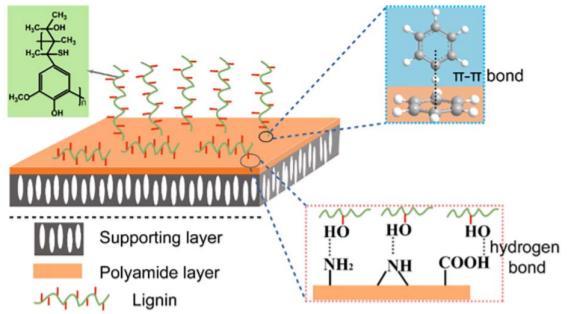
Direct Silanization of Polyurethane Foams for Efficient Selective Absorption of Oil from Water
Sen Xiong, Zhaoxiang Zhong, Yong Wang*, AIChE J. 2017, 63, 2232-2240
Absorption is an effective method to collect oil spills and solvent leakages from water. However, the currently used oil absorbents are still suffering from high cost, tedious preparation, and low recyclability. In this work, we report an extremely simple and low-cost strategy to produce oil absorbents by directly coupling alkoxysilane onto the surface of polyurethane foams. Such direct silanization renders the initially amphiphilic foams a strong hydrophobicity and consequently a water-repelling and oil-absorptive functionality. The silanized foams exhibit highest absorption capacities as well as best recyclability among all polyurethane-based oil absorbents. More practically, the silanized PU foams can be used to recover crude oil spills with an absorption capacity of higher than 75 times of their own weight, and maintain 90% of the initial absorption capacity after 8 times reusage. Interestingly, we invent portable oil suckers for continuous oil absorption from water by filling vacuum cleaners with the silanized foams.
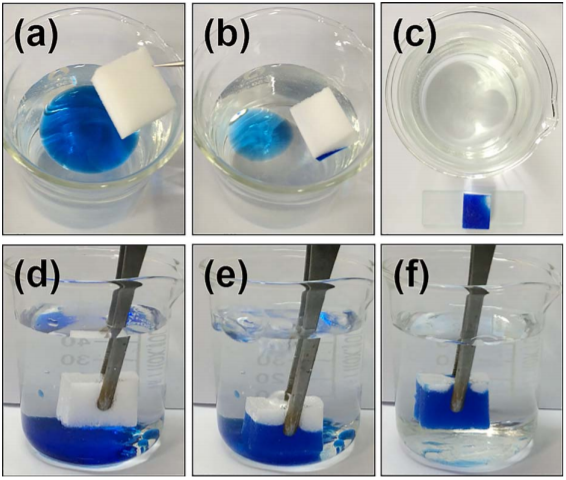
Facile Synthesis of Bimodal Nanoporous Carbons by Templating Selective Swelling-Induced Mesoporous Block Copolymers
Leiming Guo, Xiaoting Wang, Yong Wang*, Chem. Eng. J. 2017, 313, 1295-1301
There is a strong need for simple and efficient strategies to produce nanoporous carbons with hierarchical porosities for a number of applications such as supercapacitors. Here we demonstrate the ease preparation of nanoporous carbons with both microscale and mesoscale porosities by infiltrating oligomeric phenol-formaldehyde resols into mesoporous block copolymer (BCP) templates followed by thermopolymerization and carbonization. The mesoporous polymeric templates are produced by an extremely simple and highly flexible selective swelling method which involves only the immersion of the BCP film into hot ethanol for a few hours and the subsequent air drying of the BCP films. The produced carbons exhibit mesoporous structures with thin pore walls containing micropores, implying a hierarchical porosity of the porous carbons.Such hierarchically porous carbons work as supercapacitors exhibiting a capacitance as high as 173 F/g at 1 A/g. Additionally, an excellent high-rate and steady capacitance of 165 F/g at 5 A/g is maintained after 10000 cycles. The excellent performances are originated from the fast ion transport pathways and the low resistance of charge diffusion enabled by the hierarchical structures. This work suggests a new path to synthesize nanoporous carbons with hierarchical porosities which are expected to find more applications including but not limited to supercapacitors.
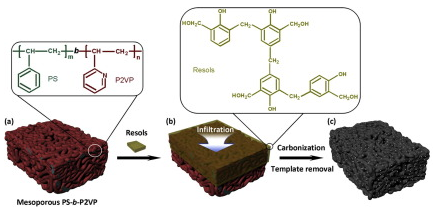
2016
Nondestructive Creation of Ordered Nanopores by Selective Swelling of Block Copolymers: Toward Homoporous Membranes
Yong Wang*, Acc. Chem. Res. 2016, 49, 1401-1408
Pores regulate the entry and exit of substances based on the differences in physical sizes or chemical affinities. Pore uniformity, ordering, and the homogeneity of the surface chemistry of the pore walls are vital for maximizing the performance of a porous material because any scattering in these parameters weakens the capability of pores to discriminate foreign substances. Most strategies for the creation of homogeneous pores are destructive, and sacrificial components in the precursor materials must be selectively removed to generate porosities. The incorporation and subsequent removal of the sacrificial components frequently make the pore-making process complicated and inefficient and impose greater uncertainty in the control of the pore homogeneity.
Block copolymers (BCPs) have been demonstrated to be promising precursors in the fabrication of highly ordered nanoporous structures. Unfortunately, BCP-derived porosities are also predominantly dependent on destructive pore-making processes (e.g., etching or extraction). To address this problem, we have developed a swelling-based nondestructive strategy. In this swelling process, one simply needs to immerse BCP materials in a solvent selective for the minority blocks for hours. After removing the BCPs from the solvent followed by air drying, pores are generated throughout the BCP materials in the positions where the minority blocks initially dwell. This Account discusses our recent discoveries, new insights, and emerging applications of this burgeoning pore-making method with a focus on the development of ordered porosities in bulk BCP materials.
The initial morphology and orientation of the minority phases in BCPs determine the pore orientation and geometry in the produced porous materials. For nonaligned BCPs, three-dimensionally interconnected pores with sizes scattering in the 10−50 nm range are produced after swelling. There is a morphology evolution of BCP materials from the initial nonporous structure to the increasingly opened nanoporous intermediates, to interconnected networks of micellar nanofibers, and finally to isolated micellar spheres with increasing degrees of swelling. When the BCP films are aligned perpendicularly or in-plane, selective swelling results in uniform “standing” (perpendicular orientation) and “sleeping” (in-plane orientation) pores, respectively. Pore sizes can be tuned by changing molecular weights of the BCPs and swelling conditions without the loss of pore uniformity. Due to the nondestructive nature of this swelling process, nothing in the BCPs is lost during the pore-forming procedure, and consequently the formed pores can be progressively closed also by selective swelling. Such reversible pore opening/closing can be repeated many times, enabling the application of these materials in drug delivery and intelligent antireflective coatings. The monodispersed pore sizes, straight pore profile, and hydrophilic pore walls particularly favor the application of the porous BCPs in separations as homoporous membranes (HOMEs) exhibiting high selectivity, permeability, and inherent stimulus responsiveness.

The Influence of Surface Topography and Surface Chemistry on the Anti-Adhesive Performance of Nanoporous Monoliths
Anna Eichler-Volf, Longjian Xue*, Gregor Dornberg, He Chen, Alexander Kovalev, Dirk Enke, Yong Wang*, Elena V. Gorb, Stanislav N. Gorb*, Martin Steinhart*, ACS Appl. Mater. Interfaces 2016, 8, 22593–22604
We designed spongy monoliths allowing liquid delivery to their surfaces through continuous nanopore systems (mean pore diameter ∼40 nm). These nanoporous monoliths were flat or patterned with microspherical structures a few tens of microns in diameter, and their surfaces consisted of aprotic polymer or of TiO2 coatings. Liquid may reduce adhesion forces FAd; possible reasons include screening of solid−solid interactions and poroelastic effects. Softening-induceddeformation of flat polymeric monoliths upon contact formation in the presence of liquids enhanced the work of separation WSe.On flat TiO2-coated monoliths, WSe was smaller under wet conditions than under dry conditions, possibly because of liquid-induced screening of solid−solid interactions. Under dry conditions, WSe is larger on flat TiO2-coated monoliths than on flat monoliths with a polymeric surface. However, under wet conditions, liquid-induced softening results in larger WSe on flat monoliths with a polymeric surface than on flat monoliths with an oxidic surface. Monolithic microsphere arrays show antiadhesive properties; FAd and WSe are reduced by at least 1 order of magnitude as compared to flat nanoporous counterparts. On nanoporous monolithic microsphere arrays, capillarity (WSe is larger under wet than under dry conditions) and solid−solid interactions (WSe is larger on oxide than on polymer) dominate contact mechanics. Thus, the microsphere topography reduces the impact of softening-induced surface deformation and screening of solid-solid interactions associated with liquid supply. Overall, simple modifications of surface topography and chemistry combined with delivery of liquid to the contact interface allow adjusting WSe and FAdover at least 1 order of magnitude. Adhesion management with spongy monoliths exploiting deployment (or drainage) of interfacial liquids as well as induction or prevention of liquid-induced softening of the monoliths may pave the way for the design of artificial surfaces with tailored contact mechanics. Moreover, the results reported here may contribute to better understanding of the contact mechanics of biological surfaces.
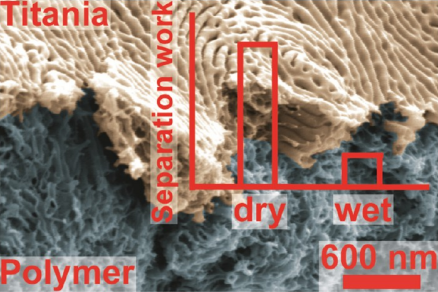
Atomic Layer Deposition on Block Copolymer Membranes with Gyroidal Nanopores Toward Periodically Nanostructured Vapor Sensors: Nanotubes versus Nanorods
Leiming Guo, Zhaoxiang Zhong, Yong Wang*, Adv. Mater. Inter. 2016, 3, 1600017
3D gyroidal networks of ZnO nanorods or nanotubes are synthesized by replicating block copolymer (BCP) templates with gyroidal nanopores via atomic layer deposition (ALD). The generation of 3D ZnO nanorods or nanotubes depends on the thicknesses of deposited ZnO layers, which can be easily and precisely controlled by adjusting ALD cycles. The as-obtained ZnO nanostructures have porosities as high as 77% for gyroidal nanorods and 86% for gyroidal nanotubes due to their unique interconnected structures and rough surfaces. Both gyroidal ZnO nanostructures are used as vapor sensors to detect ethanol with different concentrations. Gyroidal ZnO nanotubes show higher ethanol sensitivity than nanorods because of the inherently interconnected nanotubes and larger porosity. Gyroidal ZnO nanotubes can also act as formaldehyde sensors with the sensitivity as high as 42 to 50 ppm formaldehyde, which is much higher than previously reported sensors based on ZnO nanorods or nanotubes.
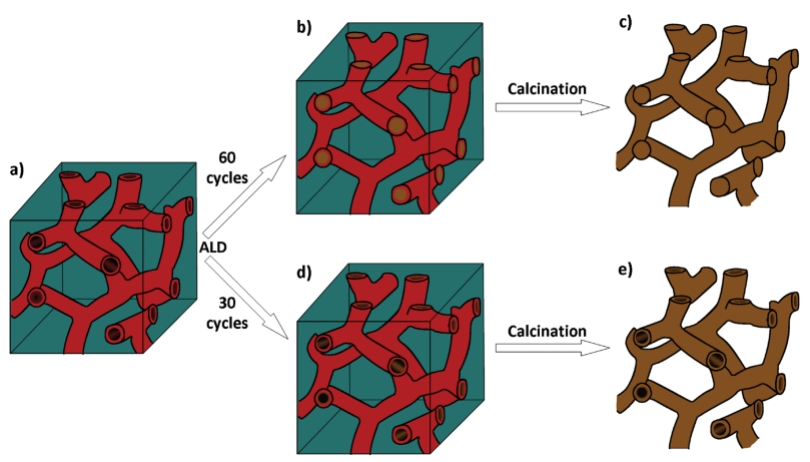
Nanoporous Films with Superior Resistance to Protein Adsorption by Selective Swelling of Polystyrene-block-Poly(ethylene Oxide)
Hao Yang, Leiming Guo, Zhaogen Wang, Nina Yan, Yong Wang*, Ind. Eng. Chem. Res. 2016, 55, 8133–8140
Poly(ethylene oxide) (PEO) is well-known for its excellent resistance to the nonspecific adsorption of proteins. However, it remains challenging to fabricate surfaces with uniform and robust coverage of PEO chains in a simple and efficient way. Simply by treating the block copolymer polystyrene-block-poly(ethylene oxide) (PS-b-PEO) in ethanol, we obtain nanoporous polymeric films with superior resistance to protein adsorption. The pores are nondestructively formed via the selective swelling-induced pore generation mechanism in which PEO microdomains embedded in PS matrix are selectively swollen in ethanol and collapsed in the subsequent air drying. Pore sizes and porosities can be typically tuned in the ranges ∼20–50 nm and ∼20–70%, respectively, by changing swelling durations and temperatures. Interestingly, the PEO chains are simultaneously migrated on the film surface and pore walls in the selective swelling-induced pore forming process. Atomic force microscopy examinations reveal that PEO chains are solvated when the film is wetted with water, closing the pores in the film. Thus, produced SEO films adsorb much less proteins than PS films without PEO on the surface, and also demonstrate a better fouling resistance than many reported PEO-covered surfaces prepared by other methods.
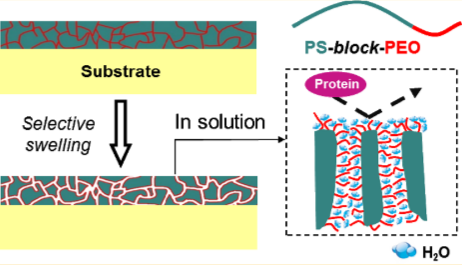
Dye Adsorption on Zinc Oxide Nanoparticulates Atomic-Layer-Deposited on Polytetrafluoroethylene Membranes
Sen Xiong, Liang Kong, Zhaoxiang Zhong, Yong Wang*, AIChE J. 2016, 62, 3982-3991
In this work, zinc oxide (ZnO) is deposited onto porous polytetrafluoroethylene (PTFE) membranes via atomic layer deposition (ALD) and thus produced ZnO-deposited PTFE membranes are used as adsorbents for the removal of dyes from aqueous solutions. We first examine the evolution of morphology, wettability, and crystallization of PTFE membranes with ZnO ALD. The presence of ZnO nanoparticulates significantly promotes the diffusion and contact of the aqueous solutions within the membrane on one hand, and endows the membrane a strong capability to adsorb dyes from the solutions on the other. Kinetic studies reveal that the adsorption of rhodamine B and acid orange 7 by the ZnO-deposited PTFE membranes can be described by the pseudo-second-order and pseudo-first-order model, respectively, and the adsorption of both dyes follows the Langmuir isotherm. The used membranes can be easily regenerated by rinsing with ethanol and reused for multiple times without loss of removal efficiency.
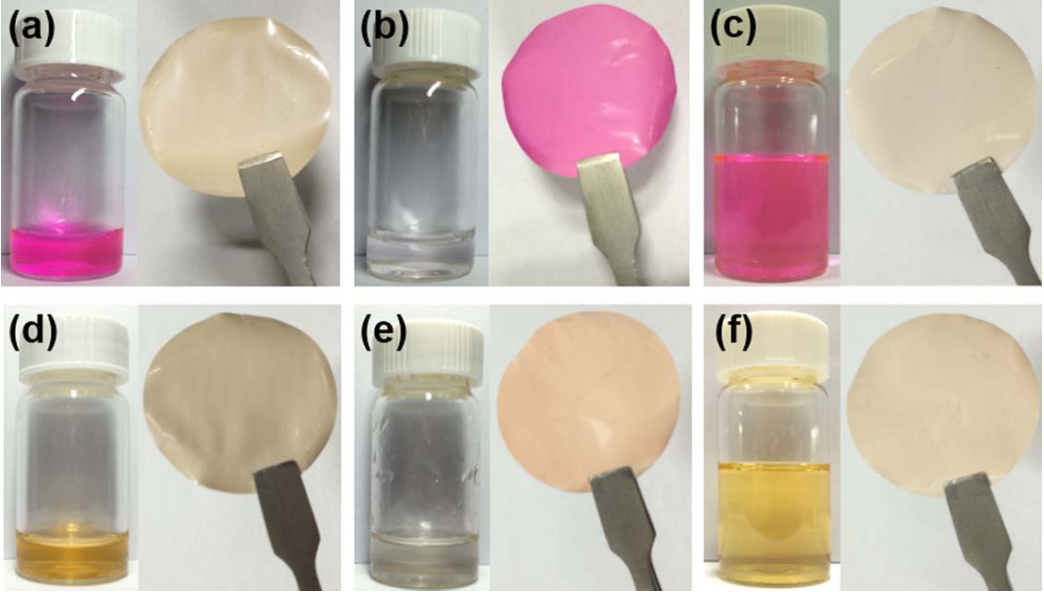
大尺寸陶瓷膜原子层沉积过程的 CFD 模拟
朱明,汪勇*, 化工学报 2016, 67, 3720-3729
陶瓷膜具有耐高温、耐酸碱、强度高等优点,在液体分离领域得到了广泛应用。对陶瓷膜进行表面改性,可进一步提升其性能,但基于表面化学反应的改性方法工艺过程复杂,难于控制。原子层沉积(Atomic Layer Deposition, ALD)是基于表面自限制化学反应过程的气固相薄膜沉积技术,可以在纳米尺度精确调控孔道结构,特别适用于多孔分离膜的改性和功能化。目前尚无适用于大尺寸陶瓷膜的ALD设备,需要对ALD过程进行专门的优化设计。通过CFD模型对1m长的单通道陶瓷膜的ALD过程进行了研究,在数学模型中考虑了两种气体源交替进入腔体中所引发不同的表面反应,并考虑了脉冲边界的影响。模拟计算结果与实验比较平均相对误差为1.69%。在数值模拟的基础上,提出了双向交替旋转脉冲的ALD模式,为陶瓷膜的 ALD沉积改性的装备设计和过程优化提供了理论依据。

Heat Transfer of Nanofluidics in Hydrophilic Pores: Insights from Molecular Dynamics Simulations
Mingjie Wei, Yang Song, Yong Wang*, Chinese J. Chem. Eng. 2016, 24, 1117-1121
Nanofluidics in hydrophilic nanopores is a common issue in many natural and industrial processes. Among all, the mass transport of nanofluidics is most concerned. Besides that, the heat transfer of a fluid flow in nano or micro channels is always considered with adding nanoparticles into the flow, so as to enhance the heat transfer by convection between the fluid and the surface. However, for some applications with around 1 nanometer channels such as nano filtration or erosion of rocks, there should be no nanoparticles included. Hence, it is necessary to figure out the heat transfer mechanism in the single phase nanofluidics. Via non-equilibrium molecular dynamics simulations, we revealed the heat transfer inside nanofluidics and the one between fluid and walls by setting simulation into extremely harsh condition. It was found that the heat was conducted by molecular motion without temperature gradient in the area of low viscous heat, while it was transferred to the walls by increasing the temperature of fluids. If the condition back to normal, it was found viscous heat of nanofluidics could be easily removed by the temperature gradient between fluid and walls being less than 1 K.
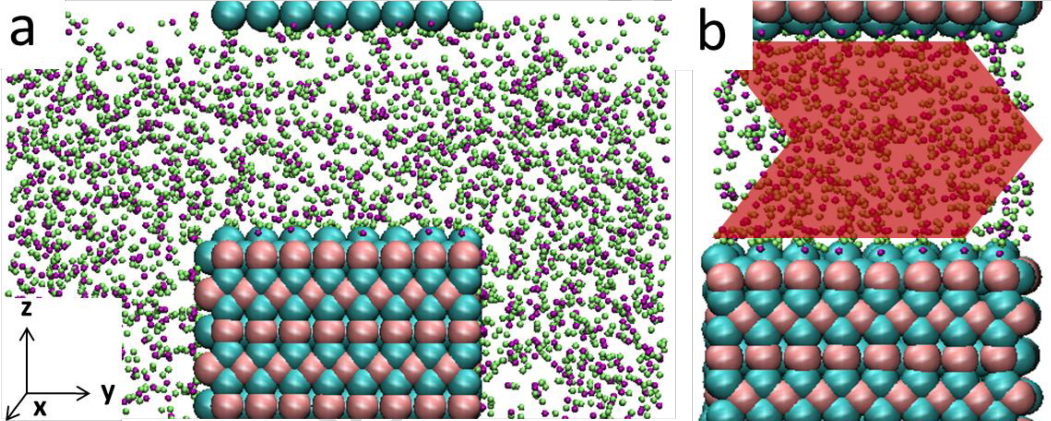
In Situ Cavitation of Phenolic Supramolecules with PEO−PPO−PEO Block Copolymers by Friedel−Crafts Alkylation toward Ordered Nanoporous Polymers
Xikang Huo, Qianqian Lan, Yong Wang*, Ind. Eng. Chem. Res. 2016, 55, 6398−6404
The release of hydrogen halides in Friedel−Crafts alkylation has long been considered as troublesome and detrimental. Here we demonstrate that the released HCl in alkylation is beneficial and highly demanded to remove poly-(ethylene oxide)-b-poly(propylene oxide)-b-poly(ethylene oxide) templates from the phenolic supramolecules for the preparation of ordered nanoporous phenolic polymers as additional treatment for template removal is no longer necessary. Friedel−Crafts alkylation using bifunctional alkylation agent, 1,4-bis(chloromethyl)benzene, leads to the hyper-cross-linking of phenolic polymers, thus generating micropores in the skeleton of the polymers. HCl in situ generated as the byproduct during alkylation facilely extracts the copolymer because of its enhanced diffusion through the micropores. The prepared phenolic polymers exhibit high surface areas and well-ordered porosities in a hexagonal or gyriodal structure. The in situ cavitation by alkylation takes place at much milder conditions and has higher efficiency than other template-removing methods.

Stretched Homoporous Composite Membranes with Elliptic Nanopores for External-Energy-Free Ultrafiltration
Leiming Guo, Lei Wang, Yong Wang*, Chem. Commun. 2016, 52, 6899-6902
Extremely permeable ultrafiltrationmembranes with elongated elliptical pores are fabricated by stretching composite membranes with homoporous selective layers and macroporous supports. With simultaneously increased porosities both for the selective layers and supports and the thinned selective layers, the stretched membranes exhibit multifold-enhanced permeability with little sacrifice in selectivities. Thus the produced membranes enable, for the first time, gravity-driven ultrafiltration and discrimination of similarly sized nanoparticles with diameters down to 30 nm.

Enhanced Performances of Polypropylene Membranes by Molecular Layer Deposition of Polyimide
Sen Xiong, Ting Sheng, Liang Kong, Zhaoxiang Zhong, Jun Huang, Yong Wang*, Chinese J. Chem. Eng. 2016, 24, 843-849
Molecular Layer Deposition (MLD) for the deposition of polyimide (PI) at low temperature of 110 °C has been firstly introduced into the field of membrane separation. With the optimized MLD deposition parameters, such low deposition temperature has successfully expanded the application of MLD for the surface modification of polymeric materials. Globular PI particulates grow on both the free surfaces as well as the pore walls of the polypropylene (PP) membranes as isolated islands during progressive precursor exposures. The PI-deposited PP membranes exhibit synergistically improved performances in various aspects. Evidently improved surface hydrophilicity and permeation performance (30%) have been achieved via the MLD deposition of polyimide films. The overall separation efficiency maintained higher than 85% even after 250 cycles of MLD deposition. More importantly, the thermal stability has been improved and the integrity of the porous structure for PI-deposited PP membranes has been well preserved even after harsh treatment, which ensures its potential application in industries.

Efficient Perovskite Solar Cells Based on Novel Three-Dimensional TiO2 Network Architectures
Hao Lu, Kaimo Deng, Nina Yan, Yulong Ma, Bangkai Gu, Yong Wang*, Liang Li*, Sci. Bull. 2016, 61, 778-786
Mesoscopic lead halide perovskite solar cells typically use TiO2 nanoparticle films as the scaffolds for electron-transport pathway and perovskite deposition. Here, we demonstrate that swelling-induced mesoporous block copolymers can be templates for producing threedimensional TiO2networks by combining the atomic layer deposition technique. Thickness adjustable TiO2network is an excellent alternative scaffold material for efficient perovskite solar cells. Our best performing cells using such a 270 nm thick template have achieved a high efficiency of 12.5 % with pristine poly-3-hexylthiophene as a hole transport material. The high performance is attributed to the direct transport pathway and high absorption of scaffolds, small leakage current and largely reduced recombination rate at interfaces. The results show that TiO2 network architecture is a promising scaffold for mesoscopic perovskite solar cells.
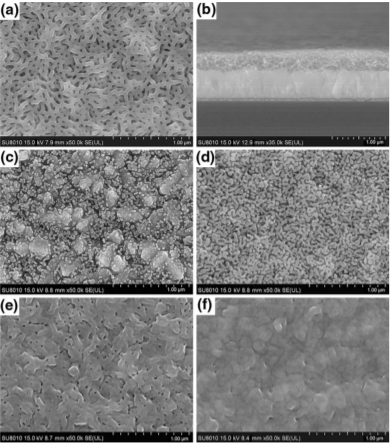
Selective Swelling Induced Pore Generation of Amphiphilic Block Copolymers: The Role of Swelling Agents
Nina Yan, Yong Wang*, J. Polym. Sci. B: Polym. Phys. 2016, 54, 926-933
Swelling of block copolymers by selective solvents has emerged as an extremely simple and efficient process to produce nanoporous materials with well-controlled porosities. However, the role of the swelling agents in this pore-making process remains to be elucidated. Here we investigate the evolution of morphology, thickness, and surface chemistry of thin films of polystyrene-block-poly (2-vinyl pyridine) (PS-b-P2VP) soaked in a series of alcohols with changing carbon atoms and hydroxyl groups in their molecules. It is found that, in addition to a strong affinity to the dispersed P2VP microdomains, the swelling agents should also have a moderate swelling effect to PS to allow appropriate plastic deformation of the PS matrix. Monohydric alcohols with longer aliphatic chains exhibit stronger ability to induce the pore formation and a remarkable increase in film thickness is associated with the pore formation. High-carbon alcohols including n-propanol, n-butanol, and n-hexanol produce cylindrical micelles upon prolonged exposure for their strong affinity toward the PS matrix. In contrast, methanol and polyhydric alcohols including glycol and glycerol show very limited effect to swell the copolymer films as their affinity to the PS matrix is low; however, they also evidently induce the surface segregation of P2VP blocks.

Highly Permeable and Robust Responsive Nanoporous Membranes by Selective Swelling of Triblock Terpolymers with a Rubbery Block
Zhaogen Wang, Yong Wang*, Macromolecules 2016, 49, 182−191
The selective swelling of amphiphilic block copolymers has been demonstrated to be extremely facile and efficient in producing nanoporous membranes. However, all previous works are limited to diblock copolymers composed of two glassy blocks, suffering from inherent mechanical weakness. Here we elucidate the selective swelling-induced pore generation of triblock terpolymers with a rubbery polyisoprene (PIP) block, polyisoprene-block-polystyrene-block-poly(2-vinylpyridine) (PIP-b-PS-b-P2VP). A short exposure to ethanol turns the initially dense films to nanoporous membranes with well-defined interconnected porosity. We fabricate composite membranes with the nanoporous terpolymer thin films as the selective layers deposited on macroporous substrates. Using PS-b-P2VP diblock copolymer without a rubbery third block for comparison, we identify the role of the rubbery PIP blocks in determining the mechanical properties as well as the swelling behaviors of the terpolymer. The rubbery PIP blocks enhance the mechanical robustness of the nanoporous membranes as revealed by nanoindentation tests on one hand and evidently accelerate the swelling process because of their softening effect to the PS matrix on the other hand, thus leading to 2–3-fold improved permeability. Moreover, the membranes exhibit a fast stimuli-responsive function as well as enhanced hydrophilicity because of the preferential aggregation of P2VP chains on the pore walls.
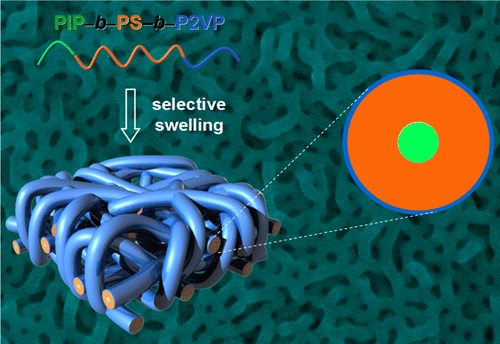
Homoporous Membranes with Tailored Pores by Soaking Block Copolymer/Homopolymer Blends in Selective Solvents: Dissolution versus Swelling
Mingjie Wei, Wei Sun, Xiansong Shi, Zhaogen Wang, Yong Wang*, Macromolecules 2016, 49, 215−223
Extraction homopolymers premixed in aligned films of block copolymers by rinsing with selective solvents has long been used for the preparation of membranes with uniform straight pores (homoporous membranes). It is frequently assumed that only the dissolution of homopolymers contributes to the pore formation. However, in this work, we demonstrate that the effect of swelling plays a significant role in determining the pore sizes. We prepare blended films of block copolymers of polystyrene-block-poly(2-vinylpyridine) (PS-b-P2VP) and P2VP homopolymers with low molecular weight and anneal the films to perpendicularly align the P2VP microdomains. Rinsing the aligned films in ethanol results in homoporous membranes, and the pore sizes can be tuned by the dosages of P2VP homopolymers. Interestingly, the pore sizes can also be effectively tailored by changing the rinsing temperatures and/or durations because of the significant contribution of the selective swelling of P2VP blocks under strong rinsing conditions in addition to the contribution of the dissolution of P2VP homopolymers. We identify the portion of the contribution from dissolution and from swelling and demonstrate that the pore sizes can be flexibly tuned within a wider range at no expense of pore ordering and uniformity by balancing the effect of dissolution and swelling.
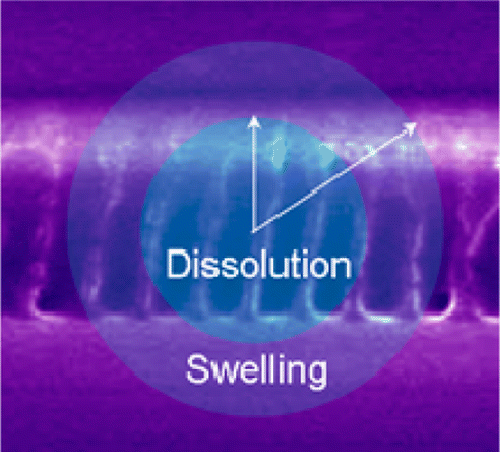
Upgrading Polysulfone Ultrafiltration Membranes by Blending with Amphiphilic Block Copolymers: Beyond Surface Segregation
Yuqing Chen, Mingjie Wei, Yong Wang*, J. Membr. Sci. 2016, 505, 53-60
Surface segregation of amphiphilic copolymers in the phase inversion process has long been used to improve membrane hydrophilicity. Typically, the copolymer is sparsely dosed into the casting solutions as additives. Herein we substantially increase the dosages of amphiphilic copolymers, and obtain blend ultrafiltration membranes with synergetically upgraded performances because of extra permeability-enhancing effect of the copolymer in addition to the surface segregation effect. We blend amphiphilic block copolymer, polysulfone-block-polyethylene glycol (PSf-b-PEG), with polysulfone base polymer at various percentages up to 70%. There is no compatible issue between the PSf and PSf-b-PEG as they are miscible at any blend ratio. Infrared spectroscopy and X-ray photoelectron spectroscopy confirm the surface segregation of PEG blocks. Moreover, PSf-b-PEG evidently influences the phase separation process by slowing down the precipitation rate of the polymer solutions, thus producing membranes with thicker skin layers. Interestingly, increasing copolymer percentages result in more water-permeable PEG microdomains in the blend membranes and consequently enhanced water permeance. The blend membranes exhibit simultaneously upgraded permeance, hydrophilicity, fouling resistance, and also performance stability. The highest permeance reaches nearly 400 L/(m2 h bar) at a copolymer percentage of 40%, which is much higher than those of PSf membranes prepared in other works. By comparing with PEG homopolymer, we identify that the superior performances are originated also from the additional water permeability through PEG microdomains in addition to the effect of surface segregation of PSf-b-PEG copolymers.
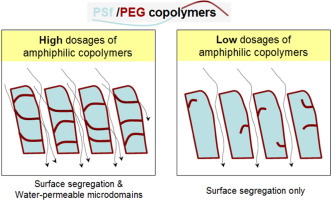
均孔膜
汪勇*, 邢卫红, 徐南平, 化工学报 2016, 67, 27-40
为进一步提高膜分离过程的精度,同步提升选择性和渗透性,分离膜孔径均一化是必然途径,均孔膜因此应运而生。首先讨论了均孔膜概念及其结构特点。均孔膜是孔径均一、孔道形状一致且垂直贯穿整个分离层的分离膜。然后介绍了制备均孔结构的不同方法,探讨了这些方法的优势和固有缺陷。利用嵌段共聚物微相分离的特性,可获取规整排列的、孔径在10~50 nm范围内连续可调的均孔结构,具有方法简便、无须特殊设备、易于放大制备等突出优势,是最有可能实现规模化生产的均孔膜制备方法。着重介绍了两亲嵌段共聚物选择性溶胀成孔方法的原理及其在孔径和孔型调节(圆柱孔、槽形孔)、自发永久亲水和制备过程绿色少污染等方面的特点。最后,讨论了嵌段共聚物基均孔膜发展的瓶颈,并指出应加强在孔径小于10 nm的均孔膜、孔型调变和应用领域等方面的研究。认为均孔膜不仅是一种新结构的分离膜,更代表着膜分离的发展方向。
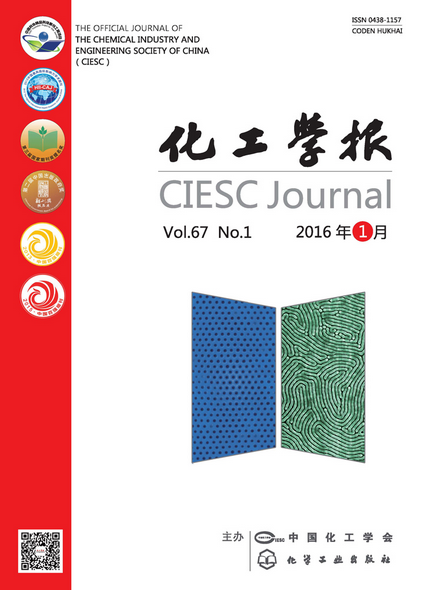
2015
Monolithic Membranes with Designable Pore Geometries and Sizes via Retarded Evaporation of Block Copolymer Supramolecules
Leiming Guo, Yong Wang*, Macromolecules 2015, 48, 8471–8479
We develop a retarded evaporation approach for the alignment of cylinder-forming block copolymer supramolecular monoliths, 3-n-pentadecylphenol (PDP) hydrogen-bonded polystyrene-b-poly(4-vinylpyridine) (PS-b-P4VP). A variety of highly ordered, aligned morphologies are produced by varying the dosages of PDP in the supramolecules. Treatment of the aligned supramolecular monoliths in hot ethanol leads to the dissolution of PDP and the selective swelling of P4VP, yielding enlargeable ordered mesopores along the original P4VP/PDP domains. Particularly, from supramolecular monoliths aligned in the morphology of perpendicular cylinders and gyroids, we obtain highly ordered monolithic membranes containing enlarged straight pores and bicontinuous pores, respectively. The straight and gyroidal pores were filled with phenol–formaldehyde resol and further carbonized to produce well-defined carbon nanostructures including nanofibers and reversed gyroids, demonstrating the pore accessibility and the promising templating functionality of the resulted monolithic membranes.
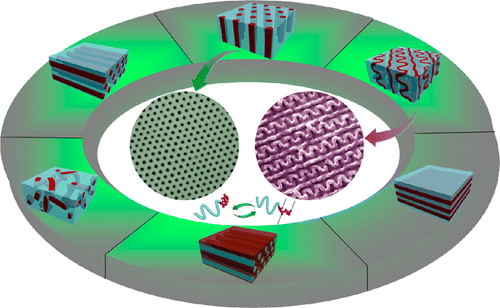
Atomic-Layer-Deposition-Enabled Nonwoven Membranes with Hierarchical ZnO Nanostructures for Switchable Water/Oil Separations
Sen Xiong, Liang Kong, Jun Huang, Xiaoqiang Chen, Yong Wang*, J. Membr. Sci. 2015, 493, 478-485
Functional membranes with separation ability for water/oil mixtures based on contrasting wetting behavior have recently received significant attention in the application field of water contamination treatment. Herein, we demonstrated a surface functionalization method for cost-efficient nonwoven fabrics with no selectivity of water/oil mixture. This nonwoven membrane was fabricated by hydrothermal growth of ZnO hierarchical nanorods on the surface of atomic-layer-deposited ZnO ultrathin layer. Due to the ZnO nanostructure with roughened morphology and the amphiphilic nature of the nonwoven fabrics, the functionalized nonwoven membranes were endowed with both underwater oleophobicity and under oil hydrophobicity. Separation of any phase in the mixture of water and oil can be achieved simply by pre-wetting the nonwoven membrane surface with the heavier component. Driven by gravity solely, the as-prepared nonwoven membranes can efficiently and selectively separate water/oil mixtures with exceptional stability. These functionalized nonwoven membranes may find potential application against complex water/oil separation systems.

Highly Permeable and Robust Membranes Assembled from Block-copolymer-functionalized Carbon Nanotubes
Xueping Yao, Jie Li, Zhaogen Wang, Liang Kong, Yong Wang*, J. Membr. Sci. 2015, 493, 224-231
The fabrication of homogenous integrated layers of assembled carbon nanotubes (CNTs) on porous substrates for advanced membranes via vacuum filtration remains a significant challenge due to the aggregation of CNTs. Here we report the composite membranes with both high flux and good mechanical robustness produced from functionalized CNTs through direct coating with amphiphilic block copolymer. Chemically crosslinked CNT layers are tightly adhered to the substrate, rendering a strong mechanical stability to the composite membranes. The thickness of the separation layer as well as the permselectivity of the membranes can be readily tuned simply by changing the deposition amount of CNTs. The membranes with a moderate nanofiber coverage are capable of complete removal of 10-nm-particles while offer a remarkable pure water flux higher than 5.7×103L/(m2hbar), suggesting their high efficiency in the purification of liquids contaminated by tiny colloids or particulates.
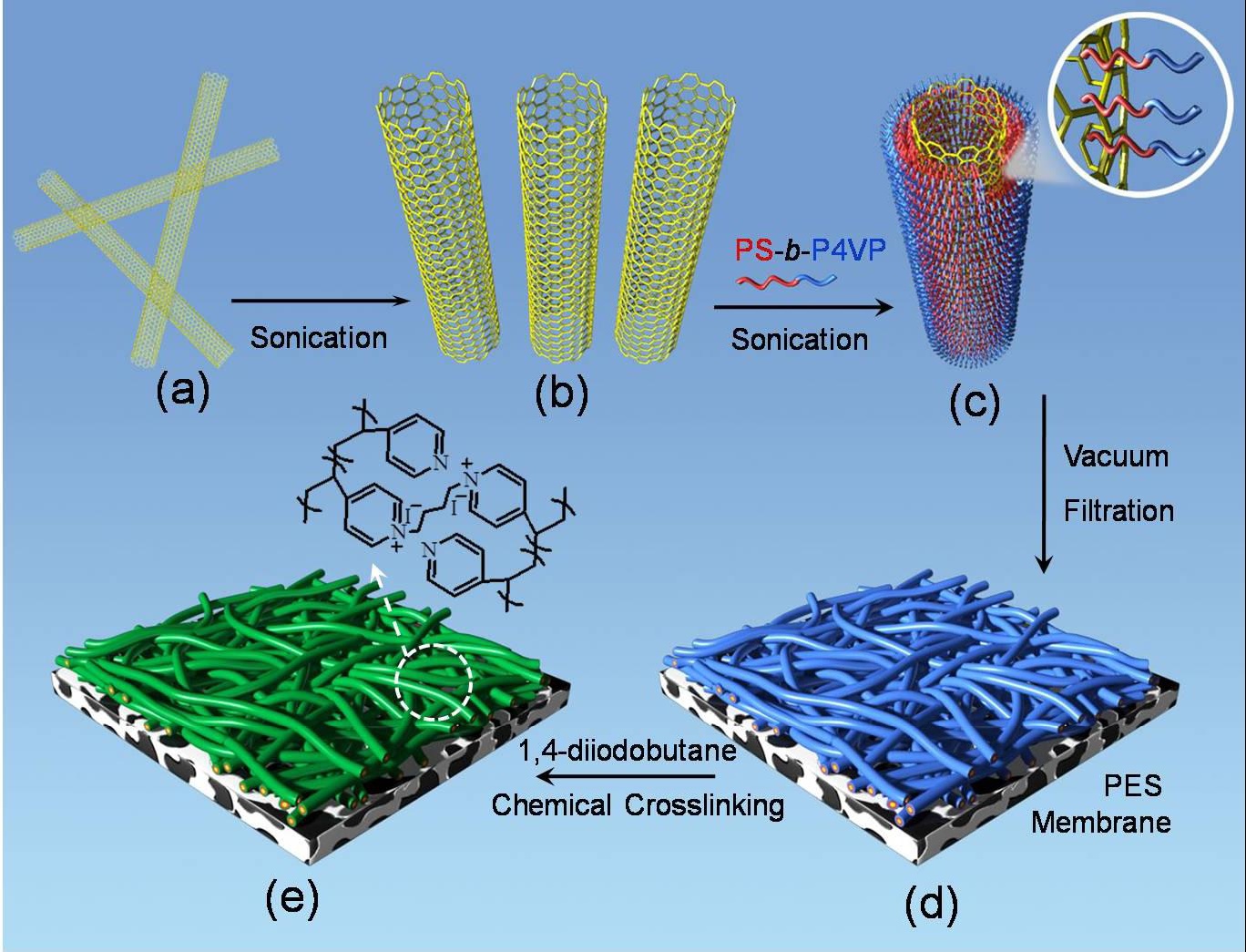
Unusual Air Filters with Ultrahigh Efficiency and Antibacterial Functionality Enabled by ZnO Nanorods
Zhaoxiang Zhong, Zhe Xu, Ting Sheng, Jianfeng Yao, Weihong Xing *, Yong Wang*, ACS Appl. Mater. Interfaces 2015, 7, 21538-21544
Porous membranes/filters that can remove airborne fine particulates, for example, PM2.5, with high efficiency at low energy consumption are of significant interest. Herein, we report on the fabrication of a new class of unusual superior air filters with ultrahigh efficiency and an interesting antibacterial functionality. We use atomic layer deposition (ALD) to uniformly seed ZnO on the surface of expanded polytetrafluoroethylene (ePTFE) matrix, and then synthesize well-aligned ZnO nanorods with tunable widths and lengths from the seeds under hydrothermal conditions. The presence of ZnO nanorods reduces the effective pore sizes of the ePTFE filters at little expense of energy consumption. As a consequence, the filters exhibit exceptional dust removal efficiencies greater than 99.9999% with much lower energy consumption than conventional filters. Significantly, the presence of ZnO nanorods strongly inhibits the propagation of both Gram positive and negative bacteria on the filters. Therefore, the functionalized filters can potentially overcome the inherent limitation in the trade-off effect and imply their superiority for controlling indoor air quality.
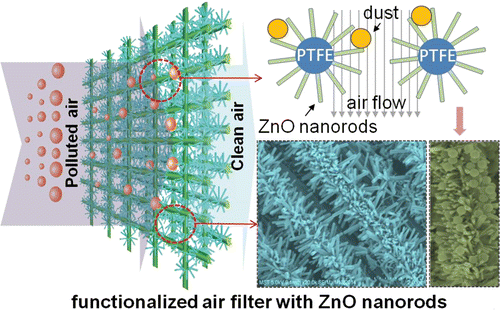
Interconnected Mesoporous Carbon Sheet for Supercapacitors from Low-cost Resources
Xiaoting Wang, Hao Ma, Hebao Zhang, Moxin Yu, Xiaojun He*, Yong Wang*, Mater. Lett. 2015, 158, 237-240
Interconnected mesoporous carbon sheets (MCSs) were prepared from cheap coal tar pitch with low-cost CaCO3nanoparticles and cetyltrimethyl ammonium bromide (CTAB) as porogens for supercapacitors. The results show that the surface area of MCSs can be tuned in the range of 87–167 m2g-1. The interconnected MCS2–1–1 made at 2:1:1 of CaCO3/coal tar pitch/CTAB mass ratio retains a capacitance of 87 F g-1 at 0.1 A g-1 after 100 cycles in ionic liquid electrolyte with high retention of 93.1%, showing excellent cycle stability. The energy density of MCS2–1–1 capacitor only drops from 64.18 Wh kg-1 to 22.19 Wh kg-1 with the average power density increasing from 115 W kg-1 to 4267 W kg-1, demonstrating good rate performance. This work suggests a low-cost way to synthesize high performance MCS for energy storage materials.
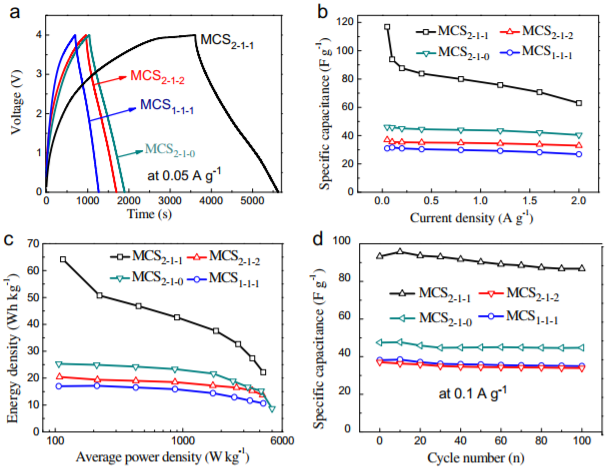
Enhancing the Hydrophilicity and Water Permeability of Polypropylene Membranes by Nitric Acid Activation and Metal Oxide Deposition
He Chen, Liang Kong, Yong Wang*, J. Membr. Sci. 2015, 487, 109-116
Activation by nitric acid oxidation has been combined with atomic layer deposition (ALD) to modify microporous polypropylene (PP) membranes. Nitric acid oxidation with prewetting of t-butanol generates active groups on the inert surface of PP membranes. Metal oxides including Al2O3 and TiO2 are subsequently ALD-deposited on the activated membrane. Nitric acid oxidation is a mild approach to activate PP membranes. A short immersion in nitric acid for 10 min is able to generate oxygen/nitrogencontaining active species on the membrane surface, which leads to an evident increase (38%) in the membrane permeability. The mechanical stability and the integrity of the porous structure are well preserved after activation. Surface elemental analyses and microscopy observations confirm the successful deposition of metal oxides thin layers onto the activated membranes. In the deposition of either Al2O3 or TiO2, the hydrophilicity of the deposited membranes is continuously improved with increasing ALD cycles, resulting in further increase in water flux. After 100 ALD cycles, the flux is doubled compared to that of the bare membrane. Al2O3 is more efficient in enhancing the hyclrophilicity and permeation than TiO2 under identical deposition conditions because of the faster growth of Al2O3 on the activated PP surface.

Surface Functionalization of Carbon Nanotubes by Direct Encapsulation with Varying Dosages of Amphiphilic Block Copolymers
Xueping Yao, Jie Li, Liang Kong, Yong Wang*, Nanotechnology 2015, 26, 325601
Encapsulation of carbon nanotubes (CNTs) by amphiphilic block copolymers is an efficient way to stabilize CNTs in solvents. However, the appropriate dosages of copolymers and the assembled structures are difficult to predict and control because of the insufficient understanding on the encapsulation process. We encapsulate multiwalled CNTs with polystyrene-block-poly (4-vinyl pyridine) (PS-b-P4VP) by directly mixing them in acetic acid under sonication. The copolymer forms a lamellar structure along the surface of CNTs with the PS blocks anchoring on the tube wall and the P4VP blocks exposed to the outside. The encapsulated CNTs achieve good dispersibility in polar solvents over long periods. To increase our understanding of the encapsulation process we investigate the assembled structures and stability of copolymer/CNTs mixtures with changing mass ratios. Stable dispersions are obtained at high mass ratios between the copolymer and CNTs, i.e. 2 or 3, with the presence of free spherical micelles. Transmission electron microscopy and thermal gravimetric analysis determine that the threshold for the complete coverage of CNTs by the copolymer occurs at the mass ratio of 1.5. The coated copolymer layer activates the surface of CNTs, enabling further functionalization of CNTs. For instance, atomic layer deposition of TiO2 produces conformal thin layers on the encapsulated CNTs while isolated TiO2 bumps are produced on the pristine, inert CNTs.

(Inside Cover) Reversible Switch Between the Nanoporous and the Nonporous State of Amphiphilic Block Copolymer Films Regulated by Selective Swelling
Nina Yan, Yong Wang*, Soft Matter 2015, 11, 6927-6937
Switchable nanoporous films, which can repeatedly alternate their porosities, are of great interest in a diversity of fields. Currently these intelligent materials are mostly based on polyelectrolytes and their porosities can change only in relatively narrow ranges, typically under wet conditions, severely limiting their applications. Here we develop a new system, which is capable of reversibly switching between a highly porous state and a nonporous state dozens of times regulated simply by exposure to selective solvents. In this system nanopores are created or reversibly eliminated in films of a block copolymer, polystyrene-block-poly(2-vinyl pyridine) (PS-b-P2VP), by exposing the films to P2VP-selective or PS-selective solvents, respectively. The mechanism of the switch is based on the selective swelling of the constituent blocks in corresponding solvents, which is a nondestructive and easily controllable process enabling the repeatable and ample switch between the open and the closed state. Systematic microscopic and ellipsometric characterization methods are performed to elucidate the pore-closing course induced by nonsolvents and the cycling between the pore-open and the pore-closed state up to 20 times. The affinity of the solvent for PS blocks is found to play a dominating role in determining the pore-closing process and the porosities of the pore-open films increase with the cycling numbers as a result of loose packing conditions of the polymer chains. We finally demonstrate the potential applications of these films as intelligent antireflection coatings and drug carriers.

Crosslinking of Polyimide Atomic-layer-deposited on Polyethersulfone Membranes for Synergistically Enhanced Performances
Ting Sheng, Liang Kong, Yong Wang*, J. Membr. Sci. 2015, 486, 161-168
Polyimide (PI) has been uniformly deposited and chemically crosslinked to form a hydrophilic and robust coating layer wrapping the skeleton of the macroporous polyethersulfone (PES) substrate membranes. PI is coated along all the exposed surfaces including the free surfaces and also the pore walls of the PES membranes by atomic layer deposition. The PI-deposited PES membranes are immersed in the excessive methanolic solution of ethylenediamine to initiate the crosslinking of PI chains. The crosslinked PES membranes exhibit synergistically enhanced performances in multiple aspects. They obtain enhanced hydrophilicity due to the formation of polar amide bonds. Control experiments on smooth PI films deposited on nonporous substrates reveal that crosslinking progressively increases the thickness of the PI films. Consequently, we are able to well control and tune the pore sizes by changing the crosslinking durations. The selectivity is enhanced by larger amplitude than the reduction of permeability as a result of reduced pore size and enhanced hydrophilicity after crosslinking. In addition, crosslinking also efficiently improves the thermal and mechanical stability and corrosion resistance of the PES membranes.

Surface Attachment of Gold Nanoparticles Guided by Block Copolymer Micellar Films and Its Application in Silicon Etching
Mingjie Wei, Yong Wang*, Materials 2015, 8, 3793-3805
Patterning metallic nanoparticles on substrate surfaces is important in a number of applications. However, it remains challenging to fabricate such patterned nanoparticles with easily controlled structural parameters, including particle sizes and densities, from simple methods. We report on a new route to directly pattern pre-formed gold nanoparticles with different diameters on block copolymer micellar monolayers coated on silicon substrates. Due to the synergetic effect of complexation and electrostatic interactions between the micellar cores and the gold particles, incubating the copolymer-coated silicon in a gold nanoparticles suspension leads to a monolayer of gold particles attached on the coated silicon. The intermediate micellar film was then removed using oxygen plasma treatment, allowing the direct contact of the gold particles with the Si substrate. We further demonstrate that the gold nanoparticles can serve as catalysts for the localized etching of the silicon substrate, resulting in nanoporous Si with a top layer of straight pores.

Filtration-based Synthesis of Micelle-derived Composite Membranes for High-flux Ultrafiltration
Xueping Yao, Leiming Guo, Xiaoqiang Chen, Jun Huang, Martin Steinhart*, Yong Wang*, ACS Appl. Mater. Interfaces 2015, 7, 6974-6981
Ideal membrane configurations for efficient separation at high flux rates consist of thin size-selective layers connected to macroporous supports for mechanical stabilization. We show that micelle-derived (MD) composite membranes combine efficient separation of similarly sized proteins and water flux 5–10 times higher than that of commercial membranes with similar retentions. MD composite membranes were obtained by filtration of solutions of amphiphilic block copolymer (BCP) micelles through commercially available macroporous supports covered by sacrificial nanostrand fabrics followed by annealing and removal of the nanostrand fabrics. Swelling-induced pore generation in the BCP films thus covering the macroporous supports yielded ∼210 nm thin nanoporous size-selective BCP layers with porosities in the 40% range tightly connected to the macroporous supports. Permselectivity and flux rates of the size-selective BCP layers were adjusted by the BCP mass deposited per membrane area and by proper selection of swelling times. The preparation methodology described here may pave the way for a modular assembly system allowing the design of tailored separation membranes.
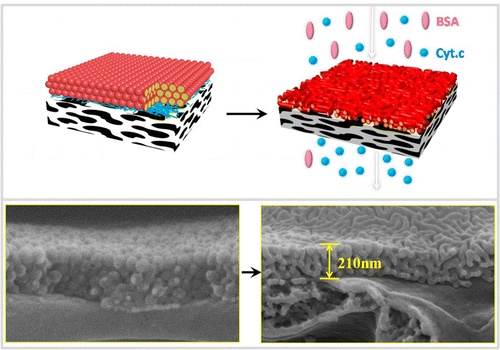
Isoporous Membranes with Gradient Porosity by Selective Swelling of UV-crosslinked Block Copolymers
Zhaogen Wang, Leiming Guo, Yong Wang*, J. Membr. Sci. 2015, 476, 449-456
Selective swelling of amphiphilic block copolymers (BCPs) is an effective and nondestructive pore making strategy. Here we coupled swelling-induced pore generation with UV crosslinking to fabricate BCP isoporous membranes with gradient porosity. Polystyrene-block-poly(2-vinylpyridine) (PS-b-P2VP) solutions were coated onto macroporous supporting membranes to achieve composite Films, which were then annealed in solvent vapor for the perpendicular alignment of the P2VP phases near the surface of the coating BCP layer. After swelling of BCP in hot ethanol and drying, isopores of similar to 8 nm formed at the surface of BCP layer following the selective swelling-induced pore-formation mechanism. Then UV exposure and subsequent secondary swelling at stronger condition oldie membranes were conducted to enlarge the inner pores while maintaining the surface structures. With balanced UV crosslinking and secondary swelling, the finally obtained membranes showed ordered perpendicular pores at the outmost layer and gradient porosity with enlarged interconnected pores inside the BCP layer. Due to the gradient structures, the membranes exhibited much higher flux while the surface structures and retention remained essentially unchanged. Moreover, compared to the membranes without UV treatment, the membranes showed better performances in discriminating polyethylene glycol molecules with different molecular weights and still kept a sensitive pH-responsive property.
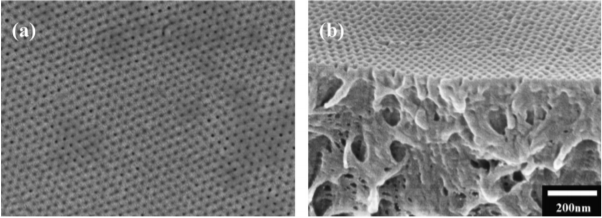
2014
Extremely Efficient and Recyclable Absorbents for Oily Pollutants Enabled by Ultrathin-Layered Functionalization
Qianqian Wang, Hanghua Wang, Sen Xiong, Rizhi Chen, Yong Wang*, ACS Appl. Mater. Interfaces 2014, 6, 18816-18823
Oils and organic solvents that leak into water bodies must be promptly removed to avoid ecological disasters, for example, by selective absorption using oleophilic absorbents. However, it remains a challenge for the low-cost synthesis of efficient and recyclable absorbents for oily pollutants. By surface functionalization to inexpensive polyurethane (PU) foams, we synthesize oil absorbents exhibiting the highest absorption capacity and the best recyclability among all polymeric absorbents. The synthesis is enabled by atomic layer deposition of ∼5 nm-thick Al2O3 transition layer onto the skeleton surface of PU foams, followed by coupling a single-molecule layer of silanes to the Al2O3 layer. The sub-10 nm functionalization layer provides the PU foam an outstanding water-repelling and oil-absorbing functionality without compromising its high porosity and elasticity. The functionalized foam is able to quickly absorb oily pollutants spread on water surfaces or precipitated in water with a capacity more than 100 times its own weight. This ultrathin-layer-functionalization method is also applicable to renewable porous biomaterials, providing a sustainable solution for oil spills. Moreover, we propose devices than can continuously operate to efficiently collect oil spills from water surfaces based on the functionalized PU foam developed in this work.
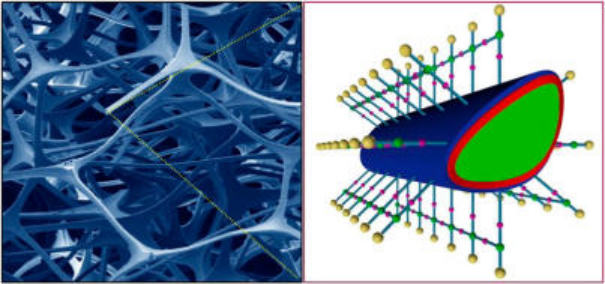
Turning Low-Cost Filter Papers to Highly Efficient Membranes for Oil/Water Separation by Atomic-Layer-Deposition-Enabled Hydrophobization
Liang Kong, Qianqian Wang, Sen Xiong, Yong Wang*, Ind. Eng. Chem. Res. 2014, 53, 16516-16522
It remains a great challenge for the simple and affordable production of membranes for oil/water separation. We prepare low-cost but highly efficient paper-based membranes for oil/water separation through hydrophobic modification to filter papers. The simple modification contains only two steps: a thin layer of aluminum oxide is first coated on the surface of the filter paper by atomic layer deposition, and silane molecules are subsequently coupled on the precoated aluminum oxide layer via their reaction with hydroxyl groups on the surface. Both the alumina layer and the silanization layer are very thin with a total thickness less than 10 nm. The modified filter paper is endowed with strong hydrophobicity and oleophilicity, therefore exhibits strongly retarded permeation to water and enhanced permeation to nonpolar oils. The modified filter paper is demonstrated to show excellent separation efficiencies greater than 90% in the separation of various types of oils and organic solvents from their mixtures with water. The paper-based membranes prepared in this work are distinguished among others for their low-cost substrates and simple modification route. This modification method is expected to be easily extended to hydrophobize a diversity of other substrates.
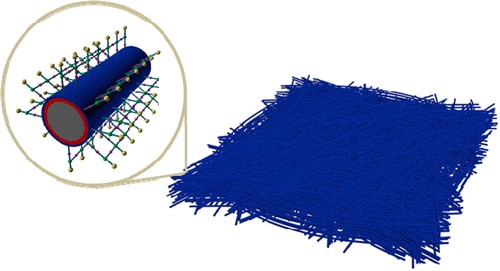
Atomic Layer Deposition of Polyimide on Microporous Polyethersulfone Membranes for Enhanced and Tunable Performances
Ting Sheng, He Chen, Sen Xiong, Xiaoqiang Chen, Yong Wang*, AIChE J. 2014, 60, 3614-3622
Atomic layer deposition (ALD) of polyimide (PI) is explored to tune the separation properties of microporous polyethersulfone (PES) membranes and also to improve their mechanic and thermal stability. Conformal and uniform thin layers of PI are deposited along the pore wall throughout the entire PES membrane instead of forming a top layer merely on the membrane surface. With increasing ALD cycles, the pore size of the PES membrane is progressively reduced, leading to increased retention. The permeation is correspondingly decreased but its drop is less pronounced than the increase of retention. For example, the retention to 23-nm silica nanospheres is significantly increased from nearly zero to 60% after 3000 ALD cycles, whereas the water flux is moderately decreased by 54%. Moreover, ALD of PI evidently enhances the mechanical strength and thermal resistance of the PES membrane as PI tightly wraps the skeleton of the membrane.

(Inside Cover) Nanoslitting of Phase-separated Block Copolymers by Solvent Swelling for Membranes with Ultrahigh Flux and Sharp Selectivity
Leiming Guo, Yong Wang*, Chem. Commun. 2014, 50, 12022-12025
Long and narrow slit-shaped pores are predicted to have enhanced permeation and selectivity. We report, for the first time, the efficient production of membranes containing densely packed slitted pores with a pore width of <15 nm from block copolymers (BCPs). Such membranes exhibit sharp selectivity and ultrahigh water flux.
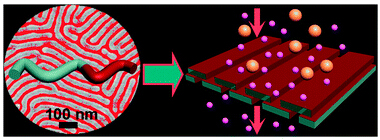
Plasma Activation and Atomic Layer Deposition of TiO2 on Polypropylene Membranes for Improved Performances of Lithiumion Batteries
He Chen, Qian Lin, Qiang Xu, Yang Yang, Zongping Shao, Yong Wang*, J. Membr. Sci. 2014, 458, 217-224
Atomic layer deposition (ALD) of TiO2 was applied on porous polypropylene (PP) membranes which were used as separators in lithium-ion batteries (LIBs) composed of Li4Ti5O12 (LTO) anode/Li cathode. Without plasma activation on the bare PP membrane, the initial deposition of TiO2 was based on the subsurface nucleation mechanism, which prevented the formation of a conformal hydrophilic TiO2 layer at low ALD cycles. The improvement of wettability of the PP membrane to the electrolyte could only be achieved at high ALD cycles up to 500. However, the severe narrowing of membrane pores counterbalanced the wetting enhancement, which hardly improved the performance of the LIBs. Plasma pretreatment was efficient to generate active groups on the highly chemically inert surface of polypropylene membranes, thus ultrathin TiO2 films could be conformally deposited by ALD on the membrane surface based on the layer-by-layer mechanism at cycles as low as 20. Such a conformal ultrathin layer of TiO2 was confirmed to concurrently overcome both the thermal shrinkage and poor wettability of the PP membranes. Beneficial from the improved wettability at no expense of pore size, the electrochemical performances of LIBs such as specific discharge capacities at different discharge rates were upgraded.
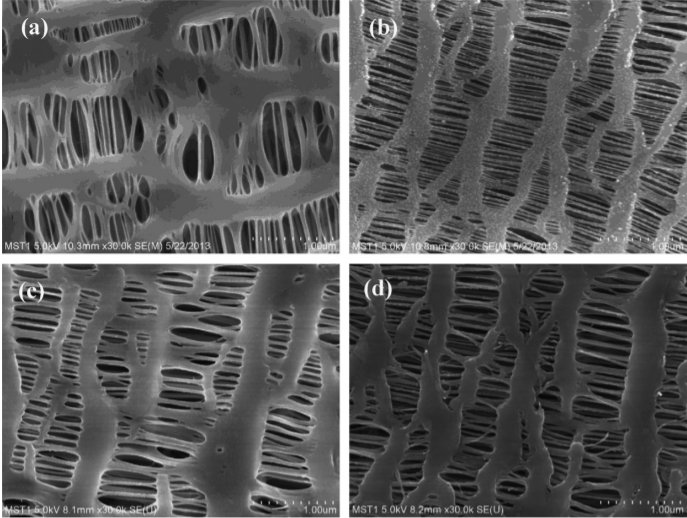
Surface-active Isoporous Membranes Nondestructively Derived from Perpendicularly Aligned Block Copolymers for Size-selective Separation
Wei Sun, Zhaogen Wang, Xueping Yao, Leiming Guo, Xiaoqiang Chen, Yong Wang*, J. Membr. Sci. 2014, 466, 229-237
Isoporous membranes which have narrow pore size distributions and straight pore profiles promise sharp selectivity at no expense of permeability. However, it remains a challenge to produce isoporous membranes in an affordable and efficient way. In this work, we report on the facile preparation of isoporous membranes based on the nondestructive creation of straight pores in block copolymers of polystyrene-block-poly(2-vinylpyridine) (PS-b-P2VP). Thin films of PS-b-P2VP are annealed to induce the perpendicular orientation of the P2VP cylinders, and then transferred to macroporous supporting membranes to form mechanically robust composite structures. The copolymer films are treated in hot ethanol to convert the P2VP cylinders into straight pores following the selective swelling-induced pore generation mechanism. The perpendicular alignment of the P2VP cylinders in the PS matrix facilitates the swelling-induced pore generation process, making the membrane highly permeable. Because of its ultrathin thickness, high porosity, and strong hydrophilicity, the membrane exhibits a water flux as high as 1686 L m−2 h−1 bar−1, which is about 10 times higher than that of commerical membranes and also much higher than that of other isoporous membranes with similar effective pore sizes. Furthermore, the membrane has an inherent reversible pH-responsive functionality because of the enrichment of protonizable P2VP chains on the pore wall and membrane surface.

2013
Hydrophilization of Porous Polypropylene Membranes by Atomic Layer Deposition of TiO2 for Simultaneously Improved Permeability and Selectivity
Qiang Xu, Jun Yang, Jiawei Dai, Yang Yang, Xiaoqiang Chen, Yong Wang*, J. Membr. Sci. 2013, 448, 215-222
The uses of porous polypropylene (PP) membranes are limited in water-based separations because of their strong hydrophobicity. To improve the separation performances of polypropylene membranes by hydrophilization, we deposited TiO2 on their pore surface using the atomic layer deposition strategy with and without a pretreatment to the membrane by plasma. The direct deposition without plasma pretreatment led to slightly enhanced hydrophilicity because TiO2 was slowly deposited on the membrane as discrete particles due to the lack of active groups on the bare polypropylene surface. In contrast, after a short exposure to plasma generated in air, oxygen-containing active groups were formed on the membrane and subsequent atomic layer deposition yielded conformal thin layer of TiO2 on the pore walls. The deposited membranes showed remarkably enhanced hydrophilicity and higher deposition cycles led to stronger hydrophilicity. As a consequence of the enhanced hydrophilicity, the permeability and retention of the deposited membrane were simultaneously improved with big amplitudes. For example, an increase in pure water flux of ~60% and a more than doubled retention ratio were obtained by deposition of TiO2 for 150 cycles on the plasma-activated polypropylene membrane. Furthermore, the TiO2-deposited membranes showed improved resistance to protein fouling compared to unmodified membranes also because of the enhanced hydrophilicity. Such a hydrophilization strategy of plasma pretreatment and subsequent atomic layer deposition of metal oxides is expected to be also effective in the upgrading of performances of other membranes with inert surfaces.
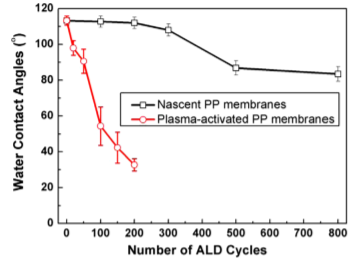
Membranes with Highly Ordered Straight Nanopores by Selective Swelling of Fast Perpendicularly Aligned Block Copolymers
Jun Yin, Xueping Yao, Jiun-You Liou, Wei Sun, Ya-Sen Sun, Yong Wang*, ACS Nano 2013, 7(11), 9961-9974
Membranes with uniform, straight nanopores have important applications in diverse fields, but their application is limited by the lack of efficient producing methods with high controllability. In this work, we reported on an extremely simple and efficient strategy to produce such well-defined membranes. We demonstrated that neutral solvents were capable of annealing amphiphilic block copolymer (BCP) films of polystyrene-block-poly(2-vinylpyridine) (PS-b-P2VP) with thicknesses up to 600 nm to the perpendicular orientation within 1 min. Annealing in neutral solvents was also effective to the perpendicular alignment of block copolymers with very high molecular weights,e.g., 362 000 Da. Remarkably, simply by immersing the annealed BCP films in hot ethanol followed by drying in air, the originally dense BCP films were nondestructively converted into porous membranes containing highly ordered, straight nanopores traversing the entire thickness of the membrane (up to 1.1 μm). Grazing incident small-angle X-ray spectroscopy confirmed the hexagonal ordering of the nanopores over large areas. We found that the overflow of P2VP chains from their reservoir P2VP cylinders and the deformation of the PS matrix in the swelling process contributed to the transformation of the solid P2VP cylinders to empty straight pores. The pore diameters can be tuned by either changing the swelling temperatures or depositing thin layers of metal oxides on the preformed membranes via atomic layer deposition with a subnanometer accuracy. To demonstrate the application of the obtained porous membranes, we used them as templates and produced centimeter-scale arrays of aligned nanotubes of metal oxides with finely tunable wall thicknesses.

Plasma Activation of Porous Polytetrafluoroethylene Membranes for Superior Hydrophilicity and Separation Performances via Atomic Layer Deposition of TiO2
Qiang Xu, Yang Yang, Jie Yang, Xiaozu Wang, Zhaohui Wang, Yong Wang*, J. Membr. Sci. 2013, 443, 62-68
Conformal and smooth TiO2 thin layers were coated on the surface of porous PTFE membranes subjected to a plasma activation process by atomic layer deposition (ALD). In contrast, TiO2 was deposited on the PTFE surface as globular particulates without plasma activation due to the inert chemical nature of PTFE surface. X-ray photoelectron spectrometry confirmed the formation of functional groups on the plasma-activated PTFE surface which served as active sites for the homogeneous adsorption and reaction of ALD precursors. Scanning and transmission electron microscopy revealed the uniformity of the deposited layer and the precise control of its thickness by changing ALD cycle numbers. The water contact angle measurement showed that the hydrophobic surface gradually turned to be near superhydrophilic with the increment of ALD numbers. Also, the membrane mean pore size was progressively reduced by simply altering the ALD numbers. At proper deposition conditions, the modified membranes gained an increase of pure water flux of more than 150% and simultaneously a doubled retention compared to the original unmodified membrane. This research provides an efficient approach devoid of any harsh treatments to modifying PTFE membranes for achieving specific functions, which also can be applied to other organic materials especially with chemical inert surface.

PVDF Membranes with Simultaneously Enhanced Permeability and Selectivity by Breaking the Tradeoff Effect via Atomic Layer Deposition of TiO2
Qianqian Wang, Xiaoting Wang, Zhaohui Wang, Jun Huang, Yong Wang*, J. Membr. Sci. 2013, 442, 57-64
Polyvinylidene fluoride (PVDF) is one of the most extensively used membrane materials, but PVDF membranes suffer deteriorating performances because of the intrinsic hydrophobic nature of PVDF. Significant efforts have been made to improve the hydrophilicity of PVDF membranes; however, there is frequently a tradeoff between the permeability and selectivity of the modified PVDF membranes. In this work, we broke the tradeoff effect by the atomic layer deposition (ALD) of TiO2 onto the PVDF membranes using TiCl4 and water as precursors. The vaporized precursors accessed the small membrane pores and produced a conformal and uniform thin layer of TiO2 that was tightly adhered to the pore walls. We progressively reduced the membrane pores by repeatedly cycling the deposition process until the membrane pores were completely blocked. The deposition of TiO2 enhanced the hydrophilicity and fouling resistance of the PVDF membranes, which was more evident at higher ALD cycle numbers. We simultaneously achieved greatly improved water flux and retention at 120 ALD cycles as a result of the competing effect of the increased hydrophilicity and reduced pore sizes. Moreover, the water flux could be sensitively tuned by changing the exposure time of the precursors. The thermal stability of the TiO2-deposited membranes was enhanced at a low ALD cycle number of 30.
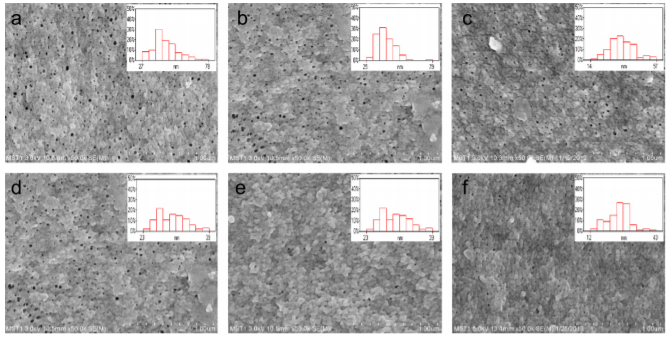
Responsive, Fluorescent Micellar Nanospheres of Amphiphilic Block Copolymers for the Characterization of Membrane Pores
Zhiming Yang, Zhaogen Wang, Xueping Yao, Xiaoqiang Chen, Yong Wang*, J. Membr. Sci. 2013, 441, 9-17
Fluorescent polymeric spheres with uniform sizes are of great interests in the measurement and calibration of the pore sizes and defects of porous media, including separating membranes. We reported the preparation of such nanospheres by dissolving amphiphilic block copolymers of polystyrene-block-poly(2-vinyl pyridine) (PS-b-P2VP) together with chromophores (perylene and pyrene) in acetic acid at elevated temperatures. Micellar nanosphere with the chromophores residing in the cores were formed through the heating-enabled micellization process. Following quaternization of the P2VP coronae gave the spheres a positively charged surface and a good water dispersibility. Scanning and transmission electron microscopy and dynamic light scattering analysis confirmed that the micellar nanospheres were uniform in size both in the dry and wet state. The micelle size and the thickness of coronae can be tuned by altering the molecular weight of the constituent blocks. Encapsulation of chromophores in the micelle cores provided a strong fluorescent emission to the micellar nanospheres, while quaternization of the P2VP coronae gave the nanospheres a greatly variable size according to pHs and salt concentrations in the surroundings. Taking advantages of their uniform size, water dispersibility, and fluorescent emission for accurate detection, we demonstrated that the micellar nanospheres were capable of characterizing pore sizes of separating membranes and detecting their large-pore defects.

Selective-swelling-induced Porous Block Copolymers and Their Robust TiO2 Replicas via Atomic Layer Deposition for Antireflective Applications
Jie Yang, Ling Tong, Yang Yang, Xiaoqiang Chen, Jun Huang, Rizhi Chen, Yong Wang*, J. Mater. Chem. C 2013, 1, 5133-5141
We prepared antireflective nanoporous membranes by an extremely simple method which only involves the immersion of the optical substrates coated with amphiphilic

Energy-saving, Responsive Membranes with Sharp Selectivity Assembled from Micellar Nanofibers of Amphiphilic Block Copolymers
Xueping Yao, Zhaogen Wang, Zhiming Yang, Yong Wang*, J. Mater. Chem. A 2013, 1, 7100-7110
Membrane technology contributes significantly in a large number of energy- and environment-related fields in a clean and efficient way. It remains a challenge to develop advanced membranes with simultaneous high flux and sharp selectivity. Such membranes require a thin selective layer, high porosity, and strong hydrophilicity. A promising strategy to fabricate such membranes is to build an integral selective layer of nanofibers on a macroporous support. We report an extremely simple method to produce uniform nanofibers with diameters of <30 nm by directly dissolving block copolymers of polystyrene-block-poly(4-pyridine) (PS-b-P4VP) with long, glassy PS blocks in a polar solvent. The fibers were cylindrical micelles with PS cores covered by P4VP coronae, formed through a heating-enabled micellization process. We deposited the fibers on the surface of macroporous supports by vacuum filtration to fabricate composite membranes. The gaps between the fibers served as mesh pores, with effective sizes down to several nanometers. Distinct from other types of nanofibers, the micellar fibers had a P4VP-covered surface, which not only enhanced the adhesion between fibers, but also endowed the membrane with a stimuli-responsive function. The fiber layers could be made very thin, with a thickness of ∼270 nm or even thinner, but were mechanically stable and exhibited a water flux as high as 940 L m−2 h−1 bar−1 at ∼100% rejection to bovine serum albumin. The fiber membrane displays an energy-saving characteristic as it provides high flux under low pressures compared with commercial ultrafiltration (UF) membranes. For example, it produces a flux over 10 times larger than that of commercial UF membranes. The membranes are promising for the removal of particulate contaminants from water as demonstrated by their excellent concentration capability for 5 nm gold colloidal nanoparticles.

Highly Ordered TiO2 Nanostructures by Sequential Vapour Infiltration of Block Copolymer Micellar Films in an Atomic Layer Deposition Reactor
Jun Yin, Qiang Xu, Zhaogen Wang, Xueping Yao, Yong Wang*, J. Mater. Chem. C 2013, 1 (5), 1029-1036
Sequential vapour
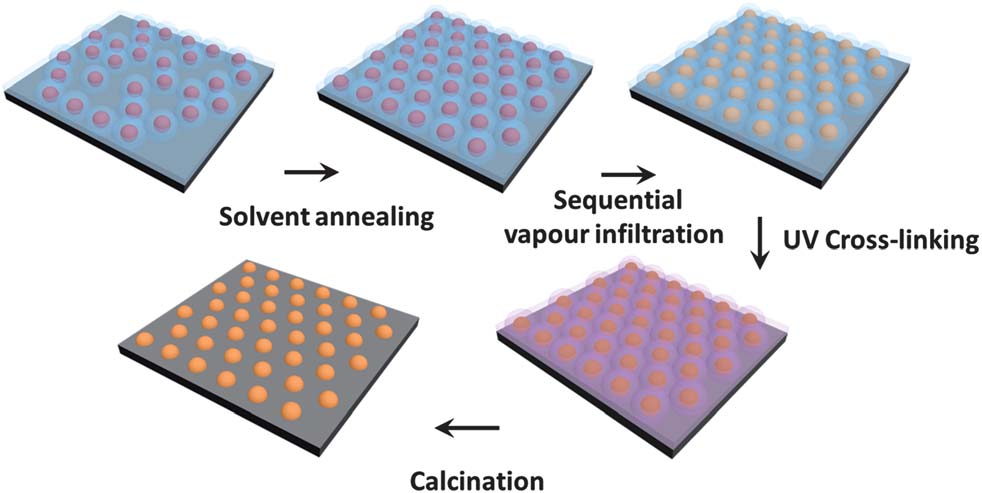
2012
Atomic Layer Deposition of Alumina on Porous Polytetrafluoroethylene Membranes for Enhanced Hydrophilicity and Separation Performances
Qiang Xu, Yang Yang, Xiaozu Wang, Zhaohui Wang, Wanqin Jin, Jun Huang, Yong Wang*, J. Membr. Sci. 2012, 415-416, 435-443
Porous polytetrafluoroethylene (PTFE) membranes are seeking extensive applications in gas and liquid purification whereas the strong hydrophobicity of PTFE limits their use in water system. We demonstrate that atomic layer deposition (ALD) is a simple and effective method to upgrade the separation performances of PTFE membranes by improving their surface hydrophilicity. Alumina was ALD-deposited on PTFE membranes following a subsurface nucleation and surface growth mechanism, leading to the formation of fine particulates with lower ALD cycles and continuous thick layers with higher ALD cycles on the surface of PTFE membranes, respectively. Thanking to the nanofibril-containing, porous surface morphology, the adhesion between the deposited alumina and PTFE substrate is strong, which can withstand harsh ultrasonication. The hydrophilicity of the deposited membranes was enhanced progressively with the rise of cycle numbers and the membrane with 500 cycles was completely water-wettable with a water angle less than 20°. Improved hydrophilicity of the alumina-deposited PTFE membranes not only affords remarkably enhanced fouling resistance, but also facilitates water permeation through the membrane, giving higher flux. Filtration experiments indicate that the deposited membranes prepared at optimal conditions possessed an increase of pure water flux of more than 50% and simultaneously an increase of retention of 12.4% compared to the pristine PTFE membrane.
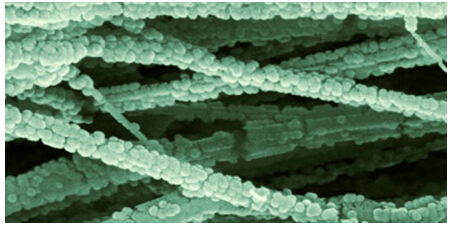
Swelling-induced Mesoporous Block Copolymer Membranes with Intrinsically Active Surfaces for Size-selective Separation
Zhaogen Wang, Xueping Yao, Yong Wang*, J. Mater. Chem. 2012, 22, 20542-20548

Highly Porous Metal Oxide Networks of Interconnected Nanotubes by Atomic Layer Deposition
Fengbin Li, Xueping Yao, Zhaogen Wang, Weihong Xing, Wanqin Jin, Jun Huang, Yong Wang*, Nano Lett. 2012, 12, 5033-5038
Mesoporous metal oxide networks composed of interconnected nanotubes with ultrathin tube walls down to 3 nm and high porosity up to 90% were fabricated by atomic layer deposition (ALD) of alumina or titania onto templates of swelling-induced porous block copolymers. The nanotube networks possessed dual sets of interconnected pores separated by the tube wall whose thickness could be finely tuned by altering ALD cycles. Because of the excellent pore interconnectivity and high porosity, the alumina nanotube networks showed superior humidity-sensing performances.

Modification of Ceramic Membranes for Pore Structure Tailoring: The Atomic Layer Deposition Route
Fengbin Li, Yang Yang, Yiqun Fan, Weihong Xing, Yong Wang*, J. Membr. Sci. 2012, 397-398, 17-23
The technique of atomic layer deposition (ALD) is applied to the structural modification and pore tailoring of ceramic membranes. Ceramic microfiltration membranes with an average pore size of 50 nm are used as substrates, on which Al2O3 is deposited by ALD with the purpose to tailor their pore size. The thickness of the deposited Al2O3 layer increases with the number of ALD cycles, and it is confirmed by scanning electron microscopy that the pore size of the ceramic membrane decreases with increasing ALD cycles until the pores are completely sealed. It is found that an ultrathin selective layer with a gradient porous structure is formed, whose thickness can be tuned by varying the exposure time of percursors. With the increased ALD cycles, the Al2O3-deposited membranes have a decreasing water flux, and an increasing retention to bovine serum albumin. The membrane subjected to 600 ALD cycles has a reduced pure water flux from 1698 L (m2 h bar)−1 for an undeposited membrane to 118 L (m2 h bar)−1, while its BSA retention increases significantly from 2.9% to 97.1%.
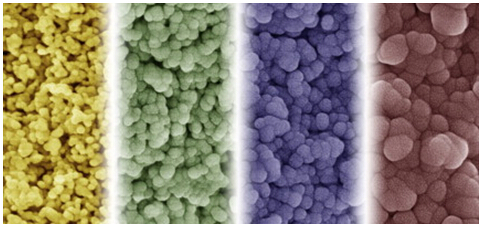
Water-dispersible, Uniform Nanospheres by Heating-enabled Micellization of Amphiphilic Block Copolymers in Polar Solvents
Zhiming Yang, Zhaogen Wang, Xueping Yao, Yong Wang*, Langmuir 2012, 28(5), 3011-3017
Uniform nanospheres with tunable size down to 30 nm were prepared simply by heating amphiphilic block copolymers in polar solvents. Unlike reverse micelles prepared in nonpolar, oily solvents, these nanospheres have a hydrophilic surface, giving them good dispersibility in water. Furthermore, they are present as individual, separated, rigid particles upon casting from the solution other than continuous thin films of merged micelles cast from micellar solution in nonpolar solvents. These nanospheres were generated by a heating-enabled micellization process in which the affinity between the solvent and the polymer chains as well as the segmental mobility of both hydrophilic and hydrophobic blocks was enhanced, triggering the micellization of the glassy copolymers in polar solvents. This heating-enabled micellization produces purely well-defined nanospheres without interference of other morphologies. The micelle sizes and corona thickness are tunable mainly by changing the lengths of the hydrophobic and hydrophilic blocks, respectively. The heating-enabled micellization route for the preparation of polymeric nanospheres is extremely simple, and is particularly advantageous in producing rigid, micellar nanospheres from block copolymers with long glassy, hydrophobic blocks which are otherwise difficult to prepare with high efficiency and purity. Furthermore, encapsulation of hydrophobic molecules (e.g., dyes) into micelle cores could be integrated into the heating-enabled micellization, leading to a simple and effective process for dye-labeled nanoparticles and drug carriers.
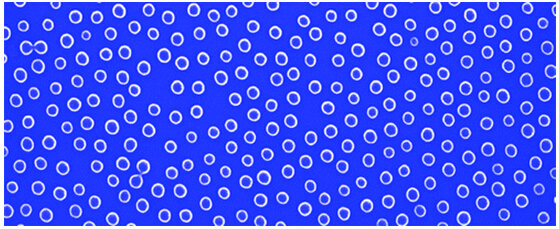
2011
Precise Pore Size Tuning and Surface Modifications of Polymeric Membranes Using the Atomic Layer Deposition Technique
Fengbin Li, Ling Li, Xingzhi Liao, Yong Wang*, J. Membr. Sci. 2011, 385-386, 1-9
We demonstrated that atomic layer deposition (ALD) technique is an effective method in decorating pore walls of polymeric porous membranes (track etched polycarbonate membranes) by coating the membrane surface and pore walls with a uniform and conformal layer of aluminum oxide. Through ALD coating, the membrane obtained a thin, outer shell of oxide, showing improved hydrophilicity and resistance to acids and organic solvents. More importantly, the membrane pore size could be tuned continuously at a sub-angstrom preciseness simply by altering the numbers of ALD cycles, because the average growth rate of the deposited aluminum oxide was 0.8 Å/ALD cycle. Filtration experiments demonstrated that membranes subjected to increasing ALD cycles gave progressively rise in retention to the solute (bovine serum albumin) and drop in flux. Interestingly, the slightly deposited membrane (subjected to 10 ALD cycles) showed greatly enhanced retention at only a slight expense of the loss of flux because of the hydrophilic nature of the deposited aluminum oxide layer. The ALD approach can be extended to modify/functionalize other membranes since ALD is universal in depositing thin films on almost every type of polymeric and inorganic materials.

Fabrication, Structural Characterization and Sensing Properties of Polydiacetylene Nanofibers Templated from Anodized Aluminum Oxide
Ling Tong, Bowen Cheng, Zengshe Liu, Yong Wang*, Sensor Actuat. B-Chem. 2011, 155 (2), 584-591
Polydiacetylene (PDA), as a unique conjugated polymer, has shown its potential in the application of chem/bio-sensors and optoelectronics. In this work, we first infiltrated PDA monomer (10, 12-pentacosadiynoic acid, PCDA) melt into anodized aluminum oxide template, and then illuminated the infiltrated template with UV light to initiate the polymerization of PCDA. After etching away the aluminum oxide templates, we obtained solid poly-PCDA nanofibers. We found that even tightly confined in template pores with diameter as small as ∼35 nm, PCDA crystals were able to be polymerized through a solid polymerization mechanism induced by UV light. Poly-PCDA nanofibers, both in the released form and embedded in the template, showed characteristic blue to red color change in sensing exposure of organic solvents and temperature increasing, and the red colored fibers possessed strong fluorescence. Moreover, poly-PCDA nanofibers were highly crystalline, and oriented favorably in some certain direction due to the confinement of nanopores, as demonstrated by X-ray diffraction texture analysis and orientation distribution analysis by scanning confocal optical microscopy.

An Emerging Pore-Making Strategy: Confined Swelling-Induced Pore Generation in Block Copolymer Materials
Yong Wang*, Fengbin Li, Adv. Mater. 2011, 23, 2134-2148
Block copolymers (BCPs) composed of two or more thermodynamically incompatible homopolymers self-assemble into periodic microdomains. Exposing self-assembled BCPs with solvents selective to one block causes a swelling of the domains composed of this block. Strong swelling in the confinement imposed by the matrix of the other glassy block leads to well-defined porous structures via morphology reconstruction. This confined swelling-induced pore-making process has emerged recently as a new strategy to produce porous materials due to synergic advantages that include extreme simplicity, high pore regularity, involvement of no chemical reactions, no weight loss, reversibility of the pore forming process, etc. The mechanism, kinetics, morphology, and governing parameters of the confined swelling-induced pore-making process in BCP thin films are discussed, and the main applications of nanoporous thin films in the fields of template synthesis, surface patterning, and guidance for the areal arrangements of nanomaterials and biomolecules are summarized. Recent, promising results of extending this mechanism to produce BCP nanofibers or nanotubes and bulk materials with well-defined porosity, which makes this strategy also attractive to researchers outside the nanocommunity, are also presented.

Swelling-induced Morphology Reconstruction in Block Copolymer Nanorods: Kinetics and Impact of Surface Tension During Solvent Evaporation
Yong Wang*, Ling Tong, Martin Steinhar*, ACS Nano 2011, 5(3), 1928-1938
Nanoscopic domain structures of BCP nanorods can be converted into well-defined mesopore systems by swelling the BCP minority component with a selective solvent at temperatures below the bulk glass transition temperature of the nonswelling matrix. The initial stage of this process involves rapid morphology reconstruction of the nonswelling majority domains to accommodate the increased volume of the swelling minority domains caused by rapid solvent uptake. Morphology reconstruction slows down once entropic restoring forces of the swelling chains impede further uptake of swelling agent. Upon evaporation of the swelling agent, mesopores form in place of the swollen domains as the swollen minority blocks undergo entropic relaxation while intermediate nonequilibrium morphologies in the BCP nanorods are fixated by the reconstructed majority component. The surface area of mesopores developing when swollen cylindrical minority domains collapse may be minimized by the growth of Rayleigh instabilities. Depending on swelling temperature, swelling agent, and BCP architecture, BCP nanorods with one or several cylindrical channels undulated or uniform in diameter running along their long axes, linear strings of spherical cavities, and continuous mesopore systems can be obtained.
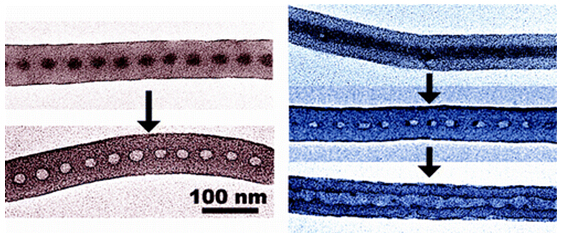
2010
Synthesis of Two-Dimensional Carbon and Carbon–Metal Nanocomposites Using a Natural Cellular Material as the Carbon Precursor
Fengbin Li, Ling Li, Xingzhi Liao, Ling Tong, Zhiquan Chen, Yong Wang*, Eur. J. Inorg. Chem. 2010, 4367-4373
Two-dimensional carbon nanostructures, including carbon nanoflakes that are formed from the disassembly of carbon foams and carbon–metal composites, were directly synthesized using the stem pith of the rice-paper plant (SPRP) as the carbon precursor and also the synthesis template. SPRP has a foamlike porous structure. SPRP was pyrolyzed to prepare carbon foam with ultralow apparent density, and this foam was ruptured to produce carbon nanoflakes with a lateral size up to hundreds of micrometers and a thickness of approximately 100 nm. Palladium and platinum were added to the SPRP foams by wet impregnation, and the impregnated foams were subsequently converted into composites of metal nanoparticles and carbon in the form of foams or nanoflakes. The composites were characterized using electron microscopy, energy-dispersive spectroscopy, X-ray diffraction, and Raman spectroscopy. The metal nanoparticles were found to be highly crystalline with diameters in the range of several tens of nanometers (palladium) and several nanometers (platinum), and were uniformly distributed throughout the carbon nanoflakes. The amount of metal in the composite was tunable by changing the impregnation time and the concentration of the impregnation solution.

(Inside Cover) Nanoporous Metal Membranes with Bicontinuous Morphology from Recyclable Block Copolymer Templates
Yong Wang*, Changcheng He, Weihong Xing*, Fengbin Li, Ling Tong, Zhiquan Chen, Xingzhi Liao, Martin Steinhart*, Adv. Mater. 2010, 22(18), 2068-2072
Nondestructive preparation of bicontinuous nanoporous metal membranes by replication of bicontinuous nanoporous polymeric membranes consisting of recoverable asymmetric block copolymers (BCPs) is reported. The BCP membranes are generated by swelling the minority domains of the BCP with selective solvents accompanied by reconstruction of the glassy matrix formed by the majority component (see figure).
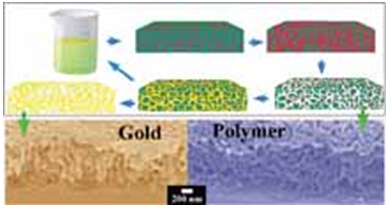
Responsive Micellar Films of Amphiphilic Block Copolymer Micelles: Control on Micelle Opening and Closing
Zhiquan Chen, Changcheng He, Fengbin Li, Ling Tong, Xingzhi Liao, Yong Wang*, Langmuir 2010, 26(11), 8869-8874
We reported the deliberate control on the micelle opening and closing of amphiphilic polystyrene-block-poly(2-vinylpyridine) (PS-b-P2VP) micellar films by exposing them to selective solvents. We first treated the micellar films with polar solvents including ethanol and water (pH = 4, 8, and 12) that have different affinities to P2VP. We observed opening of the micelles in all the cases. Both the size of opened pores and the opening rate are dependent on the solvency of different solvents for P2VP. We then explored the closing behavior of the opened micelles using solvents having different affinities to PS. We found that the opened micelles were recovered to their initial closed micelle forms. The recovery was accompanied by a slow micelle disassociation process which gradually reduced the micelle size. The rates of the micelle closing and disassociation are also dependent on the solvency of different solvents for PS.

2009-2003
Nanostructured Gold Films for SERS by Block Copolymer-Templated Galvanic Displacement Reactions
Yong Wang*, Michael Becke, Li Wang, Jinquan Liu, Roland Scholz, Juan Peng, Ulrich Gosele, Silke Christiansen, Dong Ha Kim*, Martin Steinhart*, Nano Lett. 2009, 9, 2384-2389
Up to now, little effort has been made to exploit large-area high-throughput patterning by block copolymer (BCP) lithography to generate nanostructured substrates with periods well below 100 nm for surface-enhanced Raman scattering (SERS). We show that simple BCP-templated galvanic displacement reactions yield dense arrays of mushroom-shaped gold nanopillars with a period of 50 nm. The nanoporous BCP films used as templates were obtained by swelling-induced reconstruction of reverse micelle monolayers deposited on silicon wafers. Coupling of adjacent mushroom caps almost impinging on each other combined with their strong local curvature results in a high spatial density of hot spots in the narrow gaps between them. Thus, substrates characterized by high SERS efficiencies are obtained.

(Frontspiece) Nanoscopic Morphologies in Block Copolymer Nanorods as Templates for Atomic Layer Deposition of Semiconductors
Yong Wang*, Yong Qin, Andreas Berger, Eric Yau, Changcheng He, Lianbing Zhang, Ulrich Gosele, Mato Knez, Martin Steinhart*, Adv. Mater. 2009, 21, 2763-2766
Block-copolymer nanorods containing mesopore structures derived from confinement-induced nanoscopic morphologies were used as templates for atomic-layer deposition. Diffusion of the ALD precursors through the polymeric scaffold and deposition of ZnO on the walls of the internal mesopores yielded 1D ZnO nanostructures with hierarchical architectures containing helices and stacked doughnuts as structure motifs.
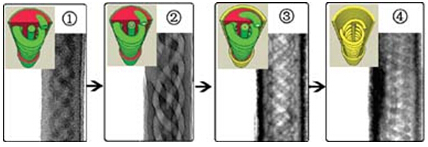
Nanopatterned Carbon Films with Engineered Morphology by Direct Carbonization of UV-Stabilized Block Copolymer Films
Yong Wang*, Jinquan Liu, Silke Christiansen, Dong Ha Kim, Ulrich Gosele, Martin Steinhart*, Nano Lett. 2008, 8, 3993-3997
Nanopatterned thin carbon films were prepared by direct and expeditious carbonization of the block copolymer polystyrene-block-poly(2-vinylpyridine) (PS-b-P2VP) without the necessity of slow heating to the process temperature and of addition of further carbon precursors. Carbonaceous films having an ordered “dots-on-film” surface topology were obtained from reverse micelle monolayers. The regular nanoporous morphology of PS-b-P2VP films obtained by subjecting reverse micelle monolayers to swelling-induced surface reconstruction could likewise be transferred to carbon films thus characterized by ordered nanopit arrays. Stabilization of PS-b-P2VP by UV irradiation and the concurrent carbonization of both blocks were key to the conservation of the film topography. The approach reported here may enable the realization of a broad range of nanoscaled architectures for carbonaceous materials using a block copolymer ideally suited as a template because of the pronounced repulsion between its blocks and its capability to form highly ordered microdomain structures.

Mesoporous Block Copolymer Nanorods by Swelling-Induced Morphology Reconstruction
Yong Wang*, Ulrich Gosele, Martin Steinhart*, Nano Lett. 2008, 8, 3548-3553
Engineering the topography of thin block copolymer (BCP) films by surface reconstruction associated with selective swelling of one of the blocks has been investigated intensively. Here we show that swelling-induced structural transitions in nanorods consisting of amphiphilic BCPs involve pronounced reshaping of the nonswollen glassy domains in the course of the transition from the equilibrium morphology of the molten BCP in cylindrical confinement to that of the BCP dissolved in the swelling agent. The reconstruction process can be quenched to retain intermediate nonequilibrium morphologies. The collapse of the swollen chains upon drying yields polymeric nanorods exhibiting complex nanoscopic architectures characterized by a variety of mesopore structures and surface topographies, including channels along the nanorods, bunches of partially interconnected strands, and strings of spheres. The complex BCP nanorods thus obtained can be used as soft templates for the rational arrangement of metal nanoparticles.
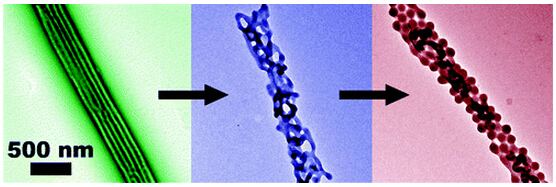
Mesoporous Polymer Nanofibers by Infiltration of Block Copolymers with Sacrificial Domains into Porous Alumina
Yong Wang*, Ulrich Gosele, Martin Steinhart*, Chem. Mater. 2008, 20, 379-381
Mesoporous polymer nanofibers were prepared by degrading sacrificial domains of block copolymers (BCPs) infiltrated into porous alumina. Surface-induced ordering influences the formation of the mesoscopic morphology in porous alumina with pore diameters 1 order of magnitude larger than the BCP period. In smaller pores, nanotubes were obtained.
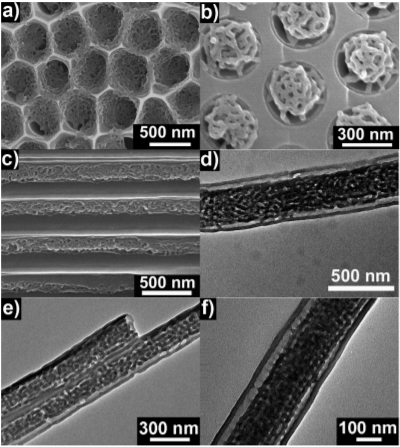
Micropatterned Polymer Surfaces Enduced by Nonsolvent
Yong Wang, Zhimin Liu*, Ying Huang, Buxing Han*, Guanying Yang, Langmuir 2006, 22, 1928-1931
In this work, we present a facile method for fabricating polymer thin films with micropatterned surfaces by evaporating polymer solution containing a small amount of nonsolvent of polymer in air. Poly(methyl methacrylate) (PMMA) and polystyrene (PS) films with densely packed micropores on the surfaces were fabricated. This method was also used to prepare three-dimensional PMMA films with micropatterned surfaces. The effects of nonsolvent content; evaporation temperature; and interactions between the polymer, solvent, and nonsolvent on the specific patterns were investigated, and the formation mechanism of the pores is discussed. This simple route can potentially be used, for example, in the large-scale production of patterned surfaces, three-dimensional painting, and hydrophobicity-enhancing coatings.

Facile Synthesis of Polyaniline Nanofibers Using Chloroaurate Acid as the Oxidant
Yong Wang, Zhimin Liu*, Buxing Han*, Zhenyu Sun, Ying Huang, Guanying Yang, Langmuir 2005, 21, 833-836
This work demonstrated a facile route to the synthesis of polyaniline (PANI) nanofibers by polymerization of aniline using chloroaurate acid (HAuCl4) as the oxidant. The reduction of AuCl4- is accompanied by oxidative polymerization of aniline, leading to uniform PANI nanofibers with a diameter of 35 ± 5 nm and aggregated gold nanoparticles which can precipitate from the liquid phase during the reaction. The resultant PANI nanofibers and gold particles were characterized by means of different techniques, such as UV−vis, FTIR spectroscopy, and scanning and transmission electron microscopy methods. It is found that the gold aggregates are capped with polyaniline, and the conductivity of the fibers is around 0.16 S/cm.
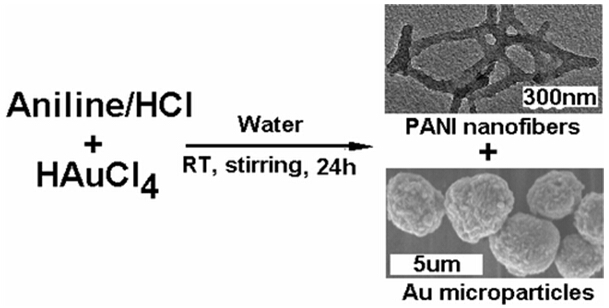
Carbon Microspheres with Supported Silver Nanoparticles Prepared from Pollen Grains
Yong Wang, Zhimin Liu*, Buxing Han*, Ying Huang, Guanying Yang, Langmuir 2005, 21, 10846-10849
In this paper, we present a new method to fabricate carbon microspheres with supported silver nanoparticles on the surfaces. In this method, pollen grains were first treated with AgNO3 aqueous solution, then preoxidized in air at 300 °C and carbonized in nitrogen at 600 °C, resulting in the silver/carbon nanocomposites. The silver/carbon nanocomposites were characterized by means of SEM, TEM, TG, and XRD. The size and distribution of the silver nanoparticles on the carbon microsphere surface could be controlled by tuning the AgNO3 treatment conditions.
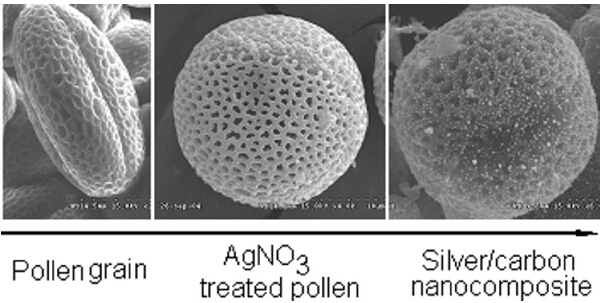
Compressed-CO2-Assisted Patterning of Polymers
Yong Wang, Zhimin Liu*, Buxing Han*, Ying Huang, Jianling Zhang, Donghai Sun, Jimin Du, J. Phys. Chem. B 2005, 109, 12376-12379
We report a facile route to pattern polymer surfaces with the aid of compressed CO2, termed the compressed-CO2-assisted imprint method. In this method, compressed CO2 serves as a plasticizer for polymers (such as poly(methyl methylate) and polystyrene), which leads to a tremendous reduction in the glass transition temperature and viscosity of the polymers. Nylon fabrics and anode aluminum oxide porous membranes are used as molds, respectively, to pattern the softened polymers at relatively low temperatures, resulting in patterns at the scale of micrometers and nanometers on the surface of polymer films. The patterned structures can be tuned by changing CO2 pressure and temperature in the imprinting process. This method is simple and environmentally benign. It also can be operated at low temperatures, for instance, ambient temperature.
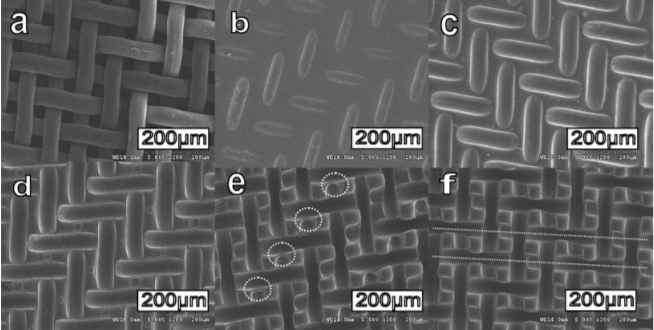
Phase-Separation-Induced Micropatterned Polymer Surfaces and Their Applications
Yong Wang, Zhimin Liu*, Buxing Han*, Zhenyu Sun, Jianling Zhang, Donghai Sun, Adv. Funct. Mater. 2005, 15, 655-663
We report a route to fabricate micropatterned polymer films with micro- or nanometer-scale surface concavities by spreading polymer solutions on a non-solvent surface. The route is simple, versatile, highly efficient, low-cost, and easily accessible. The concavity density of the patterned films is tuned from 106 to 109 features cm-2, and the concavity size is controlled in the range from several micrometers to less than 100 nm, by changing the film-forming parameters including the polymer concentration, the temperature of the non-solvent and the interactions between polymer, solvent, and non-solvent. We further demonstrate that these concavity-patterned films have significantly enhanced hydrophobicity, owing to the existence of the surface concavities, and their hydrophobicity could be controlled by the concavity density. These films have been used as templates to successfully fabricate convex-patterned polymer films, inorganic TiO2 microparticles, and NaCl nanocrystals. Their other potential applications are also discussed.

Replication of Biological Organizations through a Supercritical Fluid Route
Yong Wang, Zhimin Liu*, Buxing Han*, Zhenyu Sun, Jimin Du, Jianling Zhang, Tao Jiang, Weize Wu, Zhenjiang Miao, Chem. Commun. 2005, 23, 2948-2950
A novel and simple method to replicate biological organizations (cotton and pollen grains) with high precision was proposed, in which the precursor dissolved in supercritical CO2 reacted with the surface active groups and adsorbed surface

Fabrication of Flowerlike Polymer Superstructures Using Polymer/Zeolite Composites Prepared with Supercritical CO2
Yong Wang, Zhimin Liu*, Buxing Han, Junchun Li, Haixiang Gao, Jiaqiu Wang, Jianling Zhang, J. Phys. Chem. B 2005, 109, 2605-2609
We report a route to the fabrication of unique flowerlike polymer superstructures with uniform petals at the nanoscale. In this method, polymer/zeolite composite is first prepared by loading corresponding monomer and initiator into the channels of the host zeolite with the aid of supercritical (SC) CO2, followed by thermal polymerization of monomers in the channels of the zeolite. The resultant polymer/zeolite composite is then treated with HF aqueous solution to allow the self-aggregation of the polymer and the inorganic components to form the polymeric layers and inorganic layers. Unique microscale flowerlike polymer superstructures are obtained after further treatment with HF aqueous solution. Different techniques, such as scanning electron microscopy (SEM), X-ray diffraction (XRD), transmission electron microscopy (TEM), Fourier transform infrared spectroscopy (FTIR), and thermogravimetry (TG), have been used to characterize the microflowers.
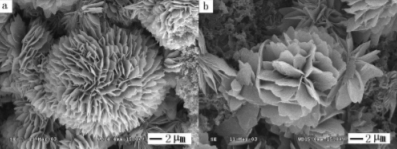
A Simple Route to Micropatterned Polymer Surfaces
Yong Wang, Zhimin Liu*, Buxing Han*, Haixiang Gao, Jianling Zhang, Xun Kuang, Chem. Commun. 2004, 800-801
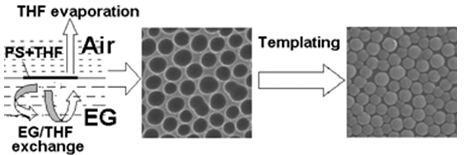
pH Sensitive Polypropylene Porous Membrane Prepared by Grafting Acrylic Acid in Supercritical Carbon Dioxide
Yong Wang, Zhimin Liu*, Buxing Han*, Zexuan Dong, Jiaqiu Wang, Donghai Sun, Ying Huang, Guanwen Chen, Polymer 2004, 45, 855-860
pH sensitive membrane was prepared by grafting acrylic acid (AA) on the porous polypropylene (PP) membrane using supercritical (SC) CO2 as a solvent. The monomer (AA) and the initiator (benzyl peroxide, BPO) were impregnated into the PP substrate with the aid of SC CO2, and were grafted onto the microporous PP substrate. The grafted membranes were characterized by Fourier transform infrared spectroscopy (FTIR), field emission scanning electron microscopy (FE-SEM), and the water permeability of the virgin and grafted membranes were determined at different pH values. It was demonstrated that the grafting degree (Dg) could be easily controlled by varying operating conditions, such as the monomer concentration, pressure, and temperature during the soaking process. The water permeation of the virgin membrane is nearly independent of pH. However, the water permeation of grafted membranes decreases dramatically with pH as the pH varies from 3 to 6 because the conformation of the PAA changes significantly with the pH of the contacting solution.

Synthesis of Polypropylene/ZnS Composite Using the Template Prepared by Supercritical CO2
Yong Wang, Zhimin Liu*, Buxing Han, Jiangling Zhang, Tao Jiang, Weize Wu, Guanying Yang, Ying Hang, Chem. Phys. Lett. 2003, 381, 271-277
A new template membrane, acrylic acid grafted microporous polypropylene (PP) membrane, was prepared using the supercritical (SC) CO2 as a solvent. Then zinc ions were anchored in the membrane by forming a monodentate complex with the carboxyl groups in the template membrane. Subsequent treatment with Na2S aqueous solution led to the formation of ZnS nanoparticles within the PP matrix, resulting in ZnS/PP nanocomposite. UV–Vis and Fourier Transform Infrared (FTIR) spectra, and energy-dispersive X-ray analysis (EDS) confirmed the existence of ZnS in the grafted membrane. Field emission scanning electronic microscopy (FE-SEM) and transmission electron microscopy (TEM) images showed that the ZnS nanoparticles distributed uniformly in the composite.
